2016 Mazda MX-5 Miata: What's It Like to Live With?
Twelve months with the lightweight, back-to-basics 2016 Mazda MX-5 Miata. It's great to drive, but what's it like to live with for 20,000 miles?
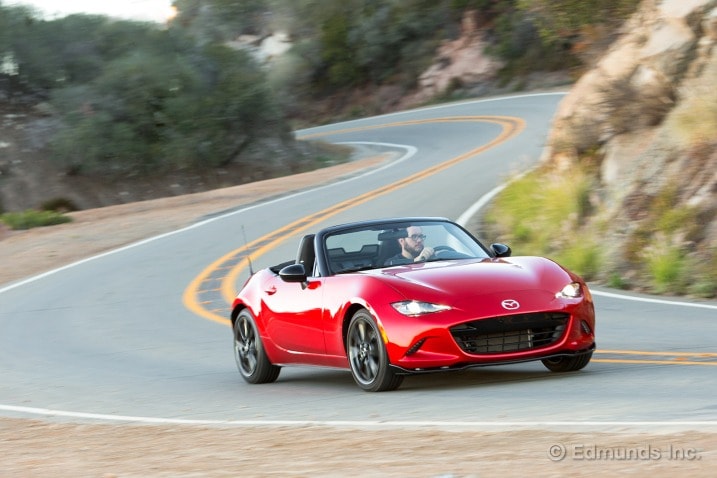
What do you want to know about?
- Introduction
- Bad Place to Put a Knob
- Tight Ergonomics
- Leave Your Baggage Behind
- Filing for an Extension
- At Goodwood, This Mazda Thoroughbred's Badge History Runs Deep
- Plenty a' Room
- Promotes Poor Posture
- If It Ain't Broke...
- Engine Looks Like an Engine
- A Gram Here, a Gram There
- All the Gauges You Need
- What a Manual Should Feel Like
- Fits Anywhere
- Not A Miata
- Fuel Economy Update for December — Future Looks Bright
- VIDEO! Tech Interface and Cupholder Vlog
- Does the Bike Fit?
- Rock-Hard Headrests
- Genius Shines Through at Two-Tenths
- Reminds You Why People Buy Convertibles
- Does Riswick Fit? VIDEO!
- Cabin for Real People
- Easy Driver, Great Teacher
- Where The Trunk Is The Button?
- Clever Coolant Temp Gauge, But What About Oil?
- Freakishly Lightweight
- Performance Tested
- The S2000 Problem
- Shifter Is a Benchmark
- The Best of the First 5,000
- Fuel Economy Update for January - 30 MPG
- Holds Its Own at the Country Club
- How It Makes You Feel
- You Write the Caption
- Fuel Economy Update for February
- The FR-S/BRZ Problem
- Bringing a Little Color to Death Valley
- Comfort vs. Fun
- Temptation, Trepidation and Precipitation
- A Softtop So Easy a Four-Year Old Can Operate It
- The SkyActiv Experience
- Sandstorm Damage
- Sandstorm Damage Extensive, Possibly Expensive
- Calm Down, It's Not Ruined
- Post-Sandstorm Filter Swap
- March Fuel Economy Is Right on Target
- Fits Anywhere, Part II
- Headlight Restoration
- Arms Fit Fine
- Three Days Will Cure What Ails Ya
- Fuel Economy Update for April
- Getting Estimates for a New Windshield: Part 1
- Getting Estimates for a New Windshield: Part 2
- Windshield Replaced
- Bad Seats Are Getting Worse
- Excellent Steering Wheel
- Will a Cartful of Groceries Fit?
- Staying the Fuel Economy Course for May
- Fully Restored by the 10,000-Mile Mark
- First Scheduled Service and Unexpected Rear Tire Wear
- Lightning-Quick Top
- Avoids the Chin Scrape Through Geometry
- In Defense of the New Engine
- Which Version Should You Get?
- Top 10 Qualities You'll Like About The Miata
- A Touchscreen That's Not Always A Touchscreen
- More Fun Than a Frog in a Glass of Milk
- Will the Luggage Fit?
- Fuel Update For June - Holding Steady
- Getting In and Out, Made Easier
- The Golf Clubs Technically Fit
- Bose? Oh Noes!
- Temperature Indicator Barely Moves
- I Found the Bose Logo
- Fuel Economy Update for July
- Will Golf Clubs and a Passenger Fit?
- Power Error 404 Not Found
- Caption This
- To Ripley and Back, Believe it or Not
- Stops Short
- Setting Fuel Economy Records in August
- I Like the Stereo
- Transmission Noise
- No Nav? No Problem!
- Monthly Update for October 2016
- A Joy to Drive
- Monthly Update for November 2016
- False TPMS Warning and a Flat Tire Scare
- Wrap-Up
Introduction
What Did We Get?
Miata people call it the ND and they are very, very excited.
This 2016 Mazda MX-5 Miata represents the fourth-generation Miata. That's where the "D" in "ND" comes from. When the first (NA) Mazda Miata was released in the late 1980s, the Miata was a revelation: a small, light, responsive, drop-top sports car that echoed the ethos of those fine British roadsters from the '60s. The only difference was that this car was affordable and offered Japanese-car build quality and reliability. It was an instant classic.
In the years that followed, the Miata got a little bigger, got a little more powerful, changed its name to MX-5 and even added a power-retractable hardtop. We can't say the Miata lost its way, but the focus shifted.
With the new 2016 MX-5 Miata, Mazda is as focused as ever. The new car is 200 pounds lighter than last year's; it's shorter, wider and lower; the power hardtop is gone; horsepower is...down. Bowing to social pressure, Mazda even added "Miata" back to the car's official name. At least for America.
What Options Does It Have?
The 2016 Mazda MX-5 Miata is available in three trims: Sport, Club and Grand Touring. Standard features across all models include a hand-operated cloth soft top with glass rear window, push-button start, air-conditioning, LED headlights, cruise control and Bluetooth. The top-of-the-line Grand Touring has adaptive headlights, automatic wipers, heated sideview mirrors, leather seats, blind spot monitoring and lane departure warning. We didn't get the Grand Touring.
For us, the only option was the midgrade Club. When equipped with a manual transmission (which we ordered), the Club gets a sportier suspension with Bilstein shocks, shock-tower brace, a limited-slip differential, 17-inch wheels with summer tires and a host of visual improvements. Don't think this is a stripped-out racer, as the Club has an upgraded nine-speaker stereo, dual USB ports and a 7-inch touchscreen. While the 2016 MX-5 Miata starts at $25,735, our Club carries a base price of $29,215.
There are very few options available for the MX-5 Miata, and we got even fewer. The Soul Red paint added $300 and the advanced keyless entry tacked on another $130. Final price: $29,850.
All 2016 MX-5 Miatas come with a 155-horsepower 2.0-liter four-cylinder engine and either a six-speed manual or optional six-speed automatic transmission. The Miata is rear-wheel drive. Only. Thankfully.
Why We Bought It/Why We Got It
There's an old adage that says the nail that sticks up gets hammered down. This new MX-5 bucked an industry-wide trend of bigger, more powerful and quieter by going back to the formula that put this plucky, little roadster on the map. Everyone loves the MX-5 Miata when the roads are open, windy and reasonably level. What happens the rest of the time?
Over the next 12 months, we'll put 20,000 miles on our new long-term MX-5 Miata and they won't all be on canyon roads. Follow along on our Long-Term Road Test page to see if Mazda's gamble paid off, or if there really is a good reason that every other carmaker has abandoned this formula.
Best MPG: 28.5
Worst MPG: 25.4
Average MPG over 468 miles: 26.8
The manufacturer provided this vehicle for the purpose of evaluation.
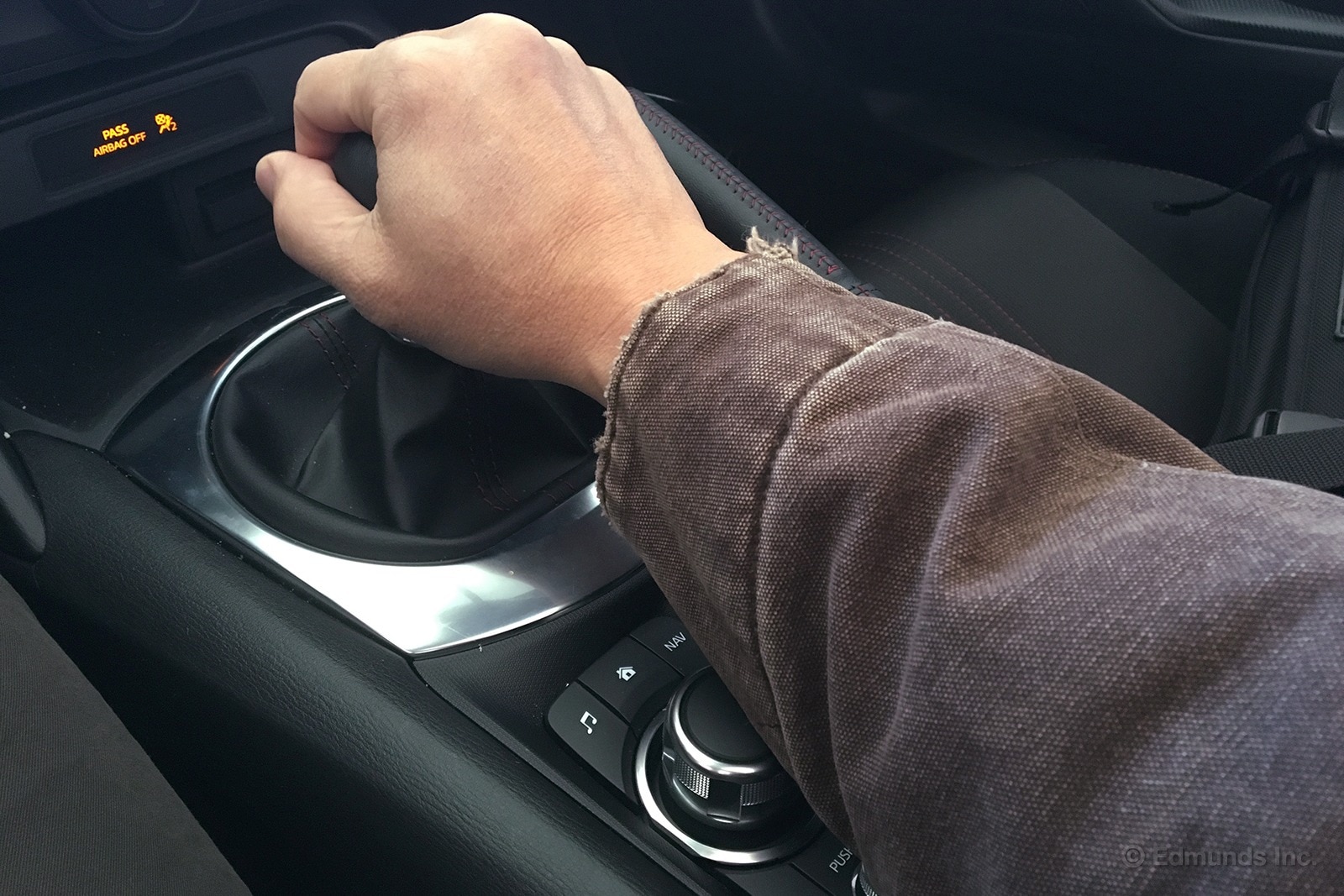
As I noted in my first post, I love the 2016 Mazda MX-5 Miata for it's fun-loving nature. But perfect it is not. Case in point: that infotainment controller.
In my brief commute home, I unintentionally bumped that controller knob three times, causing the audio source to switch or skip. And no, I wasn't wearing the jacket that appears to have been lifted off a hobo.
The placement of that controller is a big misstep. It wouldn't be a problem if it moved a little to the right, but that's where the parking brake lever is. If Mazda used an electric parking brake instead, that would probably fix the problem, but then we couldn't do those sweet handbrake turns. I mean, ummmm, it would probably hike the price past its affordable position.
Dropping the controller into a deeper recessed pocket would be a smarter move if there's room. Or maybe raise the armrest a bit.
Is it a dealbreaker? No. I'm still smiling everywhere I go.
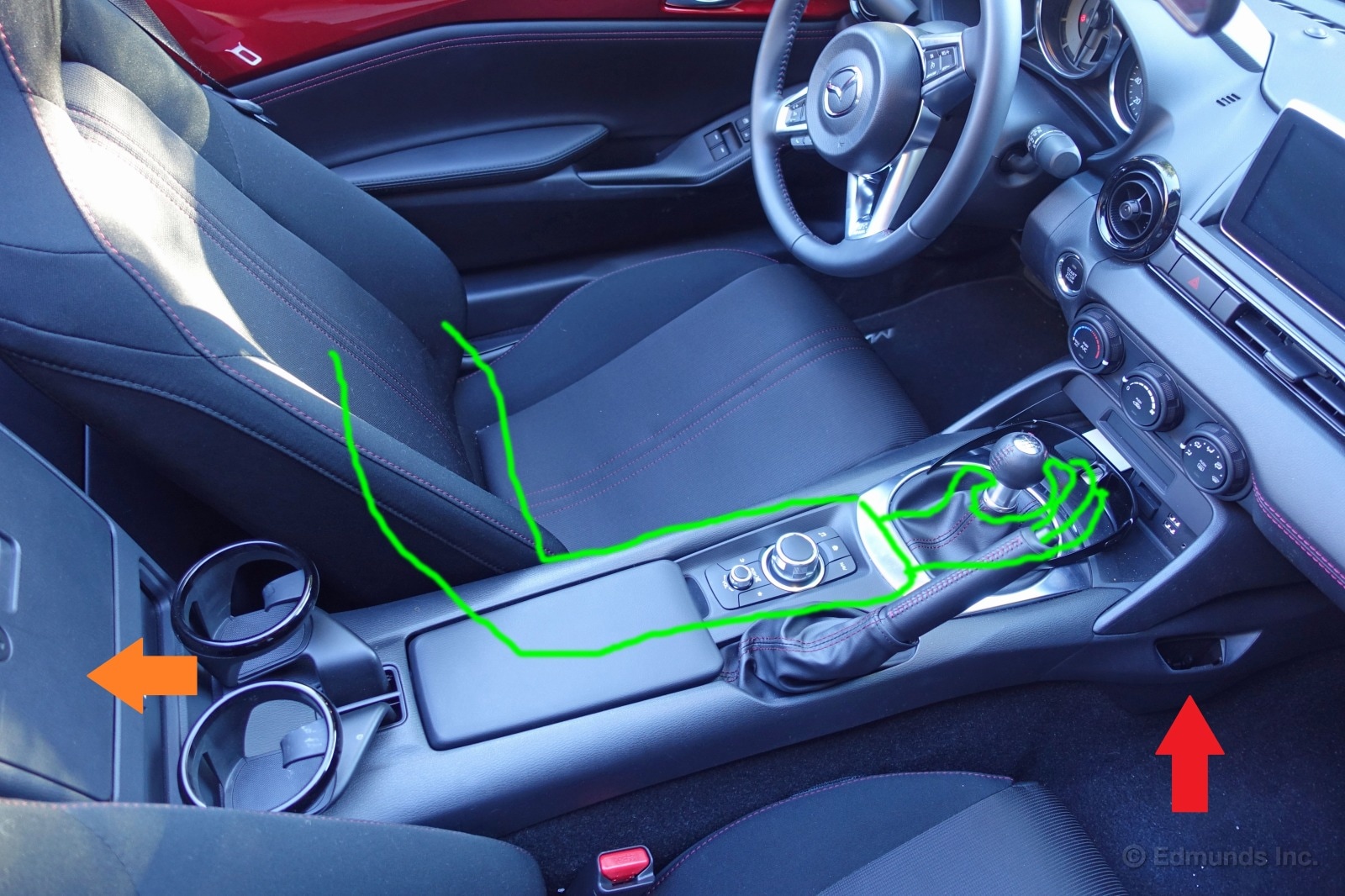
Editor's note: Both Ron (author of this post) and Mark (author of the previous MX-5 post) submitted similar thoughts about the MX-5's kooky placement of its infotainment controls within a day of each other. Herewith, Ron's take on the setup and other cabin confines.
Our long-term 2016 Mazda MX-5 Miata is a blast to drive. And if you only focus on that, the ergonomics are just fine. Any other task will require +1 to your dexterity skills. The green squiggly lines in the above photo comprise my "Punch-Out!!"-inspired driver's arm.
Let's take a closer look at some of the ergonomic challenges in the MX-5.
I bumped my elbow on the cup holders a few times when I reached for the control knob. You can avoid this in one of two ways. First, you can contort your arm like a T. Rex and raise your elbow upward when reaching back. Bonus points if you can reach the volume knob, which is just behind the control knob.
Why not use the volume control on the steering wheel? Glad you asked. The steering wheel volume button doubles as the voice control prompt when you press it. I intended to get more volume by pressing the button upward and instead found myself telling the voice control to "cancel" a few too many times.
The second solution for the ergonomic challenge is to remove the cup holders. You can store one of them on the passenger side (red arrow) and the other one goes in the glovebox (orange arrow).
The MX-5 has a touchscreen, which offers all the functionality of the control knob and would alleviate the reach issue. However, the system locks out this function while the car is moving.
I realize that space is at a premium in a roadster and short of crafting a smaller, unique part for the MX-5, I don't know where else I would place the existing control knob. But its current location makes it a pain in the elbow.
What do you think? Chalk this up to life with a small car? Or would it be a deal-breaker for a buyer?
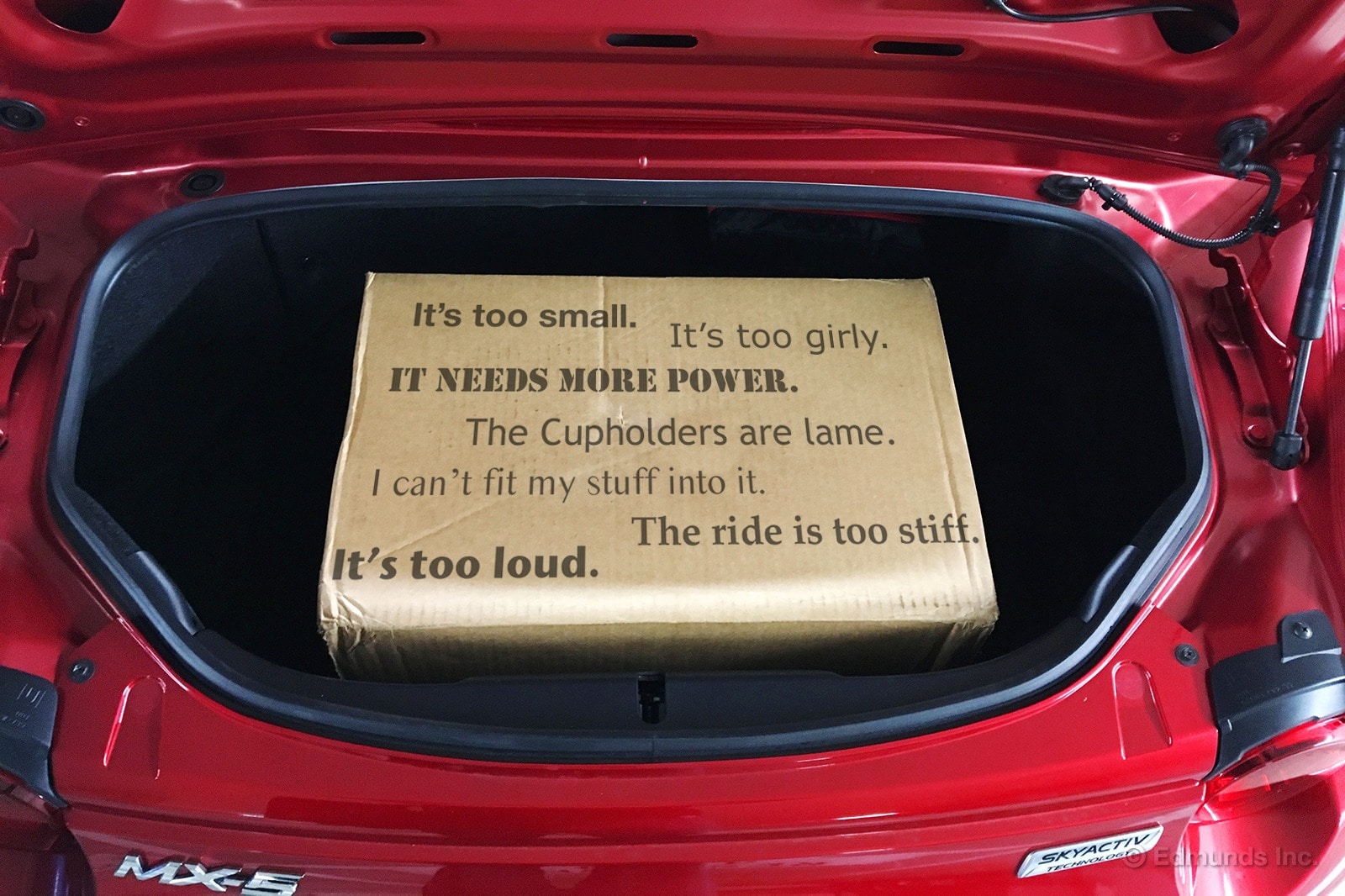
The 2016 Mazda MX-5 Miata doesn't have a lot of cargo space. Also, water is wet and our political system is broken. Thank you, Rear Admiral Obvious.
If you don't "get" the Miata, that's fine. It's not for you. One of my favorite quotes to live by comes from Randy Pausch and it goes something like, "never underestimate the power of fun."
The Miata is all about fun.
Fun fun fun. I love fun.
It's not about practicality or comfort, or luxury, or anything that doesn't have to do with fun. If you can't fit in it, blame your genetics. If the trunk is too small, you have too much stuff. If it's too stiff or too loud, you lost sight of your childhood. If you think it's underpowered, well, you might actually have something there.
Disclaimer: I
suffer from
revel in Peter Pan Syndrome and once owned a Lotus Elise. I'm willing to make sacrifices for fun.
You don't buy something like this with the illusion that it'll handle everyday car duties. You buy it because it's — wait for it — fun. The kind of fun you had with your first car, or bicycle or motorcycle.
Is the Miata perfect? Of course not. Perfection is an illusion. It has many flaws that my colleagues are waiting to point out. I'm no Miata fanboy, so I'll be pointing them out too. But so far, I doubt any of those flaws will keep me from signing out this car even in the face of a record El Niño season.
Bundle up, it's going to be a fun year. And leave your baggage at home.

My love for our 2016 Mazda MX-5 Miata is nothing new by now, but as promised, here's an imperfection: The steering wheel doesn't telescope.
At 5-foot, 10-inches, I'm not unusually tall. Well, maybe in Japan I would be, but here I'm just average. And that bums me out with the Miata. That steering wheel is just a little bit too far away from me than I prefer. As a result, I sacrifice legroom by scooting the seat forward once click and angling the seatback forward another click.
It's not optimal, but it's not a dealbreaker either.
You'd think that they'd add a telescoping wheel, though, especially for the U.S. market. C'mon Mazda, get on that.
At Goodwood, This Mazda Thoroughbred's Badge History Runs Deep
This is not a Miata. Not even close.
In fact, if the Miata is a respected sports car with an undercurrent of charm, then this is a glory-covered, purpose-drenched period piece built for annihilating apexes. It makes downforce. It spits fire. Only wimps use its clutch pedal. Its powerplant, the best-sounding race engine ever built, produces 750 horsepower. That engine, Mazda's four-rotor R26B, is virtually identical to the mill that won the 24 Hours of LeMans in 1991.
This is the 1992 Mazda RX-792P, a prototype racecar built to compete in the International Motor Sports Association's GTP category.
Only two were ever completed and this one is worth a million bucks. Literally. We drove it up the hill climb at last summer's Goodwood Festival of Speed in West Sussex, England.
Here's a full account with video.
First, some obvious disclosure. This has virtually nothing to do with our long-term Miata. The only tangents connecting the RX-792P and the current Miata are that both share Mazda logos, Mazda powerplants and some distinctly Mazda DNA. It's that last part that matters here. Mazdas, both the current Miata and in a deeply distant but highly focused way, this GTP car, are machines built for driving.
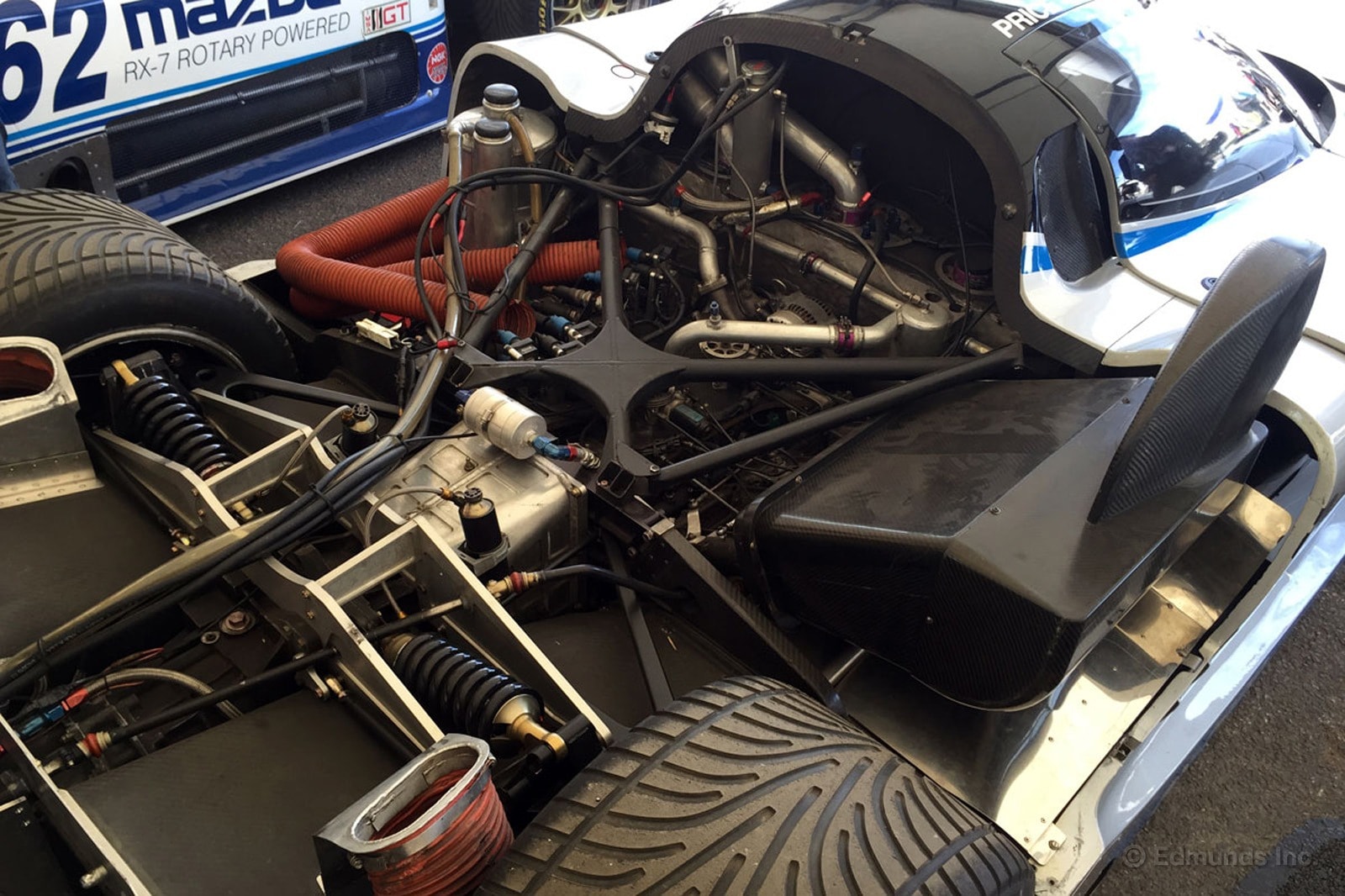
By that I mean that the RX-792P's connection to the driver is one that can never be fully established in a road car. As a result, it stirs emotion like nothing else I've ever driven. Also, at first blush, the thing doesn't feel at all like it wants to kill me.
Even so, the reasons for caution are many. First, I've never driven the car or the road before. Second, the entirety of the 1.16-mile hill climb is a single-lane road — the driveway to the Goodwood House, in fact. Much of it is lined on both sides with unforgiving hay bales, too. And don't forget the 150,000 fans who'd love nothing more than to make me a YouTube hero.
It's all forgotten the first time the R26B fires to life. Even at idle it makes a Pro Mod V8 sound like a Lexus. I meant it when I said this is best-sounding race engine ever built. By the barely restricted standard of early '90s GTP race engines, it was far from the most powerful. But nothing before or since has offered such stunning aural appeal. Screaming down the Mulsanne straight, the R26B in the LeMans-winning 787B stands hairs on end three provinces away.
For all their inefficiencies, rotary engines offer a magical, intangible appeal that piston engines just can't muster. And that appeal increases exponentially as their intake ports increase in size. This is especially true in the ultra-rare, four-rotor versions which use a peripheral port to snorkel huge volumes of air into the combustion chamber. This engine's inertia-free response is unmatched in the world of internal combustion. It parts the Goodwood crowds with fireballs from its side exhaust and it free-revs with the same lag you'd expect from a good electrical shock.
I'm reminded of this as I prepare for the run up the hill. Weldon Munsey, Mazda's Manager of Partner Affairs and the car's primary driver, points to the wide swath on the tachometer between 5,500 and 8,500 rpm and notes stoically that it gets "real meaty" in there.
Rolling off the line, I realize the gears are intentionally tall to accommodate the sustained high-speed runs that its downforce allows, the kind where the car rarely dips below triple-digit speeds and where a driver trusts a machine well beyond the limits of pure mechanical grip.
In other words, nothing like this.
Here it's running grooved rain tires, which are stickier than slicks at low temperatures and should provide a wider margin of safety without warm up. Even so, when I drop the clutch at 3,000 rpm, there's palpable wheelspin in a car that was never designed for standing starts. Meaty indeed.
It's all over in 65 seconds, which by Goodwood standards is an eternity. But there are highlights. If you listen carefully you'll hear the engine run fat on downshift blips at 40 and 42 seconds. It belches up a few fireballs that reverberate through its giant muffler, adding to the theater of the thing. The surroundings blur most quickly at 1:08, which is the only time I find the cojones to summon full throttle. Seven hundred and fifty horsepower is a lot in a carbon-aluminum machine weighing only 1,800 or so pounds, remember.
There's a long coast down after the finish through a narrow corridor of hay bales leading to the turnaround. Flanked by bleachers full of spectators, the weight of the moment sets in. By any measure of automotive enthusiasm, it's surreal.
Looking back now, several memories stand out. First is the spectacle of Goodwood itself. Rally cars, F1 cars, endurance racers (like this one), motorcycles, exotics, hypercars, dragsters, drifters, and off-roaders: There's something for everyone, from every era and discipline.
Ever seen a 28-liter pre-war Fiat run up the same hill as BJ Baldwin's trophy truck? Goodwood is the place. It was an honor to be part of it.
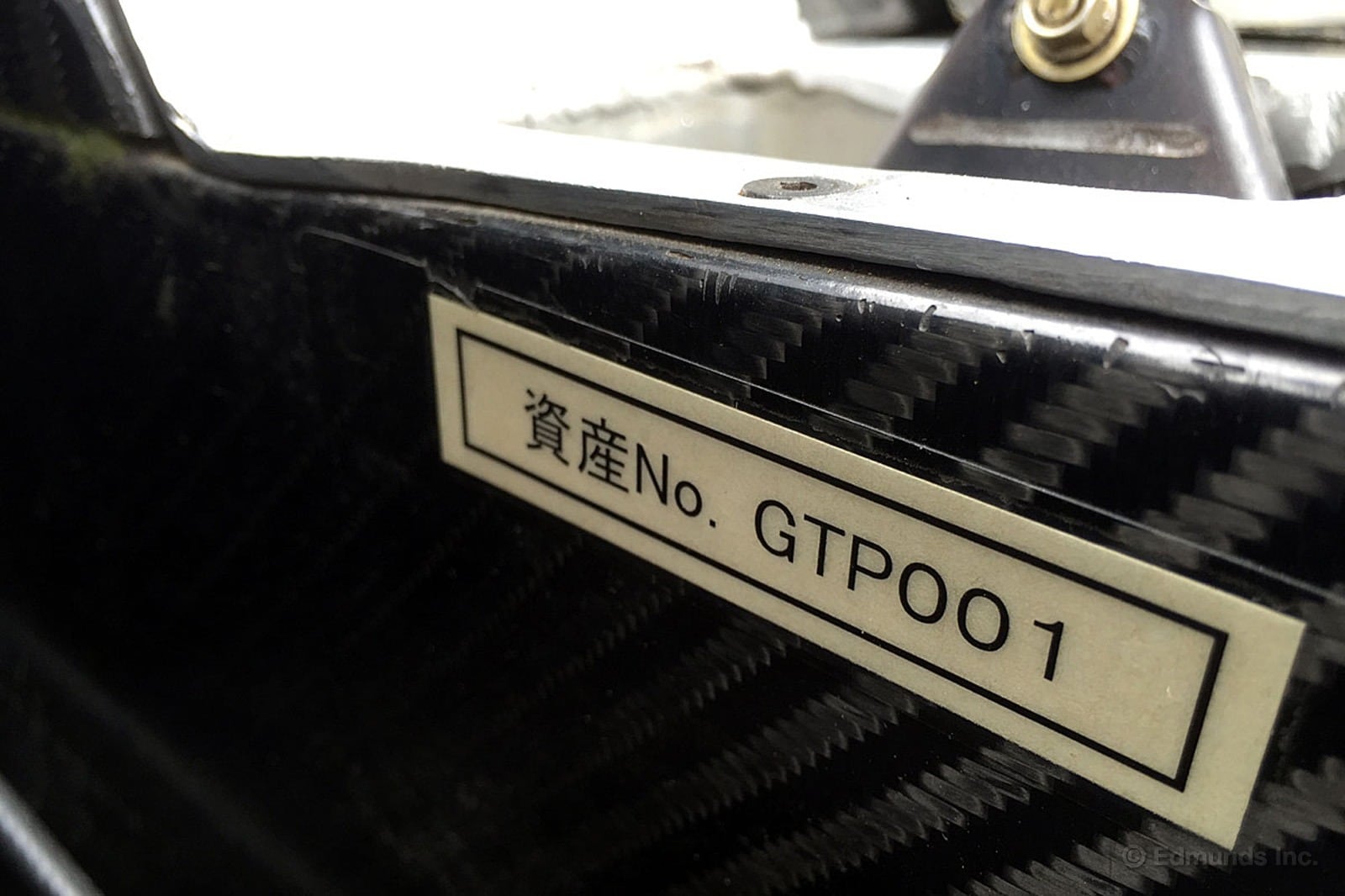
Second: Few experiences in life measure up to driving a dedicated race car with impunity, especially one with a powertrain pedigreed by victory at the planet's most prestigious endurance race. And though I didn't go that quickly, several impressions are eternally etched into memory: The moment I first heard the R26B's lumpy high-speed idle. Looking down and noticing the patina of the VIN number (GTP 001) on the carbon tub. Crossing the finish line in a blur of checkers and hay bales.

Go to Goodwood. You don't need a Miata or a prototype endurance car to fully appreciate the place. But they certainly don't hurt.
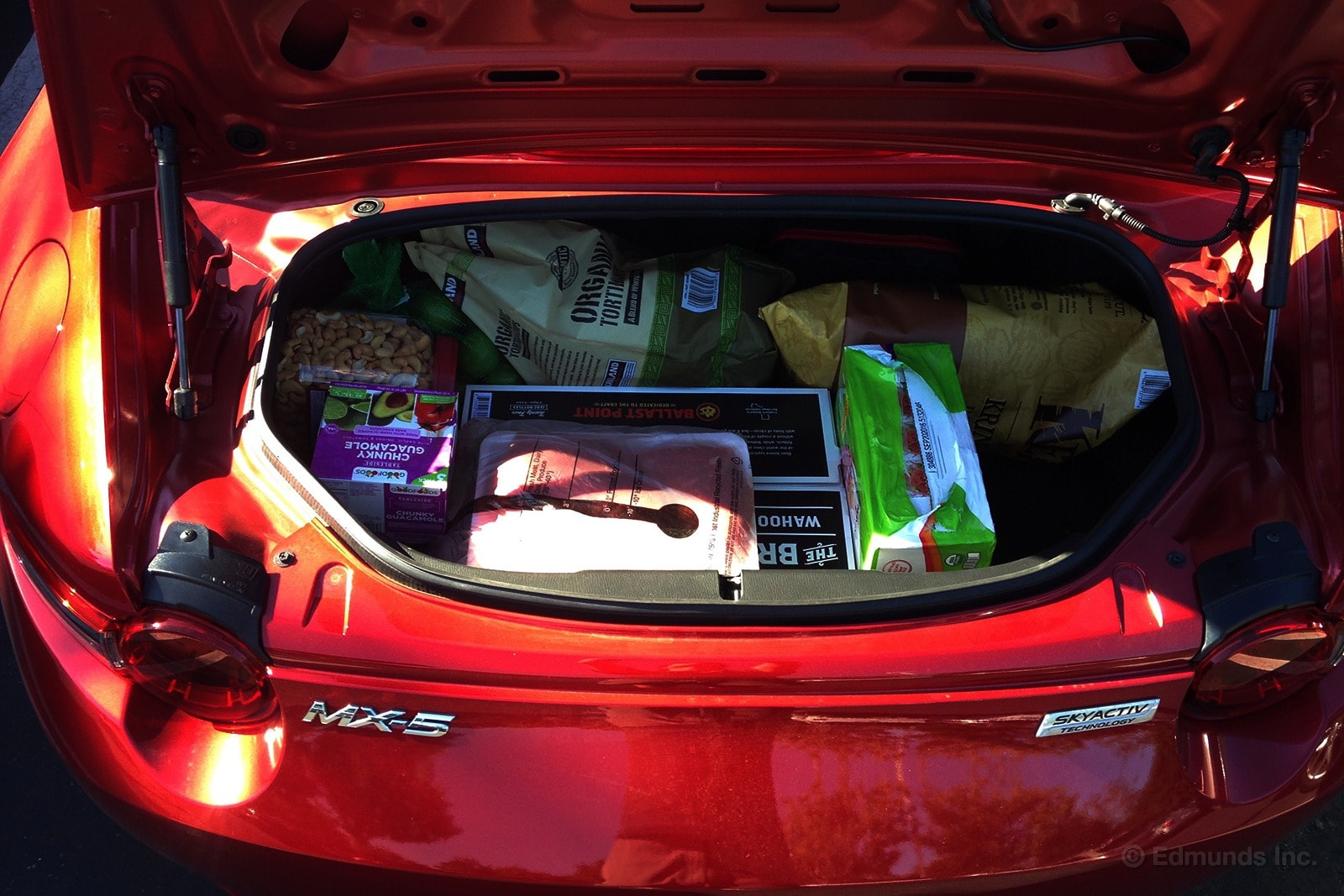
In our Edmunds review of the 2016 Mazda MX-5 Miata, we wrote that trunk capacity is rather pathetic, even by roadster standards, at just 4.6 cubic feet. For reference, a typical family sedan's trunk is about three times as large.
But that doesn't stop the Miata from stepping up when it's all you've got to pick up BBQ supplies. Those 4.6 cubes proved just enough when it came time for a little late fall char-be-cue to welcome a few friends passing through town. The photo above shows the trunk after the first stop.
Here's how much more it could swallow:
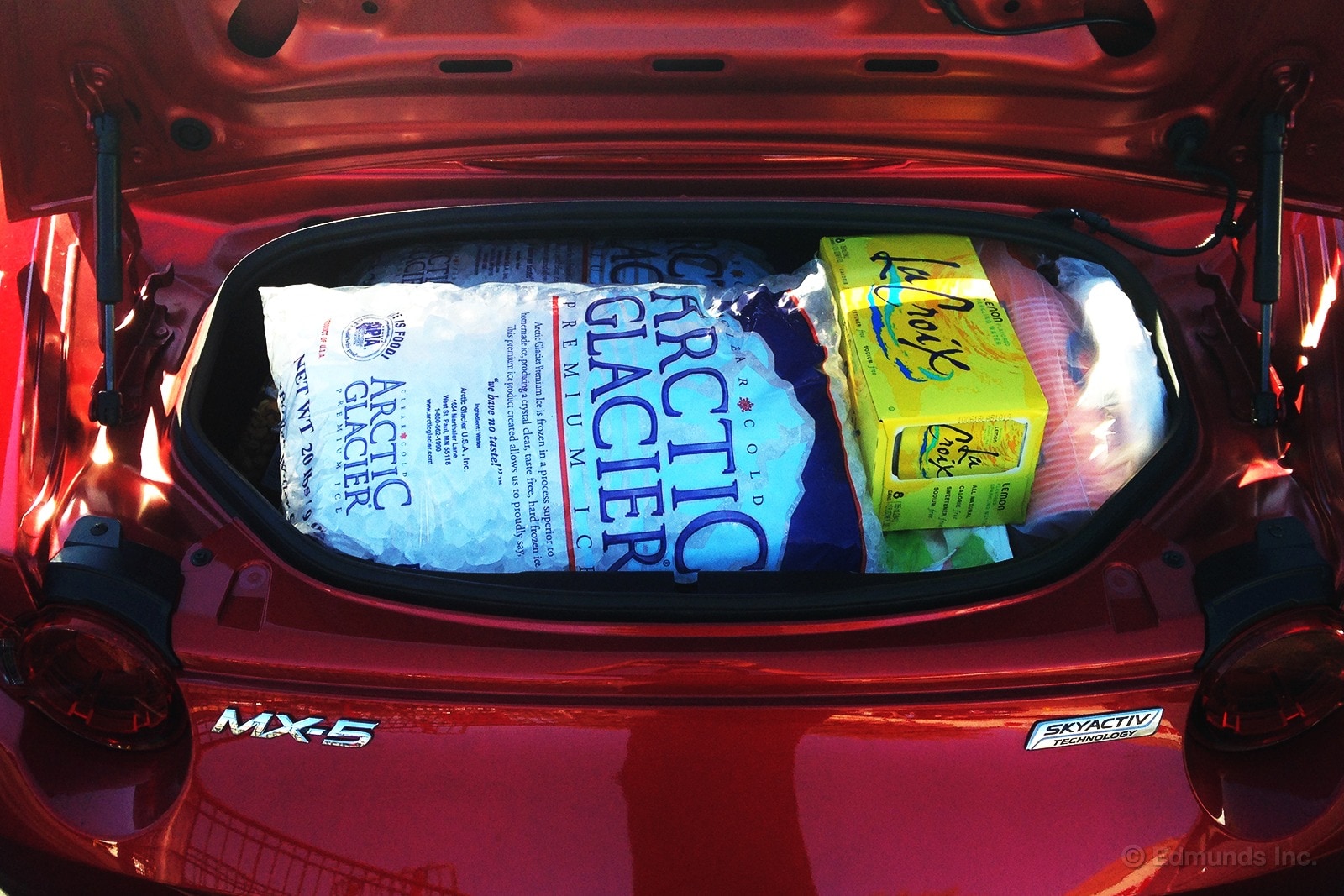
I even had The Kid riding shotgun. She had to balance a few other items on her lap and another bag of ice on the floor, but only for about a mile.
Granted this isn't the Miata's forte. This trunk will typically only see gym and laptop bags, a couple of weekend getaway duffels, some groceries. Am curious to see if it passes Riswick's golf bag test, but was impressed how easily it accommodated this shopping run.
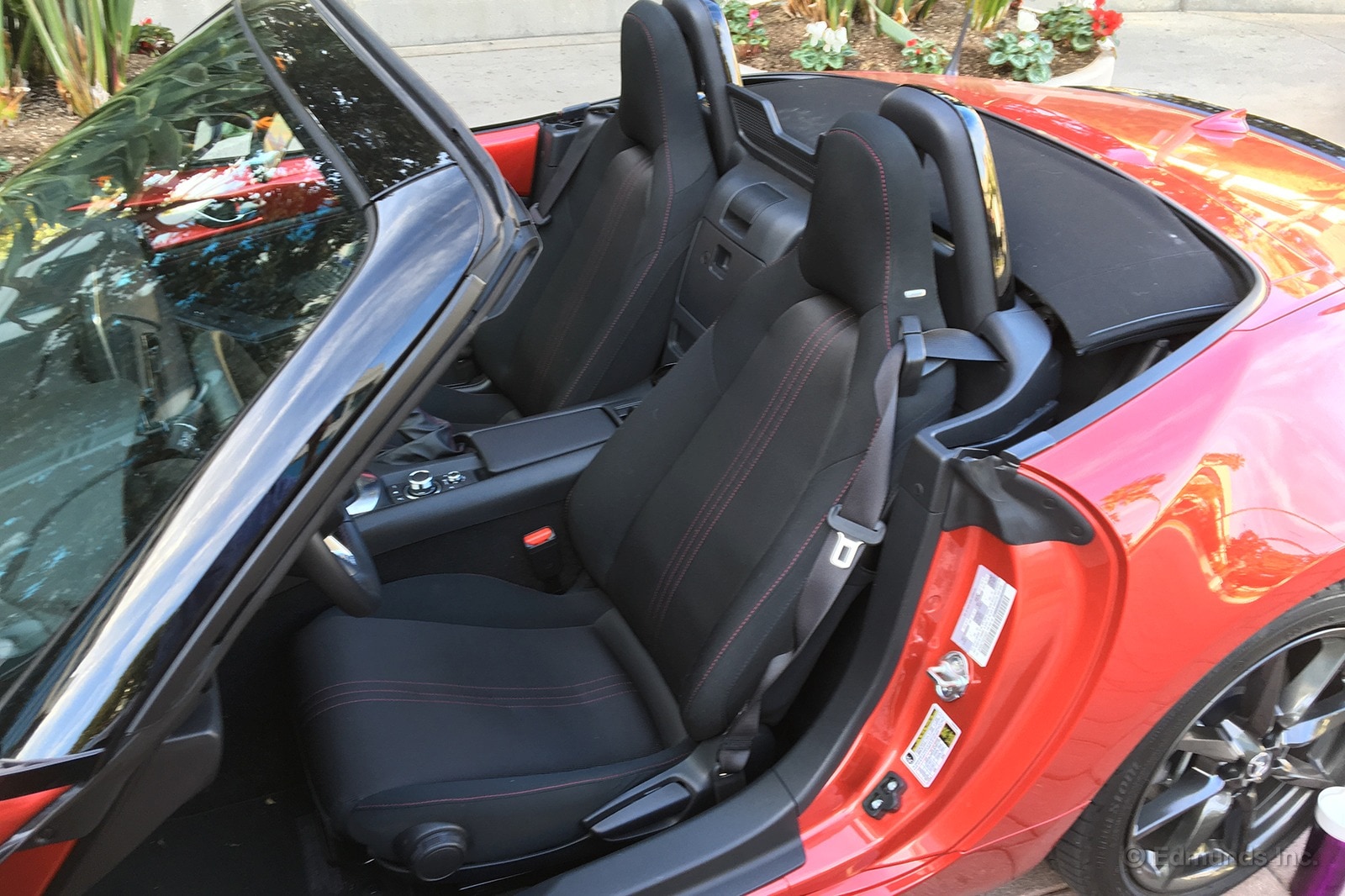
Our 2016 Mazda MX-5 Miata is a heckuva fun little thing to drive around on the right road.
It's those times when you're not on a fun road that you realize that this thing doesn't really put you in a very good seating position.
Like Mark said, it doesn't have a telescoping steering wheel. This is a silly omission. If I just stopped grabbing fistfuls of candy out of the bucket here at work, I'd lose more weight than the telescoping column would add. Dumb. Add it.
Beyond that, this thing makes some other mistakes that make this thing hard to live with once the shine of awesome dynamics wears off.
There's either no headroom or 50 trillion miles of headroom. And the bars that support the top don't feel good thunking on your skull. The seat is too high. No up-down adjustments. Not only would this fix the headroom issue, but I'd feel a little less like I was riding the Miata.
Adding the first two complaints gets us here. If I don't want to hit my head and I want to see out the windshield the way I want, I need to recline the seat more than I like. Thankfully I'm not Riswick-tall so I have some room, but barely. Even then, I end up leaning right a little.
Once I've reclined enough so that I can see and don't hit the roof, I can't really reach the steering wheel the way I want to. So now I'm leaning back, slightly off-center with Frankenstein arms.
To fix this, I'd recommend a telescoping steering wheel and a seat with up-down adjustment. And while we're adding a new seat, some more lateral bolsters would be cool, too...
...and since I'm rambling, here's some bonus content that's not worth a whole blog post. Since we're talking about space, I do feel the need to mention that the stereo control knob is not in the wrong space. I've got hundreds and hundreds of miles in this thing and I've never accidentally hit it.
Maybe those guys have narrow shoulders. Or they're grabbing the shifter by the boot instead of the knob.
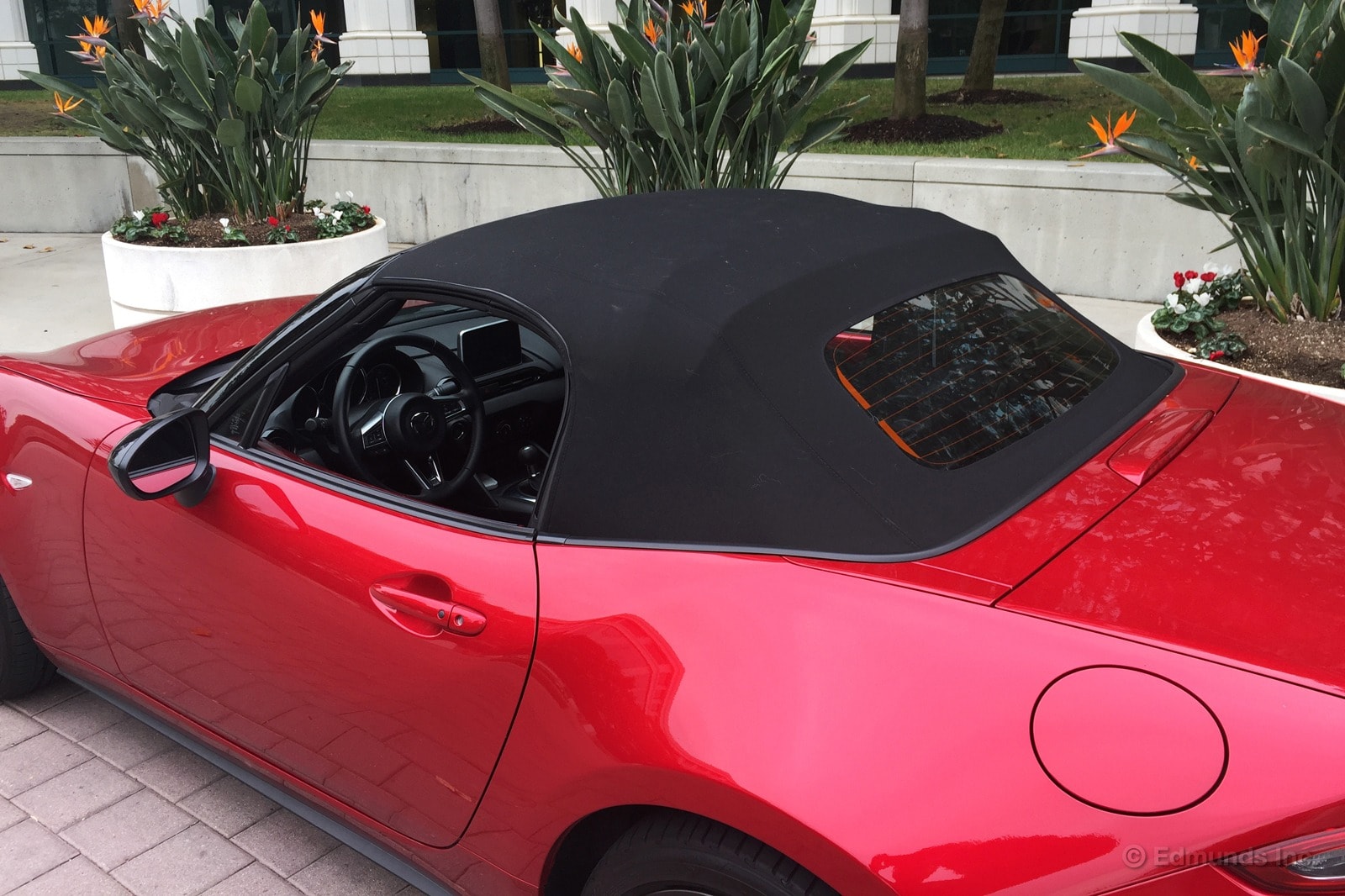
I recently spent a weekend with our new long-term 2016 Mazda MX-5 Miata. I was pleased to find that operating the convertible top was a one-handed process that took just a few seconds.
It's the same basic, elegant solution Mazda has used in the Miata for years.
Dropping the top of the Miata simply requires you to unlatch the center and push it back and down until it clicks.
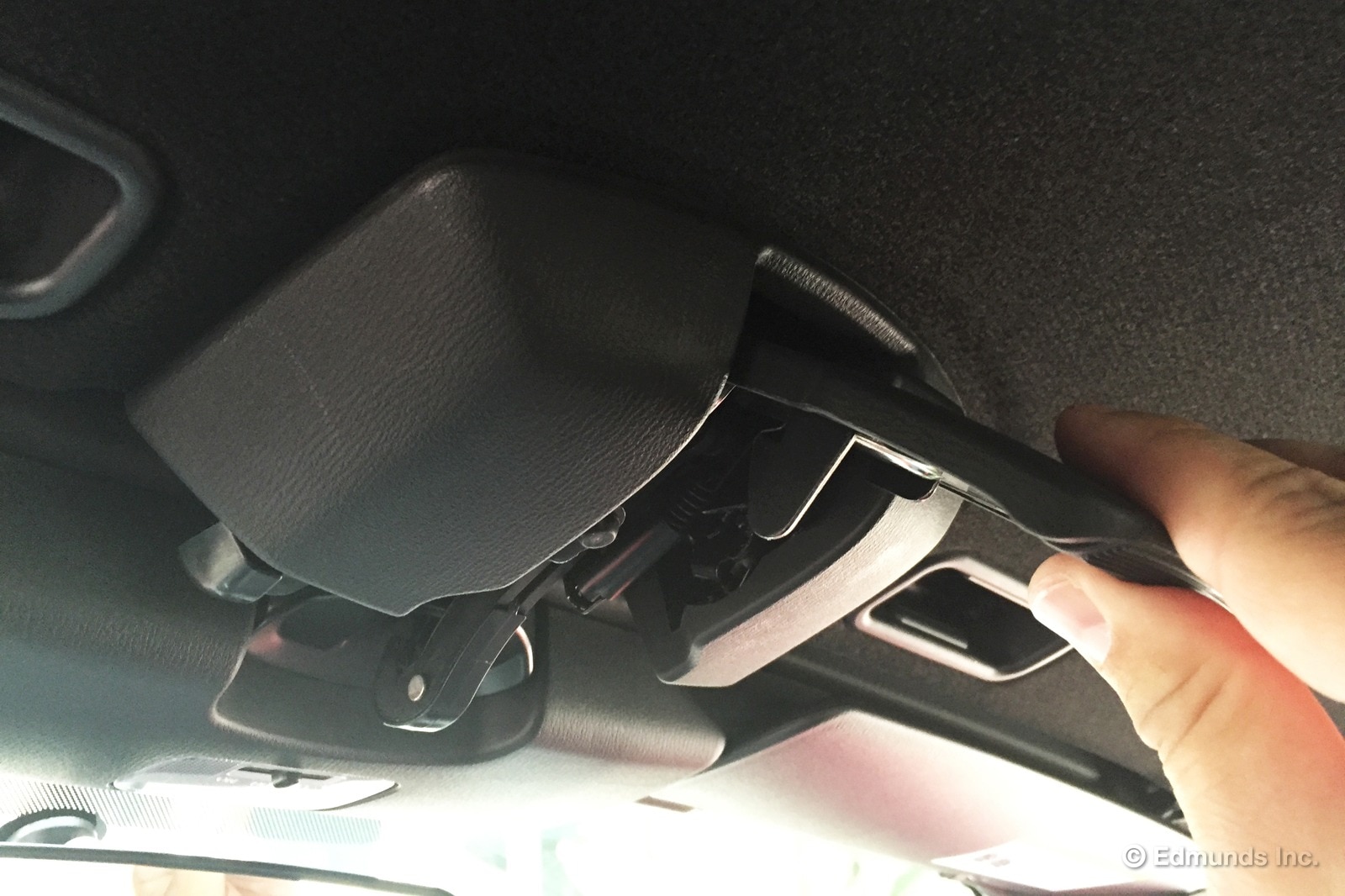
Pull down on the latch.
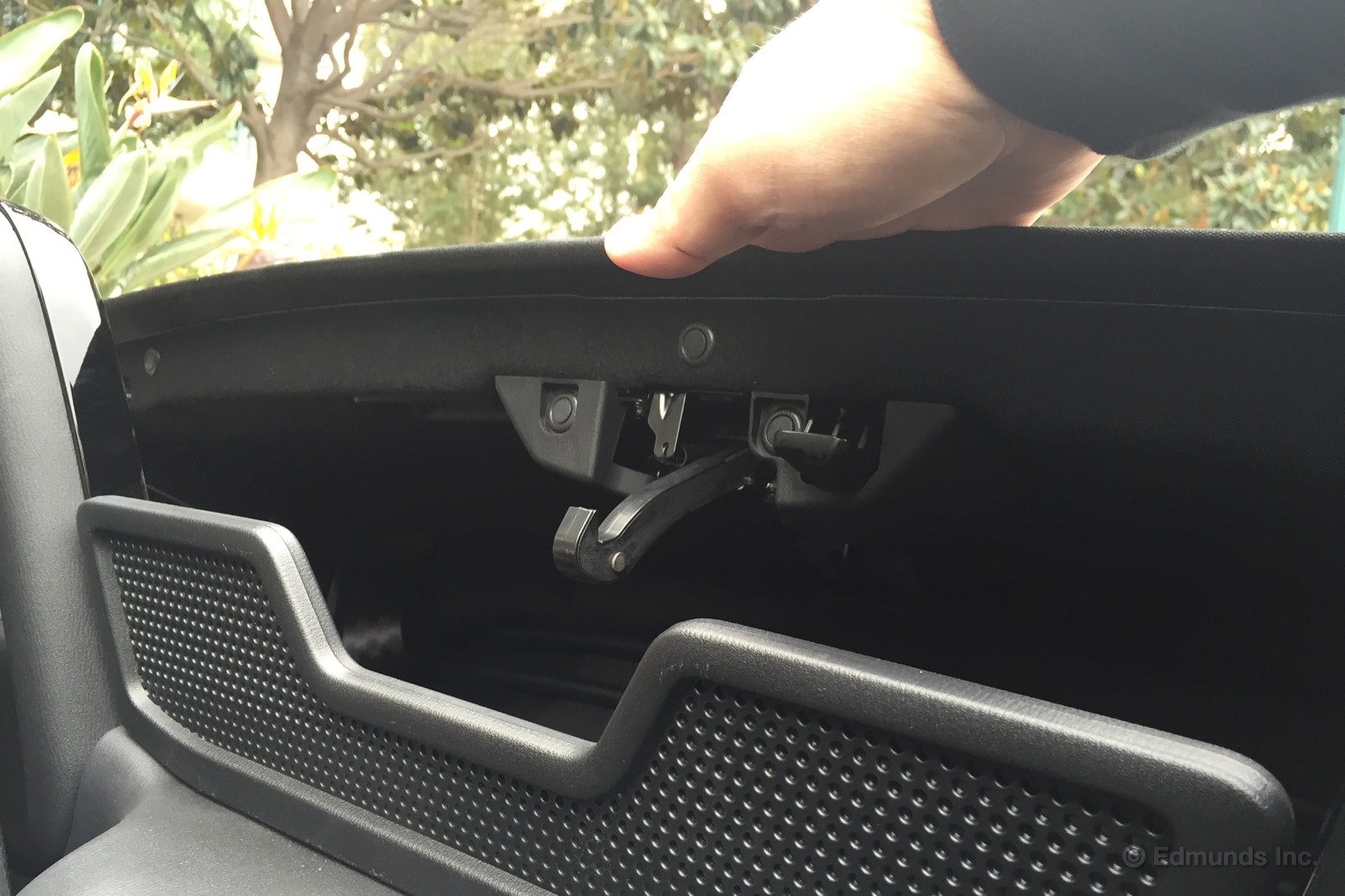
Push back and down.
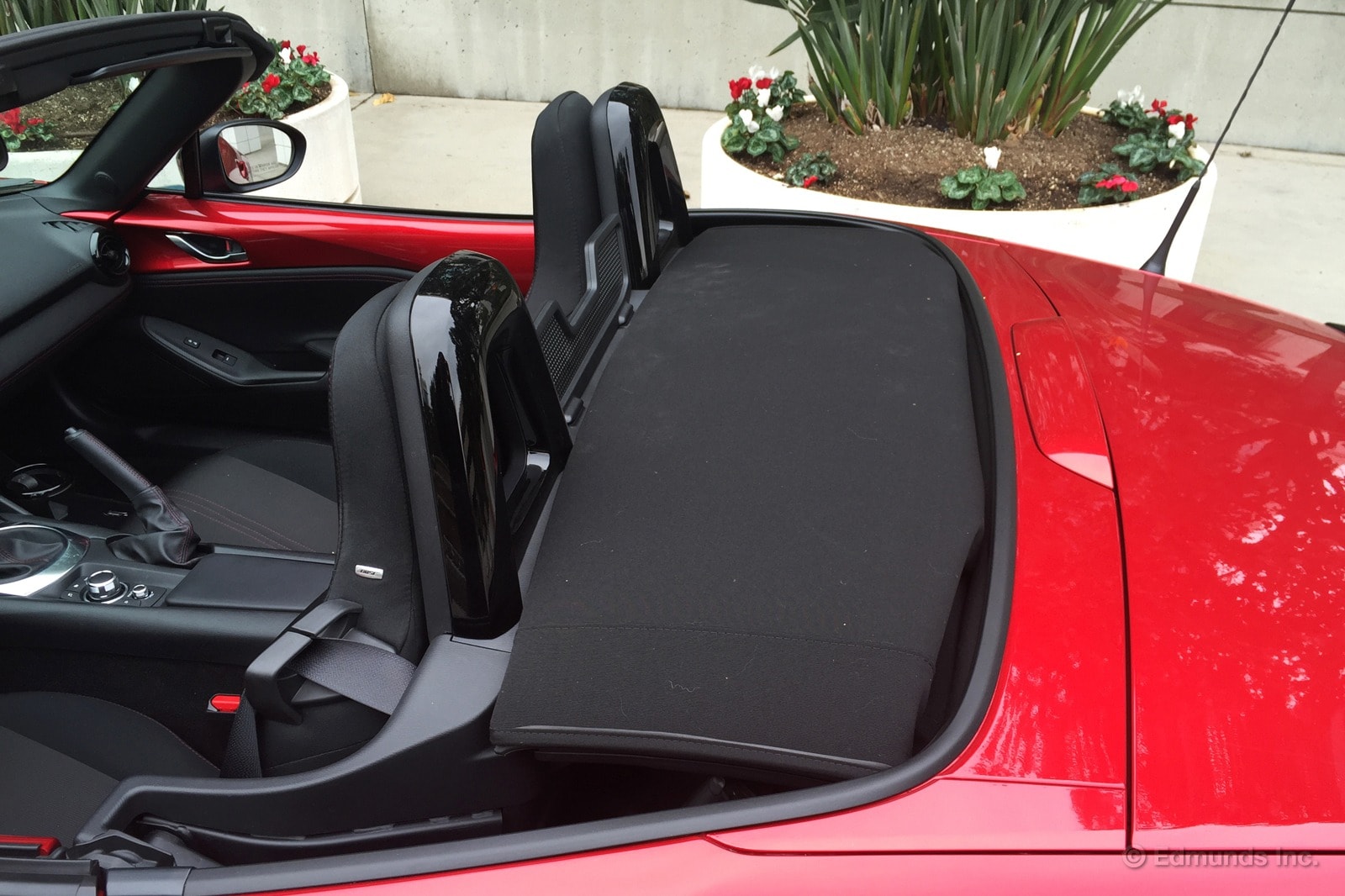
To raise the roof, you pull a release that rests between the seats. This causes the roof to pop up just high enough that you can reach directly over your shoulder and grab a handle. Pull it up and relatch the center.
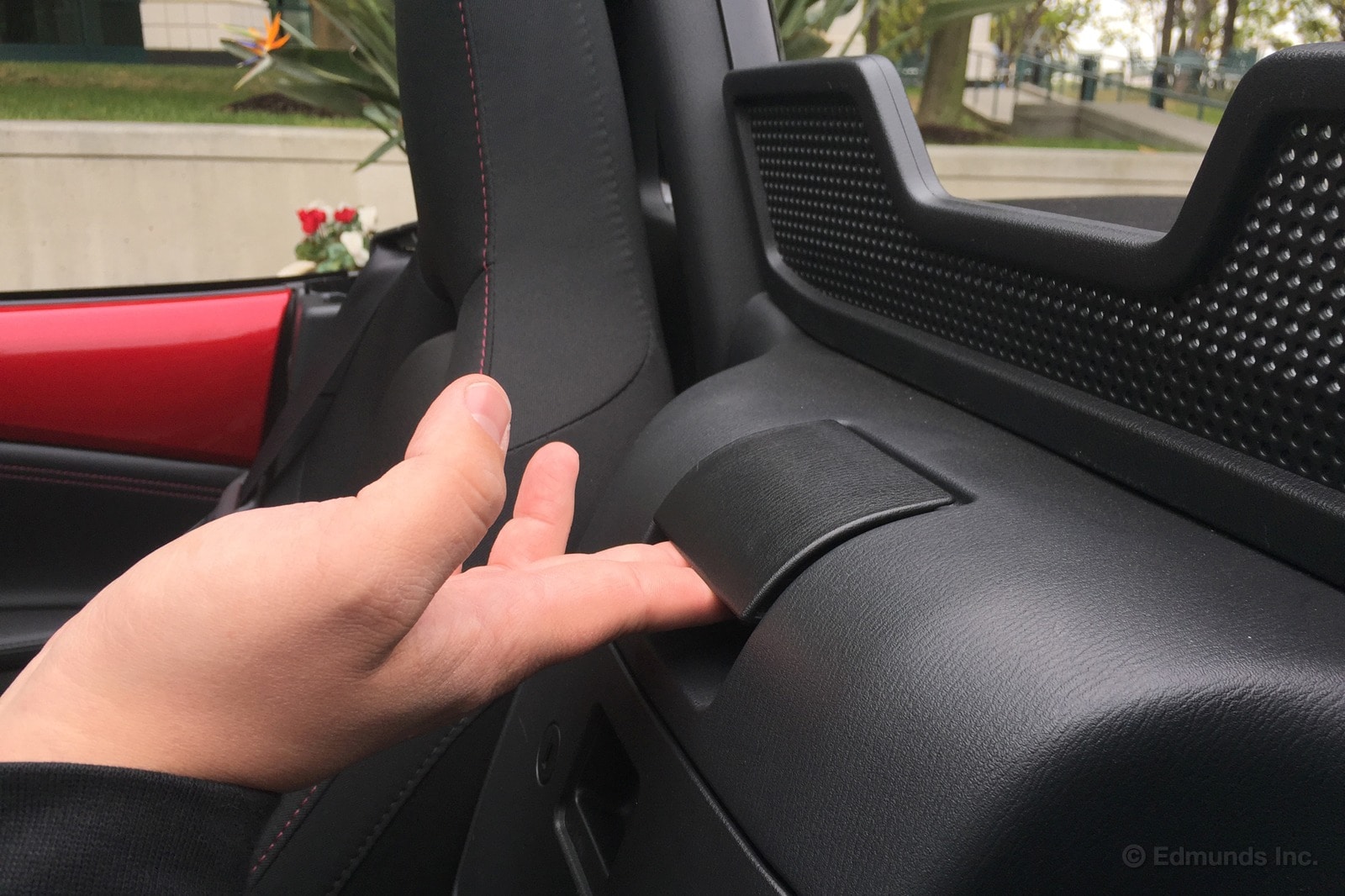
Pull up on the lever.
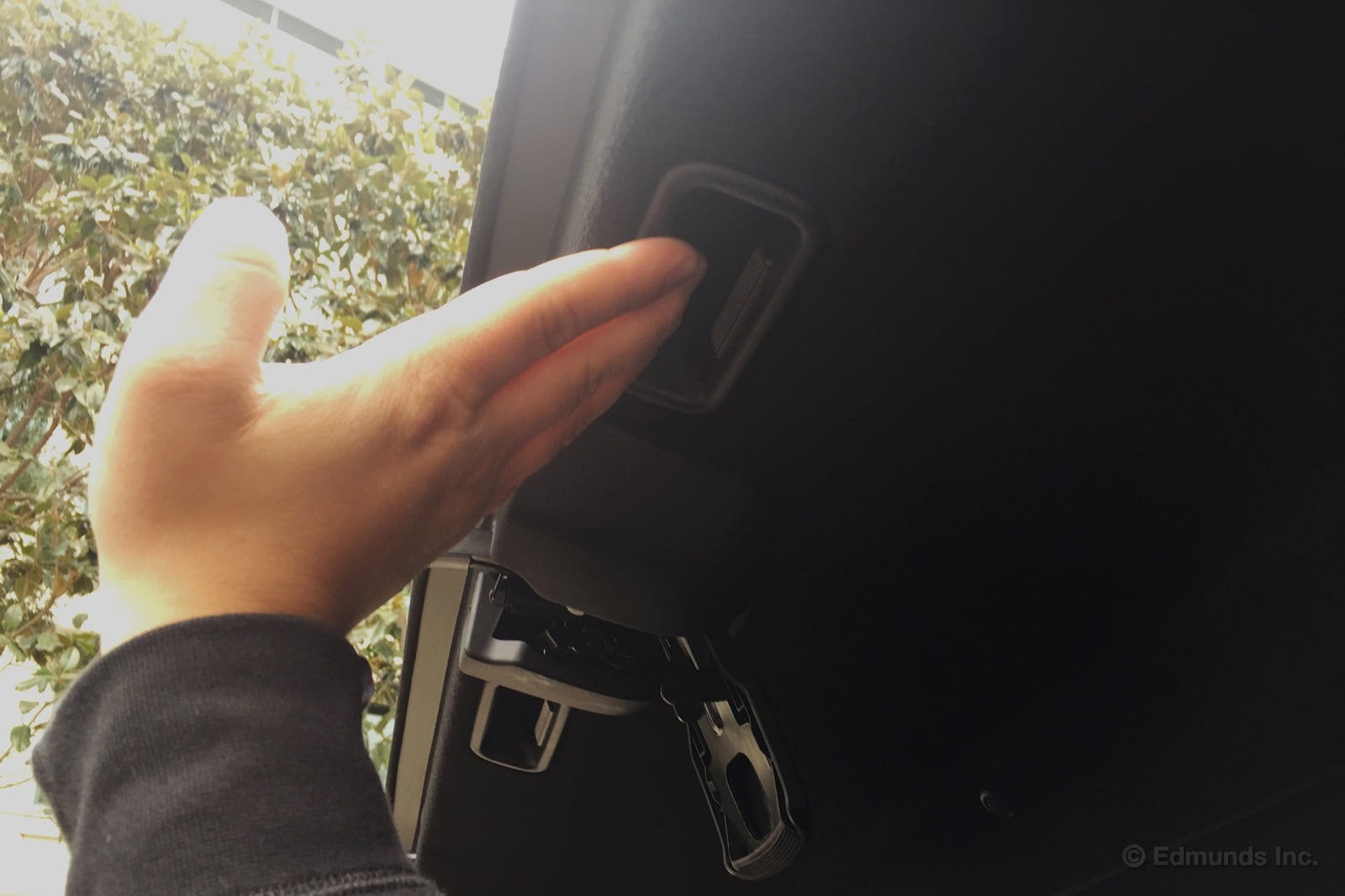
Grab the handle and pull forward.
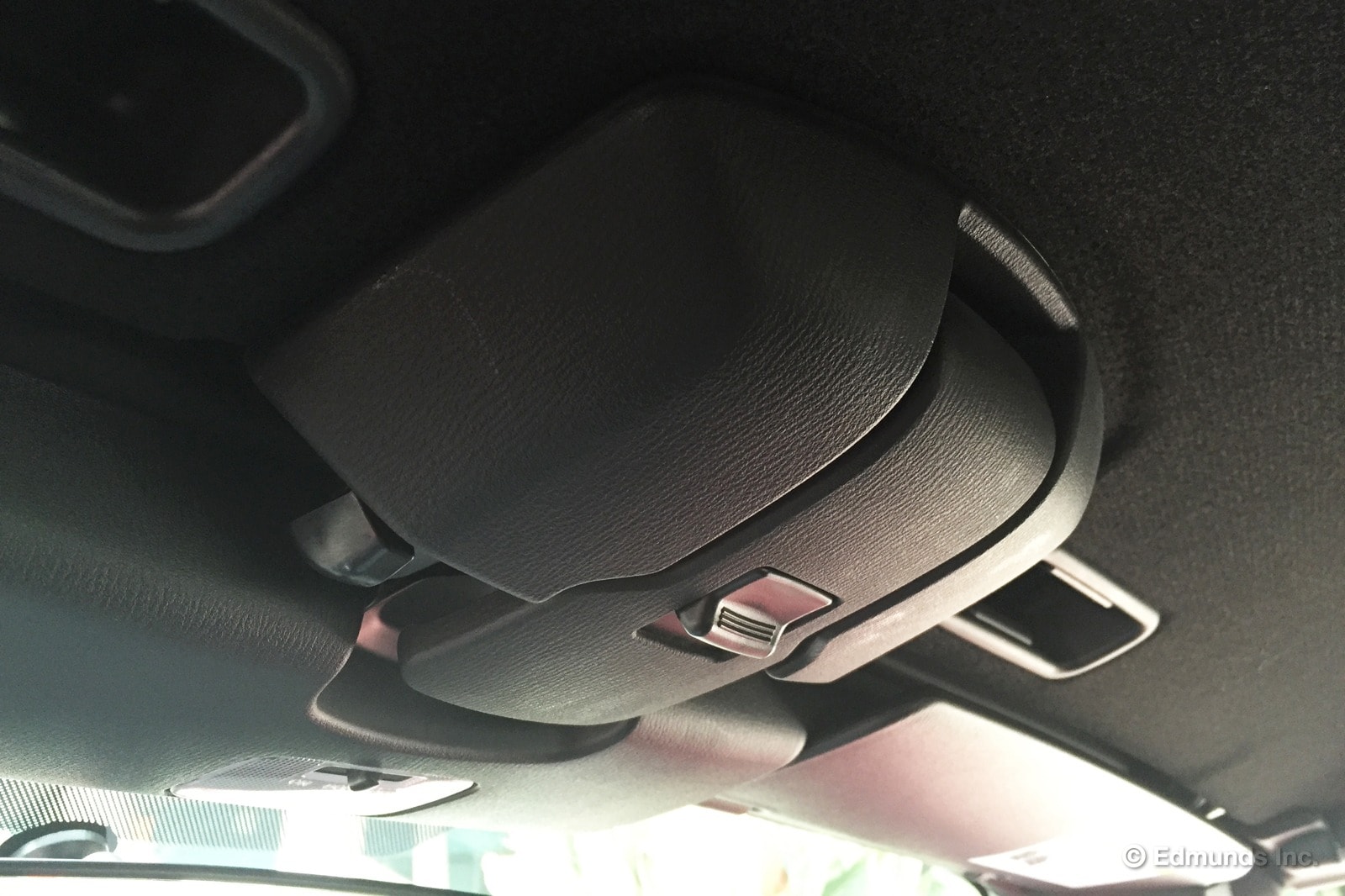
Rehook and push up on the latch.
After a few times, I could do it without looking. Putting down the top also doesn't require me to contort, meaning I could keep my seat belt buckled. The whole process is simple and much quicker than any power-operated top available.
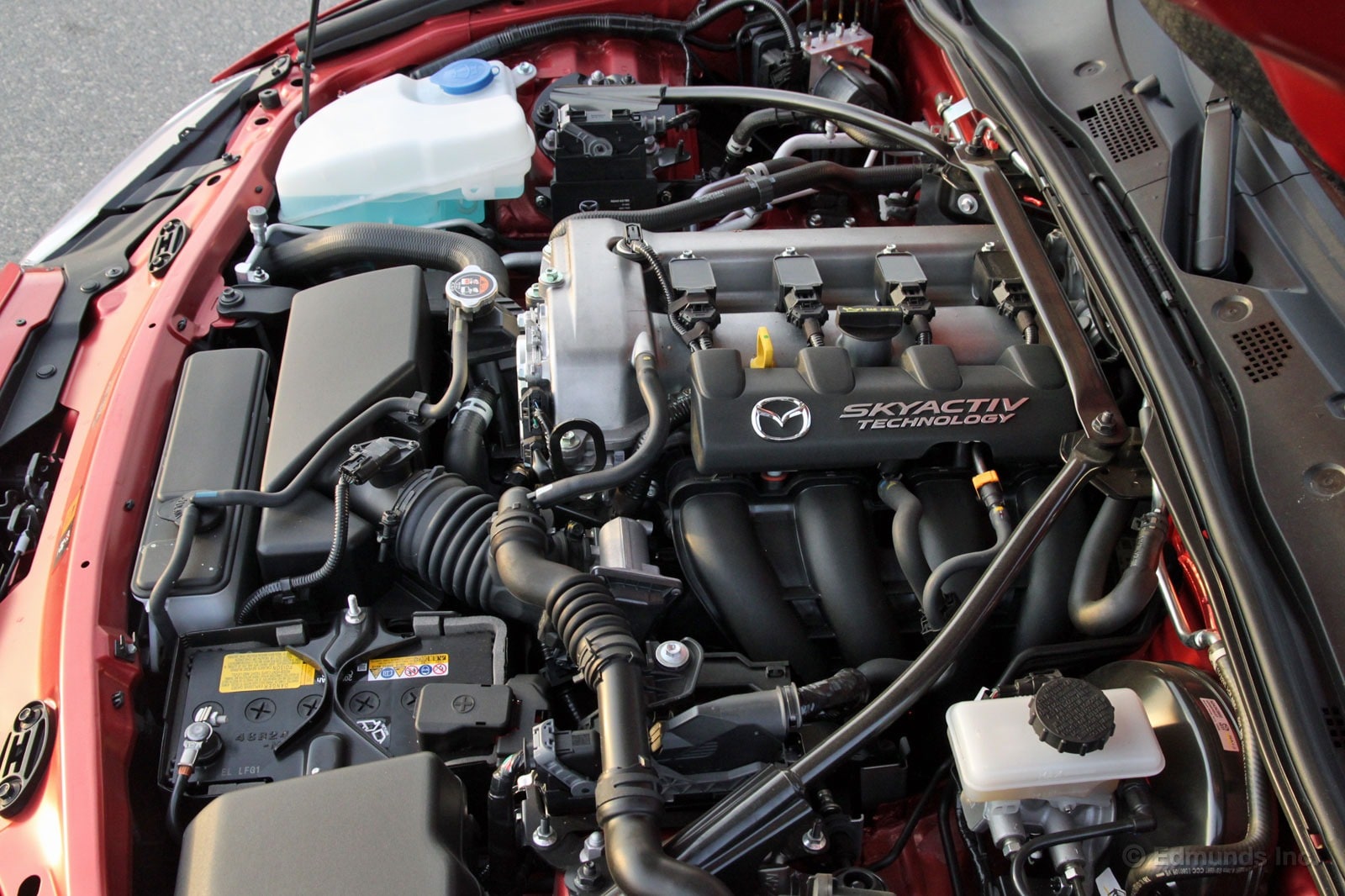
Does it really matter that the engine in our 2016 Mazda MX-5 Miata actually looks like an engine? Not really. But it does say a little bit about the people who designed it.
As you can see, there are no big plastic covers in this engine bay. Nothing obscuring the mechanical bits underneath in the name of "cleanliness." It looks like the machine that it is and that's the way the engineers and designers wanted it.
In fact, they told us that the metal valve cover you see here is actually heavier than the plastic one used on the Mazda 3 that uses the same engine. Plastic is fine for a budget hatchback, but a sportscar should have an engine that looks purposeful. At least that what they told us.
I hope the story is true. It means that there are still people at car companies that think of stuff like this. For most cars it's not practical, or even necessary, but on occasion it makes sense. This is one of those occasions.
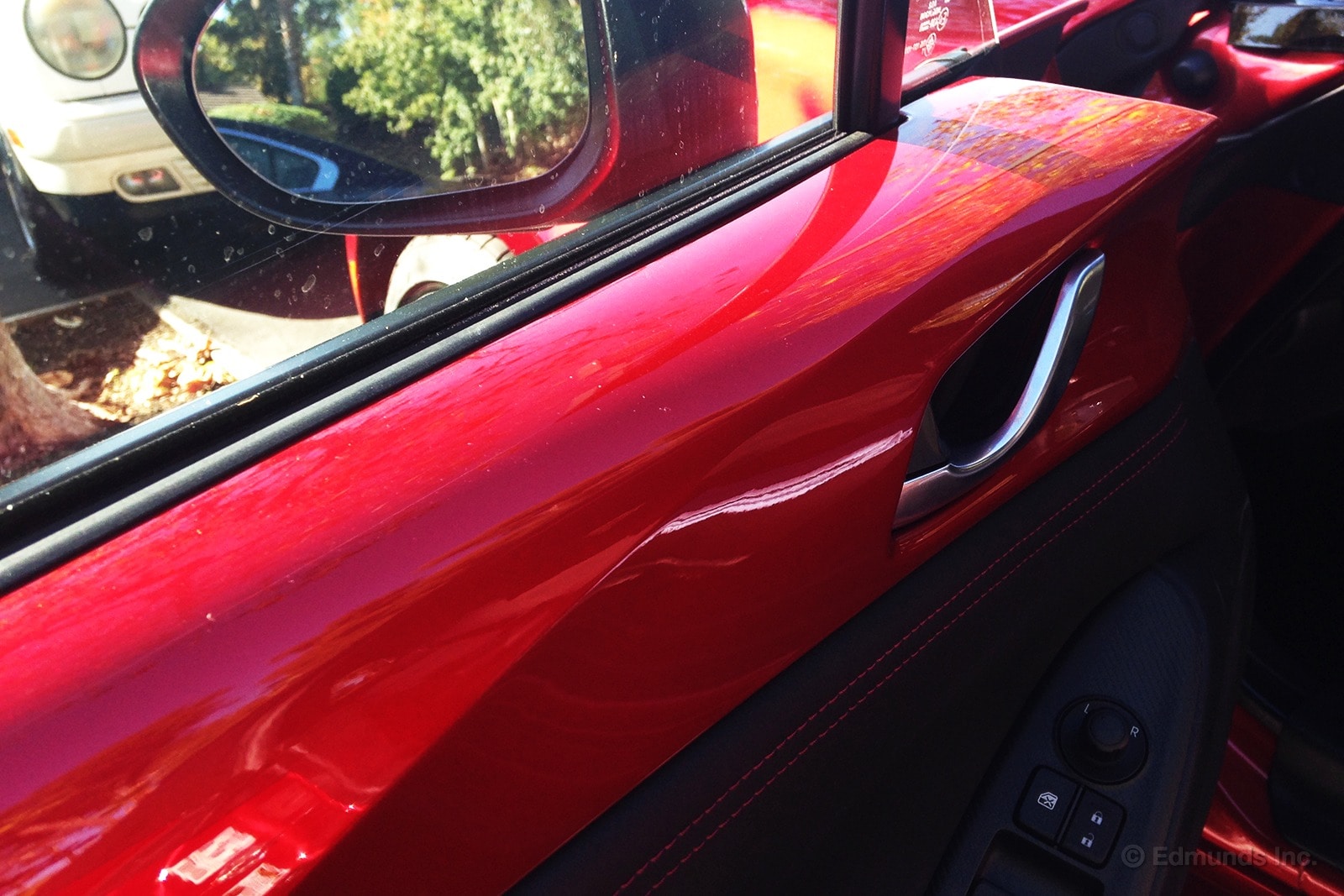
There's weight savings and then there's cheap.
Our 2016 Mazda MX-5 Miata is brilliantly light and responsive, and nimble and athletic and lithe, and any other number of other auto-journo adjectives you could use to describe a car that generally moves exactly where you point it, when you point it. And no doubt its bantamweight 2,332 pounds is a key component of this character.
But some of the weight savings go a little too far.
The door armrest shown above, for example. Is it plastic? Is it fiberglass? I don't know. You know what it is? Uncomfortable. No cushion up there. No fake cowhide. No left-hand tan accommodation in this car. I get it. The Miata seems to say, or its designers seem to say, "Elbows bent, hands at 10 and 2, if you wanna drive me, pal."
OK, Colin Chapman.
You know what? If I own this, I'm driving it to San Diego on Pacific Coast Highway more than I'm driving it on a dusty track in the middle of the Los Angeles high desert scrub. And when I'm driving to San Diego on PCH, I want to hang up my elbow and forearm on occasion. Can I have the door upper in cushioned body color fake cowhide? I'll pay extra for it and I promise I won't tell anyone at SCCA (the hard body-color upper is standard on Club and Grand Touring trim levels).
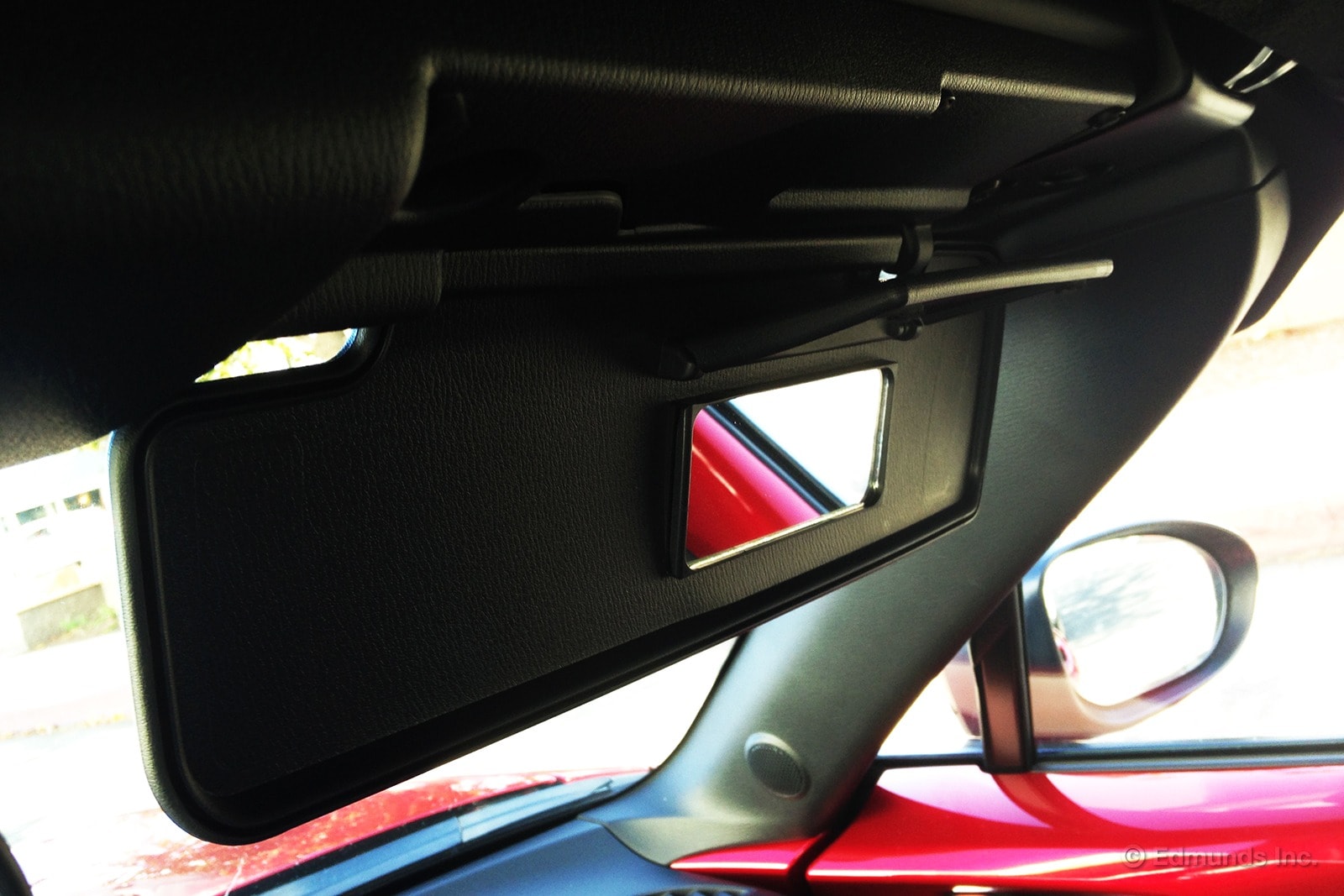
Exhibit B: Sun visors. Come on. This is just 99 Cent Store discount here. Even a good pal who drives a '99 Miata first remarked, "wow, these feel flimsy." I mean the plastic itself is firm and fine, if thin and light. I know; it's a sun visor. A gram here, a gram there. Fine.
Will my Miata perform worse if it weighs 2,334 pounds? Slippery slope yes, I get it. But I'm not asking for a 12-inch subwoofer and 400-watt amp here.
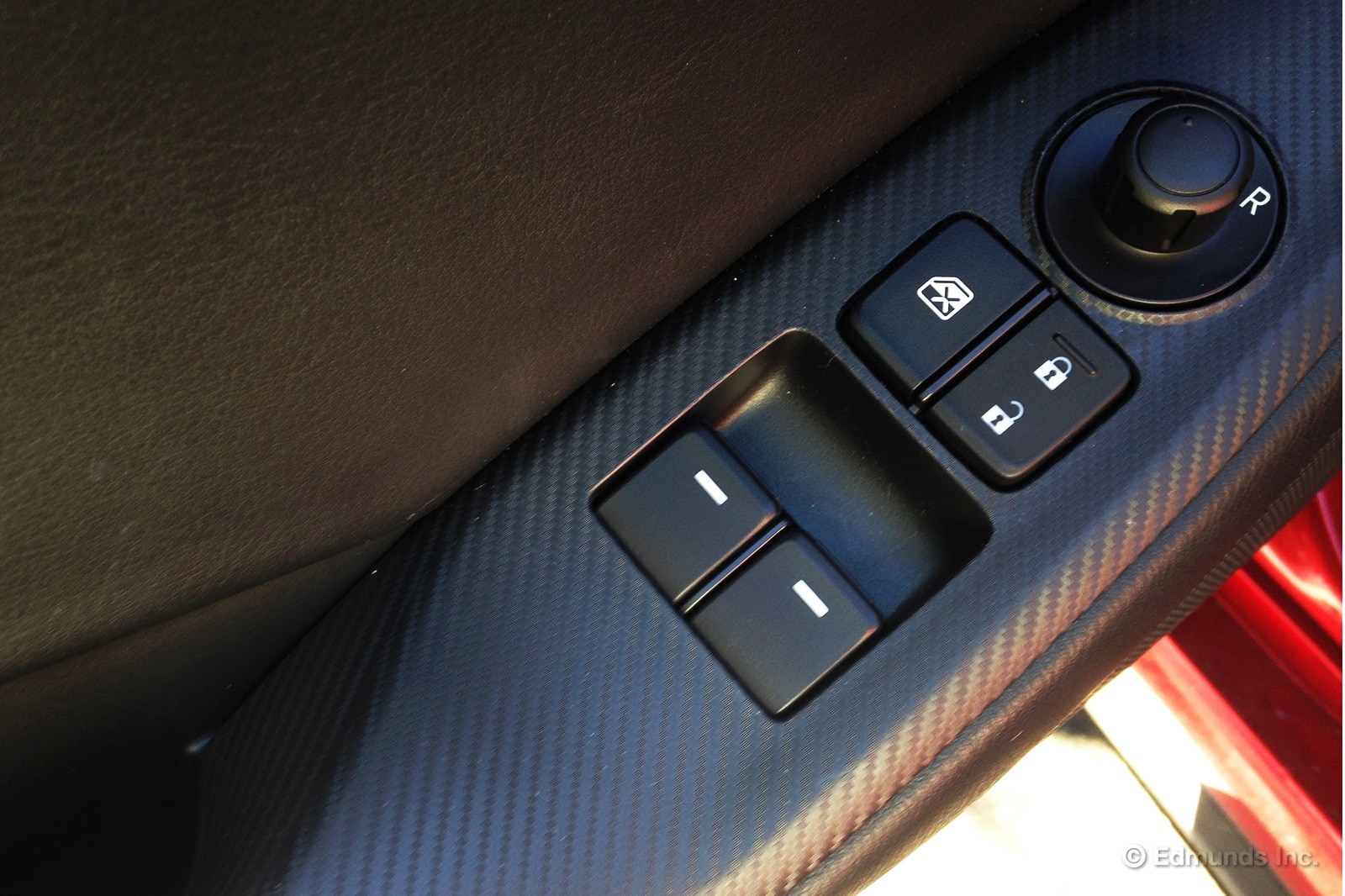
Exhibit C: Not necessarily cheap, but cheese. Can the industry-wide carbon trim obsession please go away now?

I'm not the least bit surprised that our 2016 Mazda MX-5 Miata has a nearly perfect set of gauges. When the sole mission of a car is driving enjoyment, you don't need to crowd the gauge cluster with extraneous extras.
Here you have the tachometer front and center, an easy-to-read speedometer and a multifunction binnacle on the left. All of them have crystal clear white-on-black markings that are readable at a glance and none of it overwhelms you with information. This is all the information I need during daily driving, so I wouldn't change a thing.
If I had to make an improvement, I might clean up the left side a little, but that's being picky. If anything, the temperature gauge should be applauded for having actual numbers. That's rare these days. I also like the fact that it has a simple button to reset the trip meter. No searching through menus to reset things here.
It's simple things like this that make the Miata so enjoyable. Even after all these years of tinkering with the formula, some things haven't changed much. And that's a good thing.
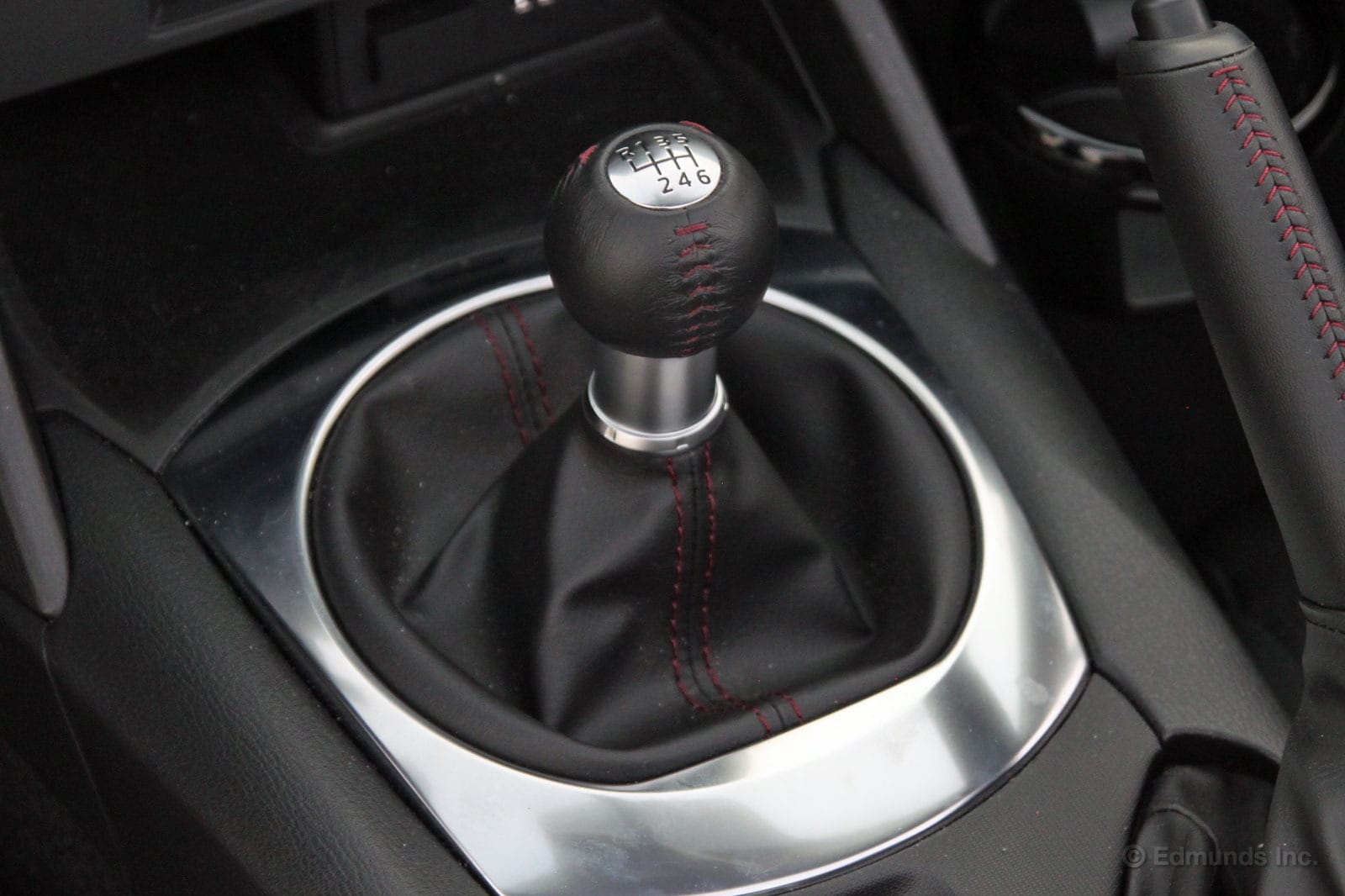
This little shift lever here is one of the most satisfying things about our 2016 Mazda Miata. And I'm not talking about its mere existence either. That's another argument entirely.
This shifter is satisfying because of the way it works, the way it feels in your hand, and to a lesser degree, how perfectly simple it looks. While some of my fellow editors have noted that the ergonomics of this Miata get in the way of enjoying this shifter to its fullest extent, I barely noticed.
From its light feel through the gates to its notchy engagement, this shifter encourages you to change gears just for fun. The crisp engagement of the clutch only makes it that much better. Usually I avoid cars with a manual because of my 60- to 90-minute commute home in stop-and-go traffic. In the Miata, I didn't think twice about having to shift a few hundred times.
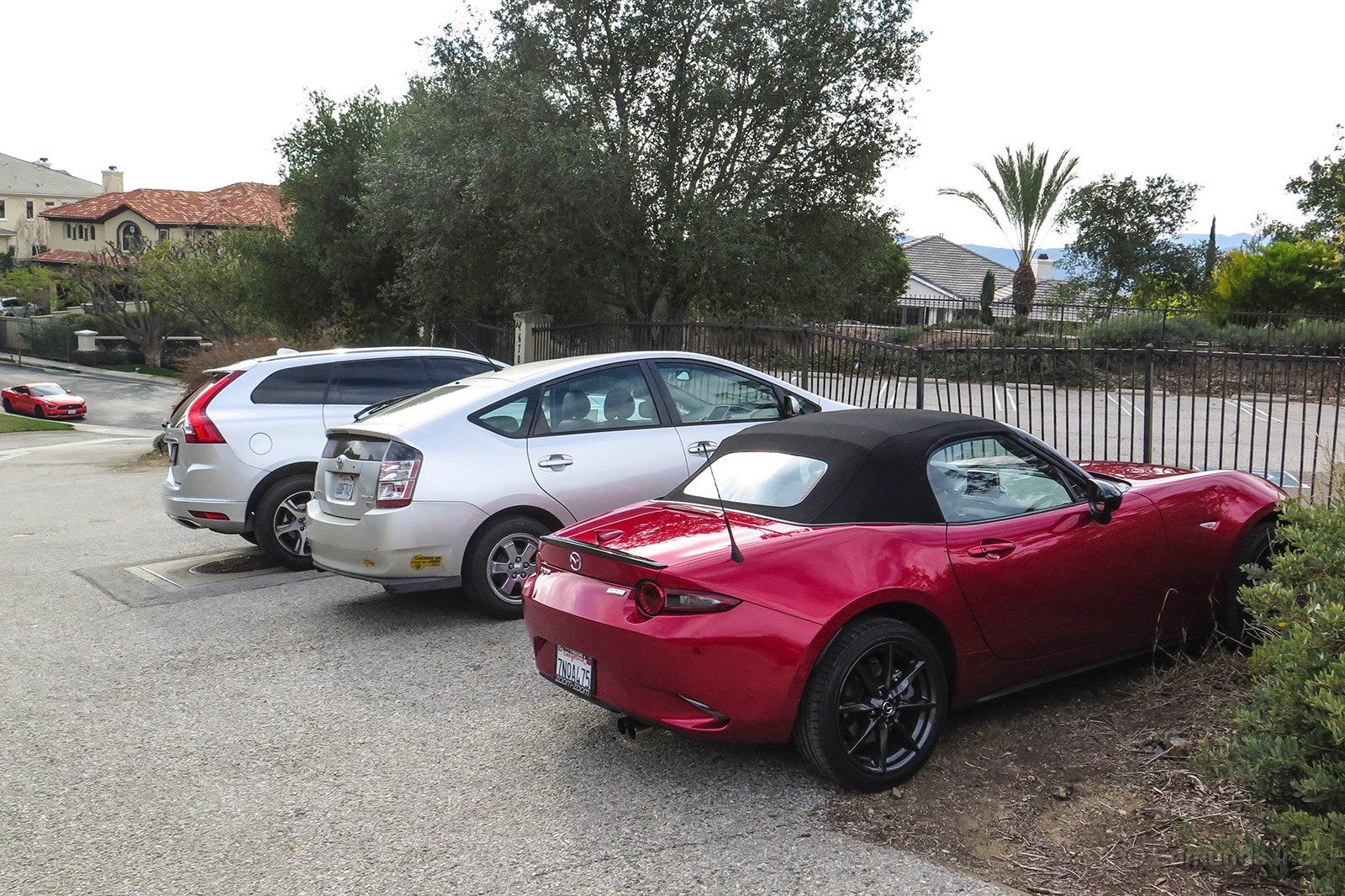
One of the best cases for buying a 2016 Mazda MX-5 Miata is its size. Big Cadillac over the line in the Whole Foods parking lot? No problem. Only open spot is between a bush and a Prius? Easy. Tandem parking with an eighteen-wheeler? Room to spare.
Compare it to almost anything else on the road (excluding micro cars like the Smart, which are more like Power Wheels, really) and the new Miata is tiny. It's lighter and shorter, in both height and length, than the previous-generation MX-5 and it's extremely nimble at slow speeds, so it can fit in almost any parking spot you come across.
At least a dozen times this week, I saw a parking spot that would've been too small for any other vehicle in our fleet, but there was plenty of space for the Miata. The turning radius is tiny, the hood is low and easy to see over, and steering is light. It's fun to drive on the open road, no doubt, but it's almost as rewarding for a grocery run, when you don't have to drive around for 20 minutes looking for a spot.
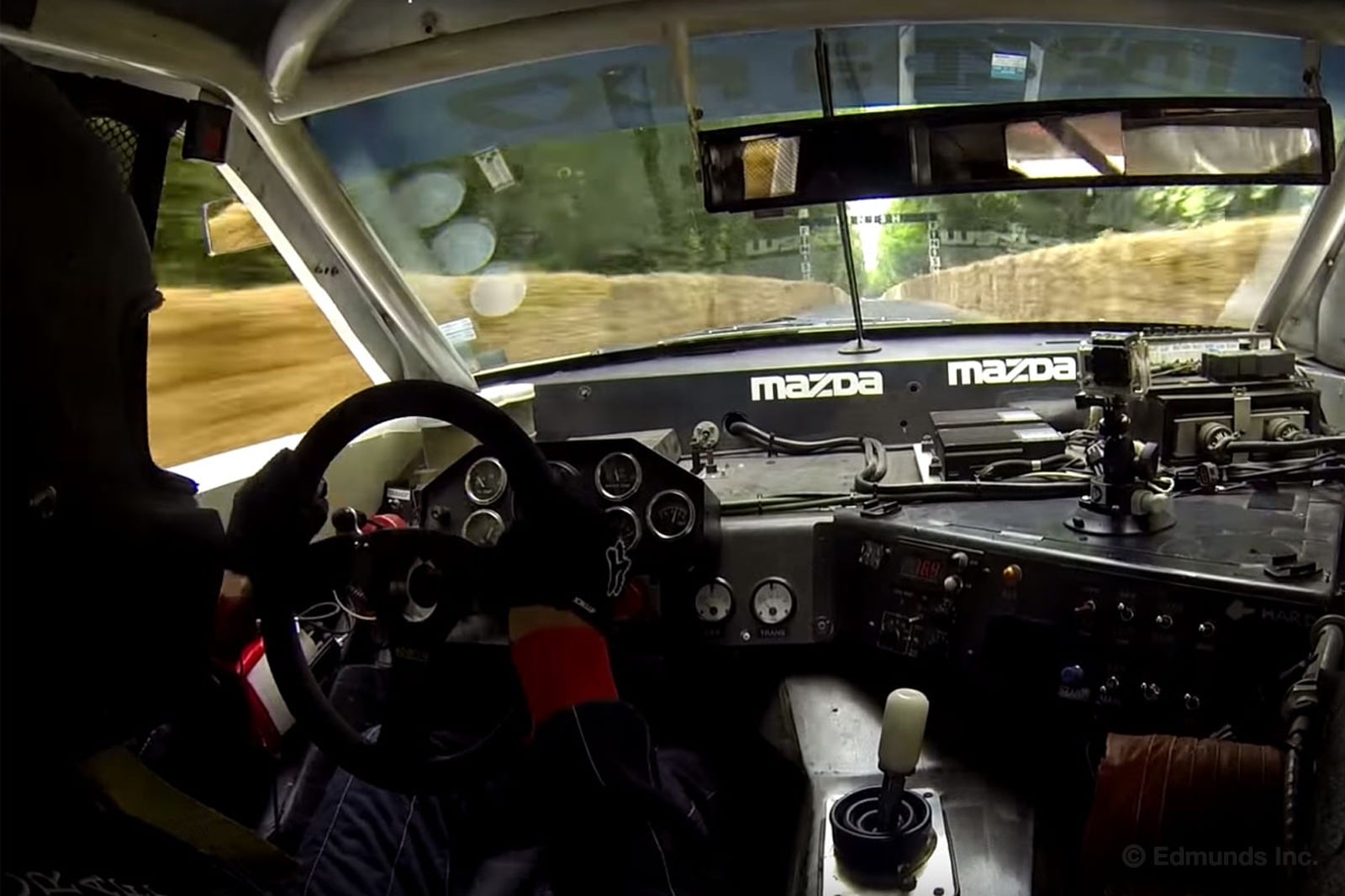
It is the sad trombone of the automotive world: The rapidly diminishing groan of a starter motor straining to crank with too little current. It's a start-line diminuendo that terminates in an awkward anticlimax before 150,000 or so spectators.
I did this. Go me.
It's the Goodwood Festival of Speed last June and I am driving, or attempting to drive, the 1991 International Motor Sport Association's GTO championship-winning RX-7 up the hillclimb course.
It's not a Miata. In fact, it's not even really an RX-7, at least by the standard Mazda offered in the production car. But it is powered by a Mazda engine and it is made for driving hard, traits that it shares with our long-term 2016 Mazda MX-5 Miata.
Click through for a video of the whole fiasco, as well as the run up the hill.
Built by Fabcar Engineering and designed by Lee Dykstra, this car is to a second-generation RX-7 what a Montana Class battleship is to a bathtub duck. Its steel tube-frame chassis is pure racecar hardware wrapped in a carbon-fiber body. It's powered by a normally-aspirated four-rotor R13J Wankel engine, coupled to a Hewland five-speed dog-engagement gearbox. Output is about 640 horsepower, which serves as ample motivation to the car's 2,100-pound curb weight.
At Goodwood, the car was geared for 160 mph, which is about 100 mph more than I needed. Endure the first two-and-a-half minutes of electron jockeying in the video and you'll notice, as soon as the RX-7 rolls off the line, that it's a handful. The steering is busy, particularly under braking, and like most race cars it demands direct and deliberate control inputs.
Though managing it is a clearly a point of pride among those who do so regularly, it's not an easy car to drive fast - at least not here where the road width exceeds the Mazda's track width by about 10 inches. And it has a dark side. Like an ornery child or a top-fuel dragster, if you're not driving it, it's driving you.
Still, there's something immensely fulfilling about punching through the closely-spaced gears. The dogleg shift pattern (first gear is toward the driver and back) means that the most frequent shifts are only a push or pull. Once moving, the clutch isn't necessary for upshifts, but breathing the throttle at exactly the right instant is. My ill-timed yanks on the shifter are apparent at 2:40.
And for some reason, when I'm under pressure, all the nervous energy leaves my body by shaking the shifter.
Like its cousin the 1992 RX-792P, the RX-7 GTO wore rain tires at Goodwood. After all, there's no practice, no tire warming, and no warning labels at this event. Only hay bales and goodwill separate the masses from the inexperienced hands driving a car like this. It is a place that exists on passion and personal responsibility. And it works, brilliantly.
The RX-7, for its part, added to the rawness of the experience. In motion it's all gear noise and rorty flat-pitched exhaust. It's a machine made for winning races, which is exactly what it did seven times in 1990 and 1991. It makes no apologies for this character, nor would we expect any.
Mazda Director of Public Relations, Jeremy Barnes, who drives the car regularly, offers the following: "You've just got to grab it by the scruff of its neck and show it who's boss," a statement with which we find no fault. And one that he deftly demonstrates racing the car in events like the Monterey Motorsports Reunion.
In any event, the RX-7 GTO is a hand-built, race-hardened instrument for slaying racetracks. Which in most ways is what our Miata does to back roads.
Fuel Economy Update for December — Future Looks Bright
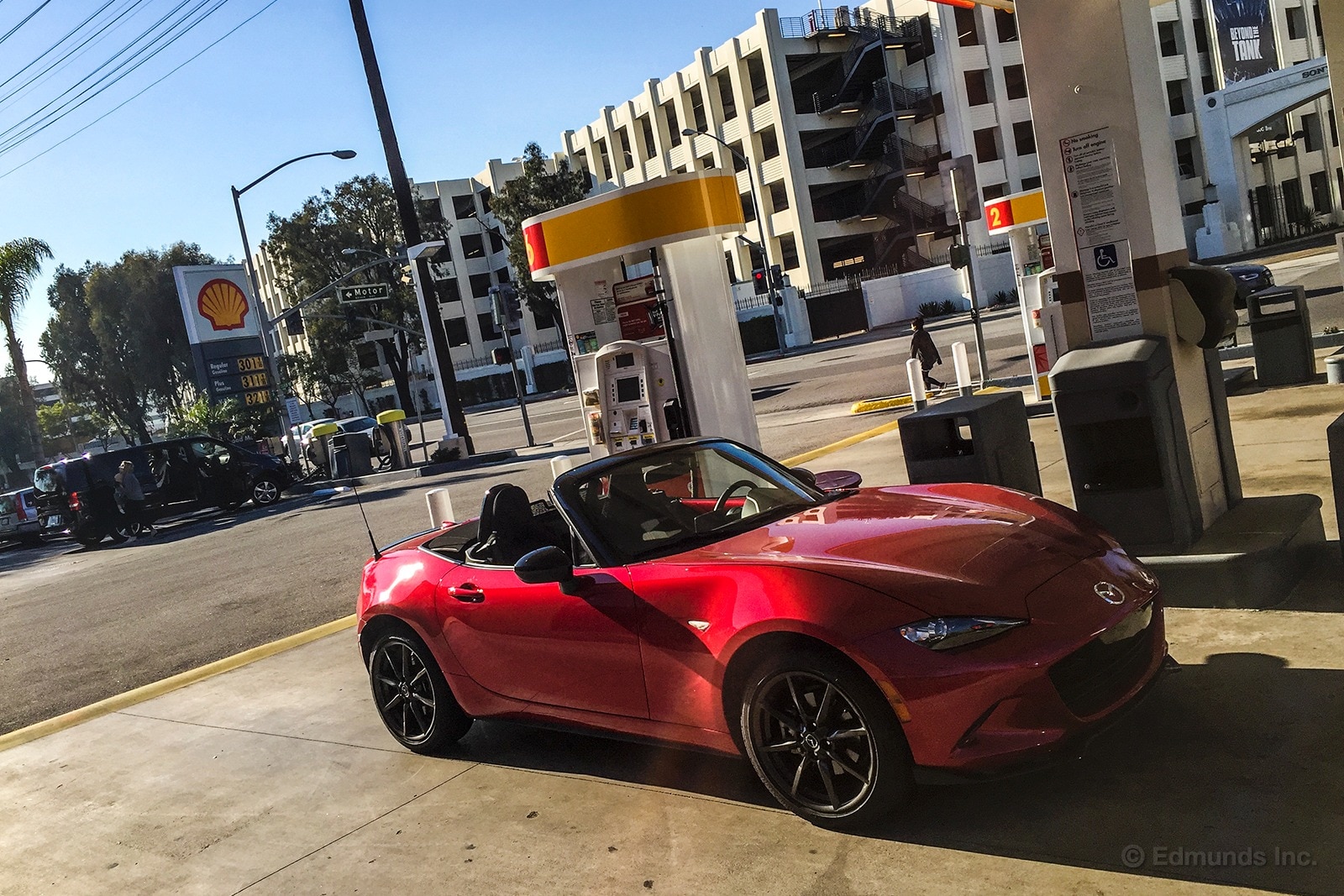
Since our long-term 2016 Mazda MX-5 Miata was added to our fleet late last month, we didn't have much time to accumulate fuel-economy data in November. At the end of December, there was more data to look at and we've got our first glimpse of what we can expect from the Miata over the next year.
The Miata arrived at our office with 800 miles on the odometer and since then we've added about 2,700 miles of our own. We've already beaten the EPA's highway estimate with a long road trip at the hands of Testing Assistant Reese Counts. Overall, we're hovering right around the combined estimate. So basically, things look great.
Worst Fill MPG: 22.2
Best Fill MPG: 35.7
Average Lifetime MPG: 29.5
EPA MPG Rating: 30 Combined (27 City/34 Highway)
Best Range: 321.5 miles
Current Odometer: 3,493 miles
VIDEO! Tech Interface and Cupholder Vlog
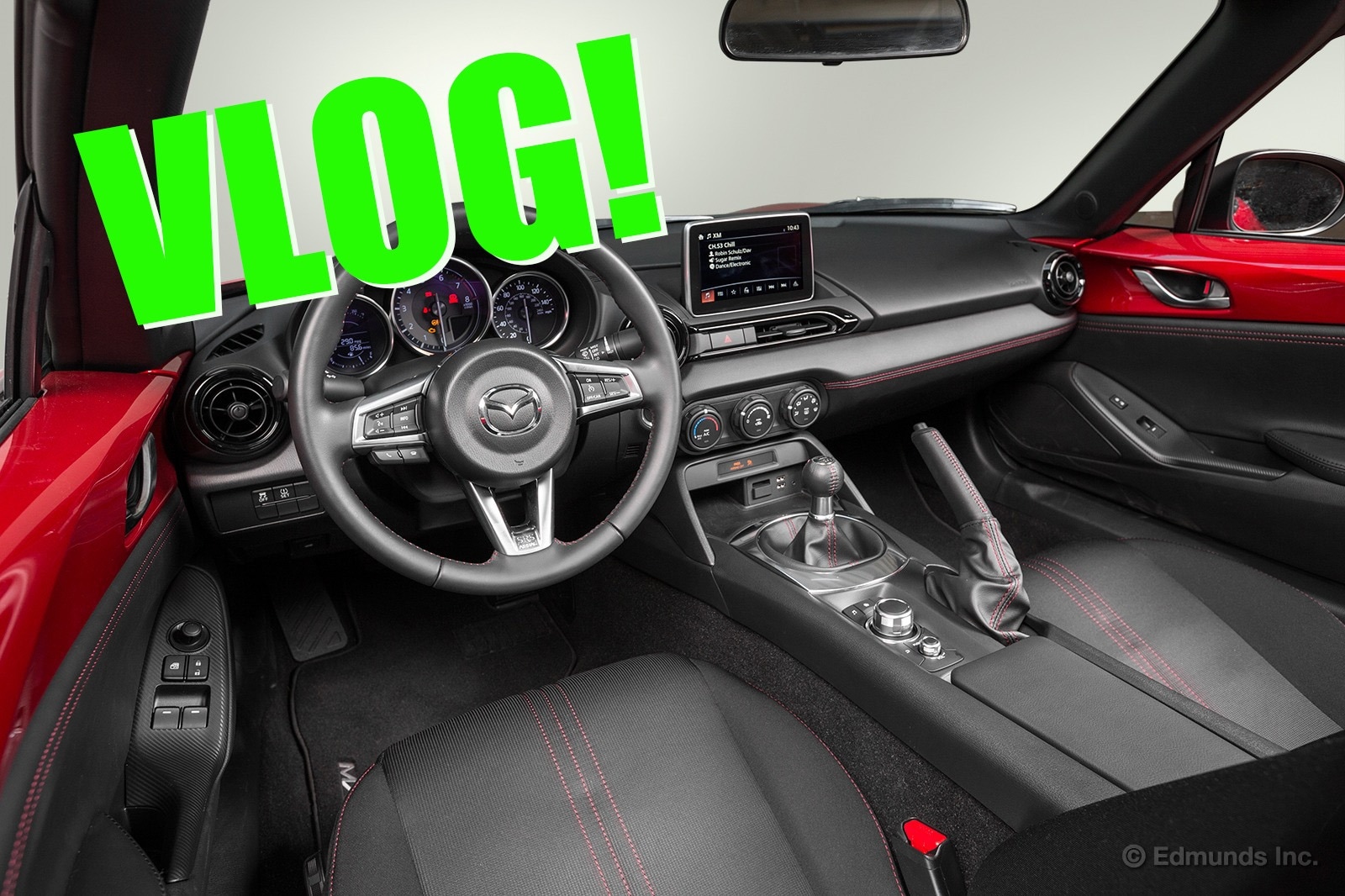
I've been told that my first post on our long-term 2016 Mazda MX-5 Miata can't simply be called "Weeeeeeeee!" with the text reading "Heel-toe! Downshift. Upshift, upshift. Turn for no reason. Turn again for no reason. Yaaaay!"
As such, I've shot a video blog (or "Vlog" as it is called on this here Interwebs) about one of the few drawbacks I've discovered about this wonderful little car. Please click through and enjoy.
Best thumbnail possible? I think so.
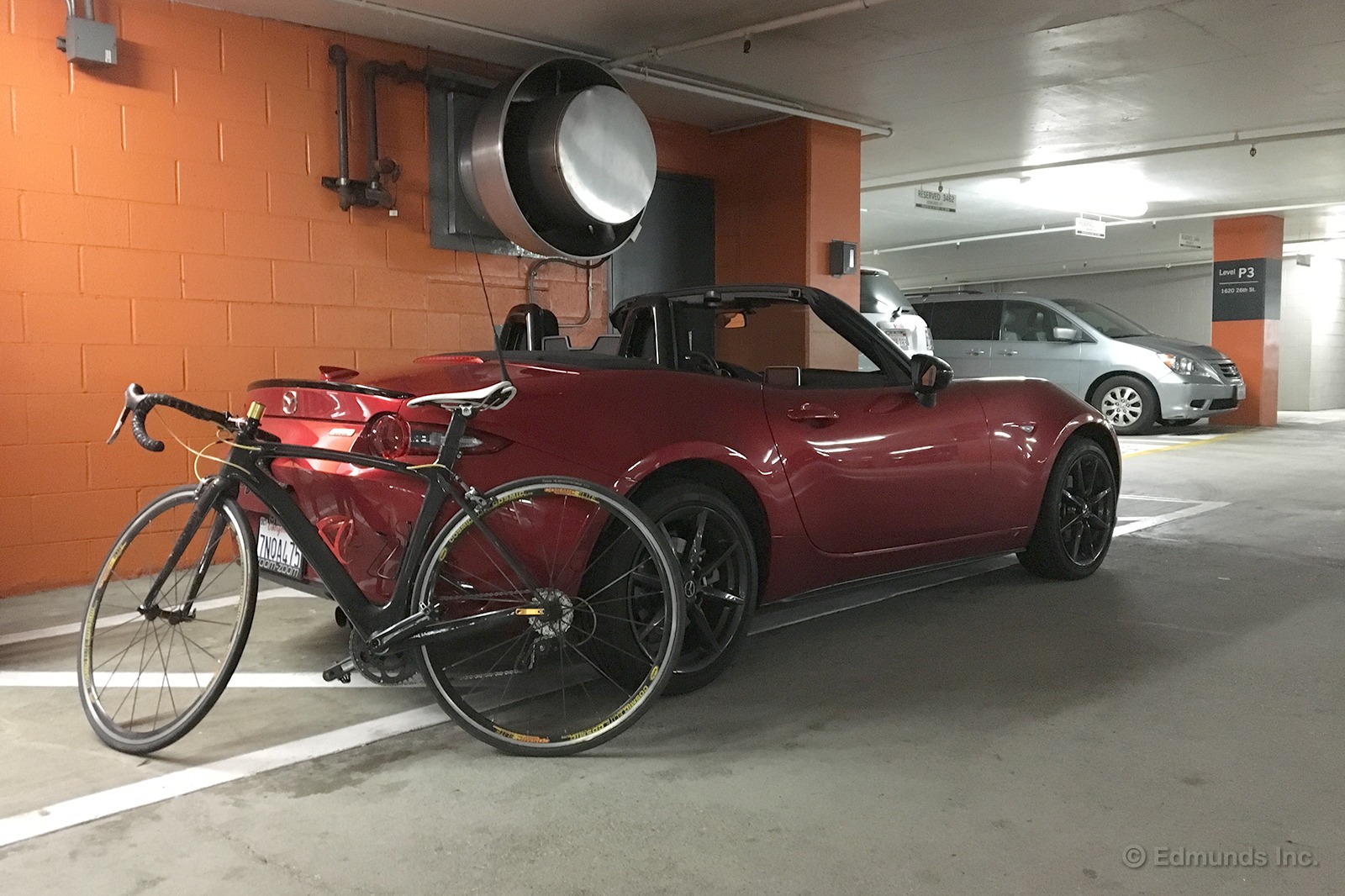
You may not know this, but the 2016 Mazda MX-5 Miata is not a very large car.
Does the bike fit?
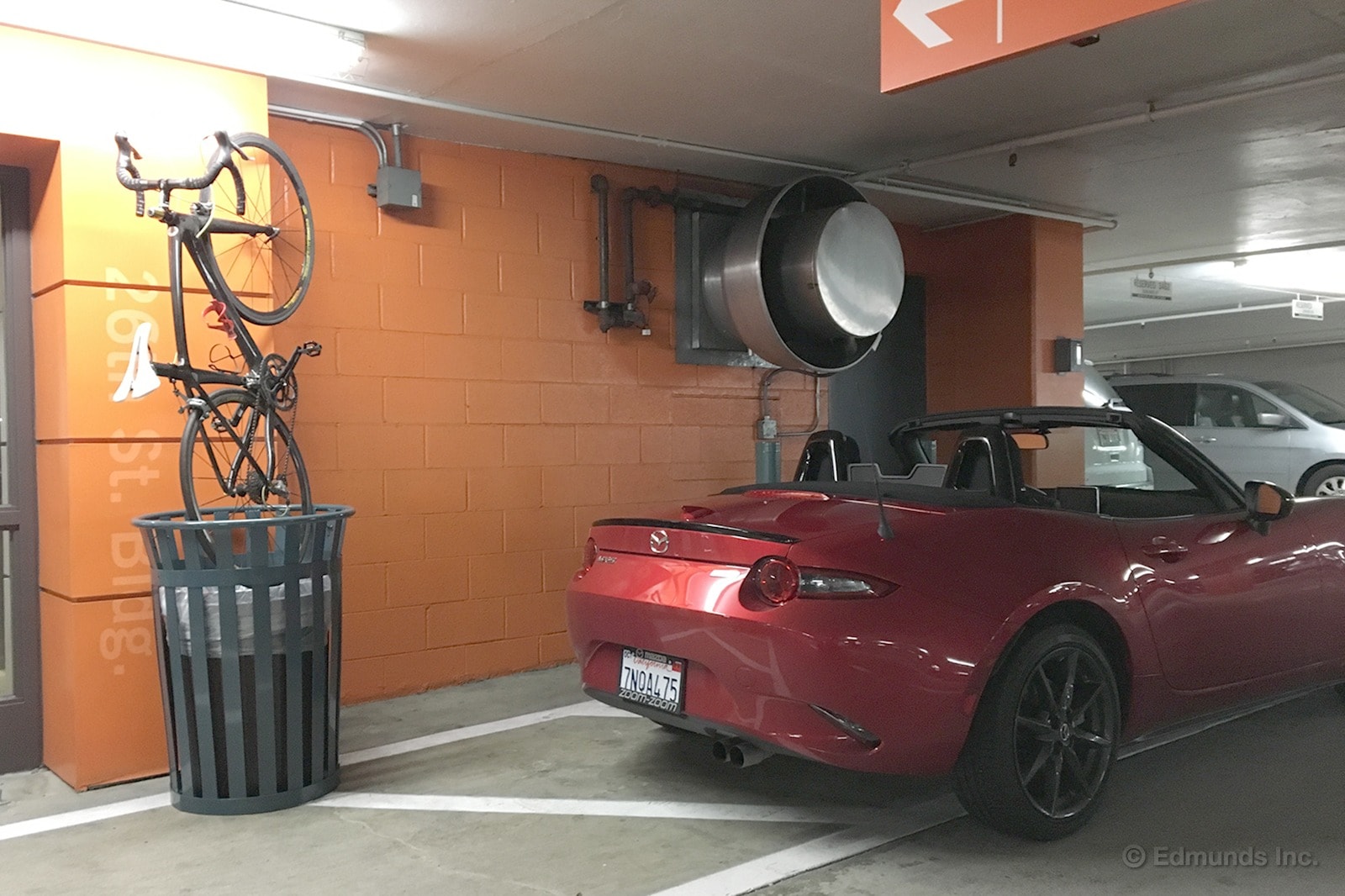
Yes.
And for good measure I threw out the Miata keys too, and took the Viper home.
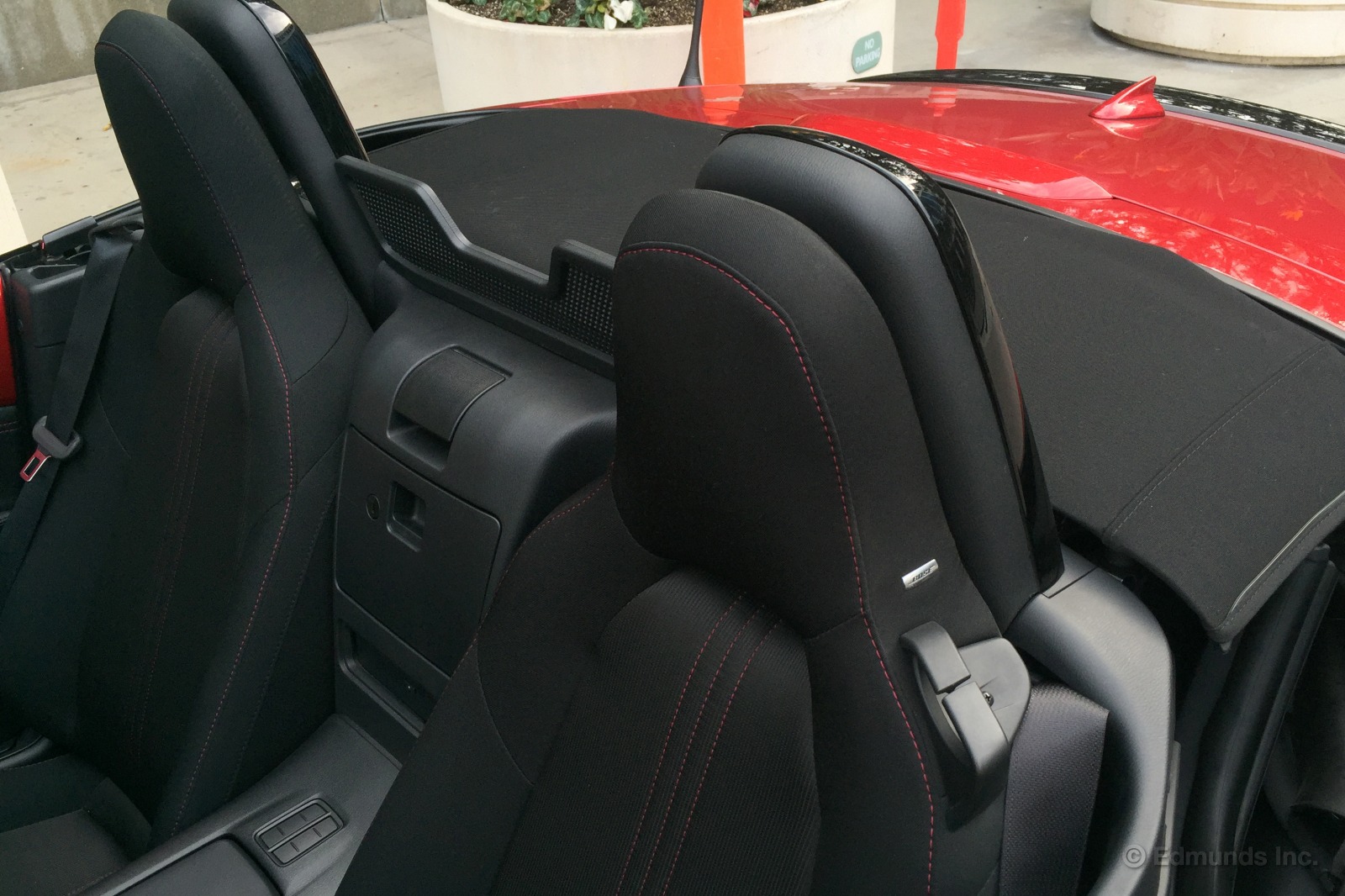
Bentley made waves last week when it announced that, like Mercedes-Benz before it, buyers will soon have the option to order their Flying Spur or Continental with a stone-trimmed interior. But while Bentley buyers will have to pay an obscene amount of money for their stone veneers, I found something just as rock-hard in our 2016 Mazda MX-5 Miata.
And this car only costs $29,850.
If I didn't know that there were aggressive weight reduction targets for this new MX-5, I'd swear that the headrests were made from a slab of granite. There's a thin bit of cloth that covers the headrest, but there doesn't seem to be any cushion at all underneath. That wouldn't normally be a problem, but my head is butted up against the headrest for a variety of reasons.
It's mostly because the Miata's interior is exceptionally tight for my 6-foot, 4-inch frame. There's a delicate balance in finding a driving position that doesn't bury my head in the roof liner.
My optimal position in the MX-5 is moving the seat back until it is two notches from the end of the rail, then reclining the backrest as far as it will go. The non-adjustable headrest is angled forward, which makes it difficult to not lean my noggin against it.
The ride is appropriately busy, so my head constantly skips off the headrest, a headrest that feels like it has no padding whatsoever. From there, the choice is between further compromising my seating position and just dealing with the headache. Rather than bending my knees and potentially impeding steering wheel travel, I choose the head thumper.
Most of the other editors are shorter than me, so they can sit a little further forward and recline the seat a little more. Thus, their heads don't hit the headrest and it doesn't cause discomfort. Maybe I'm just not made to fit in this car, but there's no reason the headrest shouldn't have more padding for people who actually rest their head on it.
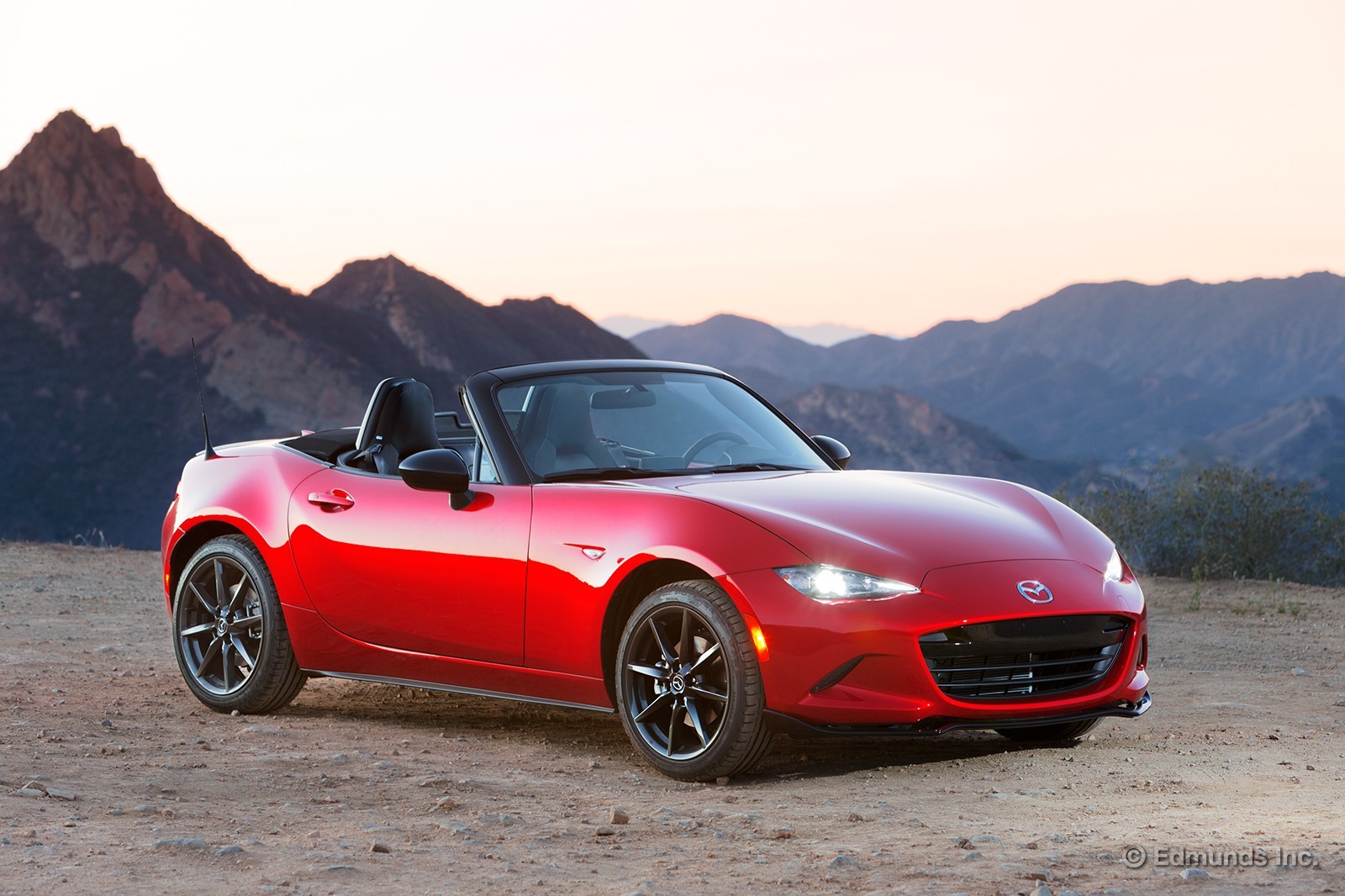
I signed out our new 2016 Mazda MX-5 Miata last weekend. But I didn't get a chance to drive it as much as I'd hoped. There were lots of homebound chores to do. At times it was raining felines and canines. And the four of us had places to go together on two different occasions.
In between, I jumped in into the Miata whenever I could. I needed something at Home Depot. I drove to the auto parts store to buy an oil filter for my wife's car. I carted my daughter to a friend's house for a sleepover. I was never going fast, there were no epic on-ramps to attack and the threat of rain hung in the air. Excluding the drive to and from the office, I bet I didn't put 50 miles on it.
None of that mattered. The new Miata's greatness shined through on the most mundane of streets. The genius of this car is how engaging it is even when you're going to the post office to buy stamps. It forges a connection between machine and driver at two-tenths like no other car I've ever driven. I absolutely love it. I need one of my own.
And yes, I put the top down — frequently. I hate the sun beating down on my cranium, so a cold gray sky was all right with me. I equipped myself with a thin jacket and a ball cap and cranked up the heater. I'm that guy.
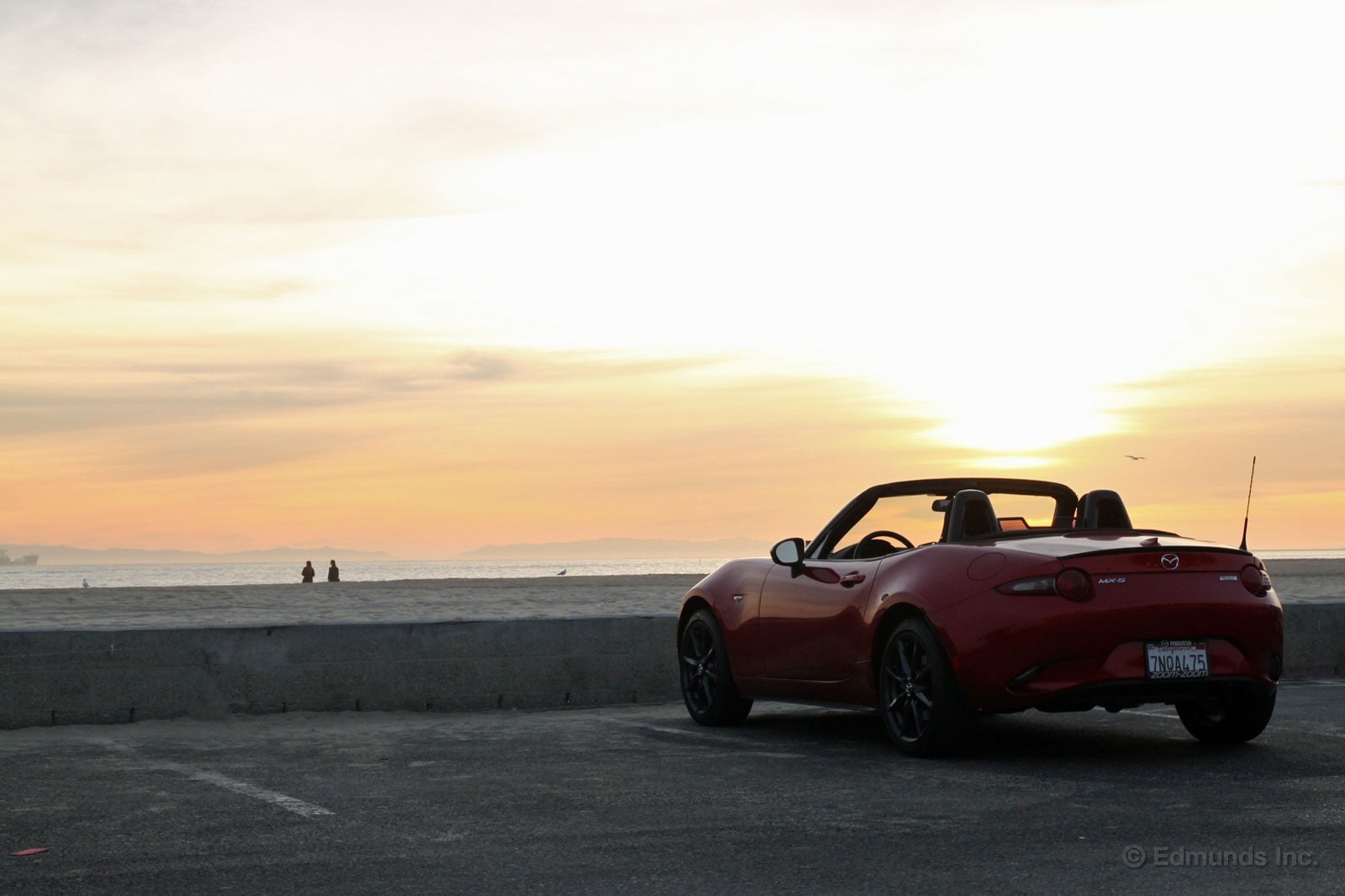
It's easy to scoff at the idea of buying a convertible like our 2016 Mazda MX-5 Miata: Two seats, tiny trunk, and a roof you can cut through with a pair of scissors. Then you drive it on a nice day and all those things suddenly seem like minor inconveniences.
That more or less sums up my feelings after taking our new Miata for a leisurely drive on a recent sunny afternoon. The top flops down easily, it's not too windy at speed and it doesn't sound half bad. The car even feels a bit smaller with the top down, which seemed impossible up to that point.
Obviously, the ability to drive around with the top down is dictated by the weather and your hairstyle. Neither of which are issues with me on any particular day, but I was surprised by how enjoyable the Miata is with the top down. It's easy to forget sometimes when you don't drive a convertible for awhile. One quick spin in the Miata is all it takes to remind you.

Ah yes, that grand-old question that stretches all the way back to 2007 when my fellow editors started placing me places (front seat, back seat, third-row seat, trunk, Tesla Frunk) to see if I would fit. The "Riswick" actually became a unit of measurement. My granddad would be so proud?
Anyway, in that tradition I decided to tackle that question in regards to our teeny-tiny 2016 Mazda MX-5 Miata. And to properly address it, I did it in vlog form. Follow the jump to view.
And what would I calculate as the resulting measurement? Probably 0.95 Riswick.
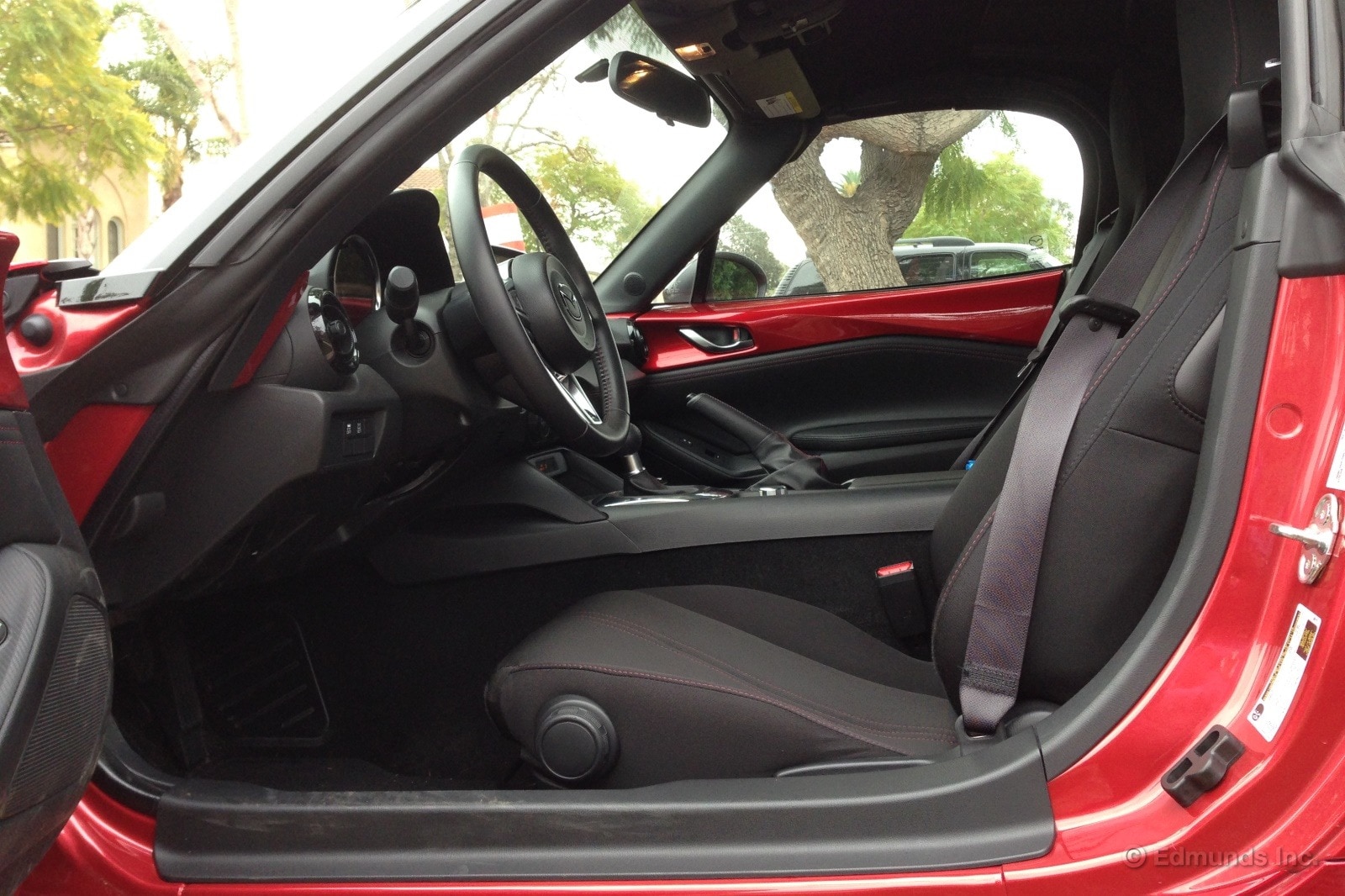
It's hard not to be impressed by our long-term 2016 Mazda MX-5 Miata. Clever design clues abound and it's clear that engineers spent a lot of time sweating the details.
Take its cabin. By cold, hard numbers, the cabin is smaller than that of the outgoing car. Yet there's actually more usable space inside. I'm 6 feet 1 inch tall, with a long torso, and I never feel cramped in there (I even have to slide the seat forward on its track a few clicks).
The sill is easy to navigate, but not so low that the bottom edge of the door drags on standard-height curbs (the large-radius trailing edge helps with this and furthermore allows the latch pillar of the chassis to be stouter). The seatback is designed to give you a couple extra degrees of recline than before. Its armrests are scalloped out a bit near your elbow. Footwell space is ample. The underside of the seat bottom is a skotch closer to the floor — all several minor revisions that make a real difference in its livability.
As for my colleague catching his sleeve on the multimedia knob when going for a gearchange, I can only assume his shirts have droopy, flouncy wizard-sleeves. For me, (and I suspect many others) this phenomenon is nonexistent.
There's a real sense of space, too. Yes it's a small cabin, but it doesn't induce claustrophobia. The slim dashboard, a glovebox located behind you (rather than consuming knee space up front) and the body-color door cards all give a sense of airiness by visually bringing the outside of the car into the cabin. I do wish the steering wheel telescoped, though.
This attention to detail extends to its outward vision, too. The windshield is placed closer to the driver so that its effective viewing angle is wider. Door-mounted side view mirrors team up with a tiny corner window to provide additional outward view. The creators of the Miata recognize how crucial it is to be able to see out of your sports car. The contrast in philosophy with cars like the Camaro is stark.
Like all Miatas, the rear three-quarters visibility is terrible, blocked by the wide "pillars" of the soft top. Good thing the top is ridiculously easy to drop. You can stow it in less than two seconds, and that's no exaggeration. Mazda has simply made a mockery of every other automaker's convertible top with this one.
The 2016 Miata truly is a sports car for the people.
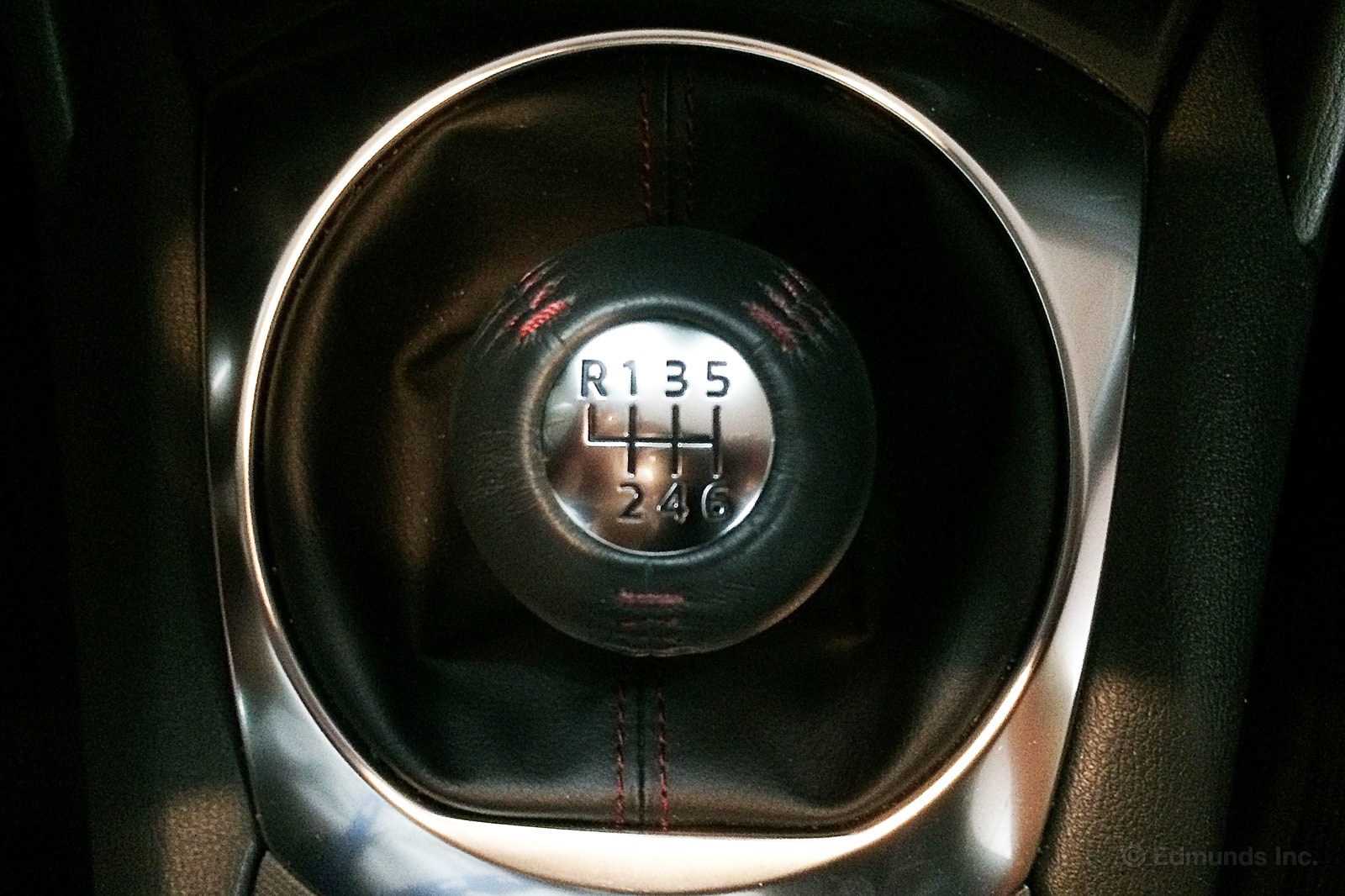
About seven years ago, I taught Christine, my then-girlfriend and now wife, how to drive a manual transmission car. The trainer car: A 1991 Mazda Miata I'd rescued from an owner that had stripped it for parts and sentenced it to a salvage yard. It cost me $200 and a tow from AAA to get it home safely, due to missing seat belts and four flat tires, then roughly another $300 to get it road worthy. Essentially it ran like clockwork forever after.
Our new 2016 Mazda MX-5 Miata has come a long way since 1991, but it's also very much in essence the same car it was 25 years ago. I'd argue it's also the easiest manual transmission car to drive, which makes it the best car to learn in.
This wasn't Christine's first encounter with a manual gearbox. She had a pretty good grasp of the concept after getting her motorcycle license earlier. But prior parking lot trials in other vehicles failed to instill enough confidence for her to venture out on the road.
Climbing into the rescue Miata idling in the office parking lot, Christine's apprehensive first attempt at engaging the clutch was met with a relatively smooth departure off the line. A handful more starts-n-stops and she was ready for second and third gear.
"I love this car!" she exclaimed. I'll remind you that this car, the object of her affection, was a write-off without a roof just a couple of weeks earlier. So what exactly makes the MX-5 Miata a car that novice and experienced drivers can enjoy on equal levels?
1. It's lightweight. Whether learning to engage the clutch without stalling the engine or flinging a car into a corner, the less mass, the better. On a flat surface, the MX-5's low curb weight allows you to release the clutch pedal (slooowly) without applying any throttle. This is a good way for a beginner to get the feel for clutch engagement and it avoids premature clutch wear from excessive throttle and clutch slip.
2. It has easy controls. From the weight of the clutch pedal to the easy responsive steering to the precise and positive gearbox, the MX-5's controls require little effort from the driver. This frees up your mind's attention reserves which are better spent on other aspects of driving.
3. It communicates well. New drivers likely won't be probing the dynamic limits of under- or oversteer, but having a good sense of when a clutch is in the friction zone or if the wheels are pointed straight is also valuable information when learning to drive.
4. It has great visibility. Experiencing open public roads as a new three-pedal pilot is daunting. You become hypersensitive to things around you and possibly overly concerned with how other drivers perceive your competence. A car's cabin can feel like it's contracting around you and its blind spots seem even more obstructive. In the Miata, drop the top and you gain instant, 360-degree clarity and a large payload of fresh, mind-clearing air.
5. It feels resilient. Despite its size and lightness, the Miata's running gear feels anything but frail. The solid shift linkage delivers positive gear engagement and the inline-four engine feels willing, even eager, to stretch its legs running up to the rev limiter. Feeling like you're not damaging the hardware helps with confidence and confidence helps you progress as a driver.
After driving around the neighborhood a bit, Christine drops me back off at the office.
"Would you mind if I drove around a little more and practiced my hill starts?" she asked.
"Of course not, " I replied with a smile and much internalized pride. At the time I thought that meant I was a pretty great teacher. Turns out it was mostly the car.
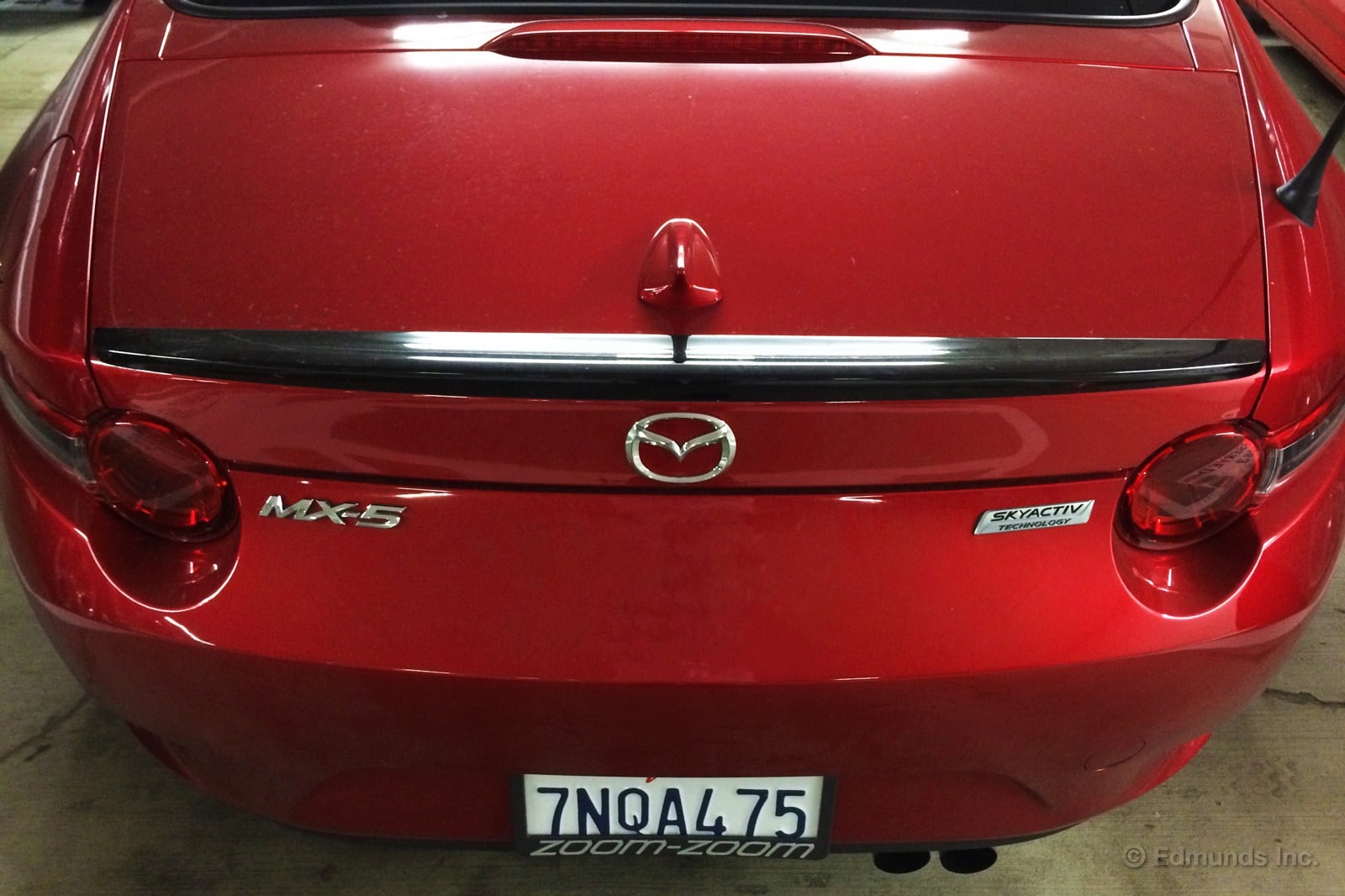
Walking up to your car with hands and arms full of stuff, it feels like a recurrent relay race against gravity as you struggle to gain access to the cabin. Your keys have sunk to the deepest reaches of your pocket or handbag (or man-bag), conspiring to break your resistance against placing your personal effects on the ground. Yes, this sounds ridiculous, but you've probably been here too.
For cars with keyless access, this scenario is a distant memory. If I'm driving any type of four-door, my preferred loading location is the driver-side rear passenger door. But for coupes or roadsters, like our 2016 Mazda MX-5 Miata, it's the trunk.
With the aforementioned scenario playing out in some form recently, I circled around the back of the MX-5 in search of a trunk release button. Manufacturers place the trunk releases in various locations, and often try to make them as inconspicuous as possible. For example, Volkswagen likes to integrate the release into the rear emblem. Others have small buttons around the license-plate relief or hiding in plain sight in a taillight.
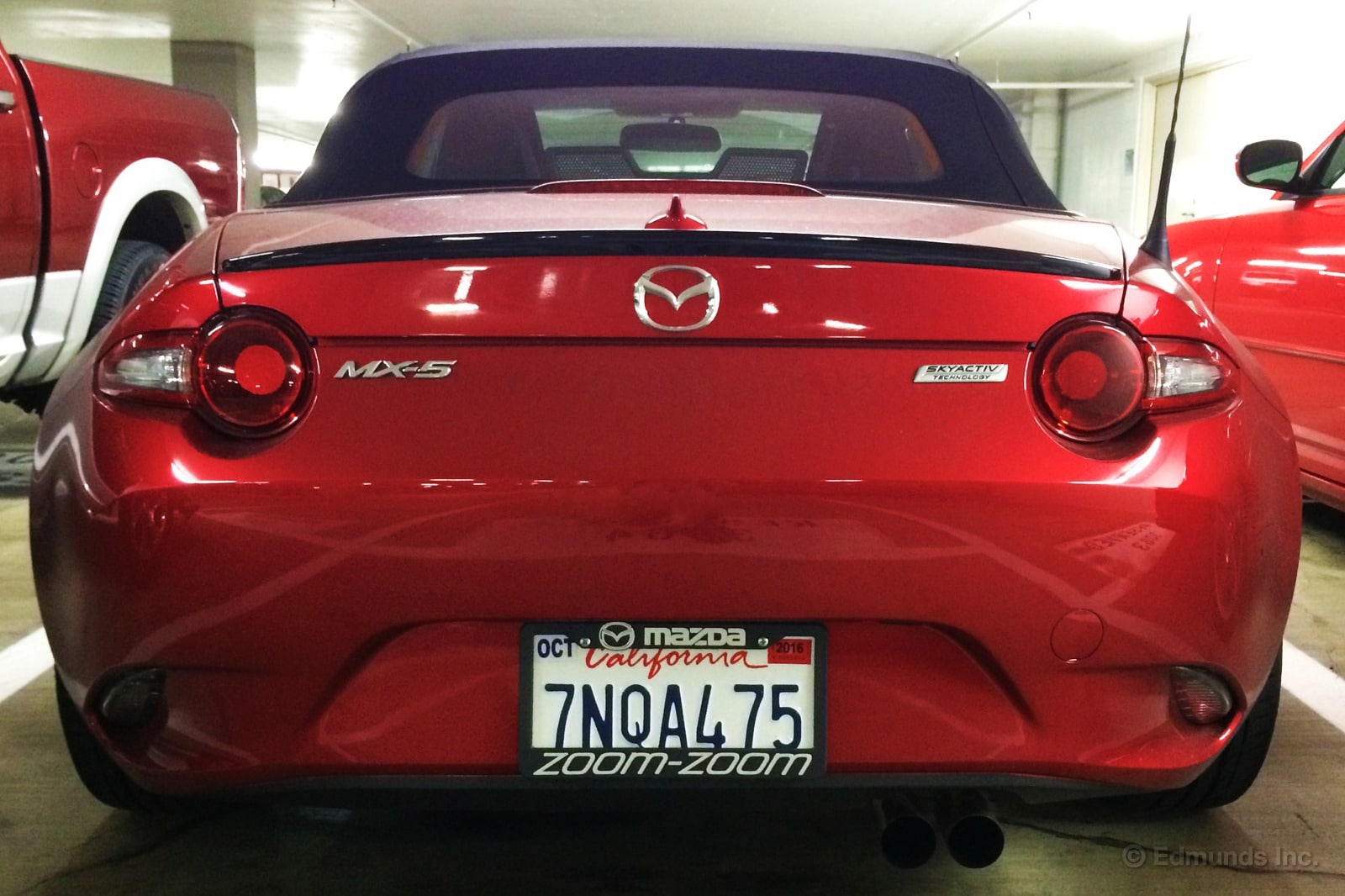
The MX-5's release was nowhere in sight. So I reluctantly unloaded some items into the driver's seat before fishing down into my pocket for the key fob to release the trunk. While doing so, I thought "What an oversight to have a keyless unlock button for the doors but not the trunk. There must be a button!"
So with fully unoccupied hands, I went back around to give the MX-5 a proper cavity search. Lo and behold, at about knee-level, a trunk button!
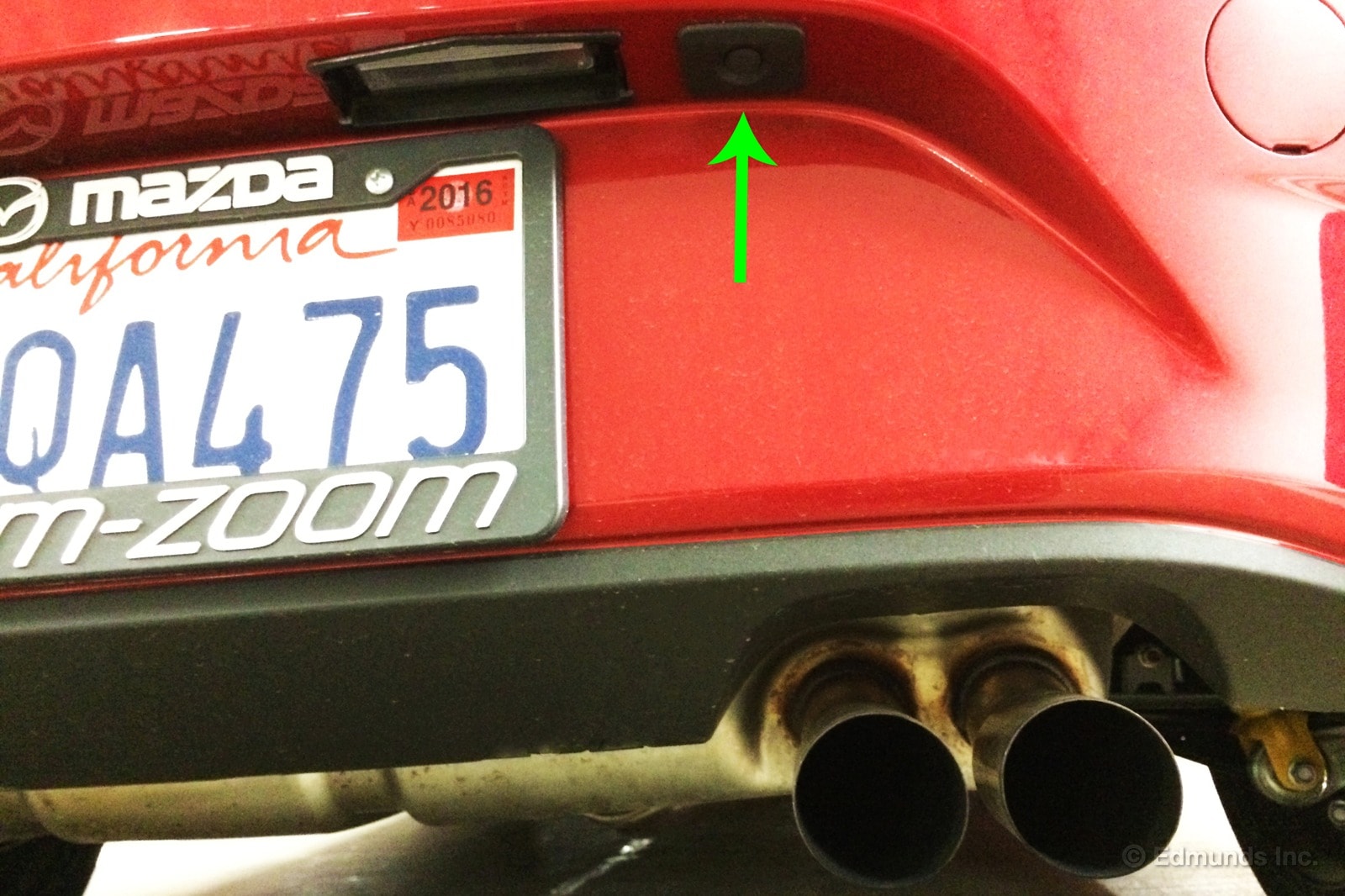
Due to the MX-5's shorter height, the taillights seemed like a more obvious location for a button. And even though this button is located lower than just about any other car I've come across, it remains easily accessible as long as you have a free finger to spare.
Clever Coolant Temp Gauge, But What About Oil?
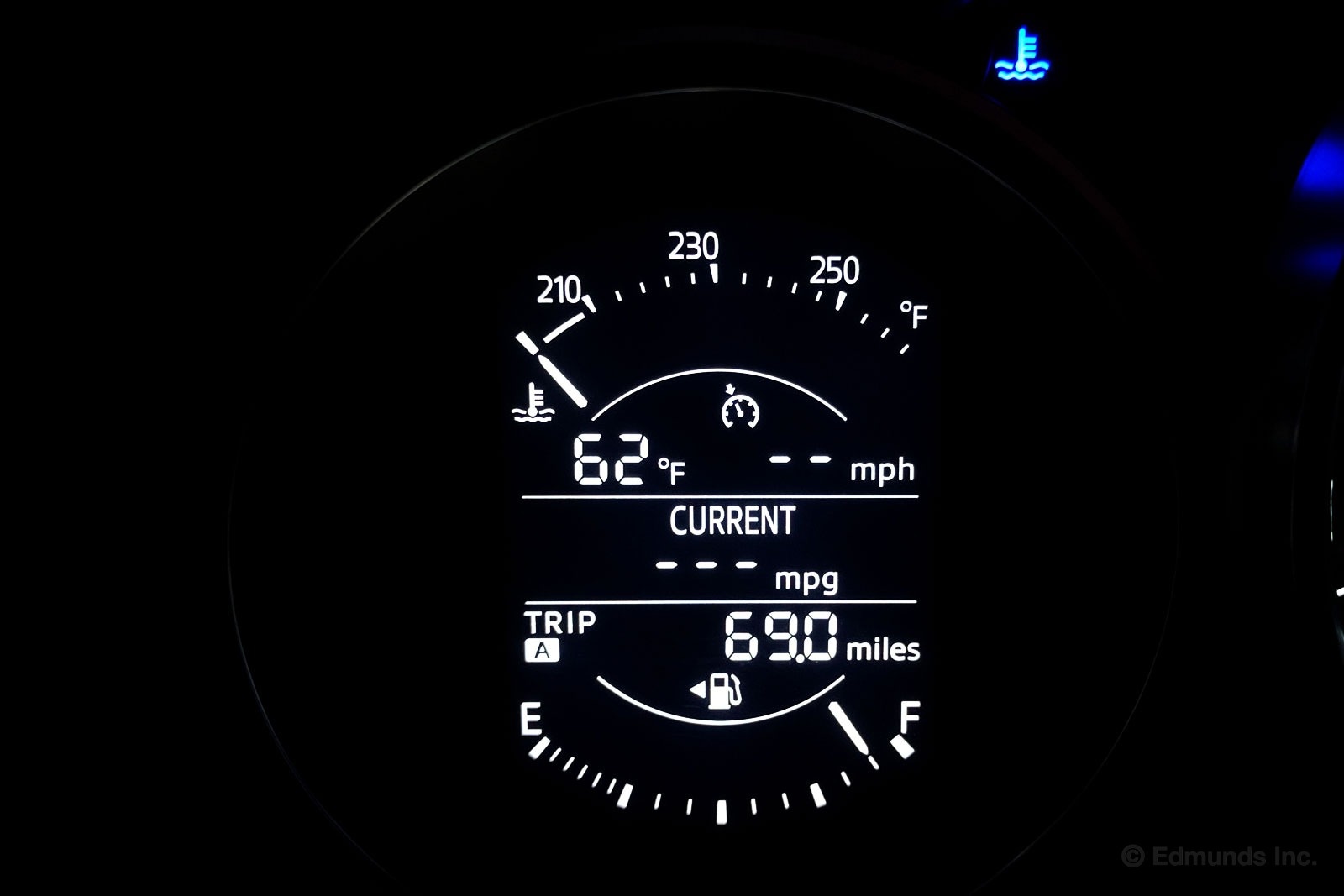
From the simplicity of the roof to its swappable cup holder system, our 2016 Mazda MX-5 Miata is full of clever and simple ideas. The coolant temperature gauge in the instrument cluster is no different.
When you start the car in the morning, the needle rests on the far left and a blue warning light illuminates, informing you the coolant is cold. Drive it a few miles and, after the coolant warms up, the light turns off. The needle though stays on the horizontal white line under 210.
Why? The gauge only shows the important temperature range. You only need to care about what it displays when you see the needle move from the left, which makes it easy to quickly reference when you're driving fast.
And yet it could be better. Ed Hellwig covered the instrument cluster's simple goodness, and I agree with his take on the aesthetic. I also remember fondly the real oil pressure gauge from the first-generation Miata and wish it and oil temperature were displayed here, too.
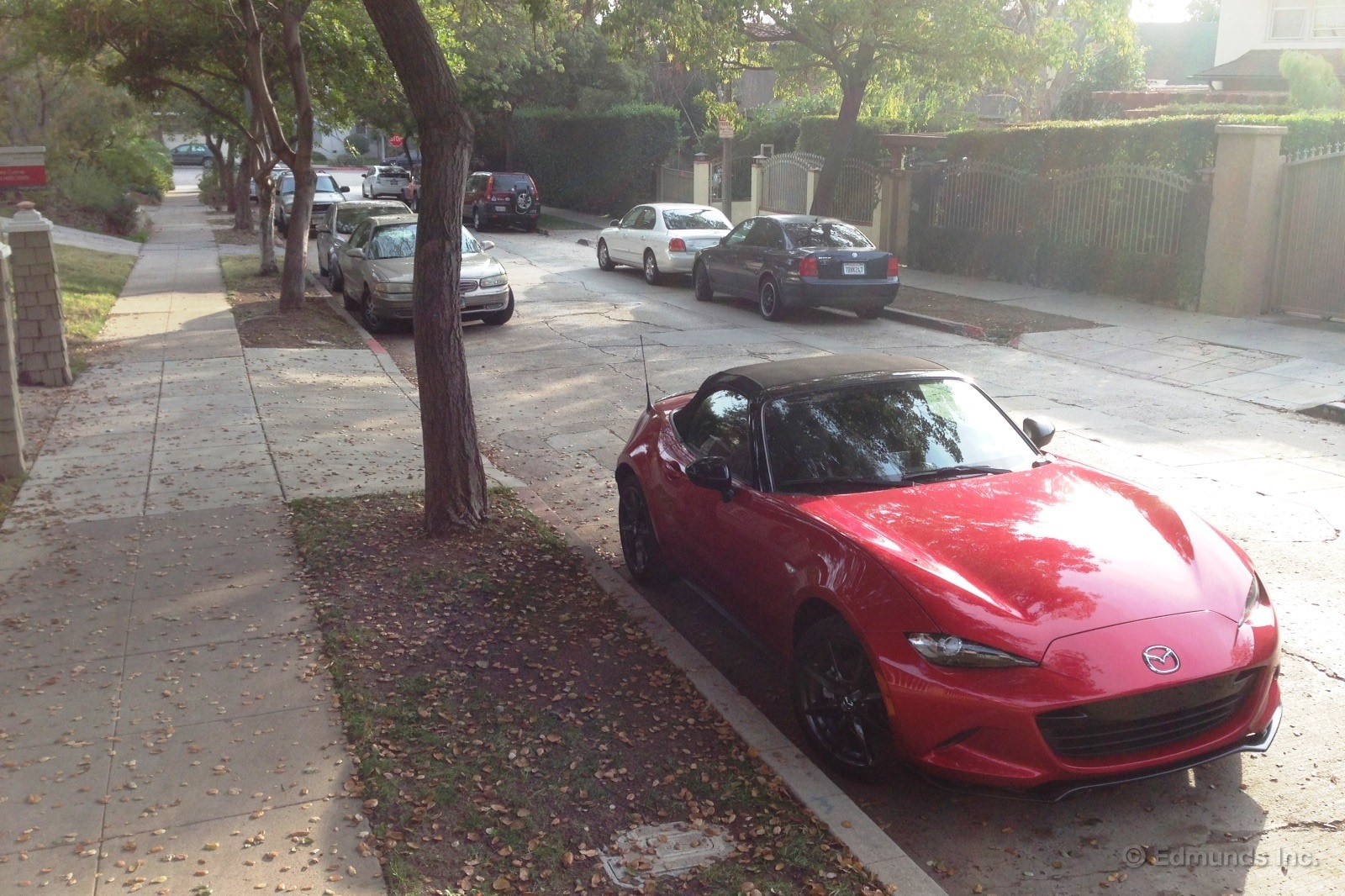
Well, duh. There's nothing illuminating about saying that our long-term 2016 Mazda MX-5 Miata is lightweight. But in the context of today's cars, it's staggeringly lightweight.
Consider that at 2,350 pounds, the new model weighs the same as a 1994 Miata. This despite the modern car's vastly stiffer chassis, superior noise isolation, significantly increased performance, a far longer features list, and crashworthiness that's lightyears beyond the old car.
But even that comparison doesn't really do the situation justice. For that we need to turn outward. To Italy.
The next-lightest car on the market today is the Alfa Romeo 4C. With the benefit of a carbon fiber tub, a more mass-efficient transverse midship layout and a coupe body style, the 4C undercuts the Miata by, well, that's just it — the 4C doesn't undercut the Miata. It weighs in more than 100 pounds heavier than the Miata.
And starting at $54,000, the 4C costs more than double what the Miata costs.
The steel-chassis-havin', propshaft-totin', convertible roof-saddled, mass-produced Miata out-featherweights the 4C. How is this possible? It's an intriguing question. For sure, there was a ruthless, relentless focus on mass in every conceivable facet of the Miata's development. Millimeters drew blood. It's why it has LED headlights, nylon springs in the seats, four-lug wheels and so on.
But Alfa/Fiat engineers surely shared a similar weight-obsessive mindset. Maybe the situation is more nuanced than that.
It's possible that the Alfa enjoys a much stiffer chassis, with the attendant mass that that entails. The Alfa also has to cope with the loads induced by its higher power output and higher cornering grip, and that will directionally result in a more massive platform. And perhaps there are differing corporate philosophies on how much margin is permissible in key mass-related areas of the cars' constructions.
So assuming the Miata's platform is comprehensively pared-down to live through its various qualification tests and nothing more, this poses an interesting challenge for future variants of the Miata. Some of these will need to manage more dead weight (power retractable hard top) and some of which will inevitably ratchet the performance capability upwards. In the former case, mass will beget structural mass, and in the latter case, the additional load-management will do the same.
Whatever the case, today's Miata is a brilliant example of automotive shrewdness, as Mazda brings the joys of light weight to the masses (nyuk nyuk). Imagine what they could do with a carbon fiber chassis.
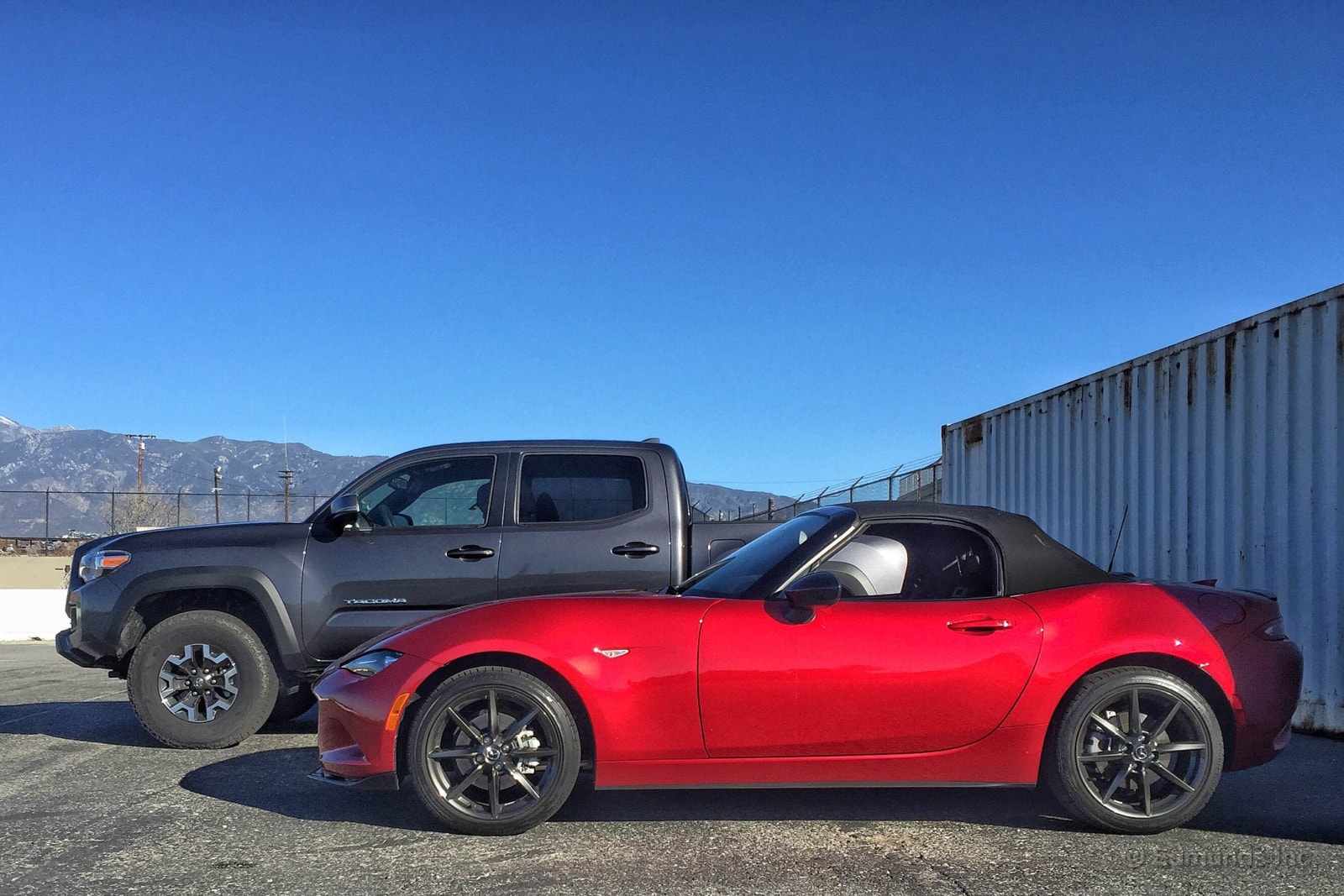
We've had our long-term 2016 Mazda MX-5 Miata a little while now. It was time to see how it would perform at our track. We took our Miata to the track to have some unrestricted fun and gather the numbers.
We know that the Miata is about more than just pure speed. It's never going to outpace our Viper or Mustang around a circuit. Read on to see how it compares.
Vehicle: 2016 Mazda MX-5 Miata
Odometer: 4423
Date: 1/26/2016
Driver: Carlos Lago
Price: $29,850
Specifications:
Drive Type: Rear-wheel drive
Transmission Type: Six-speed manual
Engine Type: Naturally-aspirated inline-four cylinder
Displacement (cc/cu-in): 1998 cc/ 121.9 cu-in.
Redline (rpm): 6900
Horsepower (hp @ rpm): 155 @ 6,000
Torque (lb-ft @ rpm): 148 @ 4,600
Brake Type (front): One-piece ventilated discs with single-piston sliding calipers
Brake Type (rear): One-piece solid discs with single-piston sliding calipers
Suspension Type (front): Double wishbone with Bilstein shocks
Suspension Type (rear): Multilink with Bilstein shocks
Tire Size (front): 205/45R17 84W
Tire Size (rear): 205/45R17 84W
Tire Brand: Bridgestone
Tire Model: Potenza S001
Tire Type: Asymmetrical summer
Test Results
Acceleration:
0-30 (sec): 2.2 (w/TC on 2.6)
0-45 (sec): 3.9 (w/TC on 4.4)
0-60 (sec): 6.3 (w/TC on 6.8)
0-60 with 1-ft Rollout (sec): 6.1 (w/TC on 6.4)
0-75 (sec): 9.3 (w/TC on 9.9)
1/4-Mile (sec @ mph): 14.59 @ 93.6 (w/TC on 14.89 @ 92.9)
Braking:
30-0 (ft): 27
60-0 (ft): 108
Handling:
Skid Pad Lateral acceleration (g): 0.90 (0.90 w/ESC on)
RPM @ 70: 2900
Comments
Acceleration: Traction/stability control makes modest intervention on key-up acceleration runs. It permits some tire spin and flashes a warning light after launch and through one-two and two-three gear changes. Turning off electronic aids allowed more aggressive clutch use, which returned better acceleration. The fastest run was achieved with ESC/TCS off and a clutch release at around 3,600 rpm. This helped cut half a second off the 0-60 mph time and 0.3-second from the quarter mile pass.
The tires chatter through first, which helps keep the engine close to its power peak, and gain traction right before the shift to second gear. From the gas pedal to the clutch and the shifter, each input you make is met with linear and enthusiastic responses. This makes the handoff of a shift extremely enjoyable, as you can hear and feel the effects as the car accelerates. This is a wonderful car to drive quickly, even in a straight line, due to its lovely shifter and happy engine.
Braking: A low mass with sticky summer tires results in short stopping distances. The first stop was the best, at 108 feet. Stopping distances extended with each run, but only to a maximum of five feet. Pedal feel degraded slightly, but the braking system did not produce odor. You can hear the ABS groan, but stops feel stable and do not require steering correction. Like everything else with the Miata, there's a bit more feedback with braking. You hear more of the car working and you feel some light shuddering and a greater sensation of g-forces. But this reinforces the Miata's mission of being all about the act of driving.
Handling
Skidpad: Stability control is well-behaved during the steady-state cornering that happens on a skidpad. Once the Miata gets settled into turn, you primarily control its attitude with the throttle. The chassis tends to understeer, but throttle release and application help induce rotation. Even with ESC on, the Miata permits enough tire slip to adjust your line, but seldom needs countersteer. Turning ESC off simply requires tapping a button; no holding and counting required. The tendency to push remains, but now you can make more aggressive throttle adjustments which can create increasing levels of slide. Get it right and you can neutralize the handling balance, but only briefly.
The lack of power makes slides, even small, difficult to hold. You have a small window to work with and can't simply power out of your problems. I found more body roll than I'd like for a performance-variant Miata like our Club edition. The roll is fine on the street, helpful even, but can be frustrating during limit handling. The roll oscillates in a way that feels exaggerated and can make the mass of the car fall out of sync with your intentions. This might also be why the Miata imparts a sense of vagueness at its limits. That said, the Miata is still a hoot when you aren't trying to set lap times. The steering feels direct and the response from the engine and chassis are predictable — Carlos Lago
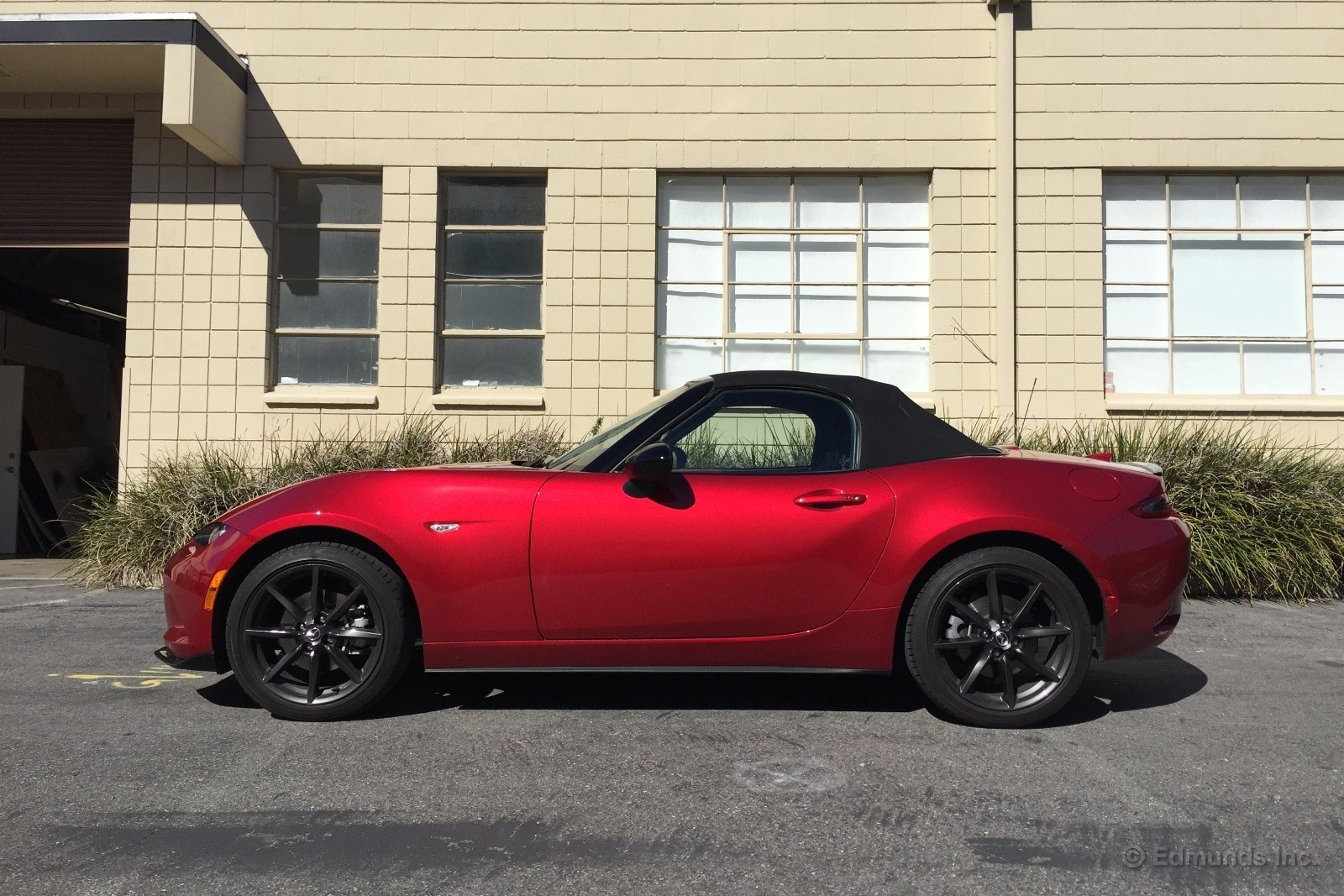
Let me begin by noting that our long-term 2016 Mazda MX-5 Miata pleasantly surprises me every time I drive it. See, I've never been a Miata guy, for one simple reason: apart from the short-lived Mazdaspeed Miata, the thing has never had a motor. And I can't abide any sporting car that doesn't have a motor.
But the new "ND" Miata's 2.0-liter inline-4 has decent poke for what it is. You don't even need to get the revs up. Just step on it at, say, 3,500 rpm and off you go. It scoots. Color my expectations exceeded.
Having said that, I just couldn't consider a new Miata myself when minty-fresh Honda S2000s are still out there for thousands less.
I say "still" because I think the collectability is strong with this one. The prices on low-mileage cherries aren't going much lower before they start climbing, and I'd argue that's due in large part to the fact that Honda went nuts with the engines, which never appeared in any other model.
The 2.0-liter, 240-hp "AP1" four-cylinder revved to 9,000 rpm and would've come in third on this 2012 list of highest-specific-output naturally aspirated engines, splitting the difference between the Lexus LF-A (115 hp per liter) and the Porsche 911 GT3 RS 4.0 and Ferrari 458 Italia (125 hp/L). It also happens to sound fantastic. Although the 2.2-liter "AP2" shed a thousand revs and dropped to just under 108 hp/L (it would have missed making that list by a hair), it picked up a little midrange pep in the process. It too sounds fantastic.
Don't do this, by the way:
Every S2000, in other words, has a seriously special motor. And unlike the ND Miata's mill, which doesn't reward you for taking it to redline, the whole point in the Honda is to blast through VTEC whenever conditions permit. That's how it should be in an elemental sports car. Remarkably, and I would strongly suggest for a limited time only, any enthusiast on an $18,000-$24,000 budget can get the keys to a gently used example with fewer than 45,000 miles.
The 2016 Miata, if you're scoring at home, starts at $24,915. Destination not included.
Now, as for the other features of these cars, reasonable roadster fans can disagree. I prefer the S2000's styling, inside and out, but that's meaningless to you if you like the Mazda. I don't like TV screens in my cars, and the 2016 Miata comes standard with one from the Club trim on up, and I would want at least the Club because it adds the sport suspension and a limited-slip differential (every S2000 had an LSD). But maybe you like TVs.
I could go on. You get the gist. I sincerely salute Mazda, the little company that could, for continuing to make the Miata. There's no other new car like it. But as long as the S2000 market stays roughly where it is, methinks there's a better four-cylinder Japanese roadster for the money. Tell me why I'm wrong.
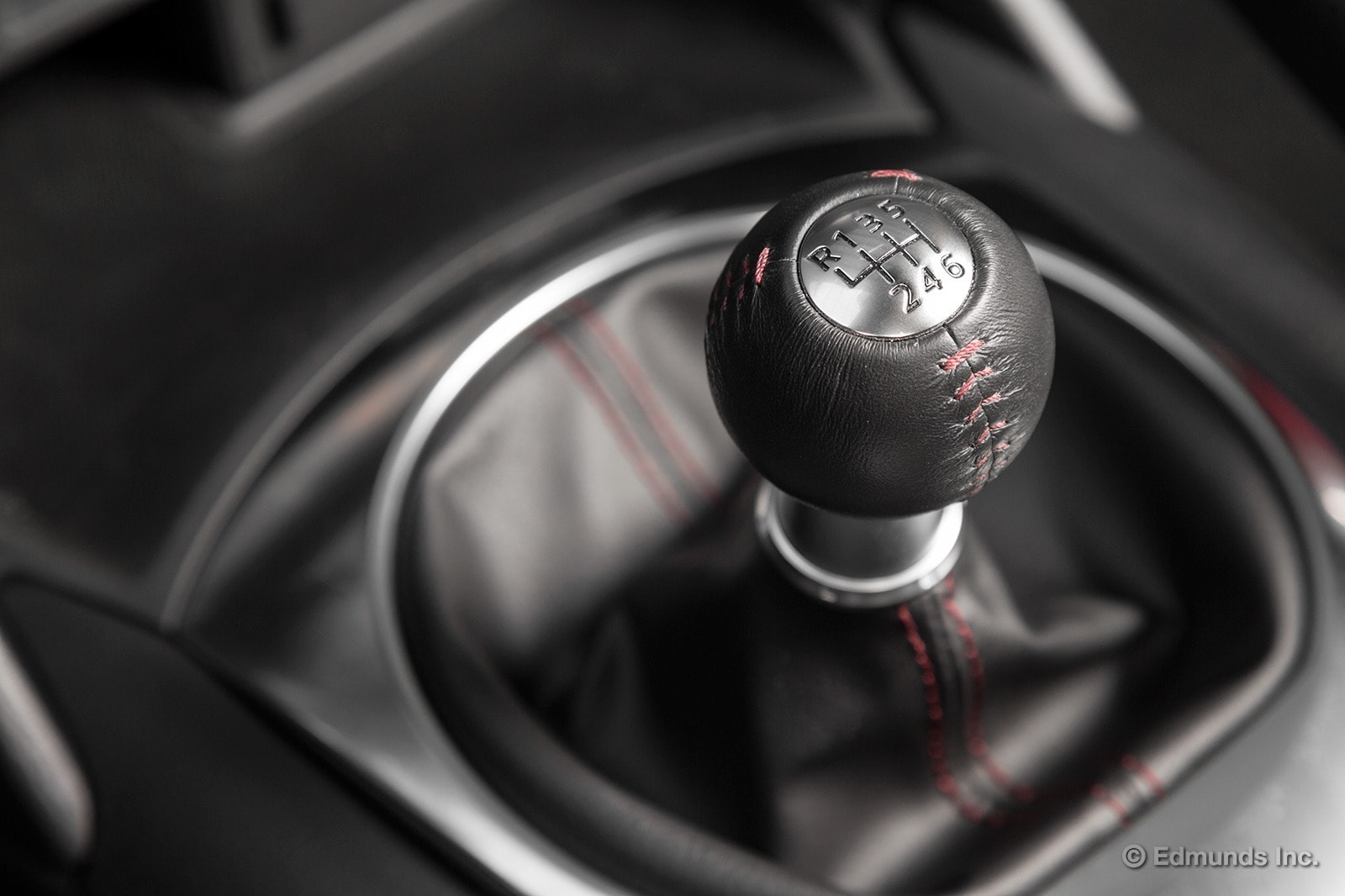
Simply put, our long-term 2016 Mazda MX-5 Miata's shifter is a model of how to do it right. Also, our long-term 2015 Dodge Viper's shifter is a model of how to do it right.
You wouldn't want the shifter from either car in the other one.
Confused yet?
The Miata's shifter moves through its gates with low effort but not low satisfaction. It glides unusually smoothly through the pattern. Each gate is well-defined and there's no notchiness. But you can feel the little rises and troughs of effort as one cog is deselected and the next one taken up. It's a subtle reminder that you're piloting a machine and helps make it one of the best shifters in any car today. It might even help a neophyte improve their game.
Similarly, the Viper's shifter is satisfying to use. It finds its gates with no excuses and feels immensely solid, slamming home with authority. You'll never miss a shift, and if you get lost in this H-pattern, it's no fault of the shifter. I love using this shifter even in casual driving.
The character of these shifters is poles apart in actual use, and the Miata's friendly, slickly low-effort shifter would be totally out of place in the brutish Viper, and vice-versa.
As an aside, one reason why the gearchanges in the both the Miata and Viper are so rewarding is because they're both directly integrated into the extension housings of their respective gearbox. Appropriately, they're known as "direct-shift" transmissions.
By contrast, so-called remote shifters guide the shift forks in the gearbox via an external linkage of some sort. The linkage of a remote shifter has pivots and rods/arms (or cables) and bushings that isolate the shifter from noise and vibration. But in the bargain, remote shifters lose precision and generally are more vague and slower to shift than direct-shift 'boxes.
You can feel the difference yourself. A modern Camaro SS, the LSA-powered Cadillac CTS-V and Mustang GT500 all employ the same fundamental Tremec TR6060 gearbox as the Viper, but the Viper is the only one among them to use a direct shifter. And while none of those cars' remote shifters could fairly be described as clumsy, nor do any of them approach the gearchange quality of the Viper.
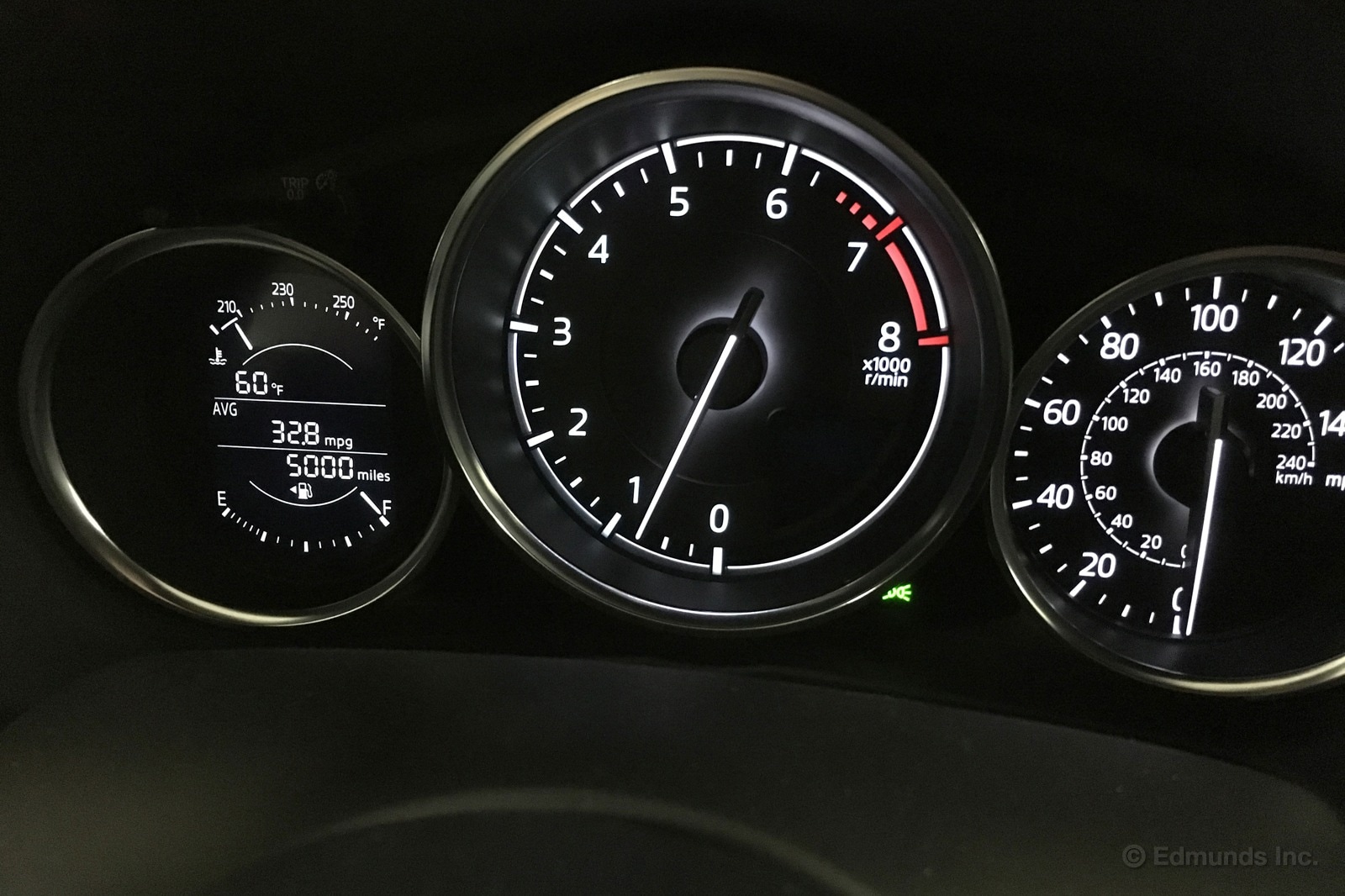
We needed fewer than four months with our long-term 2016 Mazda MX-5 Miata to reach the 5,000-milestone. Take the jump for the best of the first 5,000 miles as voted on by me.
Best quote:
"As for my colleague catching his sleeve on the multimedia knob when going for a gearchange, I can only assume his shirts have droopy, flouncy wizard-sleeves." – Jason Kavanagh
Best photo:
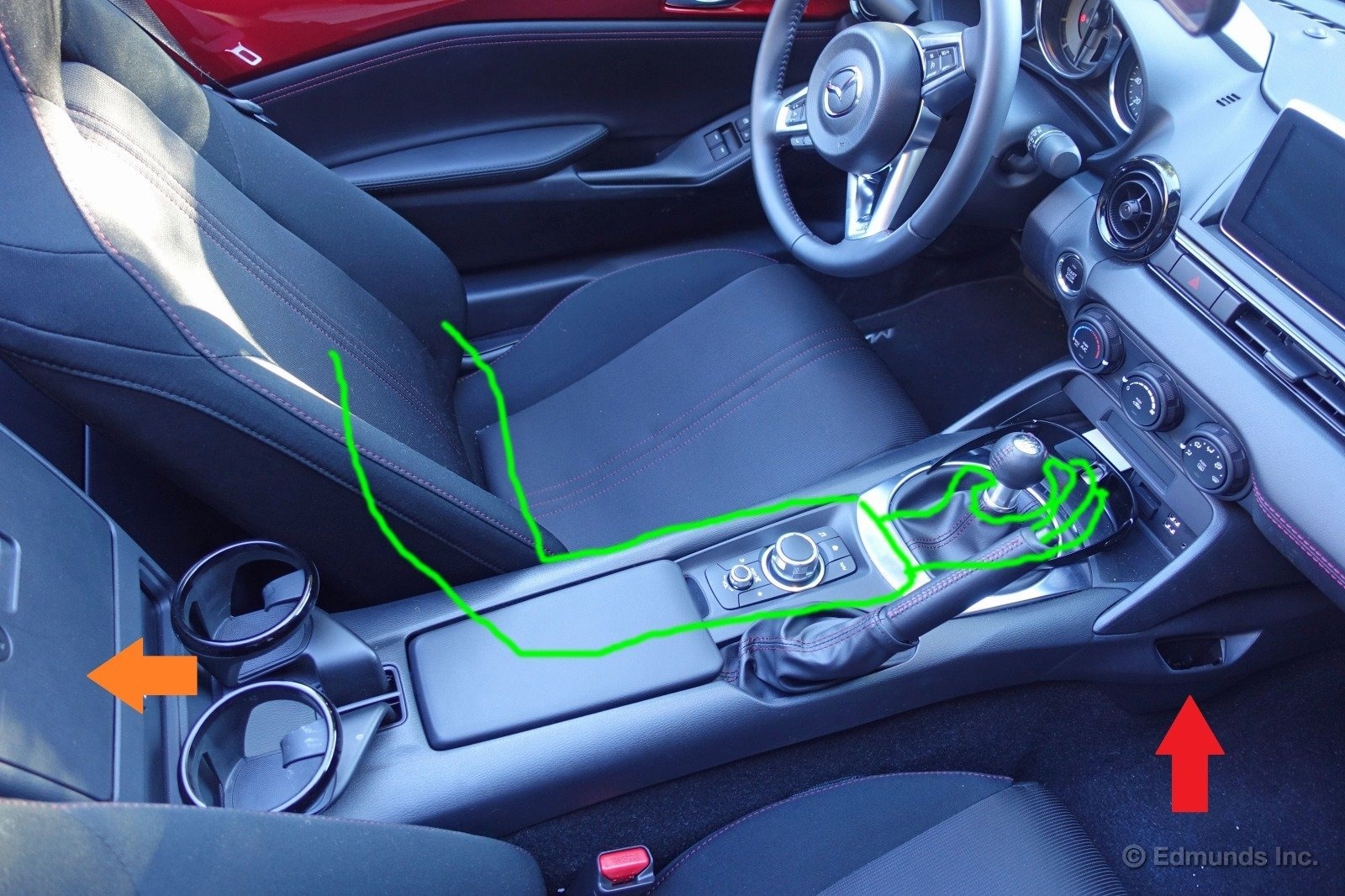
Photo by Ron Montoya
Best story:
Easy Driver, Great Teacher - Jonathan Elfalan
Most Comments:
All the Gauges You Need - Ed Hellwig
Did I overlook your favorite? It's too late for this election. The polls are closed for another 5,000 miles. Until then, keep your donations coming.
Fuel Economy Update for January - 30 MPG
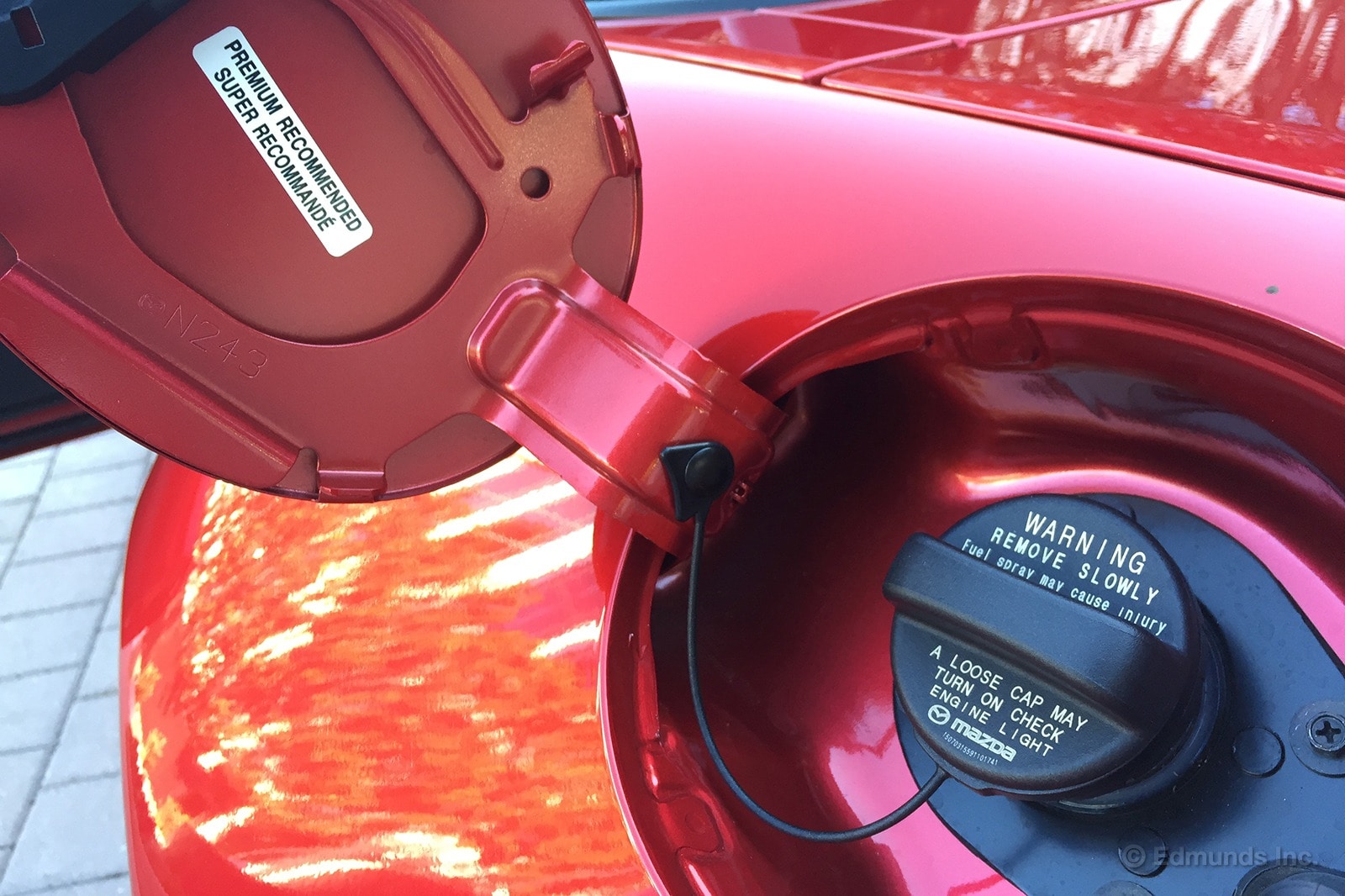
The EPA says the 2016 Mazda MX-5 Miata should get 30 mpg combined. That's wildly impressive for a performance-oriented car, even one as dainty and modestly powered as the Miata.
And yet, in January, our long-termer improved by one full mpg to cross the 30 mpg barrier. We're now averaging 30.6 mpg and it's not like we're not having any fun, either.
Worst Fill MPG: 22.2
Best Fill MPG: 35.7
Average Lifetime MPG: 30.6
EPA MPG Rating: 30 Combined (27 City/34 Highway)
Best Range: 321.5 miles
Current Odometer: 5,700
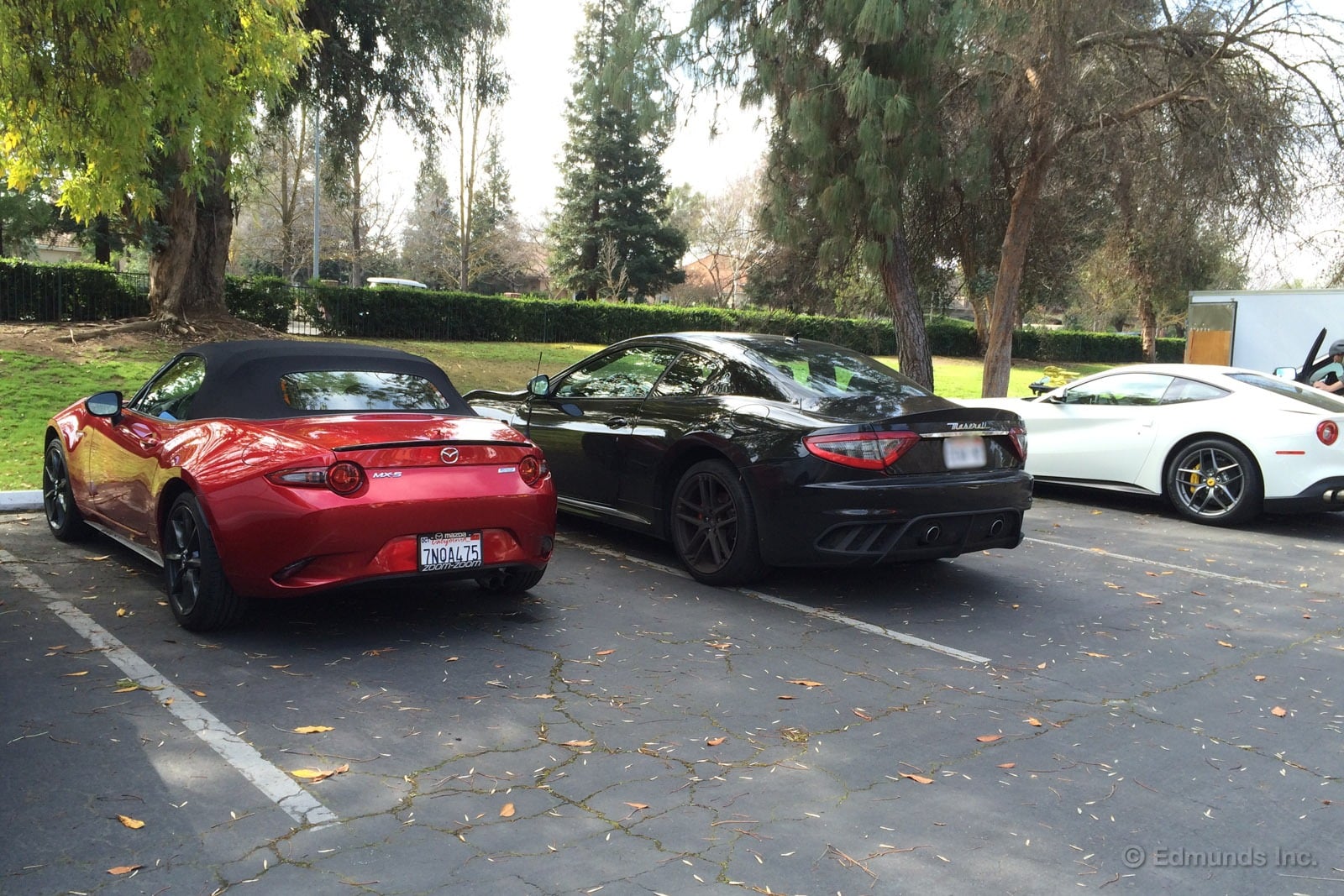
The 2016 Mazda MX-5 Miata is a humbly priced car. It starts at around $25,000. Our modestly-equipped version checked in at around $30,000. Yet I believe the new generation's styling allows it to hang with much more expensive sports car crowd.
At the valet line or the country club, it's a car I'd be proud to park.
I really like what Mazda did with the new Miata's look. Of the four Miata generations, this is by far my favorite. It's sleek, sporty and well-proportioned. It sits low to the ground, with the wheels nicely filling up the wheel arches. And while it doesn't really come across in photos, our car's Soul Red paint looks quite rich and deep in the sun after a wash.
Design-wise, Mazda didn't employ many retro touches. That's fine by me. Interestingly though, there are a few elements that do remind me of luxury-branded roadsters. The Miata's fenders, particularly the upswept rear, and curves are similar to those of the original BMW Z3. The closely set twin-tip exhaust outlets also remind me of BMW. Also in back are the Miata's new spear-tip taillights, which remind me of the Jaguar F-Type.

For a lot of people, I bet you could take the badges off the new Miata and easily pass it off as something from Europe. But all the same, it's just as enjoyable to say you've got the new Mazda Miata.
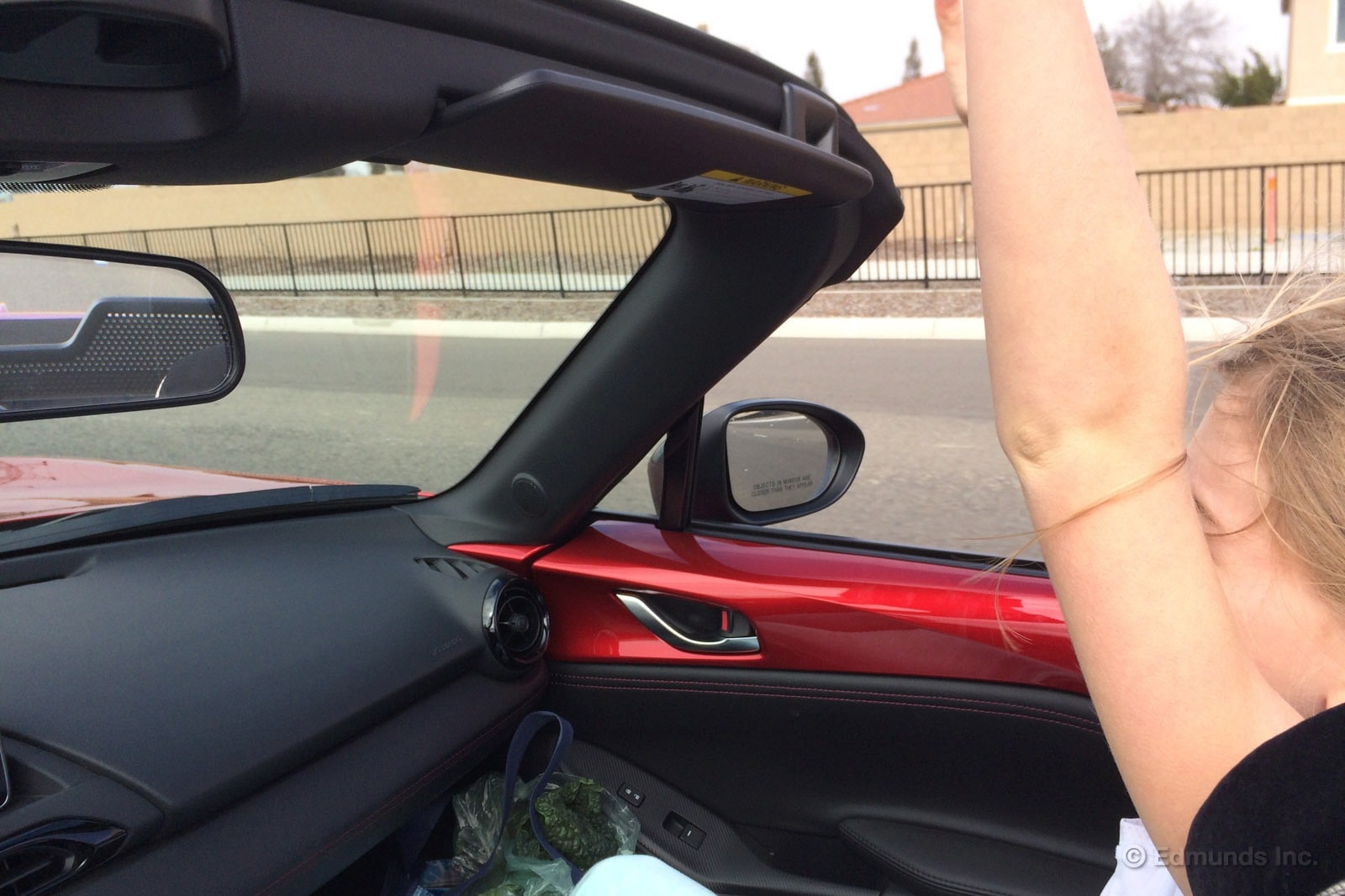
We've got some very versatile vehicles in our fleet right now: Honda Pilot, Kia Sedona, Toyota Tacoma. For helping me through my daily life, they're excellent.
Then there's the Edmunds' long-term 2016 Mazda MX-5 Miata. It seats two, is loud on the freeway, has a dinky trunk, and cupholders in rather inconvenient places. Not very versatile, this one.
But for creating emotions, it's hard to beat the Miata.
In congested traffic, you might feel a little exposed as a big SUV or lifted HD pickup rumbles by. The Miata is diminutive even by roadster standards. But you're also in more control driving a Miata than in other cars. It responds so quickly and faithfully to how you steer, brake and accelerate that you can be more precise about where you are on the road and in relation to other cars. A minivan can make you feel safe should you get in an accident. A Miata helps you feel safe by knowing you can avoid one in the first place.
Convertibles are also just great fun. I recently took my eight-year-old daughter with me on a grocery run in the Miata. The day was near-perfect for it: partly sunny and low 70s. For the way home, I lowered the top. My daughter was putting her hands above the windshield, sticking her head out the side and generally having a grand time.
After a while of this, she looked over at me. The air was swirling her hair and she had a wide, happy grin on her face. As a dad, it was a memorable moment.
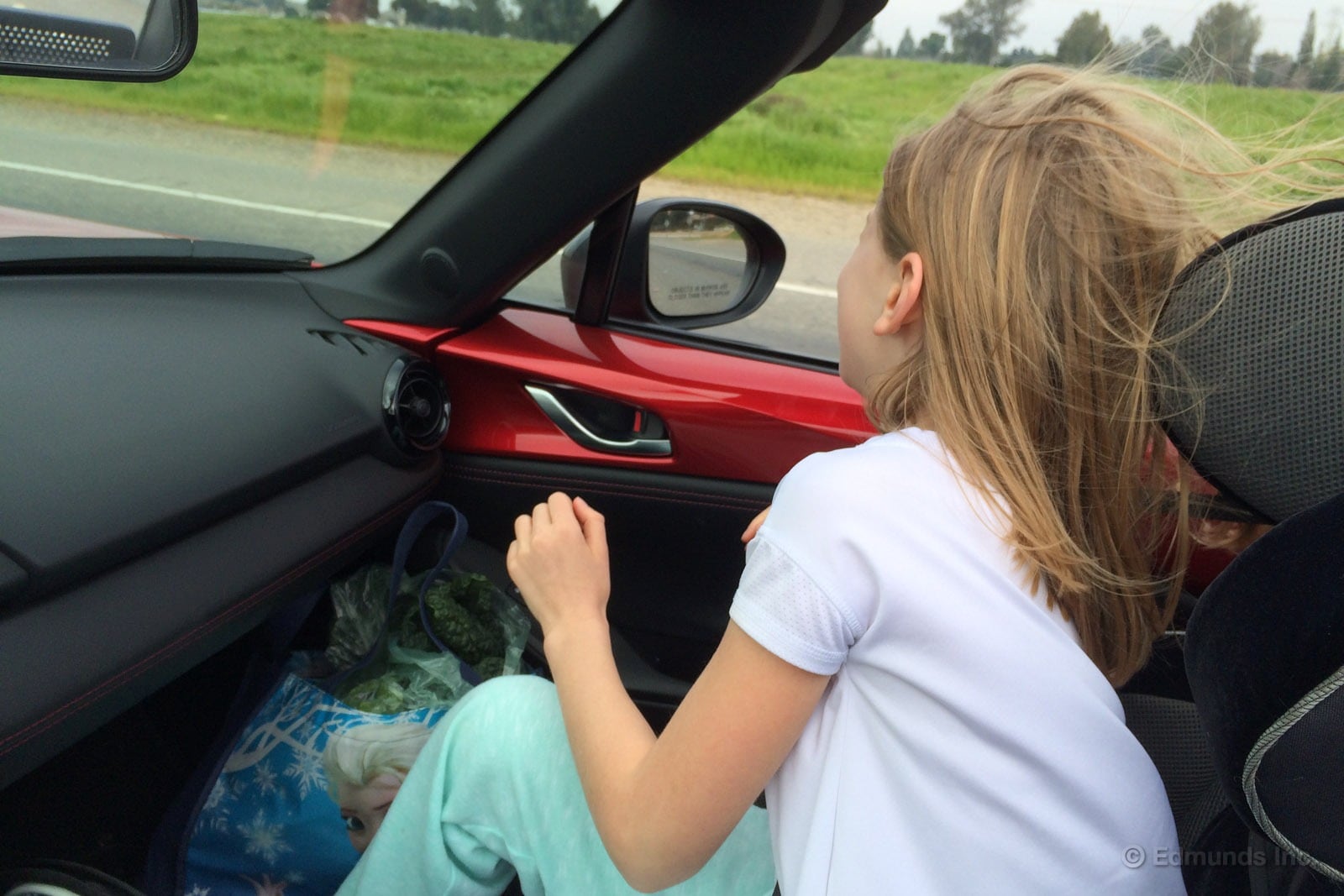
It also reminded me how children so easily enjoy the little things in life. Driving a 2016 Miata is a great way to bring out your inner kid.
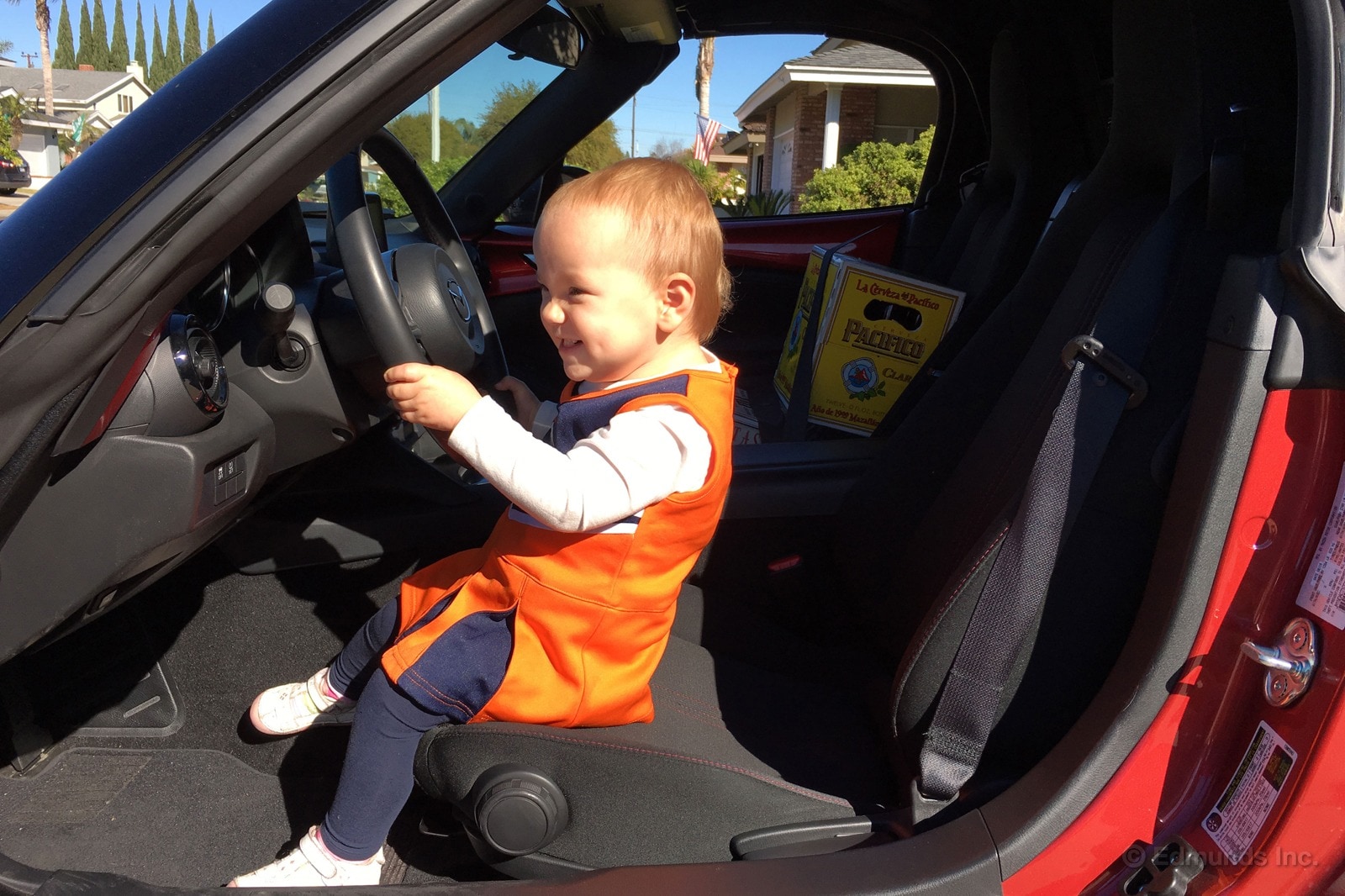
This picture of our 2016 Mazda MX-5 Miata speaks for itself. What does it say to you?
You write the caption.
The author of the best entry will receive accolades from the entire internet.
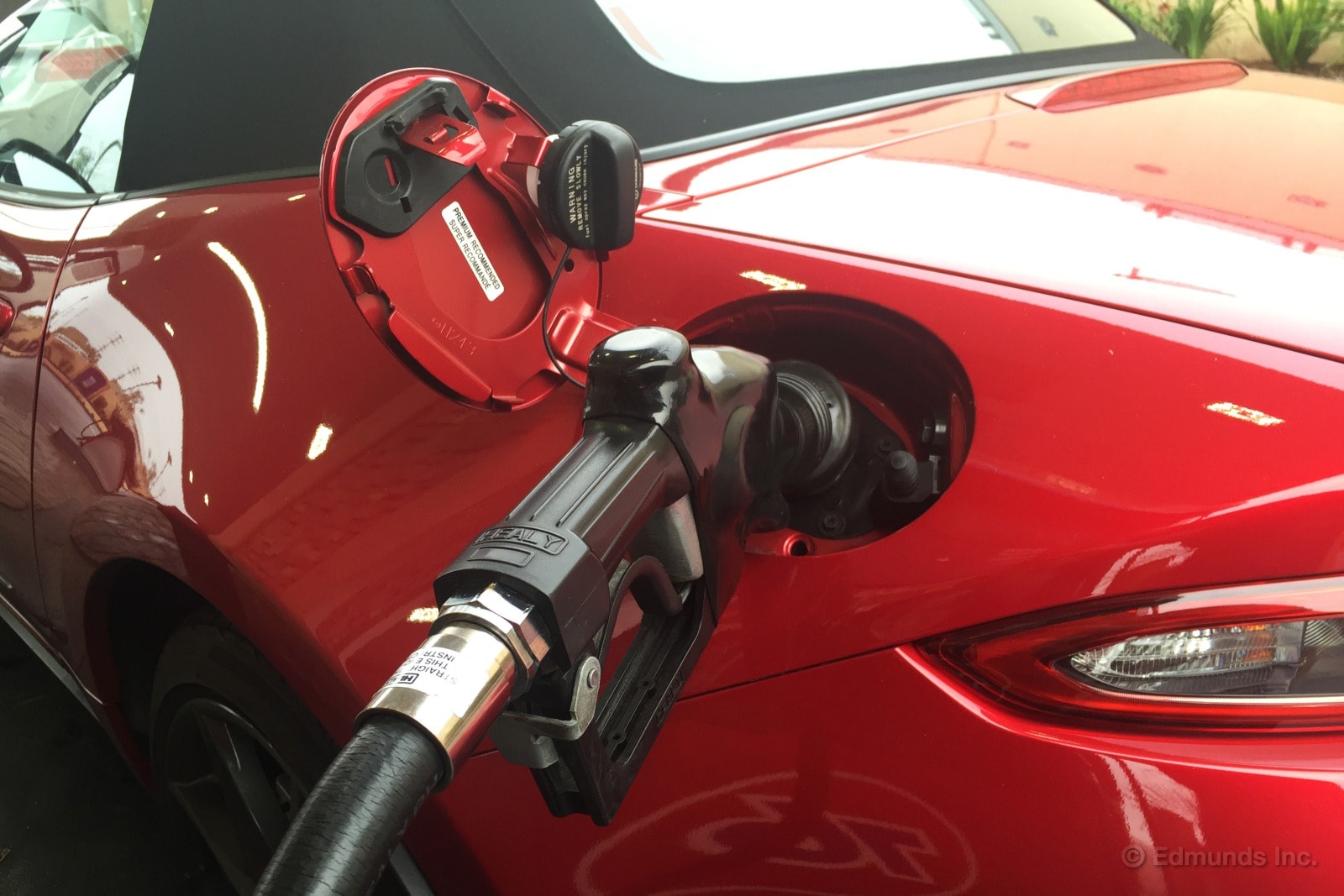
Despite its diminutive size and coming up low on the practicality scale, our long-term 2016 Mazda MX-5 Miata remains very popular in the fleet.
The Miata achieved its best average tank in February. Brent averaged 36.5 MPG over 142 miles, up from a previous best of 35.7 set by yours truly. Despite this high mark, our lifetime average dipped from January. We'll attribute this to plenty of city driving in February.
Worst Fill MPG: 22.2
Best Fill MPG: 36.5
Average Lifetime MPG: 29.7
EPA MPG Rating: 30 Combined (27 city/34 highway)
Best Range: 321.5 miles
Current Odometer: 6,014 miles
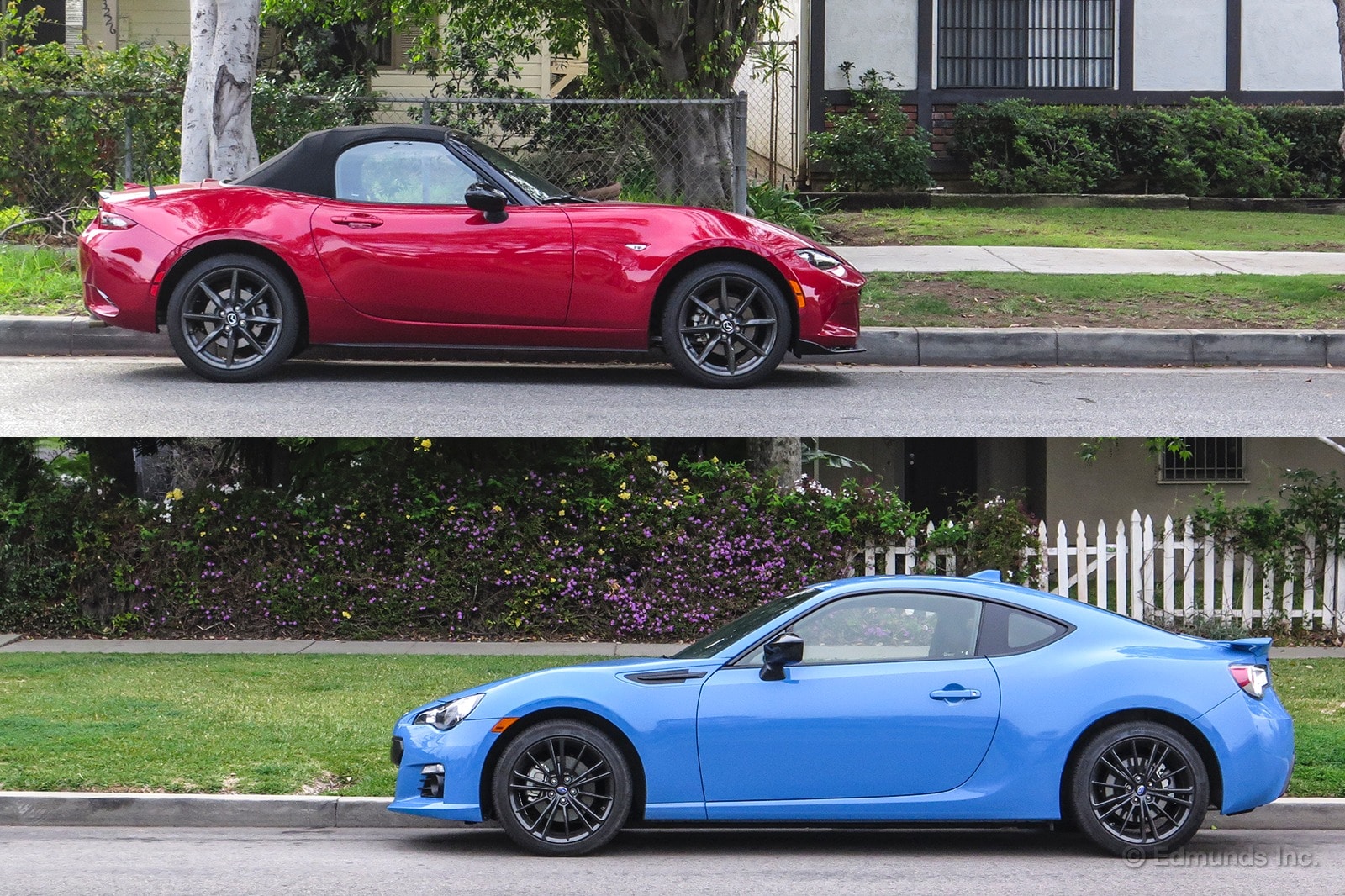
My abiding memory of our long-term Scion FR-S is one of fun. It was comfortable, had excellent balance and some of my favorite seats ever. On top of that, we added the whiny supercharger, the Volk TE-37 wheels, and the super-gripy Advan AD08 tires, all of which made it even more enjoyable. I haven't driven an FR-S (or it's Subaru twin brother, the BRZ) since that FR-S left our fleet more than two years ago, but it's certainly a car I'd consider owning and I jump at the chance to drive one whenever it's around.
What does all of this have to do with the long-term 2016 Mazda MX-5 Miata? Glad you asked.
We got a HyperBlue Subaru BRZ in for testing recently and after driving it, I got to wondering which car I'd rather have. Either the BRZ/FR-S or the brand new Mazda Miata. Both are rear-wheel drive, both have six-speed manuals and both start around $26,000.
But they have some key differences. So I took them home on back-to-back nights to consider the details.
Right away, the BRZ felt heavy compared to the Miata, slow even. This wasn't how I remembered the Scion twin, but that car was supercharged when I last drove it. When I consulted the numbers though, the Miata came out on top by a slim margin. It did zero to 60 mph in 6.3 seconds at our test track while the BRZ took 6.6 seconds. The Miata passed the quarter-mile in 14.59 seconds at 93.6 mph and the BRZ did it in 14.94 @ 92.7 mph. Nearly a toss-up.
Neither of these cars are really about pure straight-line speed, though. They both offer a unique driving experience and that's kinda the point. Before I got to which car I loved more, however, I had to consider which one I could live with.
Practically speaking, the BRZ is the winner. It has a bigger trunk, decent cupholders, legitimate lateral space in the cabin and a usable backseat. It's also more comfortable, with a much more forgiving suspension and a way better driving position.
The Miata does have something to make up for it, though: a folding top that goes down in 1.3 seconds (that's a personal record). The Miata is significantly louder, but it makes you feel better.
Ah, the real-world ,fun-time driving. That's where both of these cars really shine. Both are entertaining on a winding canyon road, but the BRZ takes more effort. The Miata is more of a fun, lighthearted, smile-inducing experience. With the BRZ, I can concentrate hard to squeeze a better performance out of it, but I wouldn't be having as much fun.
I played out a hundred scenarios in my mind as to which car I'd rather have and I still couldn't make up my mind. If I could modify it (supercharger, wheels, tries, exhaust, 1-2 inch drop) I'd go with the BRZ. On a road trip, I'd go with the BRZ. If I spent my time commuting in traffic or darting around on the weekends on local b-roads, it'd be the Miata. Do I live close to a beach of any kind? Miata.
Flip-flopping back and forth all week, I still haven't made up my mind. Maybe that's a testament to how good both of these cars are. They do similar things, in different ways, and they both do them really well.
Which would you choose?
Bringing a Little Color to Death Valley
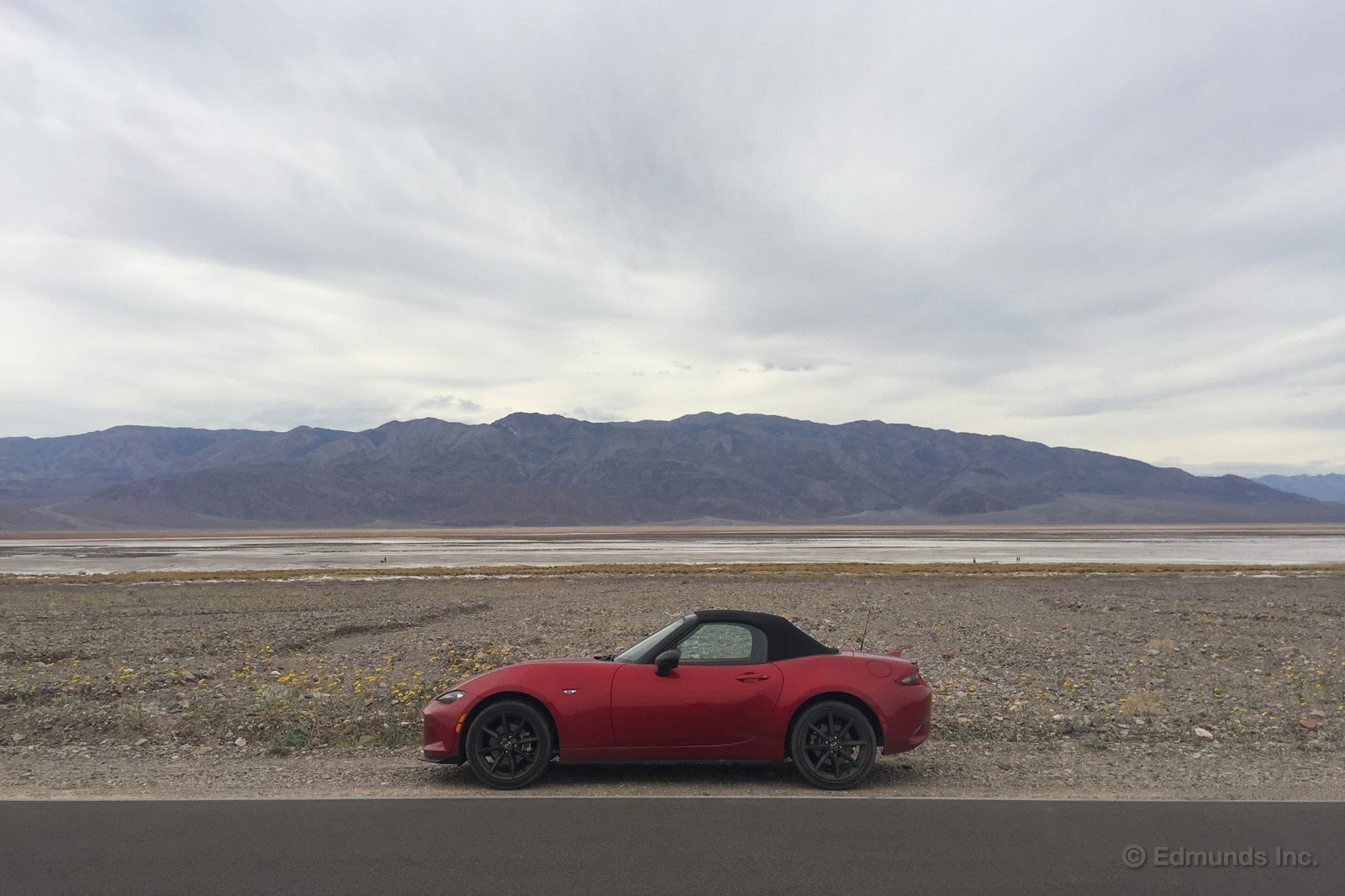
I'm still new to California, so it's hard to justify staying home on the weekend when there's so much to see. It's even more difficult when you have a fleet of cars at your disposal and an obligation to tack on as many miles as possible.
This rationale led me to Death Valley in our 2016 Mazda MX-5 Miata.
Friday afternoons tend to be slow around the office. Most people work from home on Friday and the few that do show up usually question that decision by the time lunch rolls around. Afternoons devolve into watching car videos on YouTube and debating the merits of the Miata vs. the BRZ.
During one of these discussions, Kurt and Magrath told me about the super bloom going on in Death Valley National Park. Magrath threatened to punch me if I didn't go visit this weekend, so I text my wife and let her know we were going on a drive the next morning.
We left our apartment in East L.A. around 7:00 a.m. and headed north on Interstate 5. Our destination was Badwater Basin, the lowest point in North America, and roughly 300 miles from our apartment. In addition to the super bloom, I was eager to see if I could retake the MPG crown from Brent, not that it's a competition or anything. I filled up in Rosamond at the exit that takes you to Willow Springs International Raceway and from there we headed northwest towards the park.
The roads in this part of the state are surprisingly good. Ribbons of black asphalt trace a path that through the desert, occasionally passing by a borax or sulfur mine and the community that supports it (see: Trona, CA). The road, while not overly technical, is smooth and sweeping. The Miata was a joy through here.
This wonderful road came to an abrupt end. Road work had reduced a several mile section to something reminiscent of Mad Max. The dust, kicked up by cars and the sweeping winds, reduced visibility to less than 50 feet. It was hard to tell where the "lanes" were supposed to be, so I just kept my speed down and my eyes ahead. Eventually, we picked up pavement and continued onward.
Soon the elevation increased as the road moves through the mountains that eventually empty out into Death Valley. Some of the passes are nearly 5,000 feet above sea level, but despite being naturally aspirated, the Miata never felt out of breath.
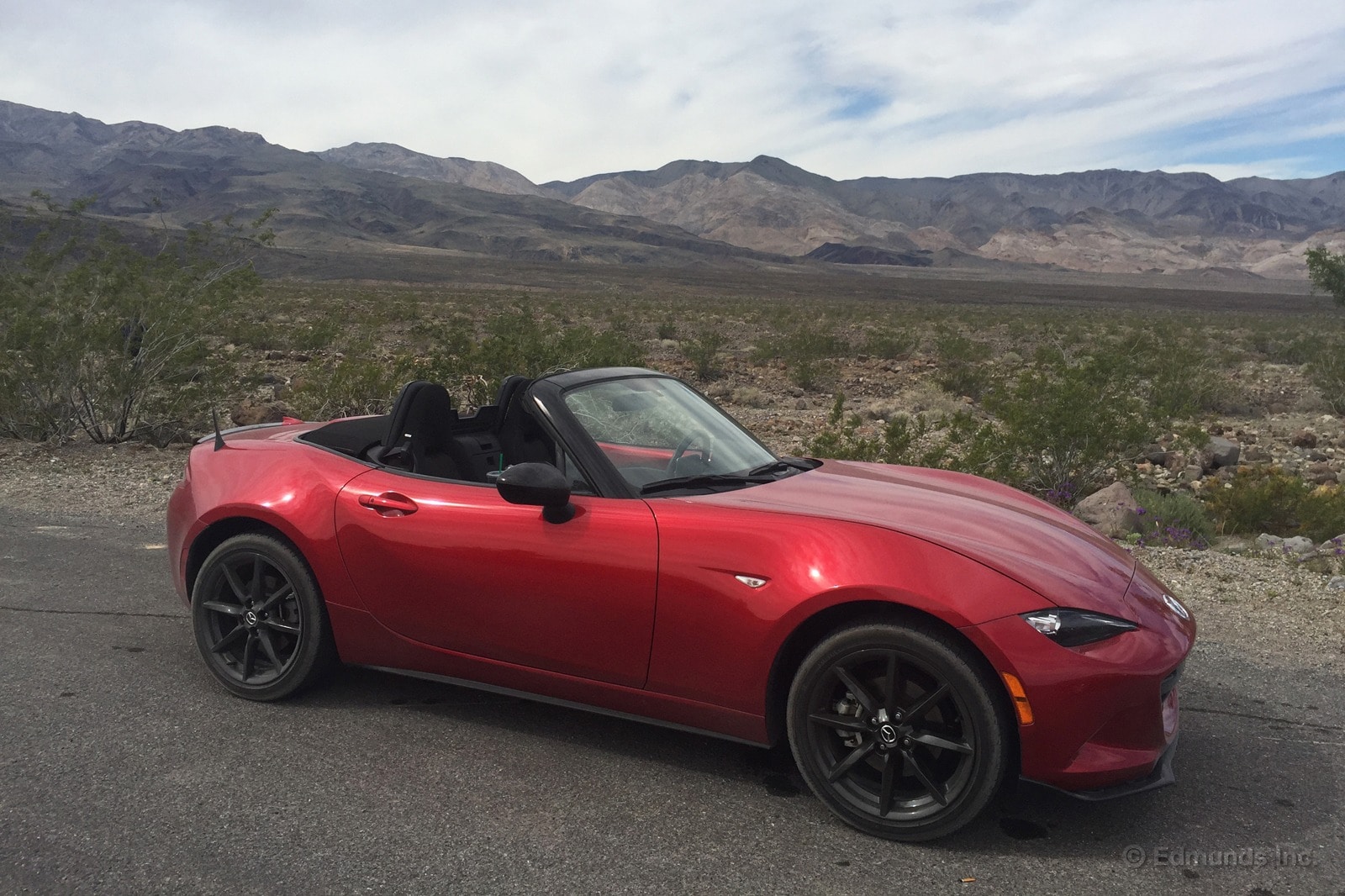
The entrance to the park was fairly green, though we were still at some elevation. We parked so I could pay the $20 entrance fee at the self-service kiosk. At this point, I noticed how badly my ears were ringing. The soft top on the Miata does very little to muffle the sound, and after nearly five hours of driving the noise was starting to get to me. The seats — my least favorite part of the Miata — were starting to wear on me as well.

Most of what we could see from the road looked like the surface of some cracked and broken planet. The overcast sky threatened rain and didn't do much to lighten the scenery. We parked and walked through the fields, picking up interesting-looking rocks and admiring the red Miata against the muted grey and brown background.
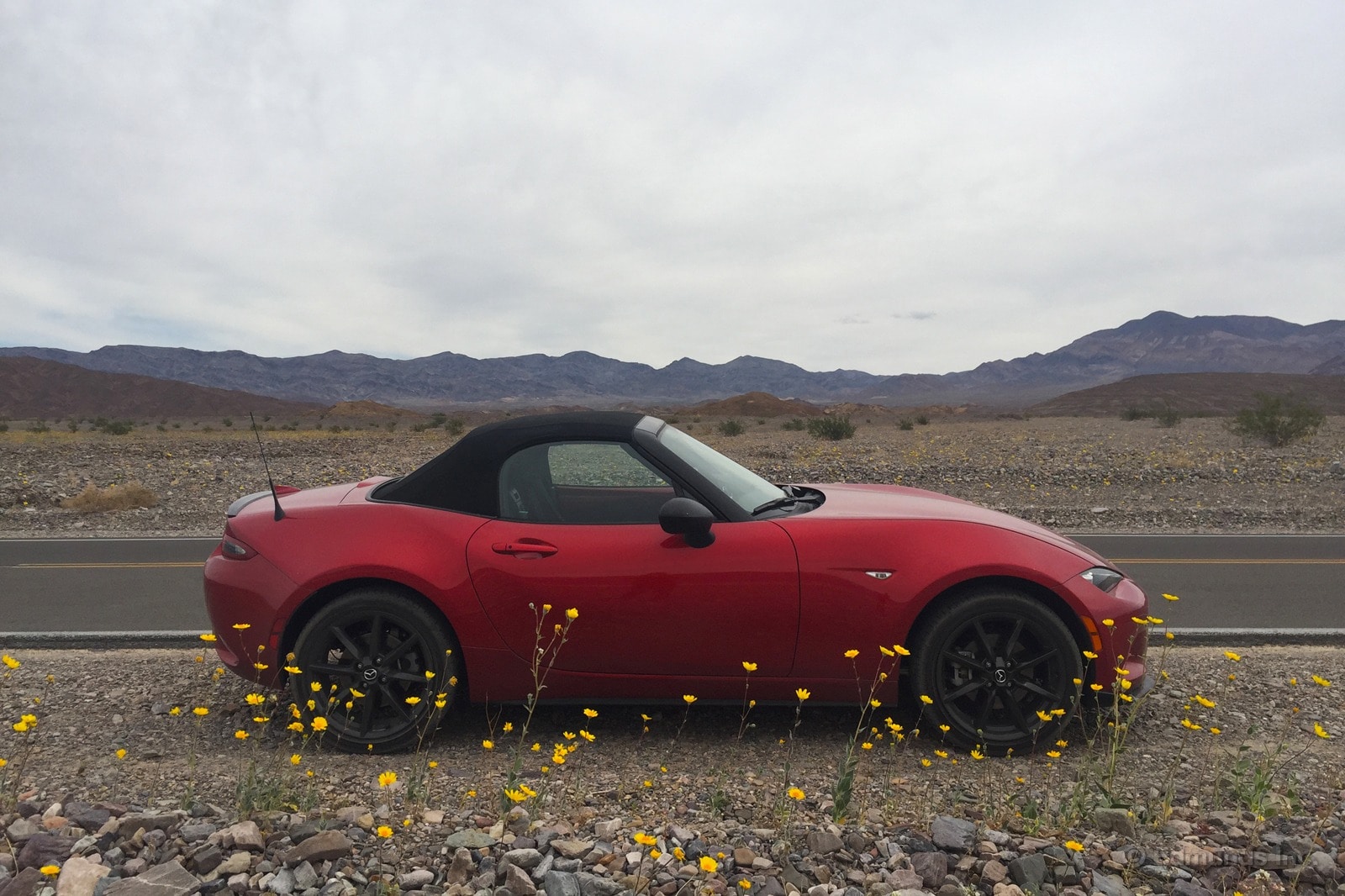
As we continued downward, the occasional yellow flower eventually turned to fields of gold and purple that swept upwards toward the mountains. My iPhone camera couldn't do the scenery justice. It just continued for miles and miles as we swept deeper into the park.
The Miata isn't equipped with navigation, but the compass display also shows elevation. I kept an eye on it as we moved through the park. The numbers continued to fall, eventually dropping below sea level. Badwater Basin sits 282 feet below. The Miata obviously disagrees.

I took the photo above in the parking lot next to the boardwalk that led to Badwater Basin. The number was off by a bit, but it was still interesting watching it rise and fall with every crest and dip in the road. It settled into a slow fall as the road crept down towards the salt flat.
After exploring the salt and the stones at Badwater for a bit, I realized that I still had to make the journey home. We were already six hours into the day and I didn't know how long the return run might take. The Miata had about half-a-tank of fuel with an indicated 180 miles of range. As a man on a mission, I gingerly headed west out of the park and south towards Baker.
In Badwater, the Miata's indicated fuel economy was 40.5 mpg. These monitors tend to be generous, but it gave me a general indication of where I was at. It was all uphill from Badwater, but there were no other 4000-foot passes to cross either. I was set to beat both the best range and best average tank in one go. With my wife asleep in the passenger seat and our dog asleep on the parking brake, I settled in for the return leg of the drive.

Rain fell as we headed out of the park, partially rinsing the Miata of the layer of dust accumulated on Fury Road. The noise from the road, the rain and the wind was near headache inducing. I didn't even bother with the radio.
A couple hours later we rolled into Baker, just off Interstate 15. The Miata burned up 8.785 gallons of 91 octane over 329 miles. The math works out to 37.5 mpg, beating our previous best by 1 mpg.
We arrived home just after 7:00 p.m., 12 hours after departure. All the noise from the car had my ears ringing for days. As much fun as the Miata is to drive, it's pretty miserable on a long journey.
The journey was worth it, though. We saw bright flowers and a red roadster in one of the bleakest places on Earth. Badwater was 85 degrees in March. Magrath told me I need to go back in August to feel that triple-digit dry heat. I'll bring some eggs to cook on the pavement. Next time I'll take something with a fixed roof and double-pane windows.
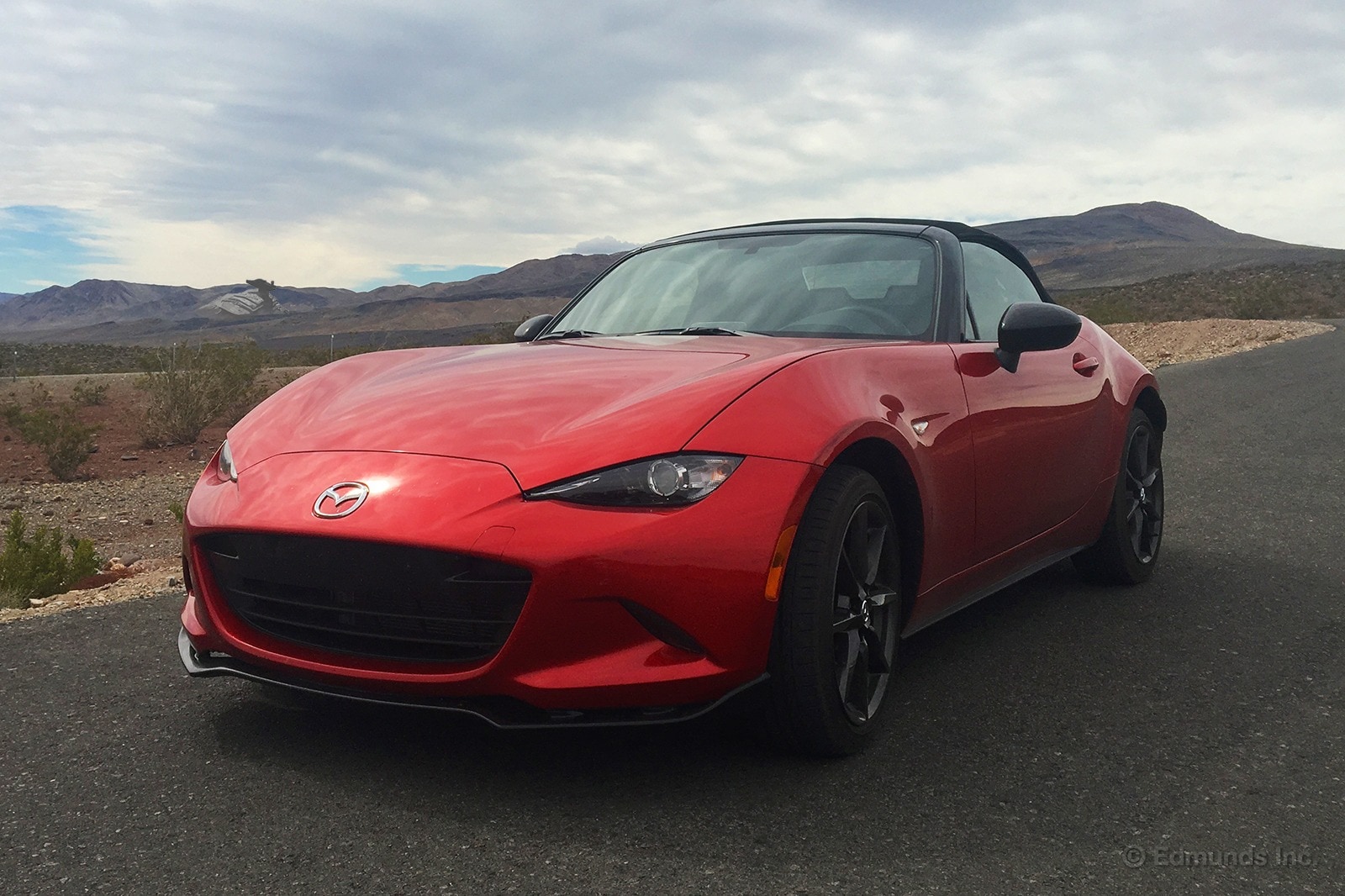
Whenever we need to attend an industry event and it's not ridiculously far away, we take one of our long-termers to rack up some miles. For my trip out to Pahrump, Nevada, I was given the choice of our 2016 Mazda MX-5 Miata or the Viper. Neither are really known for long-distance comfort, but I've made longer trips in far less accommodating vehicles without too much whining.
Some of my colleagues have commented on the Miata's seats, but as an average-size male adult, I was just fine with them. The driver seat is a little firm, which prompted me to pull my wallet out of my back pocket, but it's shaped well enough to eliminate most hard points.
Mazda compares the seat construction to a hammock that suspends the occupant with appropriate support where needed. Does it work? Probably.
The main issue for me wasn't seat comfort, it was noise. Newsflash: Miatas are loud inside. Road noise ranged from an ever-present din to an intrusive rush, depending on the road surface. That's what the stereo is for, right?
Speaking of road surfaces, the Miata exhibited some weird behavior on one stretch of highway. This section had longitudinal grooves cut into the pavement that would drift left and right every now and then. When those grooves were not in line with the path of travel and when a bump would appear, the Miata developed a momentary shudder that felt like a wheel was out of balance. No big deal.
None of these drawbacks diminish the Miata's core strength, though. Once I hopped off the highway onto a serpentine road through Death Valley, I didn't care about comfort or quietness. This little roadster is stupid fun and its lack of power meant that I wasn't in danger of getting a career-ending ticket. It's about as responsive as vehicles with more than two wheels get.
I wouldn't think twice about road-tripping in the Miata in the future, as long as there are some fun roads squeezed in there.

On my return trip from Pahrump, Nevada, in our 2016 Mazda MX-5 Miata, I decided to take the fun route rather than the quicker, more boring way. I got a bit more than expected, in both good and bad forms.
Weather was a major factor. An El Niño storm was bearing down on Southern California and the reports all said it would hit us hard by late afternoon. Since I would be traveling through flash flood-prone areas of Death Valley, I got an early start.
The photo above represents the temptation portion of the trip. Look at that straightaway. Isn't it glorious? It can be argued that I chose wisely by picking the Miata over the Viper since I did not win enough on the craps table to bail myself out of jail. Oh the possibilities.
As mentioned in the comfort-related post to this roadtrip, I had a great time in the winding mountain passes in the Eastern Sierras. I stopped briefly at the Father Crowley Vista point hoping that maybe I'd see a fighter jet running the Jedi Transition (Google it, it's rad), but was told that the jets are in maintenance from Friday through Sunday. The wind was also howling up there, which would definitely make me think twice about dipping into that canyon with a $20 million plane.
That wind reappeared on my route as I dropped into the other side of the mountains. The picture below doesn't do it justice, but that band of sand across the roadway was moving at a rather frightening pace. As low-profile as the Miata is, I blew past this constant gust and many more without any issue.
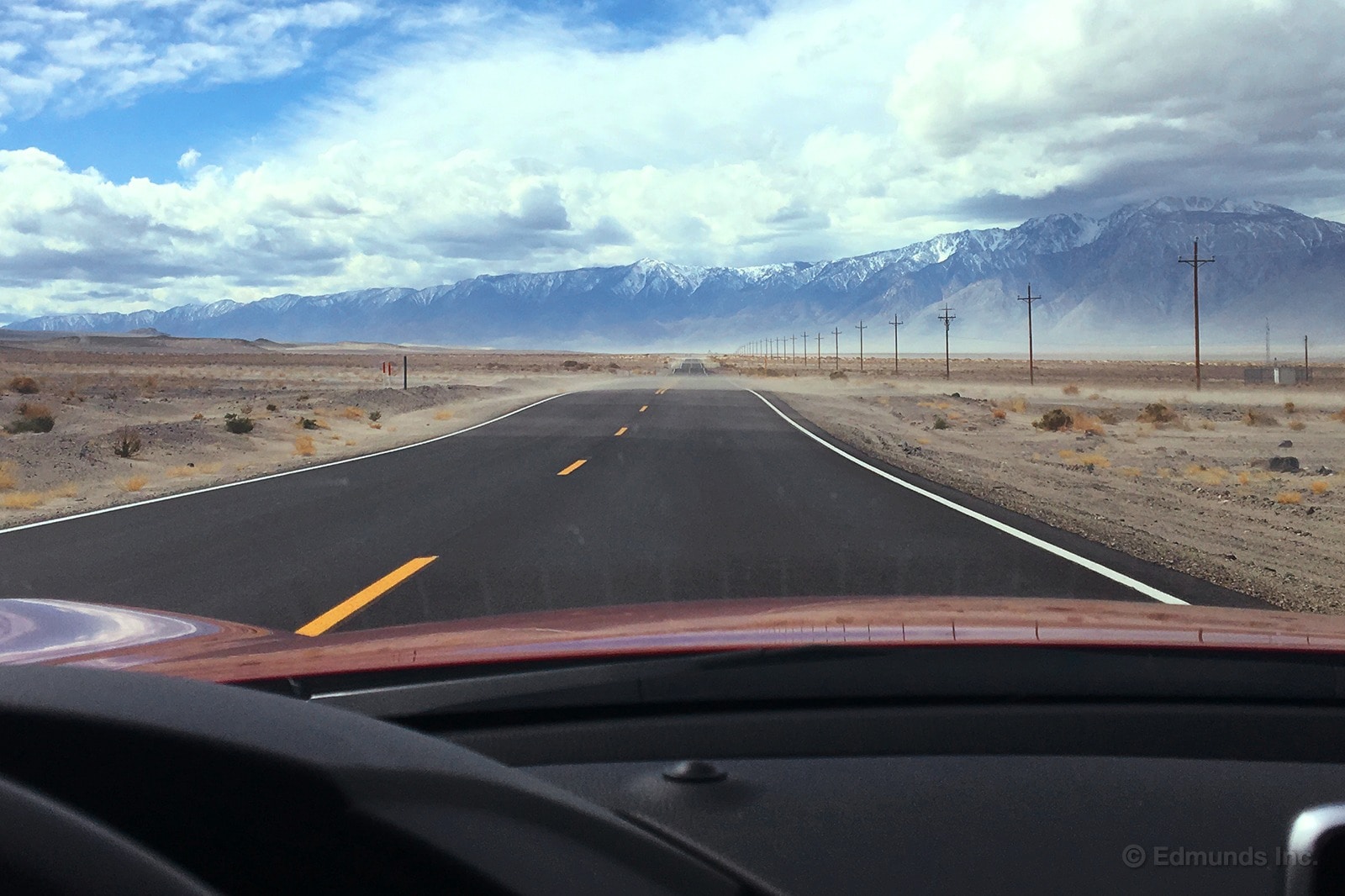
After an occasional direction change, I was also subject to one heckuva a headwind. It was strong enough that I had to downshift to fifth gear in order to maintain my speed. Another concern was what the blowing sand would do to the car's finish. A friend once got caught in a sandstorm and it stripped his Ferrari paint down to the metal. At my fuel stop 100 or so miles later, I found the nose dulled a bit, but nothing a little polishing compound couldn't fix.
Fast forward another 100 miles and the skies opened up as if on cue from our local meteorologist. It was an epic downpour and, again, the photo doesn't do it justice. On a stretch of freeway where drivers usually maintain about 10 mph over the posted 65 mph speed limit, everyone slowed to about 40 mph. It was difficult to see more than a few hundred feet and really not that pleasant.
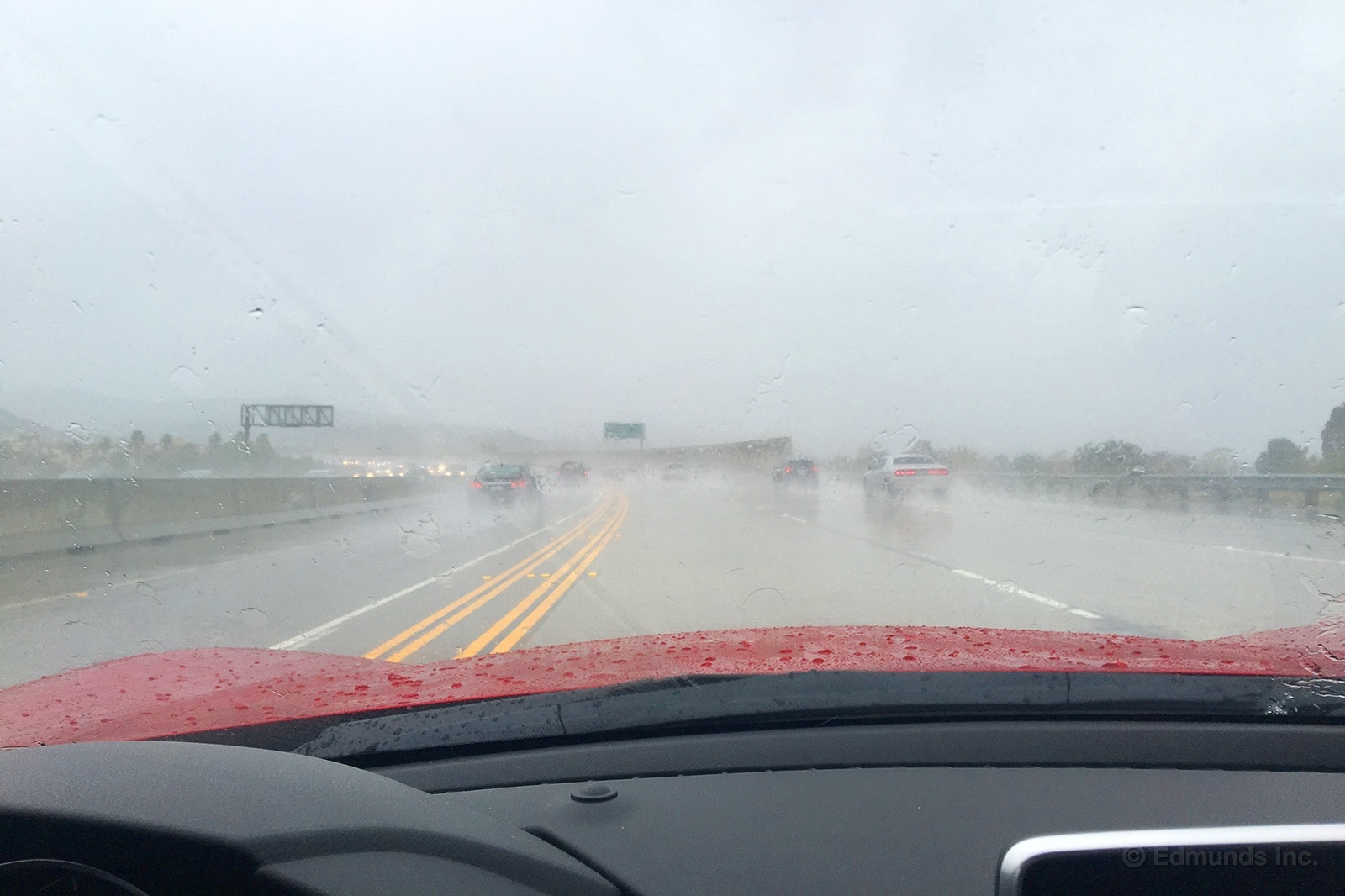
The Miata was quite composed in the downpour, though. The skinny-ish 205-width tires cut through the standing water with ease and when splashing through a puddle on one side of the car, I didn't need to correct with any steering input.
Years earlier, while coming back from a track day on this same stretch of road, no fewer than three Corvettes from the track had crashed off to the side of the road. They probably still had track tires mounted and that wall of rubber doesn't exactly slice through puddles. So again, choosing the Miata over the Viper may have paid off.
A Softtop So Easy a Four-Year Old Can Operate It
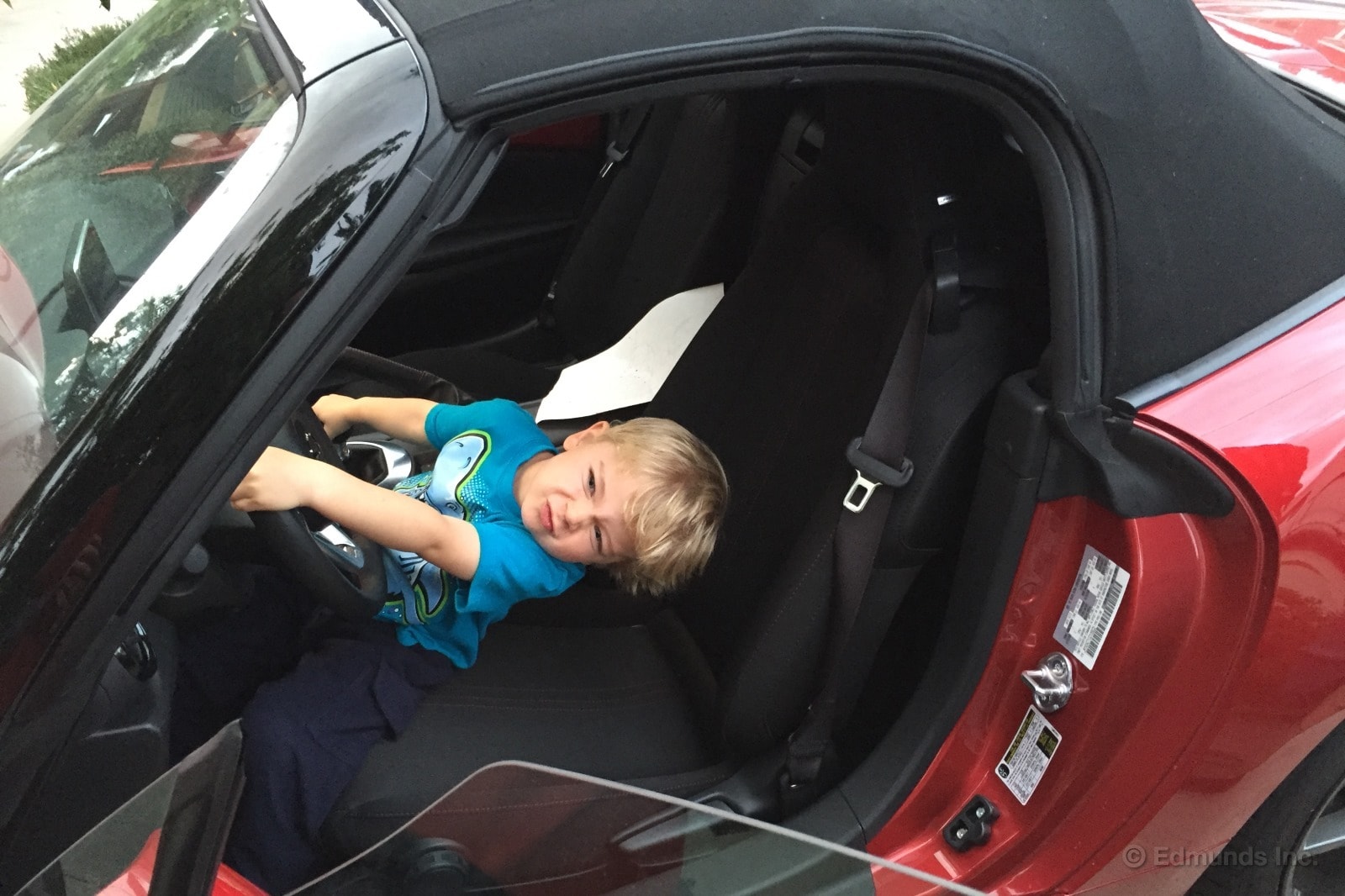
How dead-simple is opening and closing the long-term 2016 Mazda MX-5 Miata's convertible roof? Simple enough that a four-year old could do it.
Correction: a four-year old has done it.
The little blond-haired bean you see above turned four years old last week. He loves cars more than anything on this planet. Naturally, we indulge him in this fascination.
Yesterday he was sitting in the driver seat making race car noises in the top-down Miata under the supervision of several adults, or at least adult-sized humans. We watched as he popped the release handle. Then he swung the roof towards the windshield header and clamped the central hook down to secure the top. Done.
We were, frankly, stunned. All of this happened with zero coaching. It was a spontaneous act that reinforced just how clever and user-friendly this new Miata is.
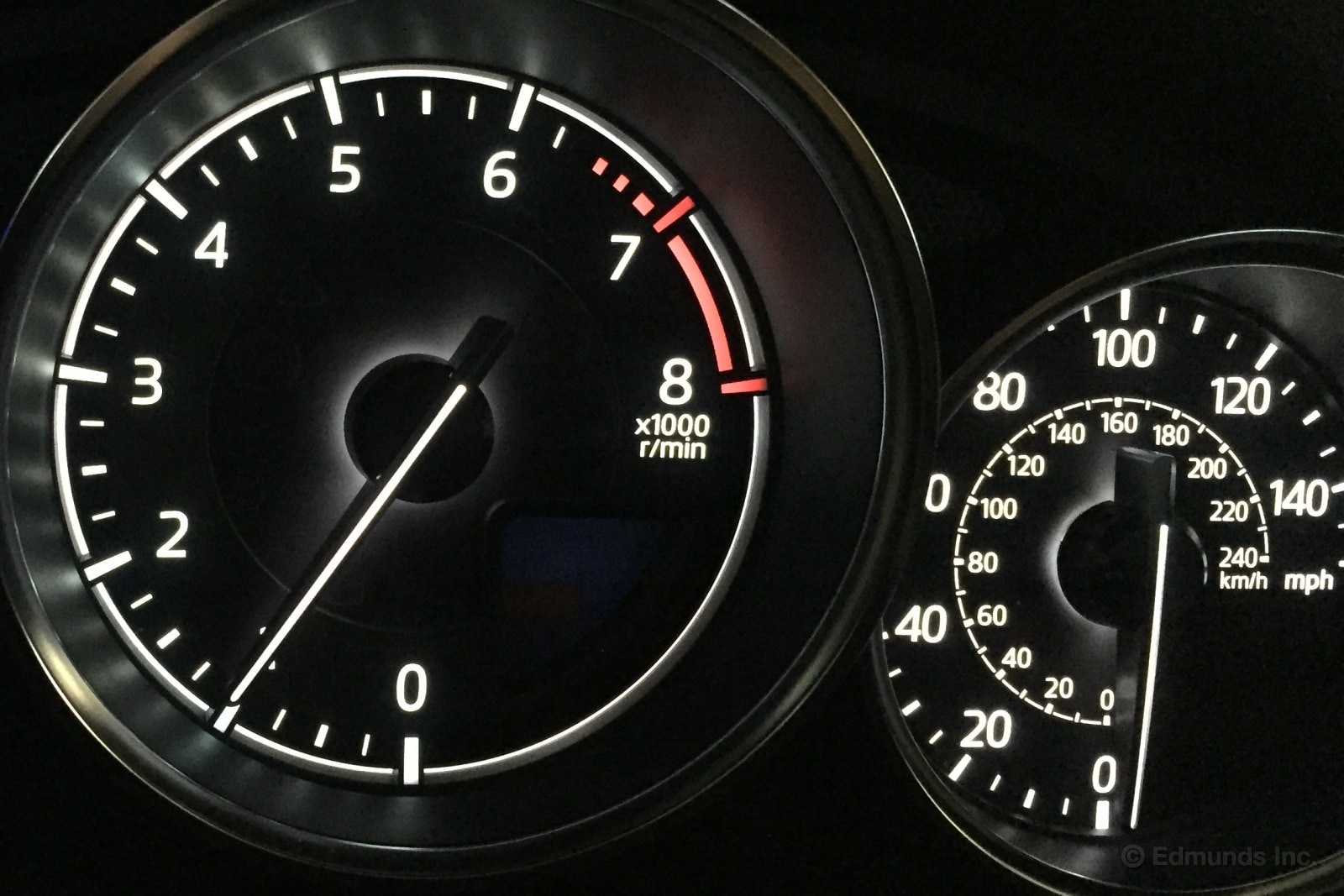
A wise Edmunds editor (is there any other kind?) once called the Miata's powertrain "the most engaging setup you'll find short of an S2000: The reworked engine winds out to 7,600 rpm like a sport bike while still providing respectable midrange torque."
Except that sagacious fellow wasn't talking about our long-term 2016 Mazda MX-5 Miata. He was talking about the previous-generation "NC" Miata, which received a notable overhaul for 2009.
The engine back then was the 2.0-liter MZR four-cylinder, and for '09 the manual-transmission redline went up to 7,200 rpm (plus 400 bonus revs before you hit the limiter), thanks to fun upgrades like forged-steel construction for the crankshaft and connecting rods. Apparently the intake ducting was revised, too, for a sportier soundtrack. The results, as noted above, were pretty great.
In the words of OutKast, I can remember that damn thing like yesterday. The engine loved to rev, and I therefore found myself shifting at redline as frequently as possible, which happens to be one of my favorite things in the world to do.
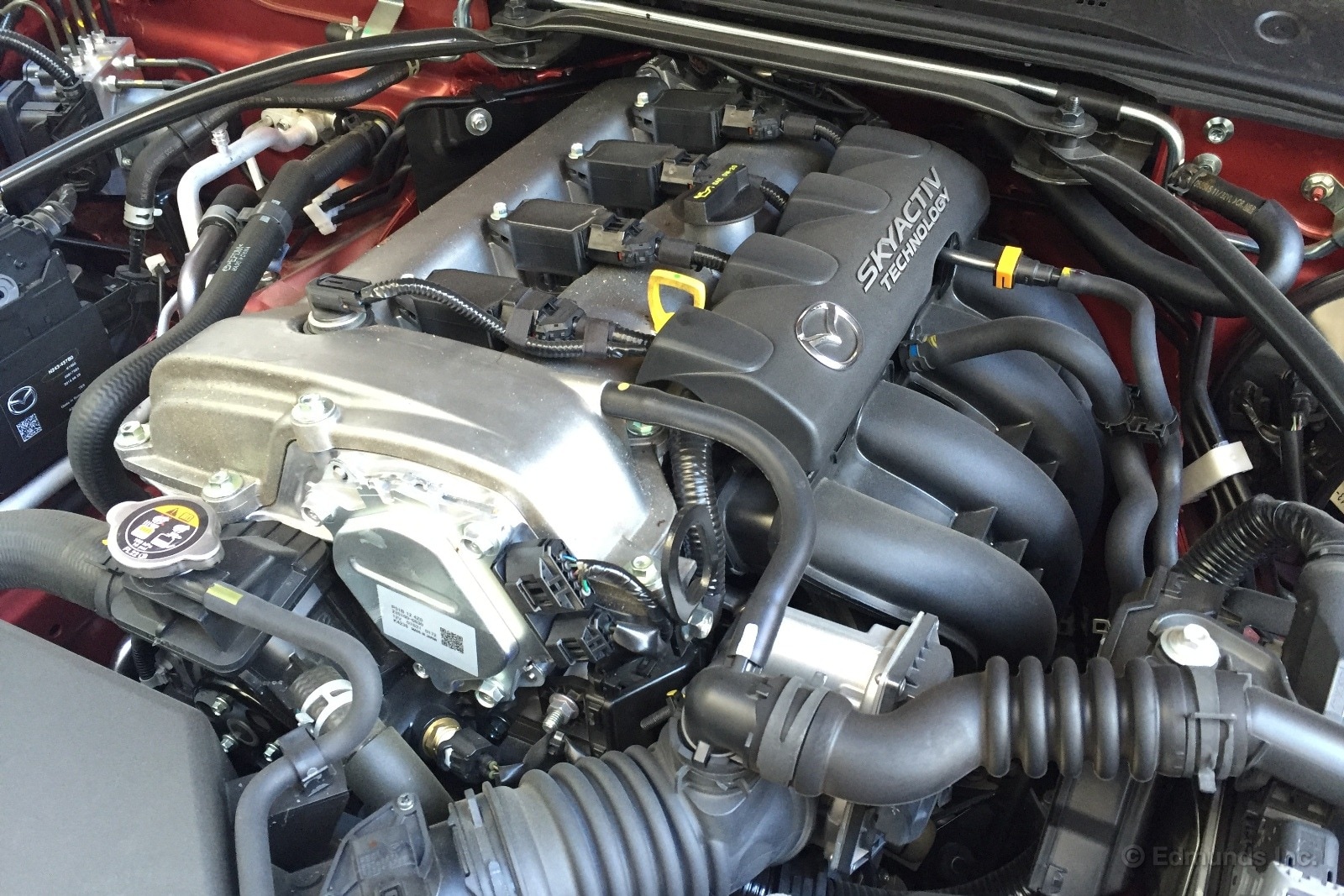
The MZR is gone now, of course, replaced for the current "ND" generation by a 2.0-liter SkyActiv four-cylinder that's essentially borrowed from the Mazda 3 family. Since the ND's lighter than the NC, and the SkyActiv motor has bigger torque muscles, the new car is faster than its predecessor despite being down 12 horsepower, edging it by 0.5 seconds to 60 mph (6.3 vs. 6.8) and a healthy 3.5 mph in the quarter-mile (93.6 vs. 90.1) per Edmunds testing data.
But those numbers don't capture the difference in character. The SkyActiv 2.0 redlines at 6,500 rpm in this application, just like it does in the Mazda 3 i, and it's "done making power by 6k and only gets rougher higher than that," according to our track driver's notes. That frank assessment squares with my real-world experience: I love the easy torque in just about any gear, but as I said in the S2000 post, there's no reward at higher rpm.
In the 2009-up NC Miata, conversely, 6,000 rpm meant things were just getting interesting. To me, that's what an elemental sports car is all about.

Hey, I get it, I'm an outlier by American standards. That's why the 2.0-liter engine was selected for the U.S. market - because most of us would rather shift early and still have ample shove. Internationally, the ND Miata uses a 1.5-liter four that redlines at 7,500 rpm and is reportedly quite happy to do so. I would gladly sacrifice some speed for that higher-revving experience, and I'd also take a hard look at lightly used 2009-15 NCs, which are readily available for $15-20,000 as of this writing.
But you think I'm nuts. Right?
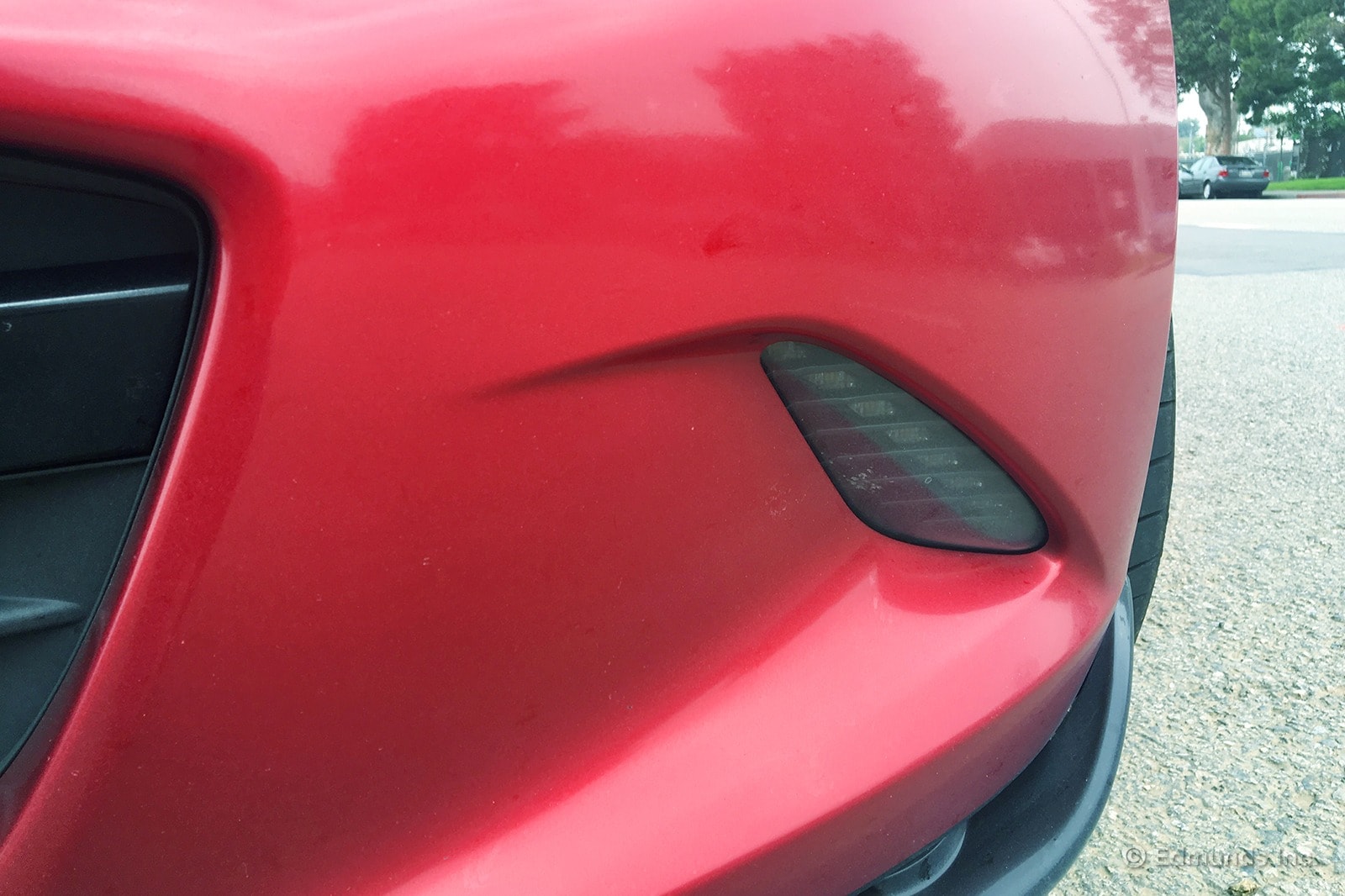
As it turns out, the sandstorm I got caught in caused some damage to our long-term 2016 Mazda MX-5 Miata. Not surprisingly, the car's nose has suffered some paint abrasion, but I'm confident I can buff that out with all of our detailing equipment.
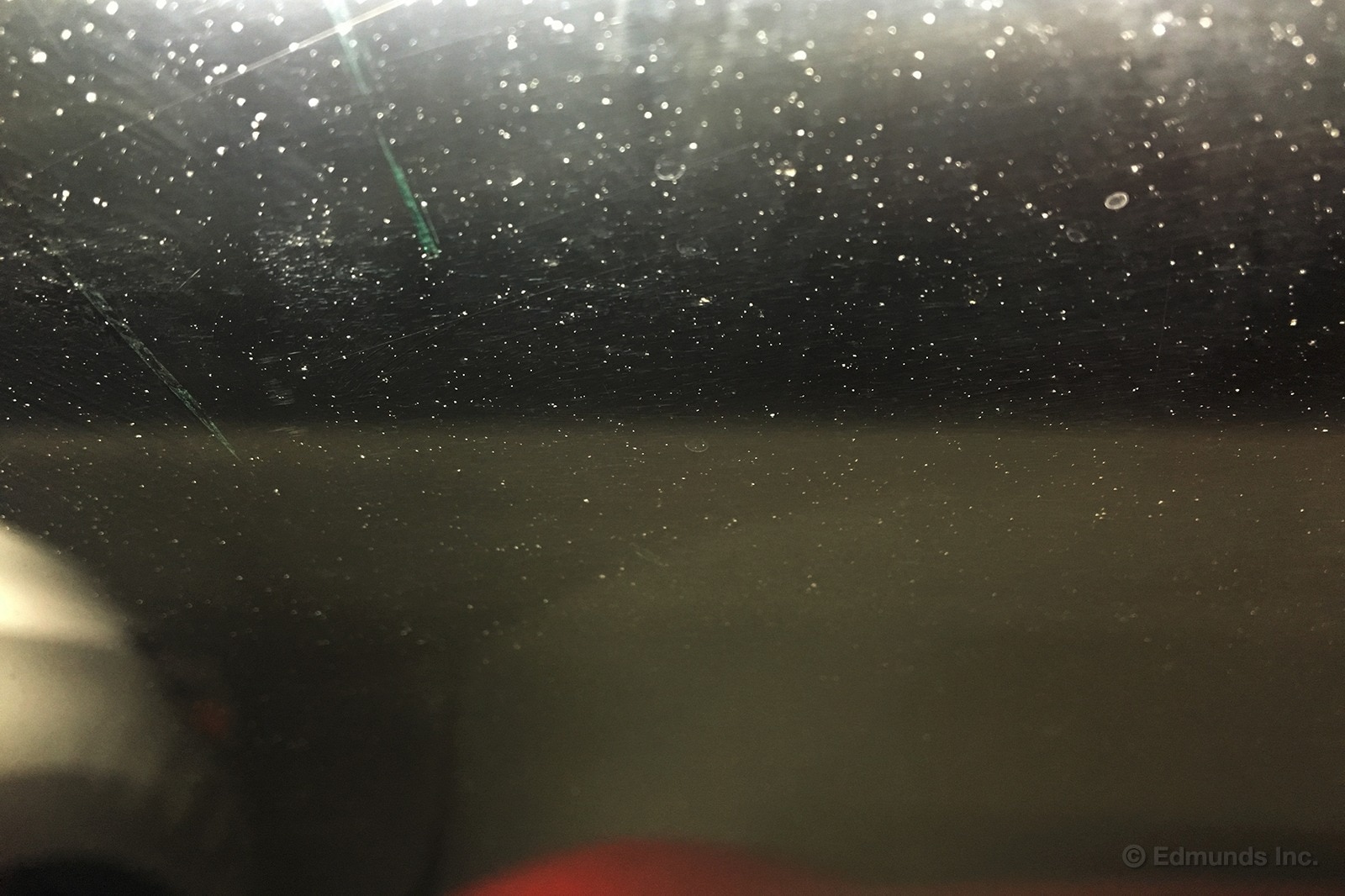
Unfortunately, there's nothing I can do about the windshield. That is pitted to the point that we probably need to replace it. We tried a few fixes, but nothing helped. If you're driving towards the sunlight, visibility is pretty tough as the whole glass diffuses the light into a murky haze. It reminds me of when I'd sneeze in my motorcycle helmet at night.
Horrible, right?
Stay tuned for the forthcoming fixes.
Sandstorm Damage Extensive, Possibly Expensive
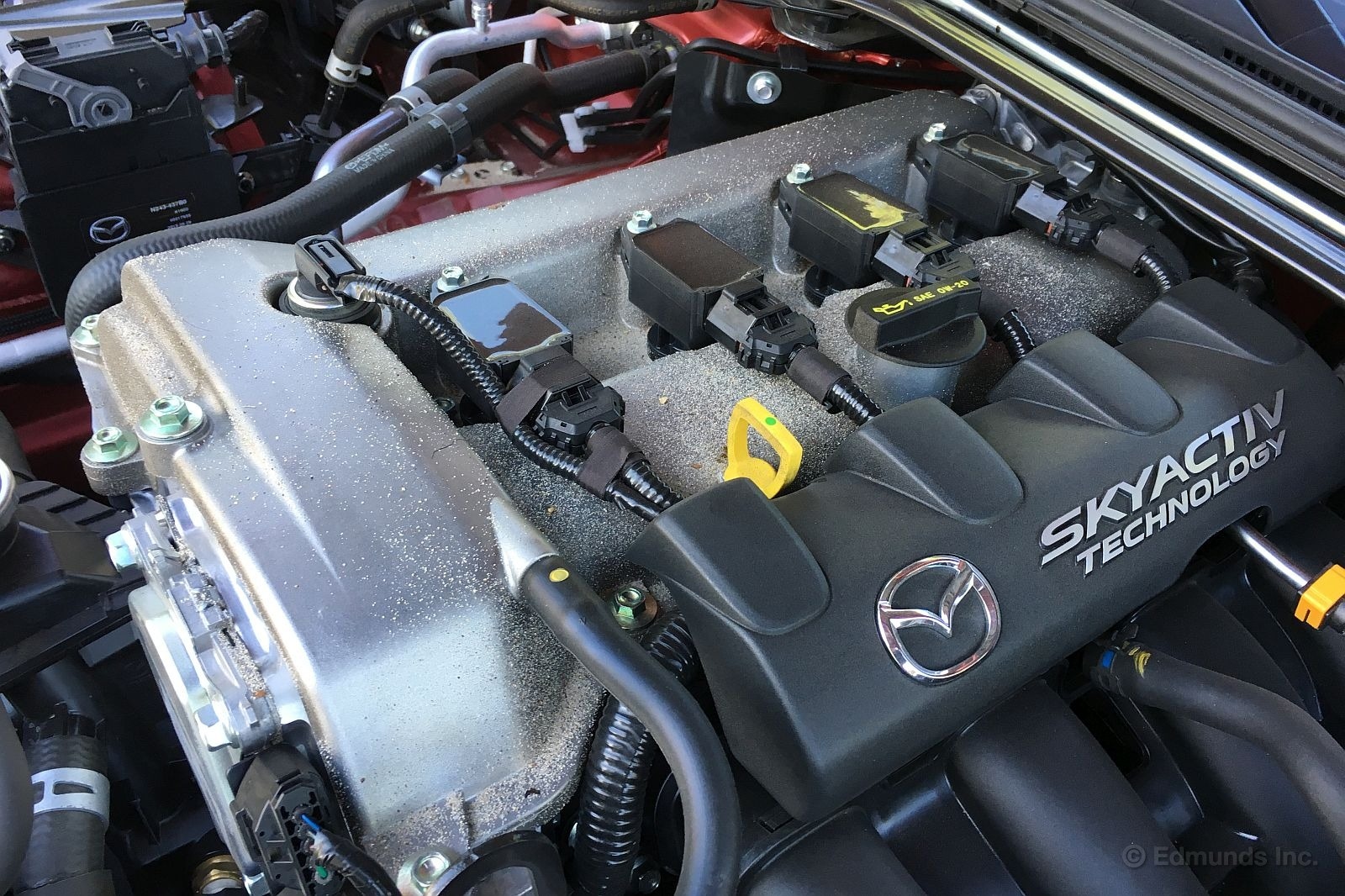
As Mark Takahashi already said, our 2016 Mazda MX-5 Miata was caught in a sudden sandstorm on a deserted stretch of two-lane desert road with no cover whatsoever. I drove it home a day or two later and discovered the damage to be even more extensive than I imagined after hearing his description and seeing his pictures.
For one, the car smelled of the desert whenever the fan was on. Not the sweet sage smell you get after it rains, but the dry dusty smell you get from being eighth in line behind a string of Jeeps in a sand wash. A new cabin filter would be in order — if the ND had one.
This led me to pop the hood and have a look at the engine air filter. In the process I got a look at the coarse, sharp-edged grit that had enveloped the Miata because a goodly amount of it had settled on top of the engine.
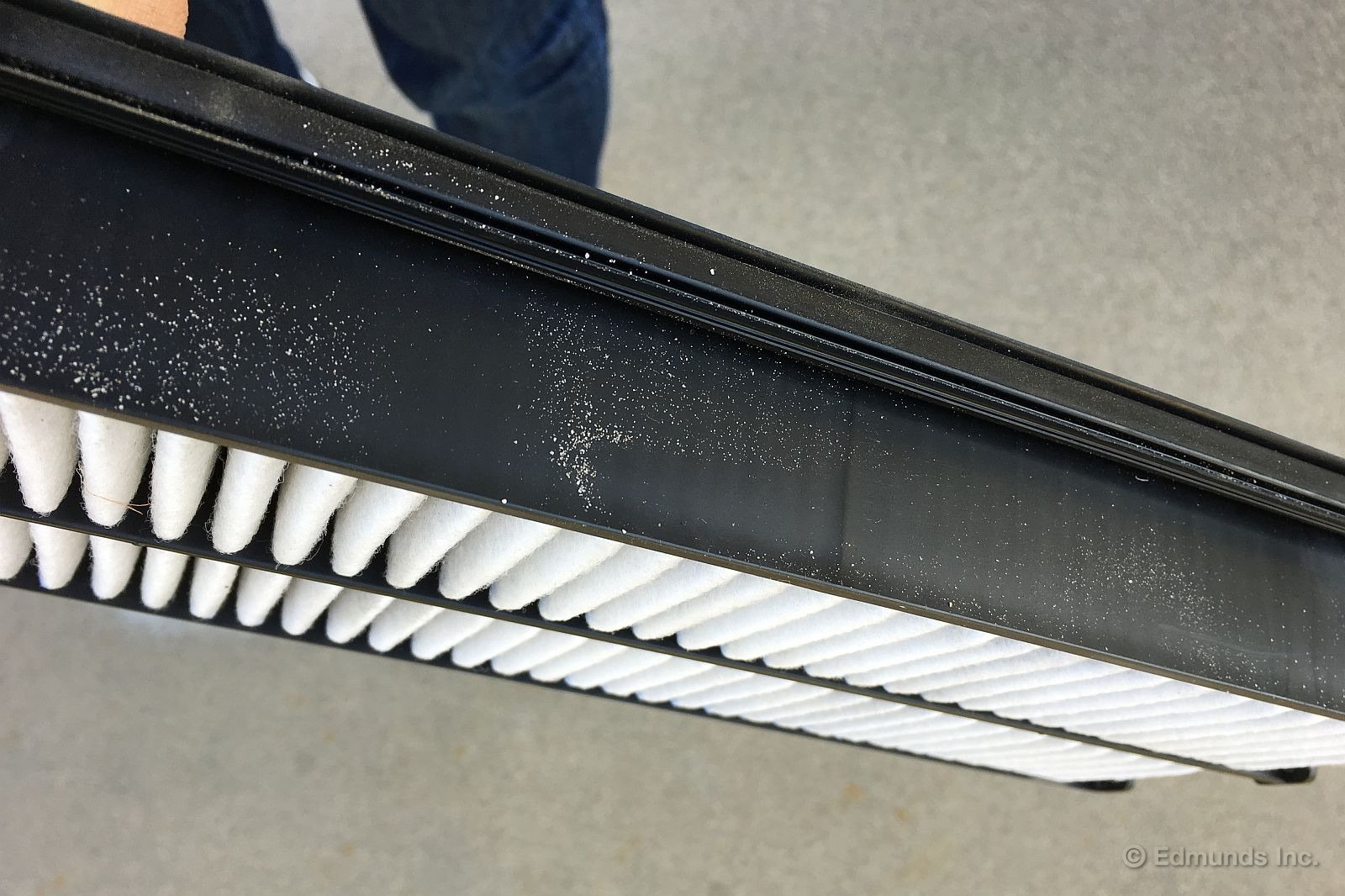
The inside of the air box proved to be fairly clean. The filter didn't look obstructed or even visibly dirty, but I did find evidence of sand grains between the pleats and along the sides. The filter did its job and caught the small amount that made it this far into the works, but this stuff has sharp edges. Could the embedded grains work through the pleats over time?
Better safe than sorry. I bought a new one for $20.11 at my local dealer.

As Mark said, the windshield is junk. Early indications suggest that could set us back $750 or more unless we go with a cheaper nameless replacement. Stay tuned.

The headlights are pitted pretty bad, too, but you I couldn't really tell while driving because they still seem to throw out plenty of light. It's impossible to do an A/B comparison at this point, though.
While I was buying my filter, I asked the guy at the parts counter how much replacement headlight assemblies would cost should we actually need them. Would you believe $954 each? LED headlights are expensive. And no, the lenses are not available separately.
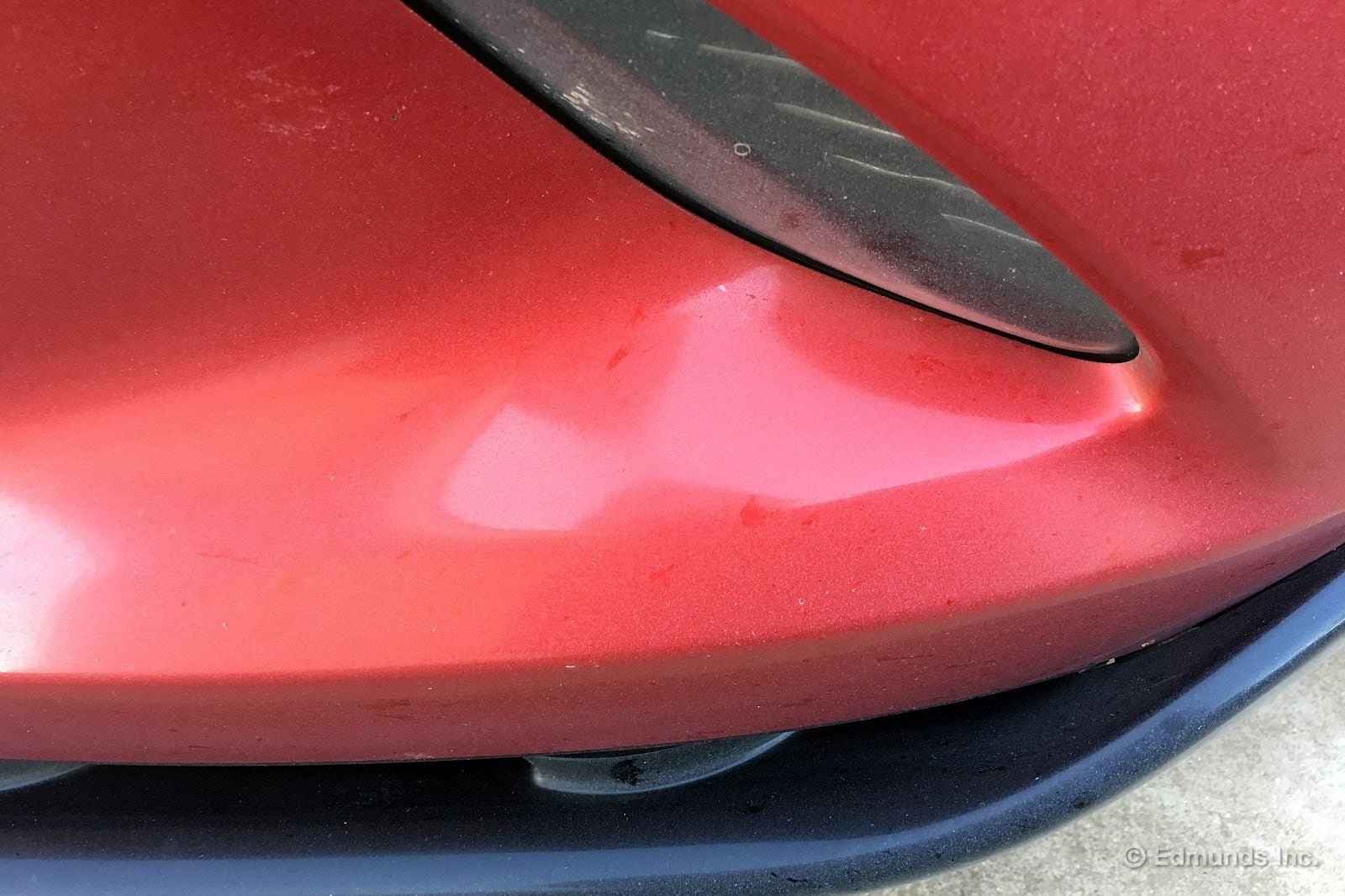
The low-mounted turn signal marker lights got sandblasted even worse. They cost $269 apiece to replace. If you're keeping score, that's $2,500 in lighting. Yeah, methinks we should pay a professional to try his hand at headlight restoration before we go down that road.
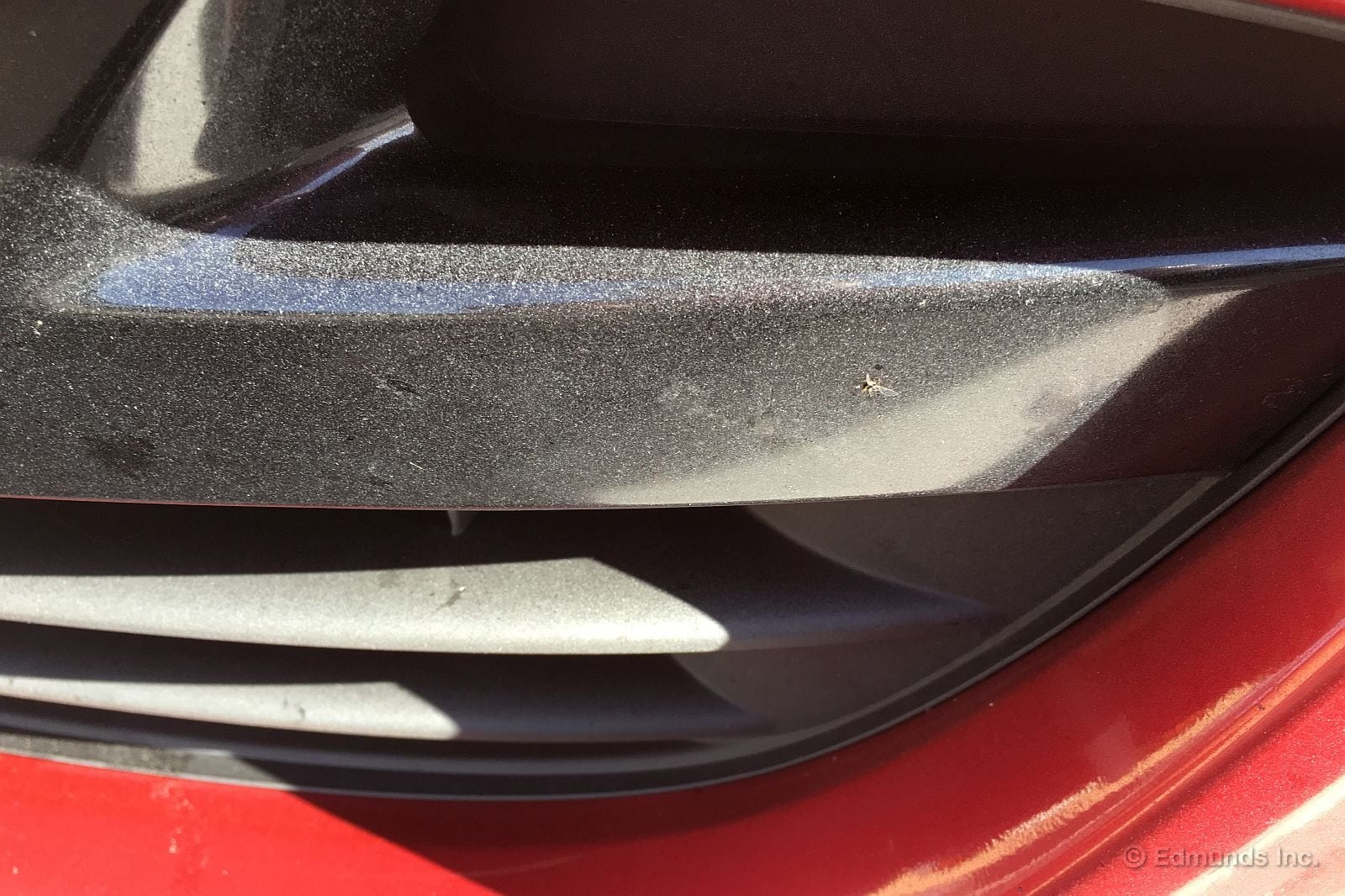
Not surprisingly, all of the black-painted parts such as the grille and the splitter now have a motley speckled gray appearance. It looks like razor stubble in reverse. The mirrors and the black windshield pillar garnish panels aren't as bad, but they show signs.
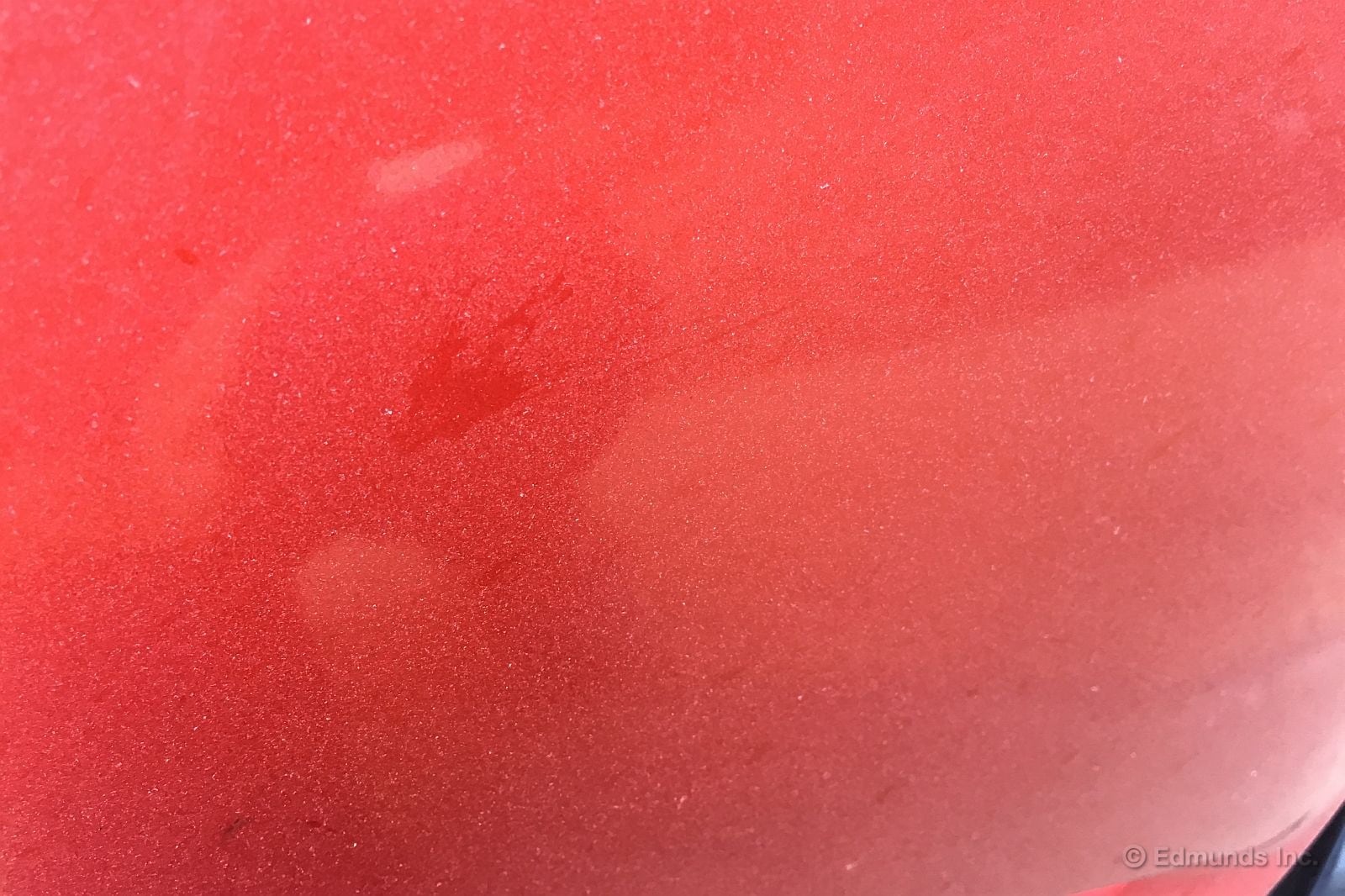
To get an idea how much gloss was lost in the worst areas, look where the dead bugs used to be in this photo and some of the previous images. They protected the paint through the sandstorm and left a shadow of good paint behind after they were subsequently washed away.
There are those in the office that think some advanced detailing techniques will bring the paint back to life. I'm dubious, but it's certainly worth a try.
I suppose that's what I would do if this were my only car. Without knowing in advance if a repainted front end would look as good as new, I'd probably be hesitant to file an insurance claim, pay a hefty deductible and deal with the possibility of increased rates.
Unless, of course, the detailing approach had zero success.
Silt happens.
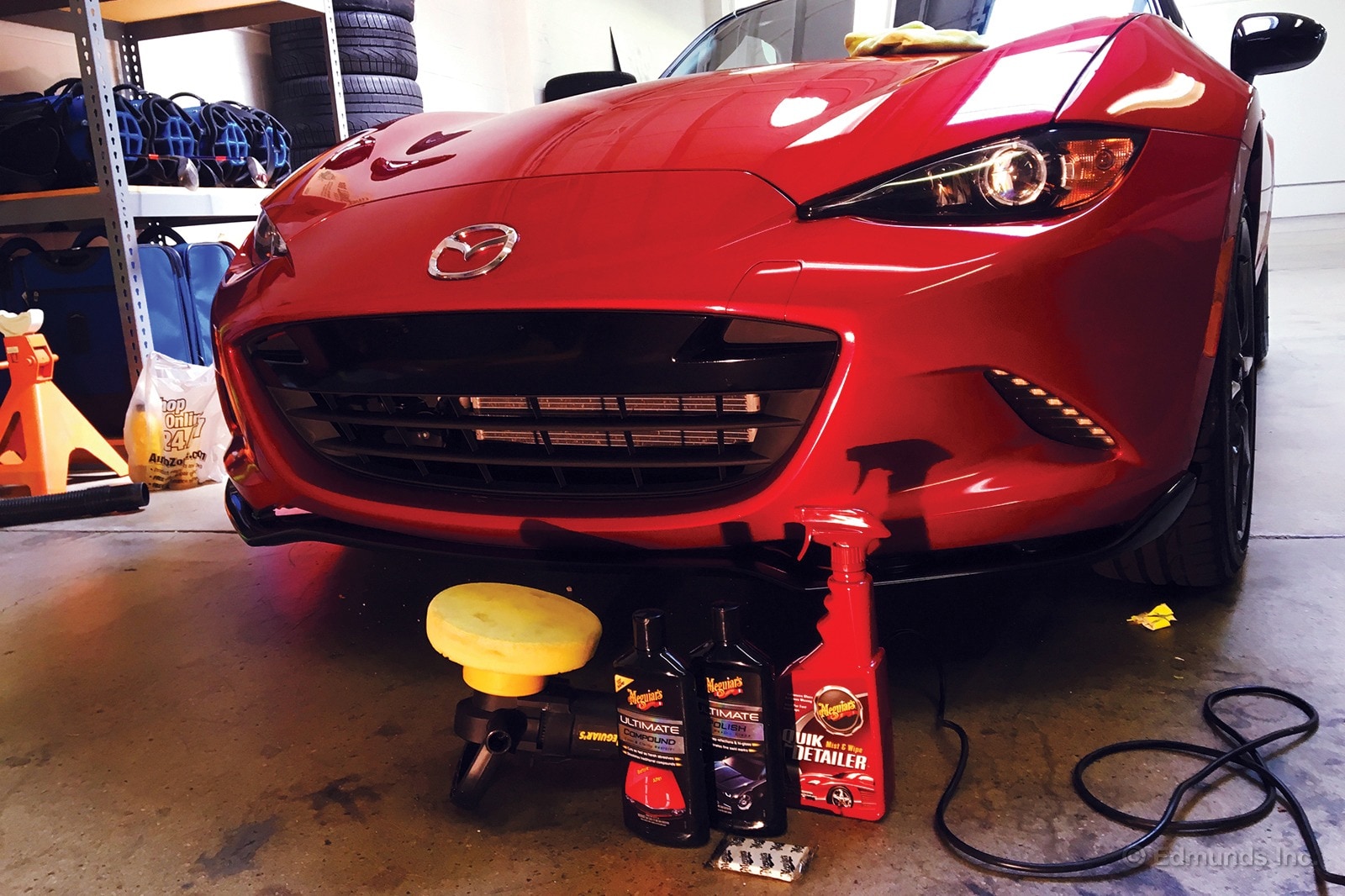
When one of my colleagues said I ruined the Miata, my response was, "Lemme see if the skills/equipment I've acquired will actually fix it first."
Yes, the nose of the car was pretty scuffed up, but the damage was limited to the clearcoat. In bright sunlight, it would look pink in comparison to the rest of the car and the black trim looked grey. But I was nowhere close to freaking out because I knew that the day I spent at Meguiar's learning how to detail our old Buick Grand National would help.
I started with a cleaning at our usual car wash, then drove to our shop/studio a few miles away. As the hood cooled off, I set up my work area with harsh lighting to see the defects. The first step was to use a fresh clay bar over the whole car. This is the most work-intensive part of the detail, but fortunately the Miata is small. The white clay was pulling up a fair amount of contaminants from the surface, as it should.

Next up was our dual-action power polisher with an aggressive compound pad loaded up with Meguiar's Ultimate Compound liquid. The result after two passes was impressive. The color was back to its darker red and the reflections were significantly sharper. In the photo below, you can see how the cutout for the marker lights (before), differ from the rest of the plastic bodywork (after).
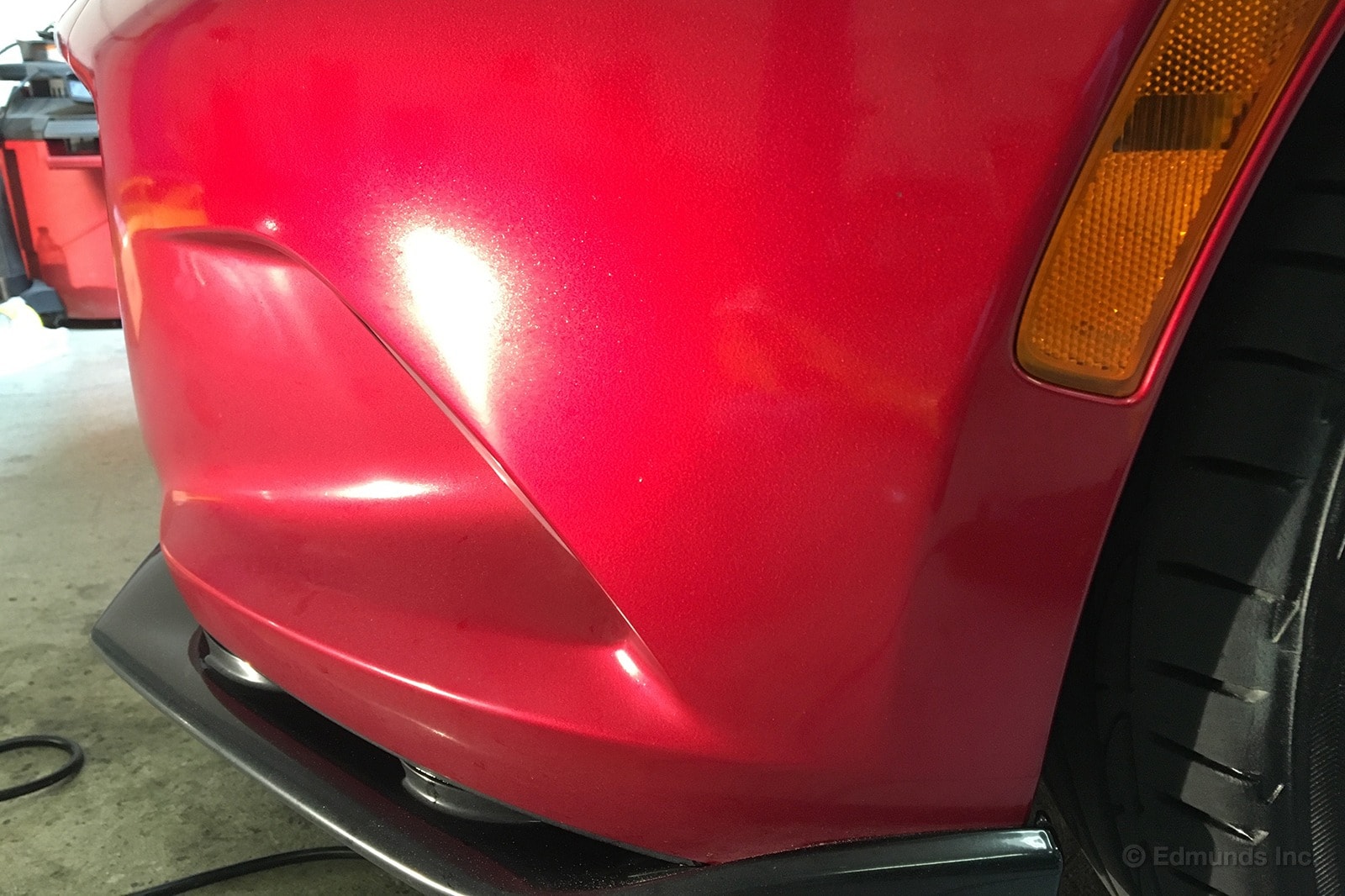
I used the same techniques on the black trim and splitter, but I couldn't get into some of the crevices because I broke a few fingers last year in a motorcycle crash. I'll get to those at a later date.
I followed that up with a good coat of wax using the polisher on a slower speed setting.
At that point I called it a day because my fingers had locked up and my back was not cooperating. I did pop the hood and with a quick brushing with some gloved hands and a blast of compressed air got most of the sand off the engine. Getting the rest off would require pulling the spark plug wires, which I'll get around to later as well.
I packed up and pulled the car into the sunlight. From over my shoulder, I heard a guy from a neighboring business say, "daaaaaaaamn, that's cleeeeeeeean."
Vindication.
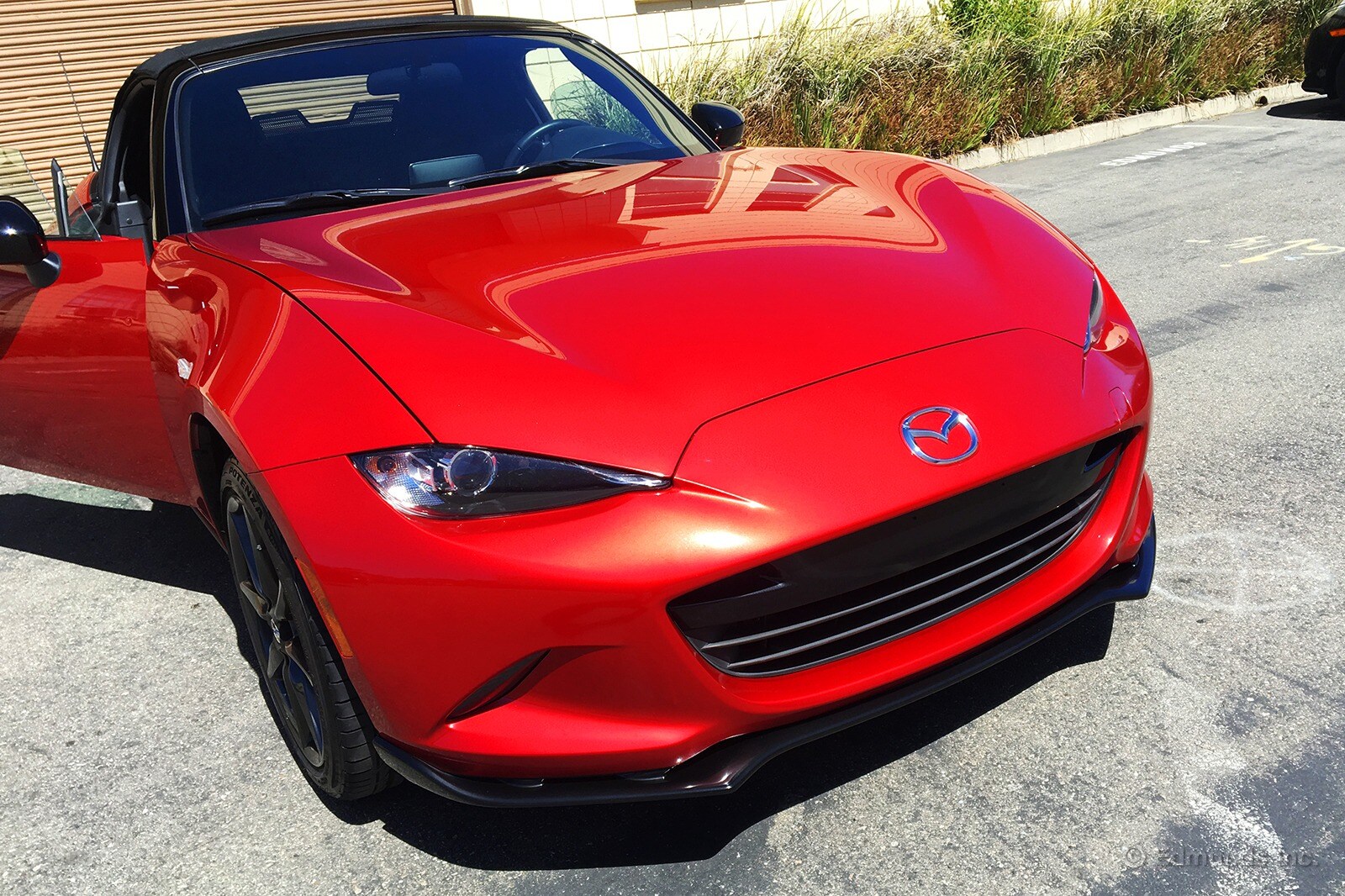
I think the paint is about 90 percent back to normal. Maybe after another detail, the damage will be undetectable. Next I'll get the headlights clear and try to get that front splitter a little shinier, too. Look for that in an upcoming post. So far, the only thing I consider "ruined" is the windshield.
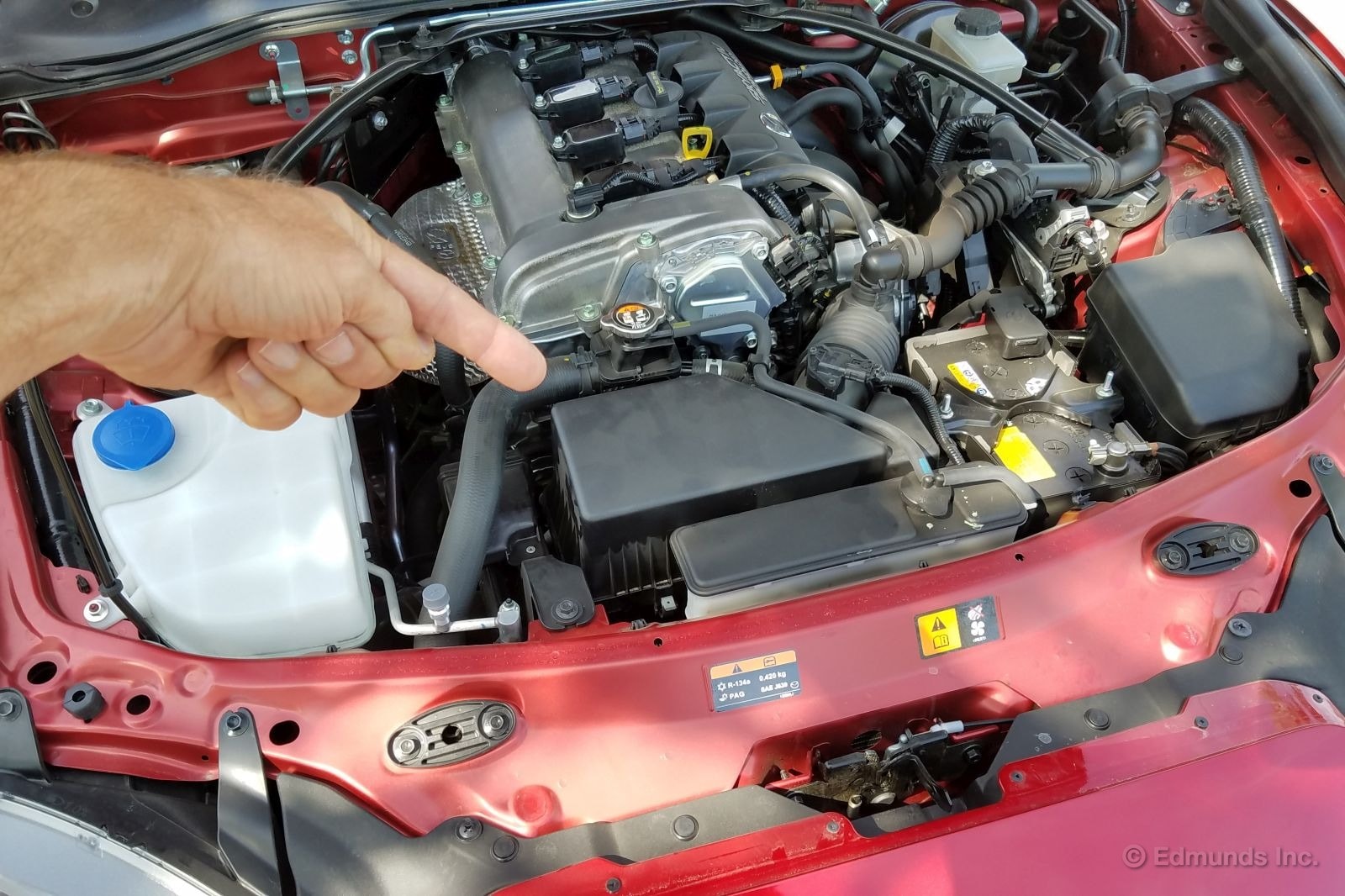
You already know that our 2016 Mazda MX-5 Miata got caught in an immense sandstorm. If there were such a thing as a Fujita hurricane ranking scale for sandstorms, this event would have fallen slightly closer to the Mad Max end of the spectrum that stretches from mere Dust Devil to full-on Fury Road.
I later examined the air filter and decided it might be a good idea to install a new one. The interior smelled of dust and desert, so I thought about a new cabin air filter — if the ND had one.
But the owner's manual made no mention of one, even in the maintenance schedule. The internet seemed to suggest the NC had one because of its tight-sealing power retractable hard top option, and with a new 2017 Miata RF retractable fastback version just announced it seemed that this logic might extend to the ND, too. I called a Mazda engineer I know — in charge of suspension, admittedly — but he wasn't sure.
So I asked about a cabin air filter when I bought a new air filter ($20.11, with tax) at my local Mazda dealer. I peeked over the parts-guy's shoulder as he scanned through the online version of the microfiche. Nothing came up. It seems there is no such thing.

Back home, the air filter swap was painlessly simple, with just two clips and two tabs holding the clamshell air box together. I had the old filter out and posed next to the new one in no time at all.
It didn't look that bad, but I kept thinking back to the sand grains I'd seen on the filter when I took it out for a peek a few days earlier.
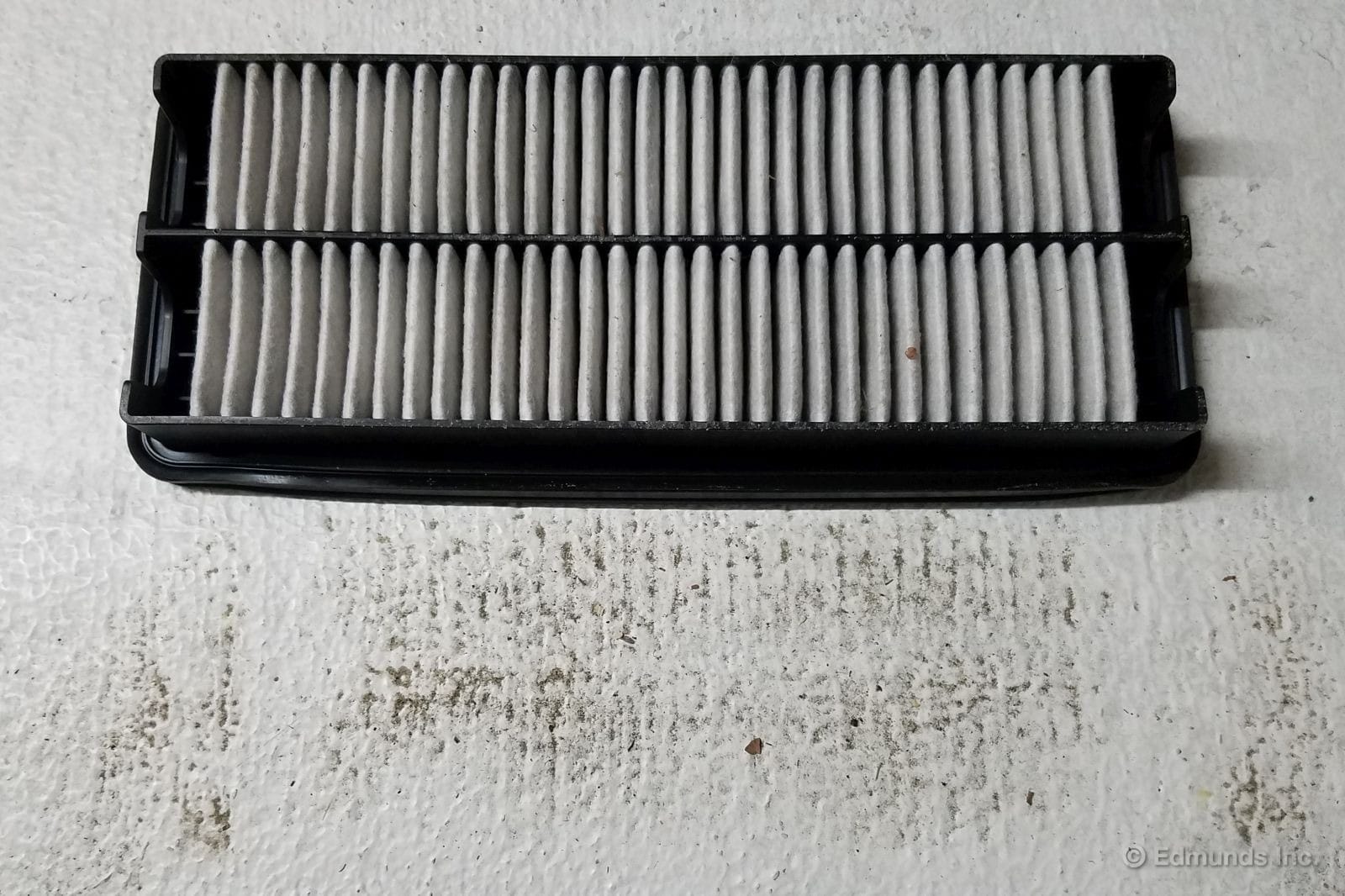
So I rapped it hard against the ground a few times. Quite a lot of grit came out and sullied the clean white paint on the garage floor. Yeah, changing our Miata's air filter was a good idea.

The new filter slipped back in as easy as you please. This is about the easiest car maintenance task I can imagine.
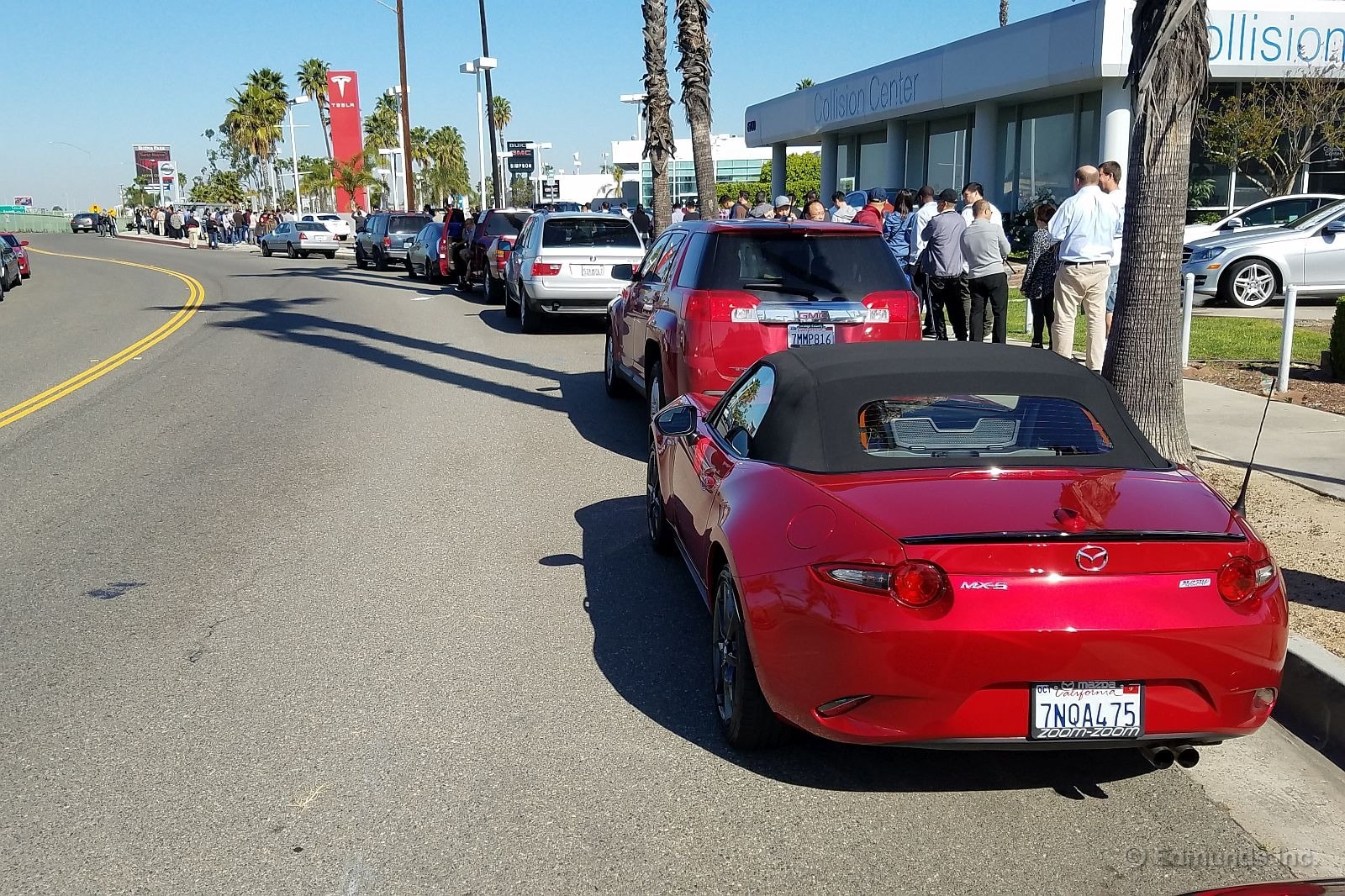
To the surprise of no one, our 2016 Mazda Miata is becoming more popular as the weather warms. Some 2,365 miles were added this month, and they bolstered our impression that the Mazda Miata is one of those cars that can readily match its EPA fuel economy rating.
With 8,228 miles of mixed driving now on the clock, our Miata's lifetime average of 30.2 mpg falls right in line with its EPA combined rating of 30 mpg.
And we beat the Miata's 34-mpg EPA highway rating again, setting a new best tank of 37.5 mpg, with a new best range of 329 miles thrown in for good measure.
Sure, there were road trip miles, but more than one staffer thinks it's too loud and too lacking in interior storage for extended long-distance work. Whether you agree with that or not, the fact that we have larger road-trip machines to choose from ensures that our Miata driving mix includes plenty of local miles.
My own 292-mile weekend tank of 29.4 mpg included a mix of city and highway miles, and I never strayed more than a couple dozen miles from home base. I went to the Long-Beach Formula-E race, attended the Tesla Model 3 unveiling in Hawthorne and drove to my local Tesla dealer at 4:20 am to stand in line and put down a deposit on a *spoiler alert* future Edmunds long-term vehicle.
I wouldn't have guessed the Miata would get that close to EPA combined on a tank like that, but it ended up surprisingly close.
Worst Fill MPG: 22.2
Best Fill MPG: 37.5 (formerly 36.5)
Average Lifetime MPG: 30.2 (3.3 gallons per 100 miles)
EPA MPG Rating: 30 Combined (24 City/34 Highway)
Best Range: 329 miles (formerly 311.2)
Current Odometer: 8,228 miles
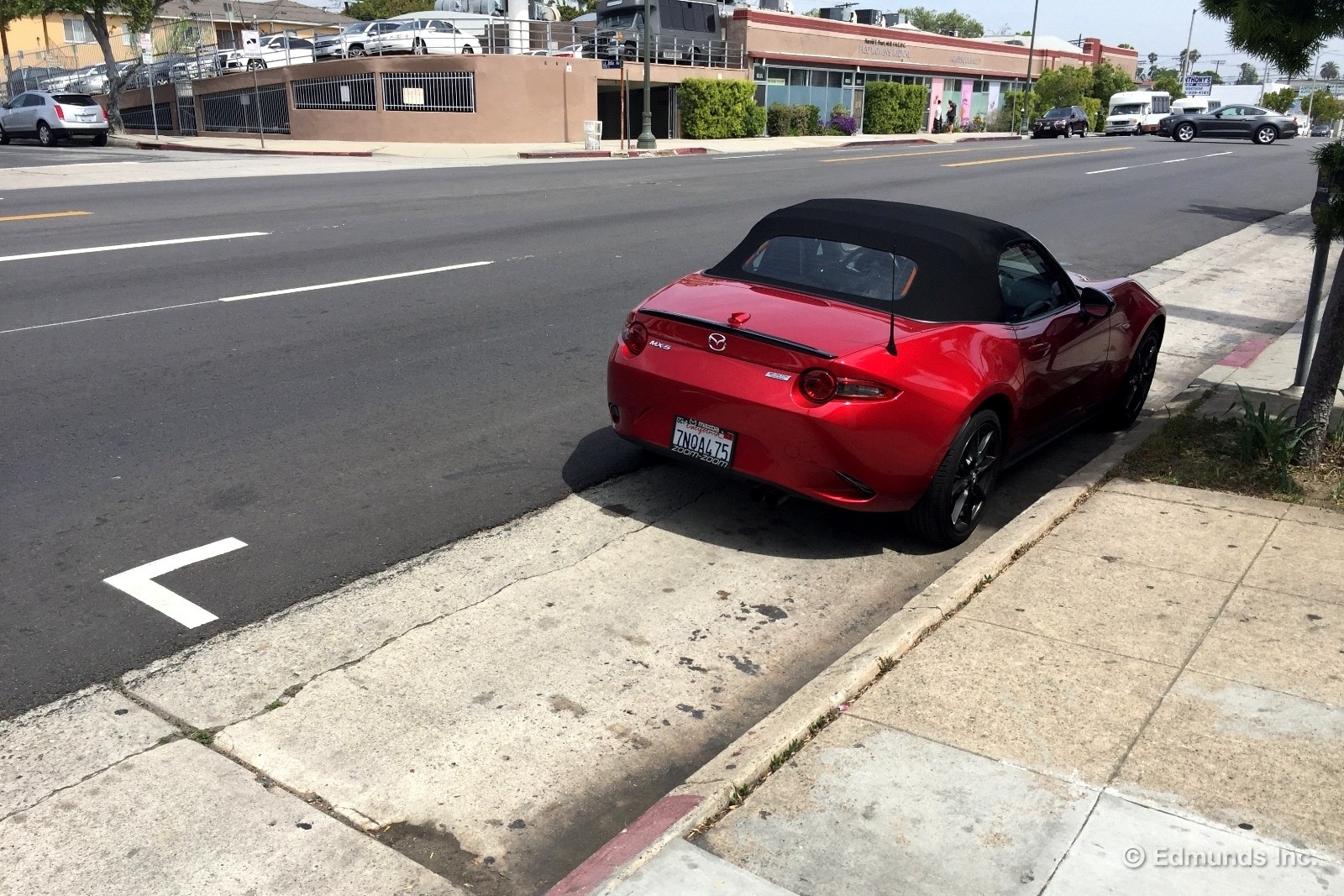
I don't have much to add to Travis's post other than a couple photos, but I definitely did a double-take when I saw how much room was left behind our 2016 Mazda MX-5 Miata in this random L.A. parking space.
The new Miata is a seriously small car, and that's a beautiful thing in the city.
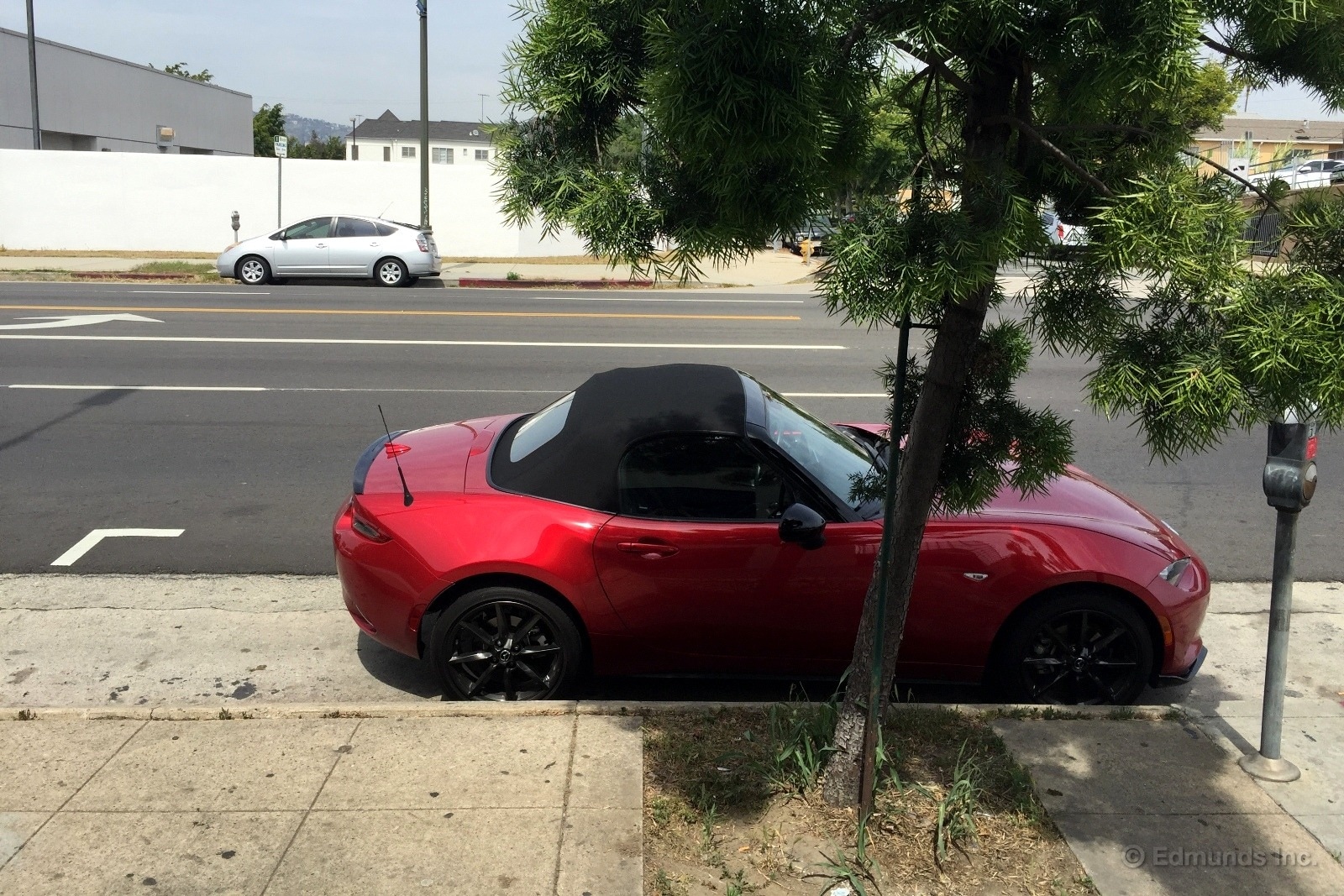
Okay, the first camera angle makes it look a little more dramatic than it actually was. Still, the Miata is a foot and a half shorter than a Hyundai Accent, for goodness' sake. It feels like a microcar compared to just about everything else I drive these days. That can be a bit disconcerting on congested freeways, but when you want to squeeze into a tight spot, the MX-5 is an ideal companion.
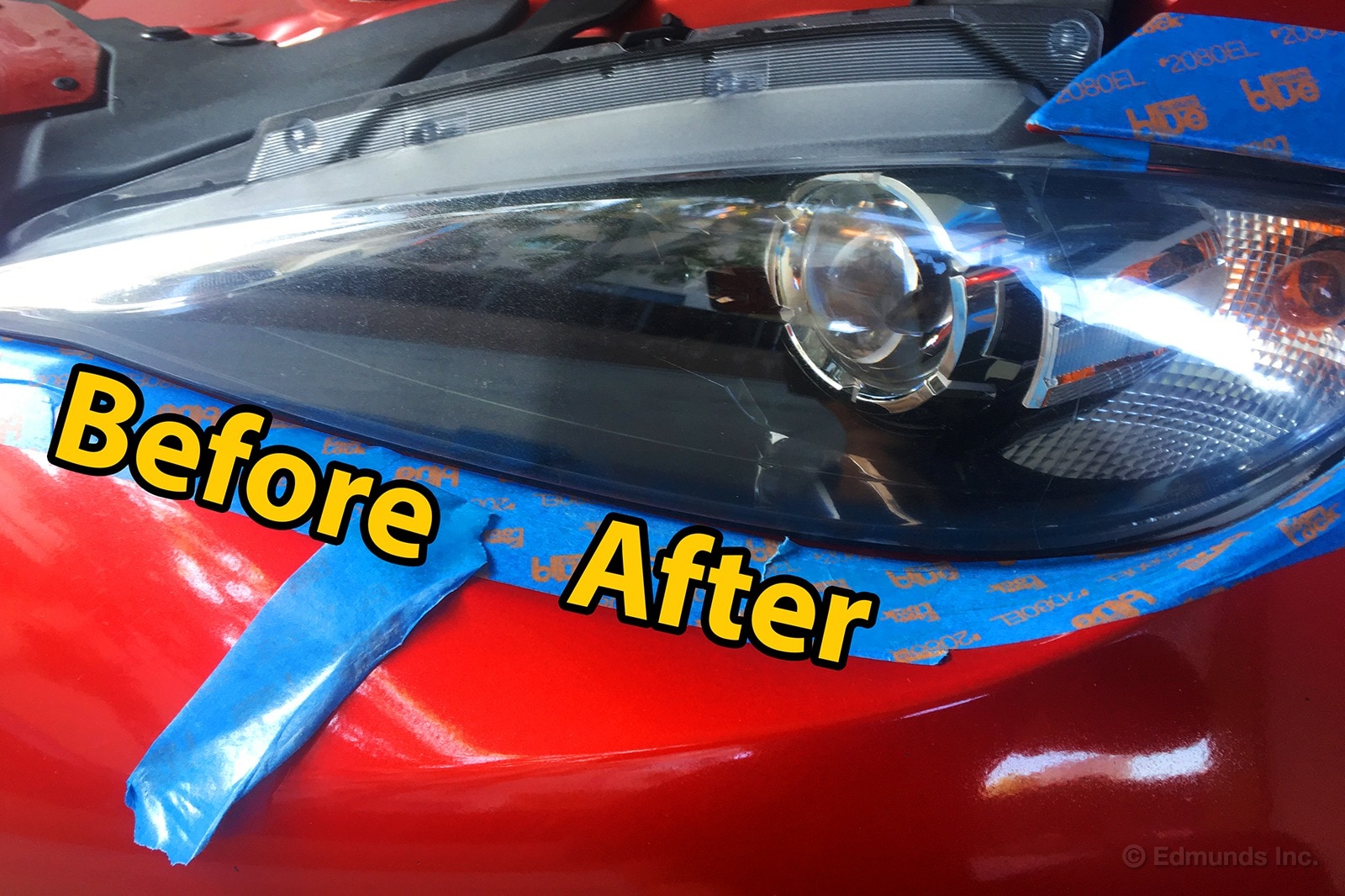
I finally had a little time to continue cleaning up the damage from a desert sandstorm. This time around it's the headlights.
Quite a while back, the good folks at Turtle Wax stopped by our offices to give us an update on their latest products and left some samples, too. Included in the samples were several boxes of their Headlight Lens Restorer, which includes a rubbing compound, a spray lubricant and four abrasive pads with finer and finer grits.
I was pretty confident that it would make the cloudy lens clear again because I've used it once before on Riswick's Z3.
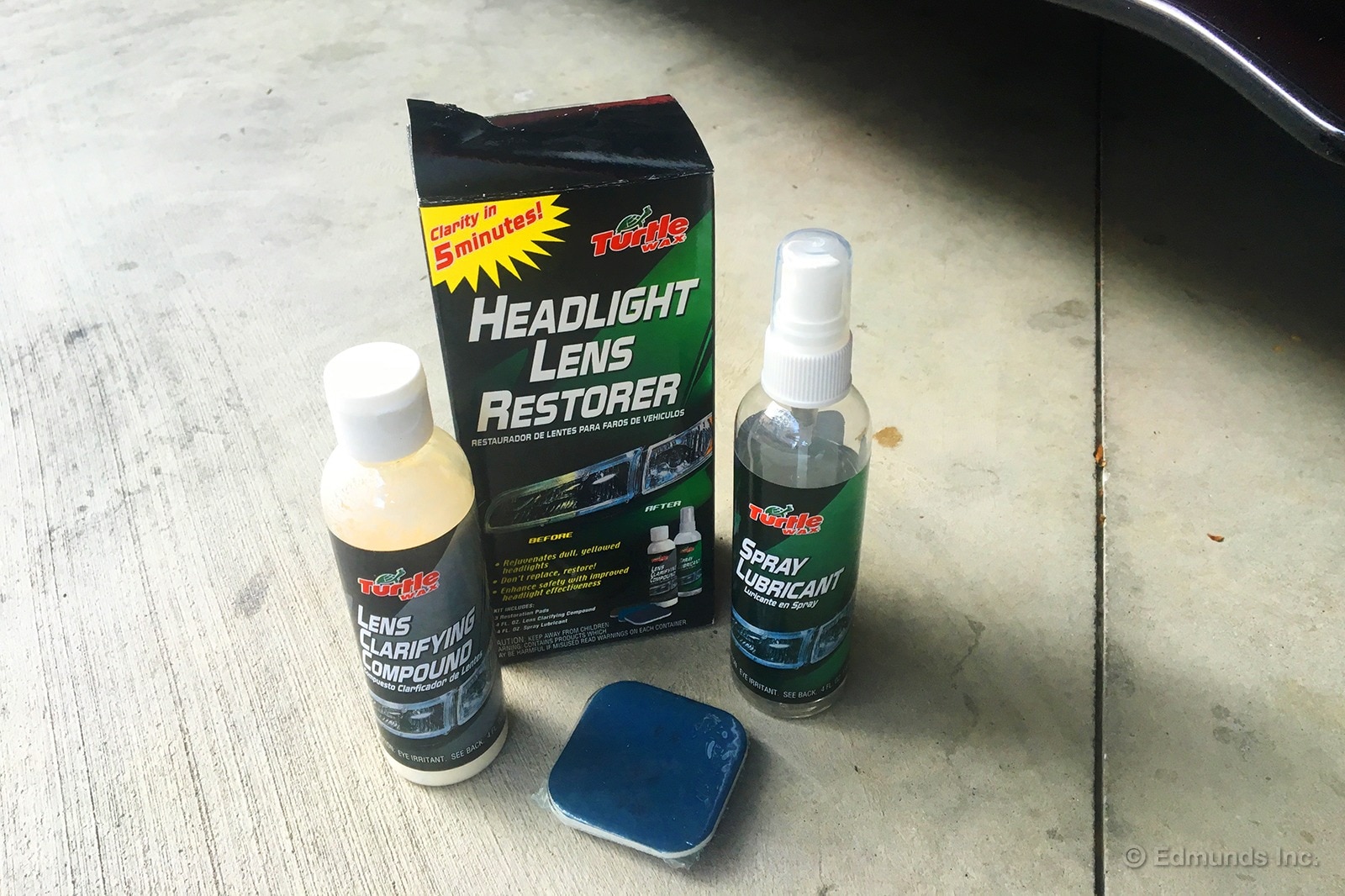
The first step was to apply some of the rubbing compound, which I suspect would take care of really minor hazing. It had very little impact so I went to the next step. I sprayed down the number one pad and the lens with the lubricant and firmly rubbed back and forth for a few minutes. Then more spray and the number two pad rubbing up and down. I repeated the process until I got to the fourth and finest grit pad.
I wiped the lens off and it was more clouded over than when I started, but it was uniformly cloudy. The last step was a return to the rubbing compound and this took the most effort. Eventually, it wiped clear and there was much rejoicing.
In the main image you can see the difference where I ran some painter's tape right down the middle. The results are significant, no?
The only issue I had was the lack of a sealing protective wax to finish it off. I'll stop by an auto parts store to take care of that today. Looking at Turtle Wax's website, it appears as though their updated Headlight Lens Restorer now includes a sealing wipe. The old box we have states "Clarity in 5 Minutes!," but it took me about 15 minutes for each headlight and about 10 minutes for each marker light below.
Let's call it an even hour including cleanup. Since those headlights cost $954 each, it was time well spent.

I like both Ron Montoya and Mark Takahashi. Unfortunately, they have wantonly deceived us all through perspective-based trickery! :::gasp:::
You remember the photo Ron posted of our 2016 Mazda MX-5 Miata (the one right there ^) and Mark's similar blog post? They complain that there's not enough room and that the knob is in the wrong spot.
They're wrong.
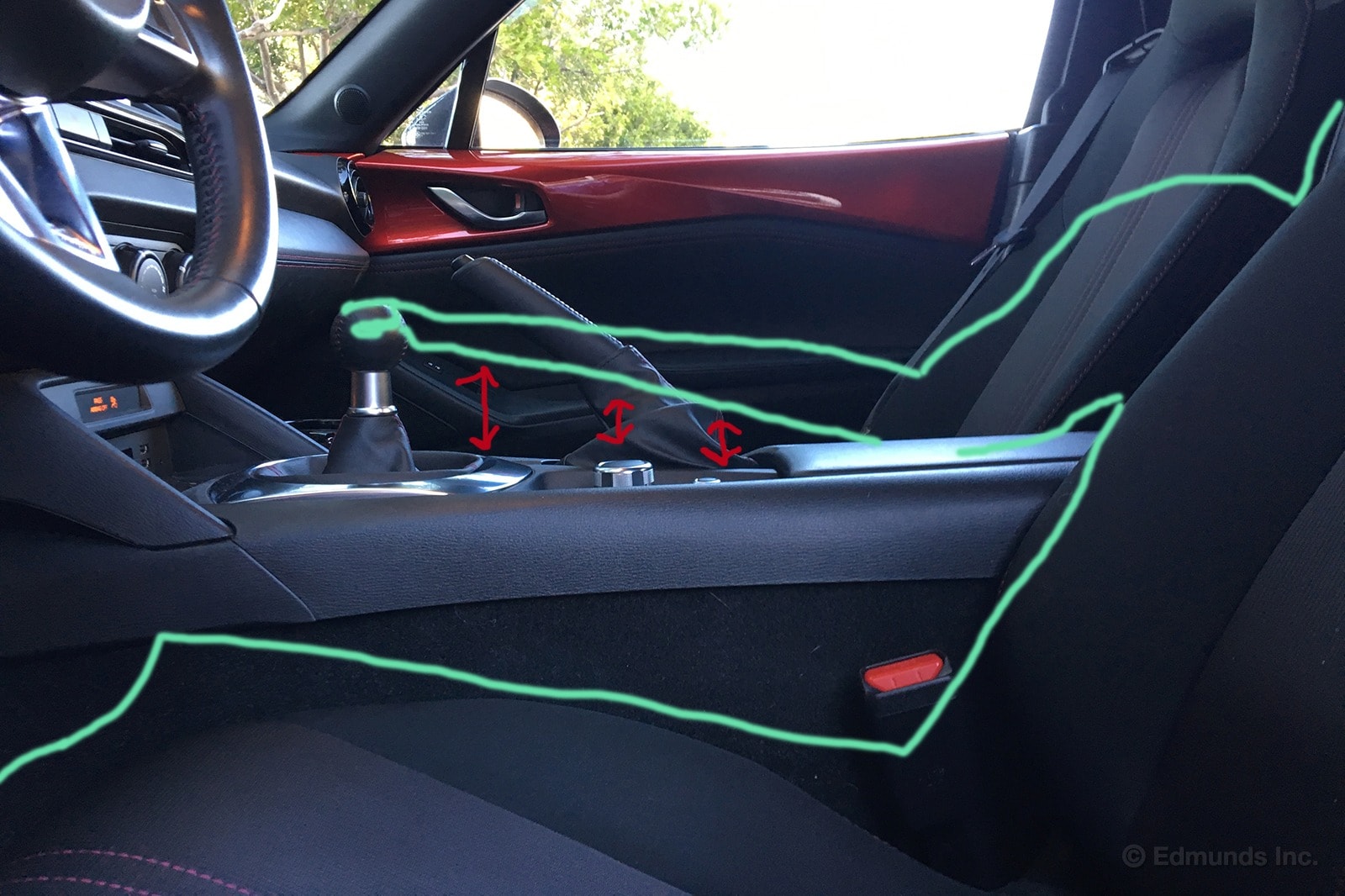
Compare my image to Ron's. See what he did? See what reality is like? In his image, it looks like your arm is constantly atop the control knob and Mark even complains that this is a thing. Says he's hit it accidentally. He must be wearing puffy shirts because, as you can see by my expert illustration, there's actually plenty of space.
Someone else can do the math for actual area, but this is a pretty spot-on right triangle formed by the shifter, armrest and my arm (the hypotenuse!). And when you're done with your hand on the shifter, Mazda gave you a convenient place to put it. Colloquially known as the "steering wheel," it's located shifter-adjacent and feels like it was made to be held.
So while I can knock the Miata all day for its infuriating lack of power, cramped cabin, lawn-chair seats and soulless sound, I've got no complaints with any of the ergonomics. Mazda's real good at knowing how cars work and how people work with them.
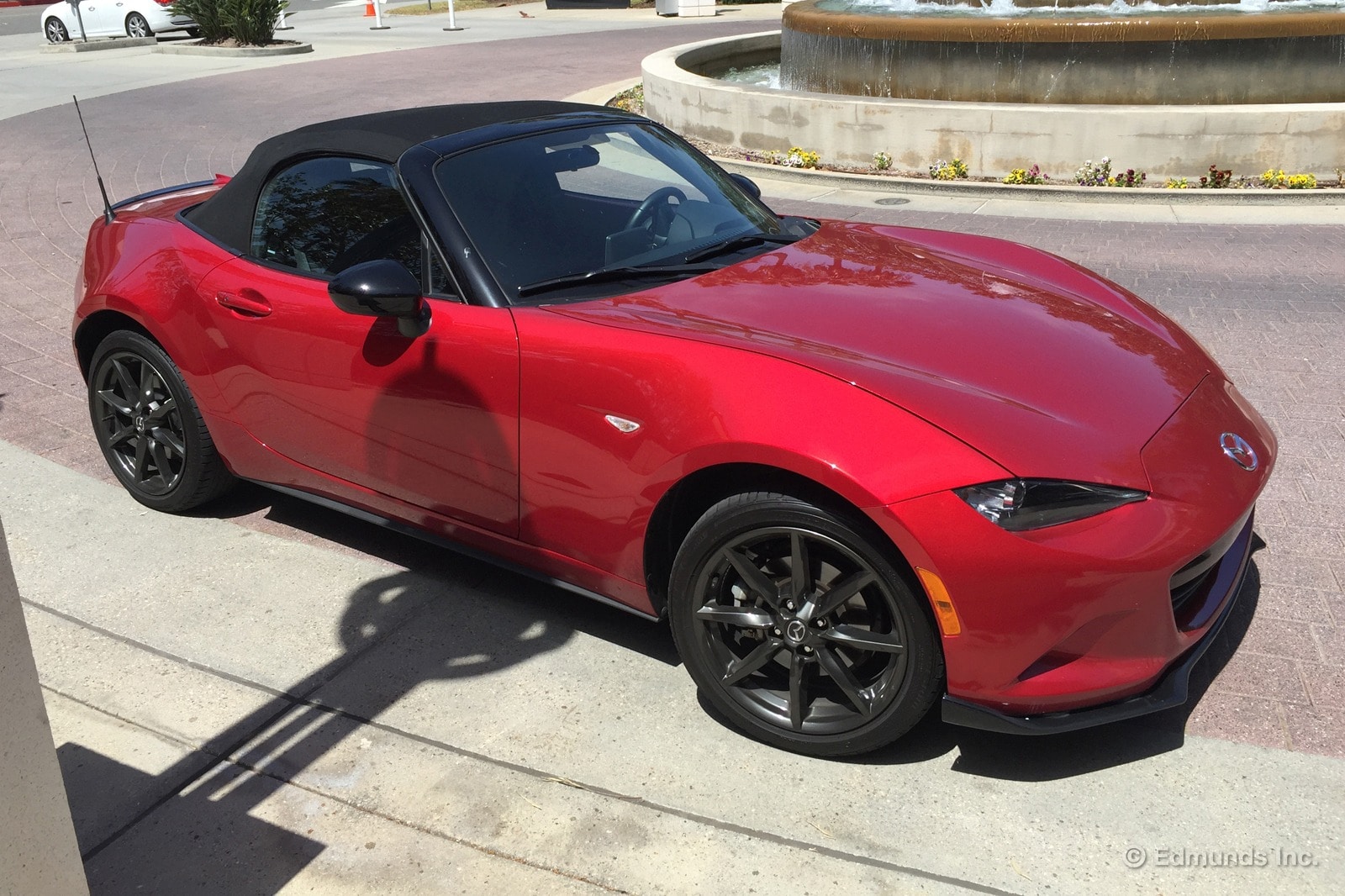
After a few weeks of driving practical, family-friendly cars like the Ford F-150, Volkswagen Beetle, Honda Civic and GMC Canyon, I found my inner child desperate to break free when the weekend signout sheet made its way to me. To my surprise, my prayers were answered as the 2016 Mazda MX-5 Miata was still up for grabs. I only drove it once, briefly, at the beginning of this year when I picked up Phil from Carmax after he sold our long-term 2015 Ford Mustang. Three days to really acquaint with the little red roadster sounded great.
At 6-foot-4, I'm on the upper boundary of people that can fit in the Miata's tight cabin. There's a considerable amount of setup involved to get the seat in the right place. Slam the seat rearward. Get in. Scoot the seat forward. Recline the seat. Move forward a few clicks more. Recline the seat. Angle the seat forward and move back a couple clicks to compensate for the overcorrection I made a moment ago. Wash, rinse and repeat a few more times.
Within two minutes of driving, I understood why people buy this car. The shifter is in a natural position, and the throws are tight. You always know exactly which gear you're in. Steering effort is light but there's plenty of feedback. The ride is also a lot better than its diminutive size and sporty demeanor suggest.
There aren't many negative qualities here that sneak up on you. You get into this car knowing that the quarters are cramped and the trunk miniscule. The only thing that may not manifest on a short test drive is the considerable wind noise at cruising speed. If that's a dealbreaker, you may want to wait for the power hardtop version due for release next year.
None of this detracts from the joy of driving the Miata. It definitely cured me of the Commuter Car Blues. Next time I want to inject some fun into my commute, I'll leave the Viper key on the board and grab the Miata fob instead.
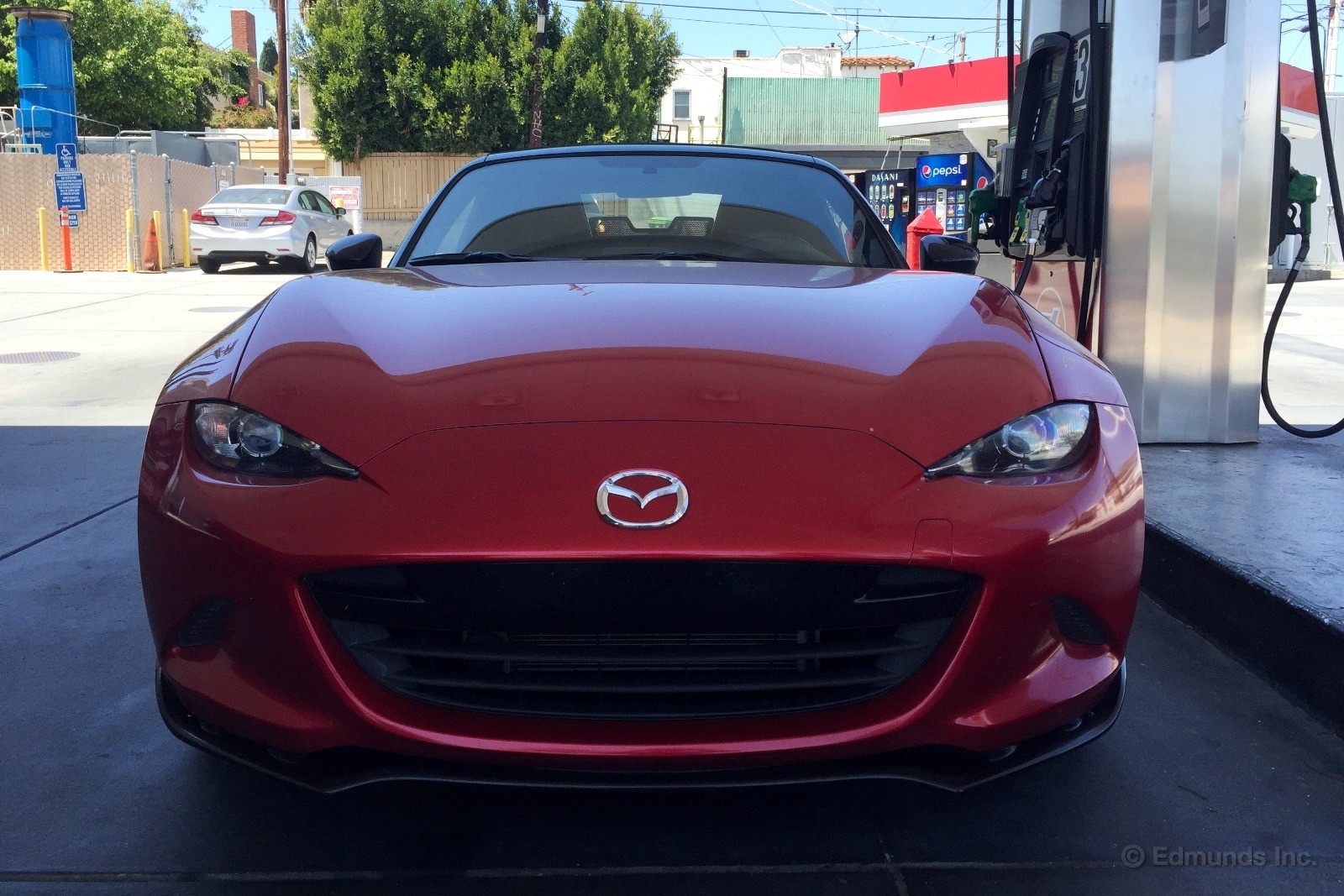
It was business as usual for our long-term 2016 Mazda MX-5 Miata last month. We put 808 miles on the odometer — barely a third of our heroic March total — and filled the tank just three times, with a best tank of 32.3 mpg and a worst of 28.3 mpg.
That puts our lifetime average at 30.1 mpg, down a tenth from the last check-in. I may have cast aspersions on the SkyActiv engine's fun factor, but it sure seems to be delivering on the fuel-economy front.
There, I said something nice about this thing.
Worst Fill MPG: 22.2
Best Fill MPG: 37.5
Average Lifetime MPG: 30.1
EPA MPG Rating: 30 Combined (24 City/34 Highway)
Best Range: 329 miles
Current Odometer: 9,036 miles
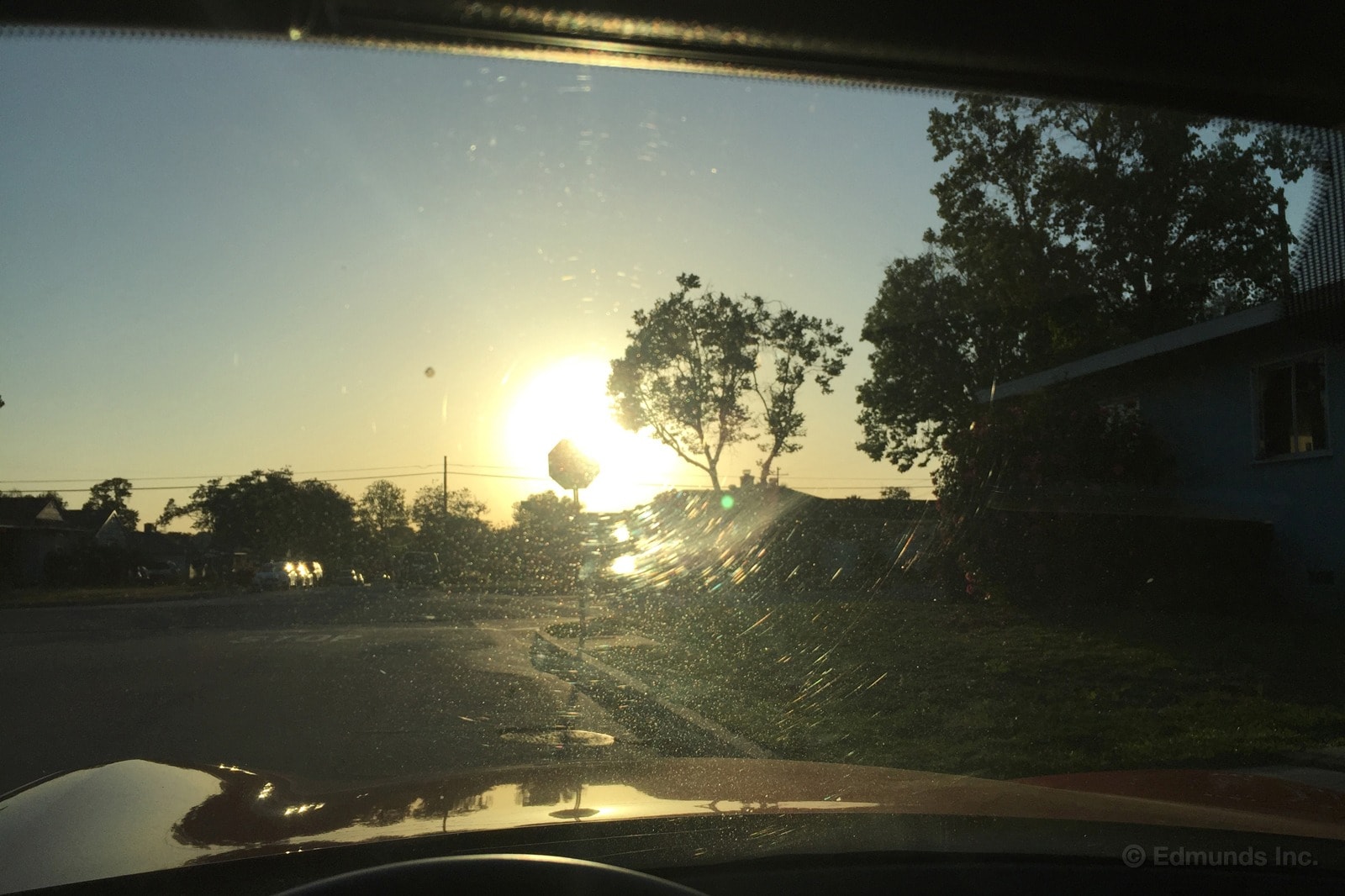
A couple months ago, we were reminded that grit and cars don't play nice with each other. Mark drove the 2016 Mazda MX-5 Miata through a sandstorm, which dulled the paint, dirtied the air filter and damaged the headlight assemblies and windshield. Dan and Mark split the repairs and nearly restored the Miata to its former glory. Since I took on the task of getting the 2016 Honda Pilot's windshield replaced, I volunteered to do the same for the Miata.
I started by getting a price from Safelite's online quote generator, just like I did for the Pilot. Our Miata doesn't have automatic wipers or lane departure warning, options that would have necessitated a more expensive windshield. Even so, the cost of the "OEM-equivalent" glass was $794.95 without tax and disposal fee. Woof!
For kicks and giggles, I also called Safelite to get pricing for a genuine Mazda windshield. After giving me the spiel about how OEM-equivalent glass performs just fine, they promised to call back the next day with a price.
I also called Kevin Gaines, who handled the Pilot's windshield replacement. Kevin does windshield work for several car dealerships, including Browning Mazda in Cerritos, one of the closest dealerships to my house. He said he would call the Mazda warehouse to get a price.
Lastly, I called Santa Monica Mazda, which is located just a few blocks away from the office. We went there to get our 2014 Mazda 3 and 2014 Mazda CX-5 serviced, and they typically did a pretty good job. They perform windshield replacements in-house rather than using an outside contractor like Kevin.
The pieces were all in place. All I had to do was wait for my phone to ring.
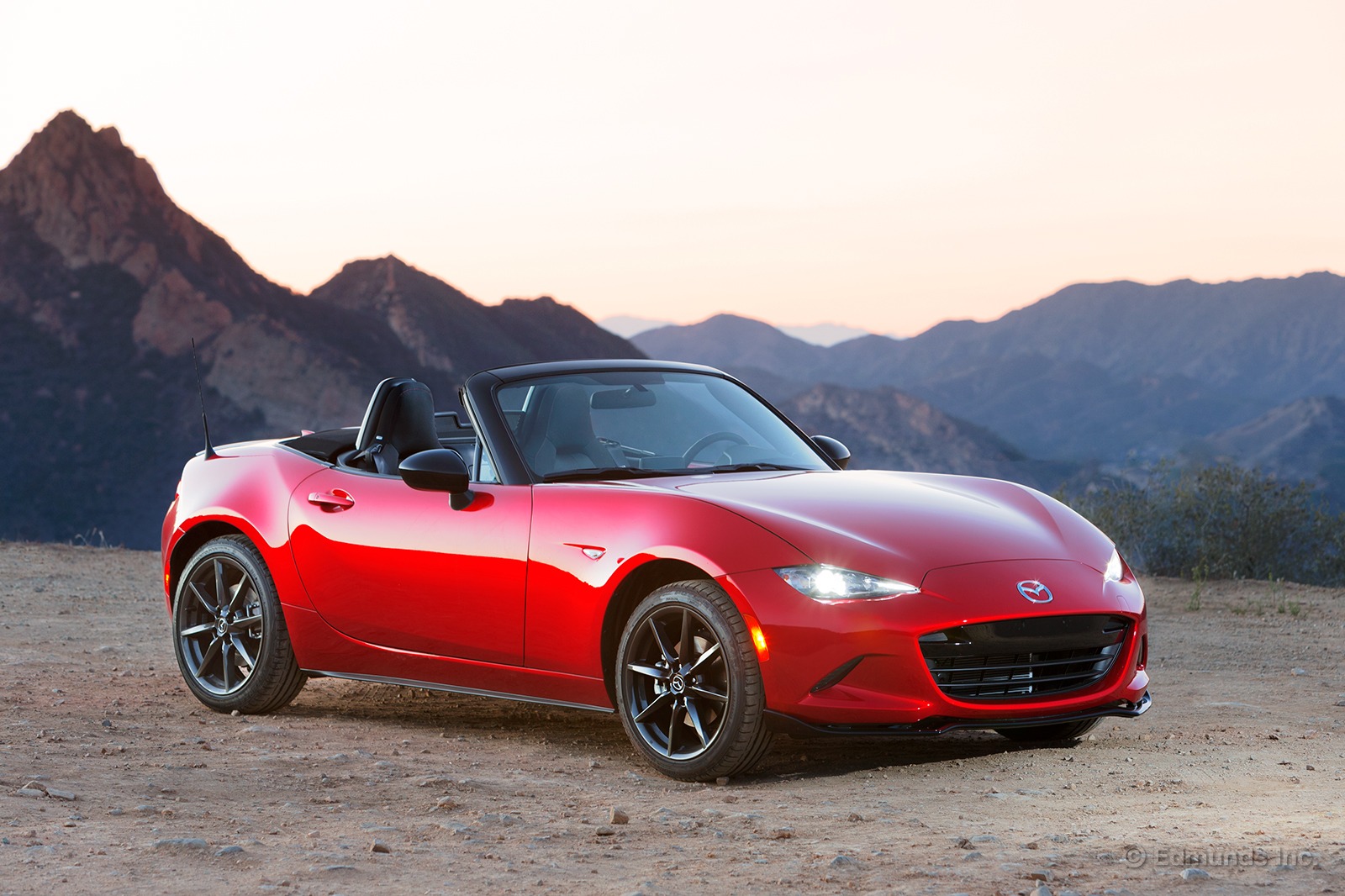
After a sandstorm wrecked the windshield of our 2016 Mazda MX-5 Miata, I started shopping around for a replacement. As I mentioned in my last blog post, I reached out to Safelite, Kevin Gaines of Gaines Glass and Santa Monica Mazda to get pricing. Here are paraphrased conversations with each, and who we ended up going with.
Kevin Gaines, Gaines Glass
Me: Kevin, we like the work you did on the Pilot. Did you mention that you also worked with Mazdas?
Him: Yes, I do windshield work for Browning Mazda's dealerships in Cerritos and Alhambra.
Me: Perfect. Can you get me a price on a windshield for a 2016 Mazda Miata? Just a plain windshield, no lane departure warning or rain sensor.
Him: Sure. Text me the VIN and I'll get on it.
-two days later-
Me: Did you get a price on the windshield?
Him: $750 installed.
Safelite
Me: Can I get a price on an OEM windshield for a 2016 Mazda MX-5 Miata?
Her: Sure, but [gives spiel about how Safelite's standard third party glass is just as good as OEM glass]. Do you still want me to get a price for the Mazda windshield?
Me: Yes, please.
Her: The price is $550.
Me: Just making sure, this is an OEM windshield from Mazda for a 2016 Miata, right? Because the price for "OEM-equivalent" glass on your website is $794.95.
Her: Let me have the guys in the warehouse look for it and make sure we have it in stock. We might have to order it through a dealer, which would affect the price.
Me: Great, thanks.
-the next day-
[Voicemail] Her: If we were to order this glass from a dealership, it would take 2-3 business days to get in. With installation, tax, mobile fee and disposal fee, the price is $628.99.
I wanted to use Kevin for several reasons. He did a good job with the Pilot and I knew I could come straight to him if there was a problem. With Safelite, I would get a couple installers with unknown levels of expertise, and if there was a problem with the service I would get another set of randoms showing up to fix the mistake. I also liked the idea of using a small business that I had a relationship with than installers I did not know. Still, it's hard to argue with a price difference of $120. I gave Kevin another shot.
Kevin Gaines
Me: Kevin, I just got a quote from Safelite. With the Pilot, you guys were right about even on pricing so it was easy to choose you. This time, there's a price difference of $120, and their price includes tax. I'd rather go with you, but I need you to come down on the price. Can you do that?
Him: I can do $700, but I can't go any lower.
Me: Let me talk to the guy that can okay that expense, and I'll give you a call back.
Since Vehicle Maestro Mike Schmidt was on vacation, I called Reese to get his opinion. I told him why I preferred Kevin, and he concurred that it was worth an extra $70 to hold somebody personally accountable if anything went wrong. We estimated Schmidt would probably come to the same conclusion. I called Kevin back and told him to move forward with the repair. I set the installation date for the following Thursday
There's a missing piece in this picture, and that's Santa Monica Mazda. Unlike our previous experiences with this dealership, my service advisor ended up being extremely unhelpful and later, totally unresponsive.
Santa Monica Mazda
Me: Hello, I'd like to get pricing on a new windshield for my Miata.
Him: Yes, that'll be $500.
I knew then that the road ahead would be a difficult one with my advisor. Looking back, it is possible the dealership was deep in the throes of a $500 Miata windshield promotion. Any Miata, any windshield. Five hundred bucks.
Me: Great! That's good for a 2016 Miata, right?
Him: Oh, it's a 2016?
Me: ...Yes.
Him: I'll call you back soon to get you a price for that.
-the next day-
I called my advisor. He was busy at the moment, so I left a message with his coworker. She told me my advisor would call back when he was done.
-the next day
Him: Okay, so the price for the windshield replacement is $500.
Me: Awesome! Just to be clear, this is for a 2016 Miata, correct?
Him: Oooooooh, you wanted a windshield for a twenty sixteeeeeeeen Miata?
Me: YES.
Him: I will call back with that.
-the next day-
Me: How much is that Miata windshield?
Him: Okay, we have the windshield at the warehouse. I have a guy down there who will contact me between 11 and 12 today with a price, and I'll let you know.
Me: Great.
And that was the last I heard from my service advisor. As I write this, it's been two full weeks. He has either written me off or was crushed by a stack of $500 Miata windshields. I'll send my condolences and a tasteful Edible Arrangement to Santa Monica Mazda's service department soon.
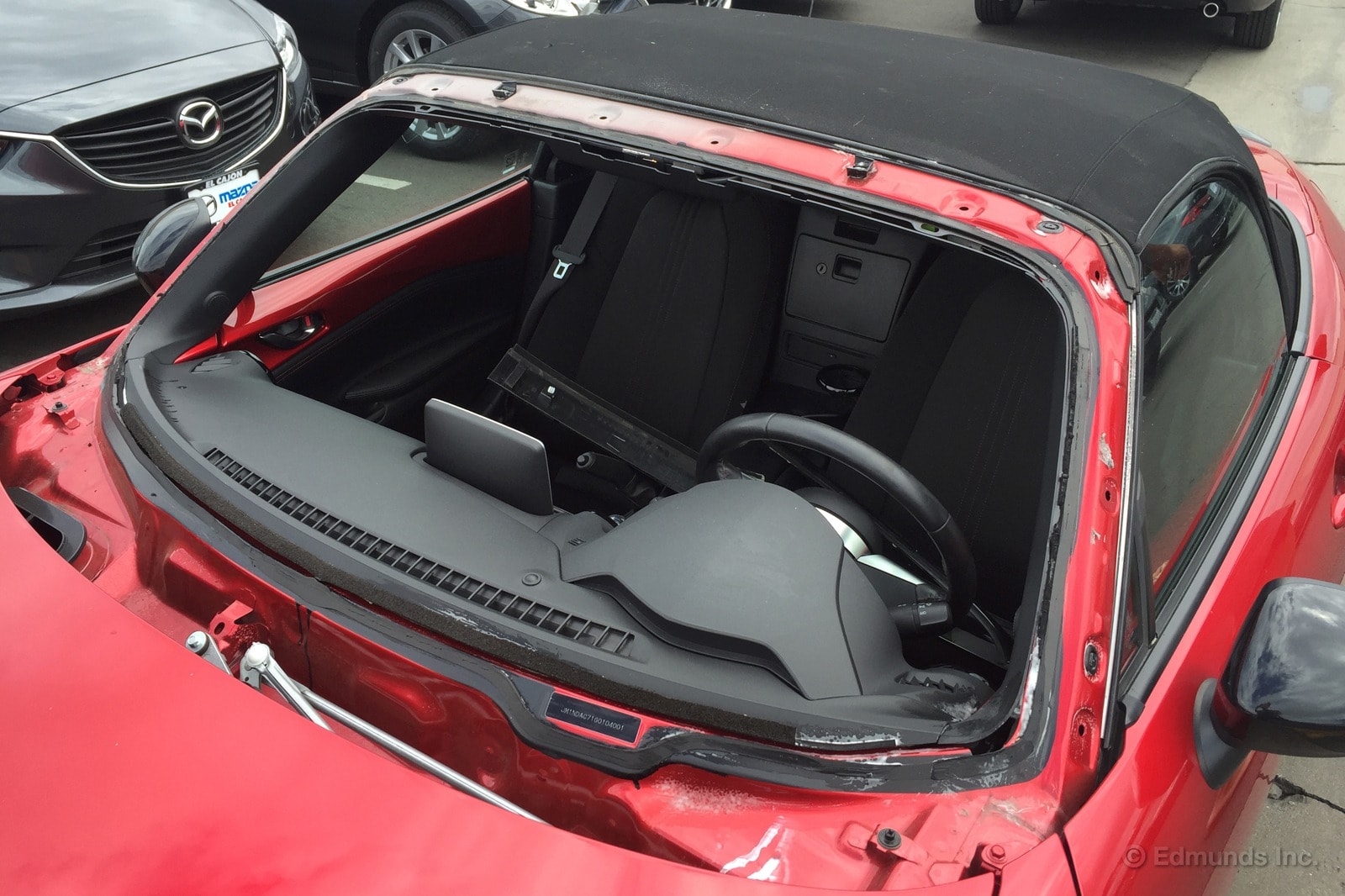
Here it is: the thrilling conclusion of the 2016 Mazda MX-5 Miata's windshield replacement saga. It began when Mark drove through a sandstorm, which caused deep scratches in the windshield. There was a considerable amount of glare coming from the windshield whenever the scratched area was hit with sunlight or light from headlamps of opposing traffic. It quickly became apparent that a replacement was necessary. I contacted several parties for glass quotes, negotiated a price and finally got a new windshield installed. Like the quote process, this final leg wasn't seamless.
As mentioned previously, I made an appointment with Kevin Gaines of Gaines Glass to replace the windshield on a Thursday. I called him on Wednesday to get clarification about a minor detail. He was at Browning Mazda at the time, where the windshield had been delivered. He had seen it and noticed a crack in the glass. A replacement was ordered and was already being shipped overnight from Florida at the time I called. The expected delivery time stood between 10 a.m. and 5 p.m. the next day.
I called Kevin a couple times on Thursday, but I got the same answer every time. The glass was on the delivery truck but a hard drop off time was impossible to predict. At the end of the day, we agreed to meet up for an 11:30 a.m. installation on Friday. Assuming the glass arrived intact, of course.
We convened at the dealership the following morning and Kevin gave the new windshield a clean bill of health. He had the Miata's old windshield removed and replaced in under an hour. To give time for the glass to sit properly, Kevin told me I could wait an hour at the dealer or baby the car home and not go above a reasonable speed for 4-5 hours. I chose the latter, and was careful not to travel above the speed limit on surface streets.
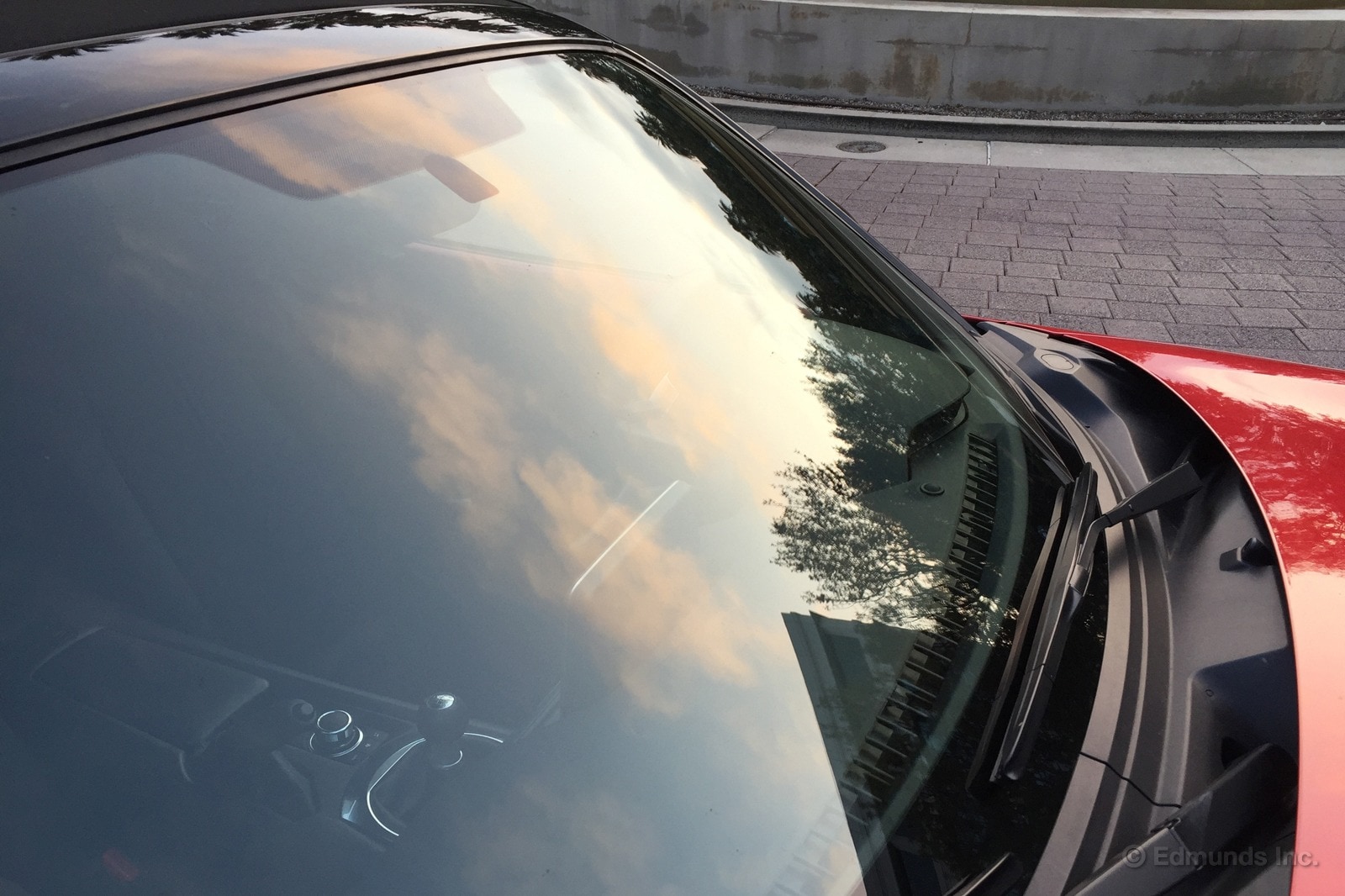
A few hours later, I removed the masking tape that helped hold the glass in place. As far as I can tell, there are no squeaks, rattles or additional exterior noises. With that, the Miata was restored to its former glory.
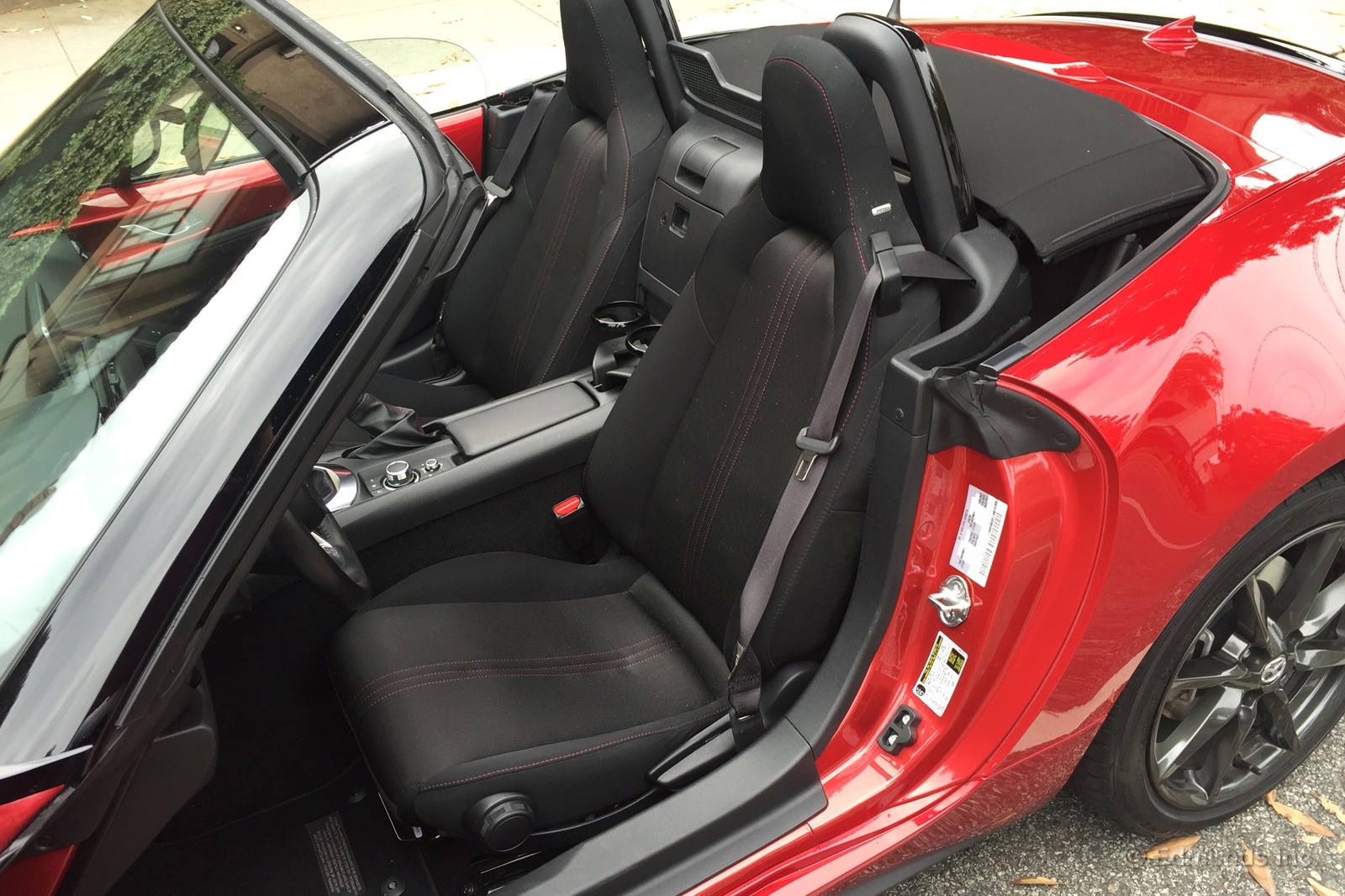
I like our long-term 2016 Mazda MX-5 Miata quite a bit. I've probably had more seat time than anyone else in the office. I've taken it on a couple road trips and the occasional commute, putting several thousand miles on the odometer in the process. With all that time in the driver seat, I think I'm qualified enough to say that the seats in the Miata suck. More than that, I think they're getting worse.
Almost everything about these seats feels wrong to me. It bothers me because Mazda obviously took their time with this car, but the seats feel like an afterthought. I don't know if they're compromised based on weight or the Miata's size, but they feel like an old, cheap, worn-out couch.
The shape is lumpy and not very supportive. The side bolsters are small and don't hold you in your seat around corners. That boggles me considering the point of driving the Miata is to quickly go around corners. The seat bottom is flat and starting to sink. I'm worried what it's going to be like with another 10,000 miles.
This weird, lumpy seat is draped in a cheap feeling and slick looking black fabric. If you look at the photo, it looks like it's already starting to show some discoloration and wear. Up close, the red stitching looks pink in certain places.
As much as I like our Miata, these seats would honestly keep me from buying it. My back and legs start to ache after even short stints in the car. I seem to forget every time I get out, leading me to once again grab the keys. Next time I'll just take the Viper. It may be a little more difficult to get in and out of, but at least those Sabelt buckets fit me well.
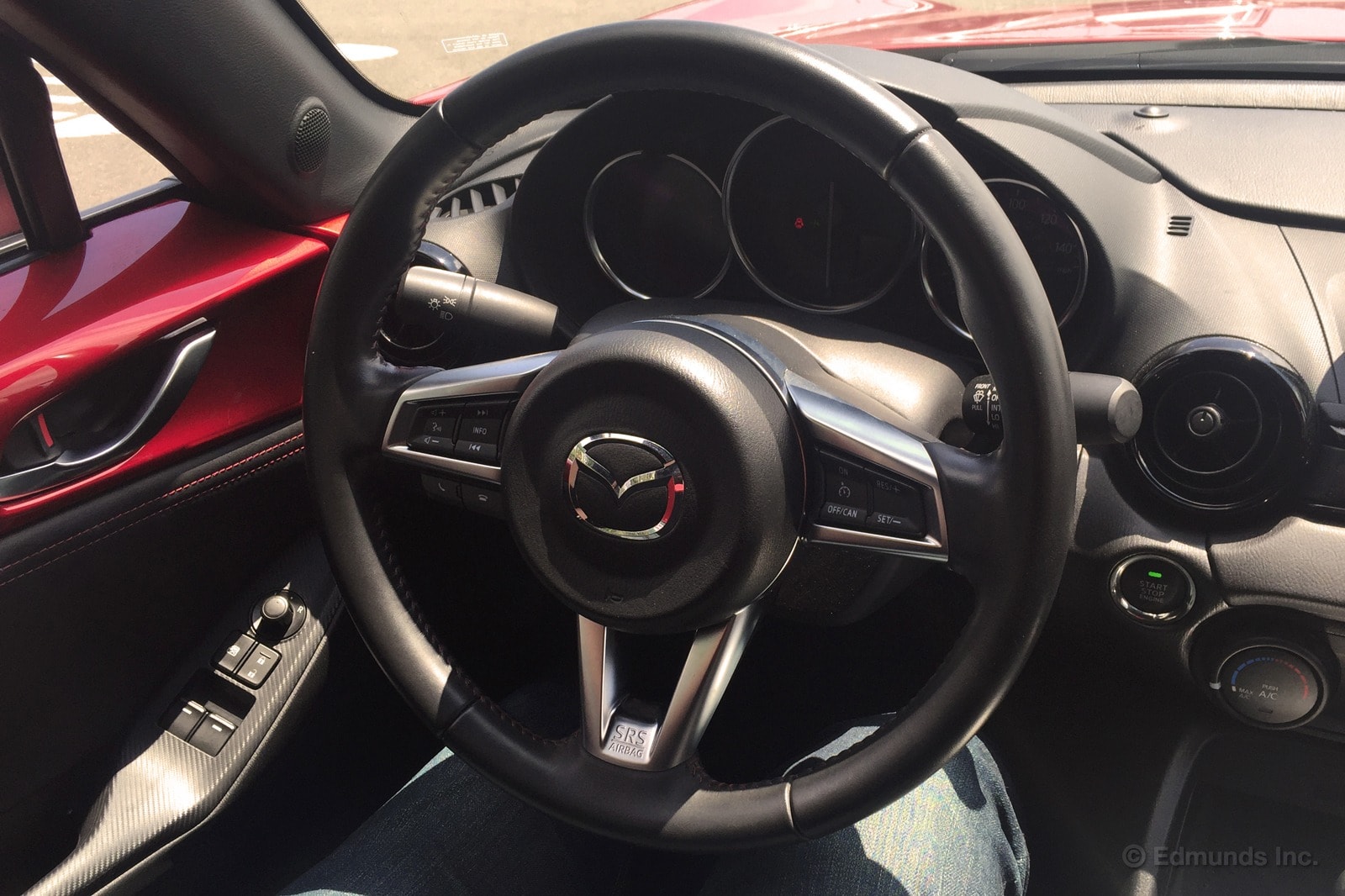
A bad steering wheel can ruin a car for me. It's the input device you interact most with in a car. Steering wheels vary wildly from car to car, and every car calls for a certain type. If the wheel doesn't feel right, it can bring down what is otherwise a great vehicle.
That's not the case for our long-term 2016 Mazda MX-5 Miata. In fact, it might be my favorite steering wheel in the entire test fleet.
Some steering wheels, like the one in our long-term 2007 Dodge Charger SRT8, feel way too big. Dodge apparently agreed and has equipped current Chargers with a much better wheel, even in non-SRT trims. The large wheel in the Charger makes you feel like you're steering a boat. A smaller, better wrapped wheel would help mask its heft.
In contrast, the steering wheel in our Miata is fantastic. The shape, the size and the feel all seem to fit this car perfectly. It's thin, but not old-school thin like our long-term 1966 Chevrolet Corvette. It's not too thick either. This isn't the Viper, which has a big, meaty, non-telescoping wheel. That one fits the Viper since every input requires a deliberate and heavy hand.
The Miata is small and light and the steering wheel feels much the same. It makes the car easy to control, and encourages both subtle and quick inputs. The steering wheel looks and feels great, especially with the contrasting red stitching. The buttons aren't the best, but they aren't horrible either. The spokes are placed perfectly for viewing the instrument cluster. Mazda obviously took the time to make this all work in harmony.
My biggest complaint is that, like the Viper, the Miata's steering wheel doesn't telescope. I have long legs and sit farther back from the wheel than most people my height. Despite not telescoping, the wheel feels well placed.

We haven't been kind in describing the 2016 Mazda MX-5 Miata's cargo capacity. As Editor Frio noted a while back, one of our Cons in this year's review is "limited cargo space inside the tiny trunk," and we go on to explain that the "trunk is rather pathetic...measuring just 4.6 cubic feet. That's small even by roadster standards."
Indeed, while the drop-top Alfa Romeo 4C (3.7 cubes) and Nissan 370Z (4.2) are stingier still, there are a number of compact convertibles that offer more, including the Porsche Boxster (9.9 cubes between the trunk and the frunk) and the Mercedes-Benz SLK (an impressive 10.1).
But what does that mean in the real world? For example, can this relatively minuscule trunk swallow a legitimate cartful of groceries? If I were a betting man, I would have put it all on "nope."
I found myself at Ralph's the other night with a chance to test that hunch.
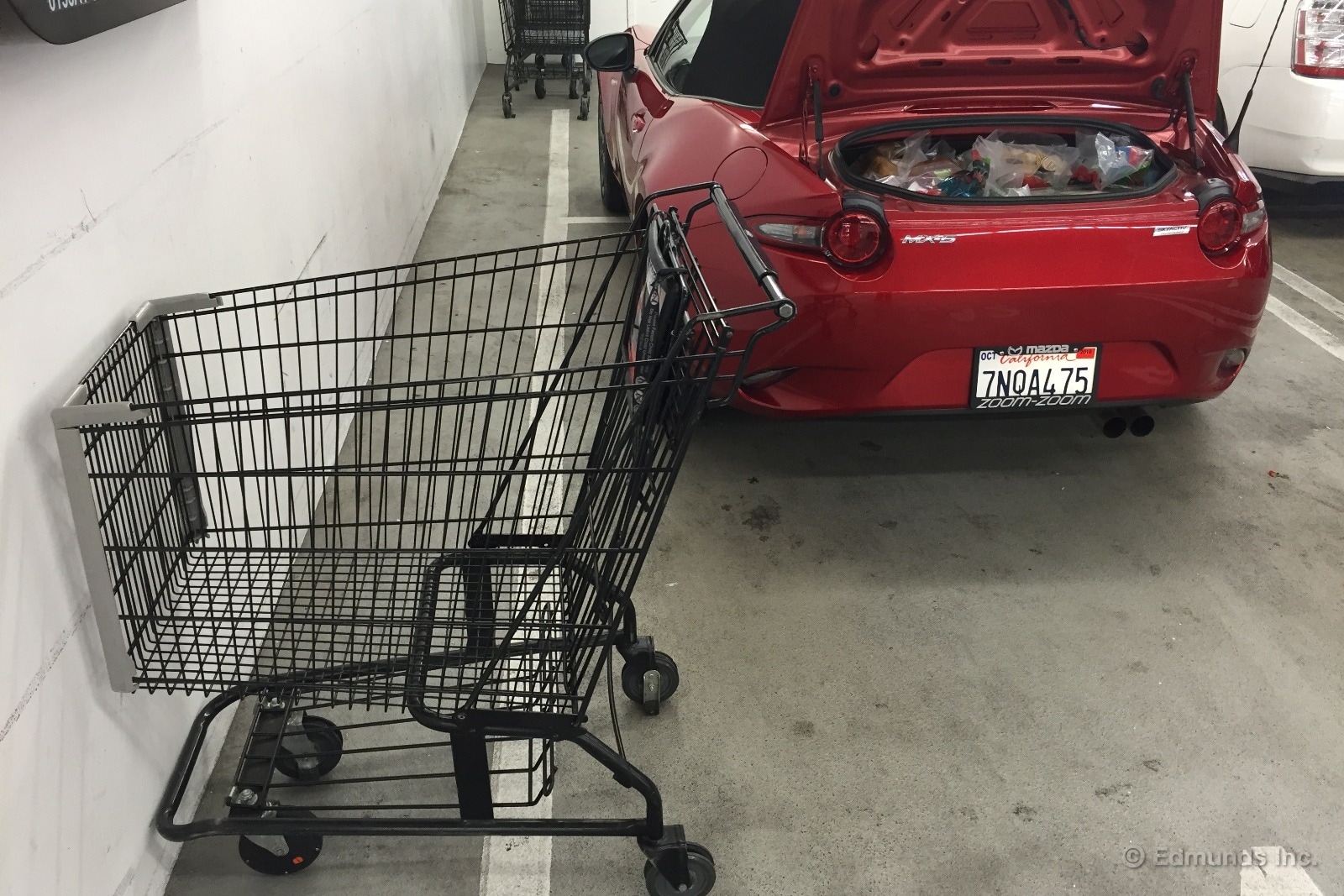
Whoa! Looky there. I didn't get an exact count, but I'd say there were about eight bags in that cart, plus a 12-pack of Firestone's finest. I had to rearrange a few items, but it all fit. Zero spillover into the cabin.
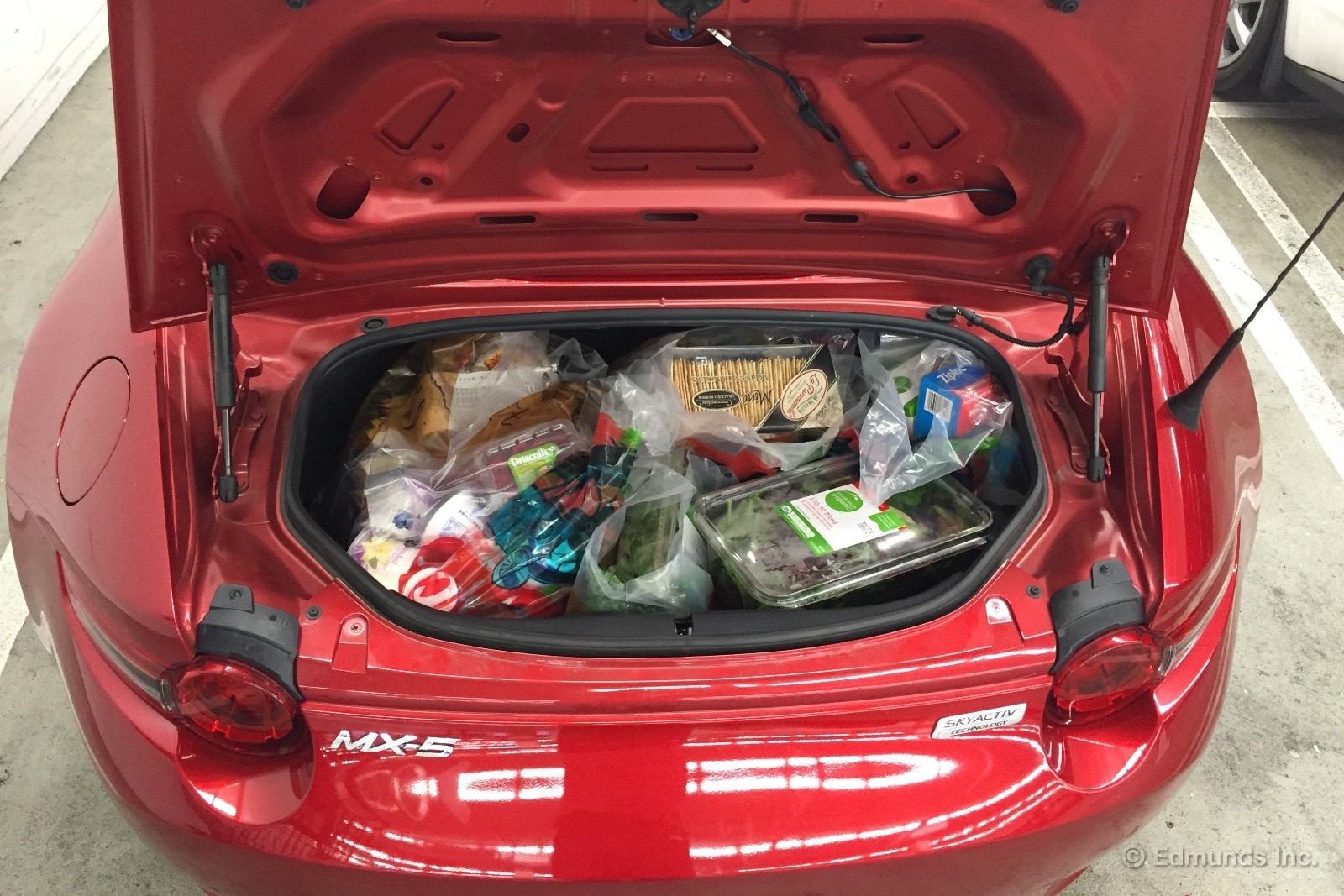
That's a full week's worth of groceries for two people, with the space-consuming box of beer underneath.
Now, golfers and large-suitcase lovers still need not apply, unless they don't mind using the passenger compartment for storage. But in case you're wondering if the Miata's up for a serious grocery run, there's your answer. It sure is.

We drove our 2016 Mazda MX-5 Miata into a sandstorm recently, and during May it went to the shop for a new windshield. The maintenance-heavy month meant its 776-mile monthly total fell far short of our usual 1,700-mile target. But in the meantime we found a few things to scrutinize, such as its seats and steering wheel.
Its 29.5 mpg result for May is just a shade lower than that of the previous month, but its lifetime fuel economy remains unaltered at 30.1 mpg.
Not bad for a car that truly inspires you to fling it around with abandon.
Worst Fill MPG: 22.2 mpg
Best Fill MPG: 37.5 mpg
Average Lifetime MPG: 30.1 mpg (3.3 gallons per 100 miles)
EPA MPG Rating: 30 Combined (27 City/34 Highway)
Best Range: 329 miles
Current Odometer: 9,036 miles
Note: Cars are sometimes refueled well before their fuel tanks approach empty. As such, "best" and "worst" fuel economy entries above are not necessarily the result of an entire tank's worth of driving.
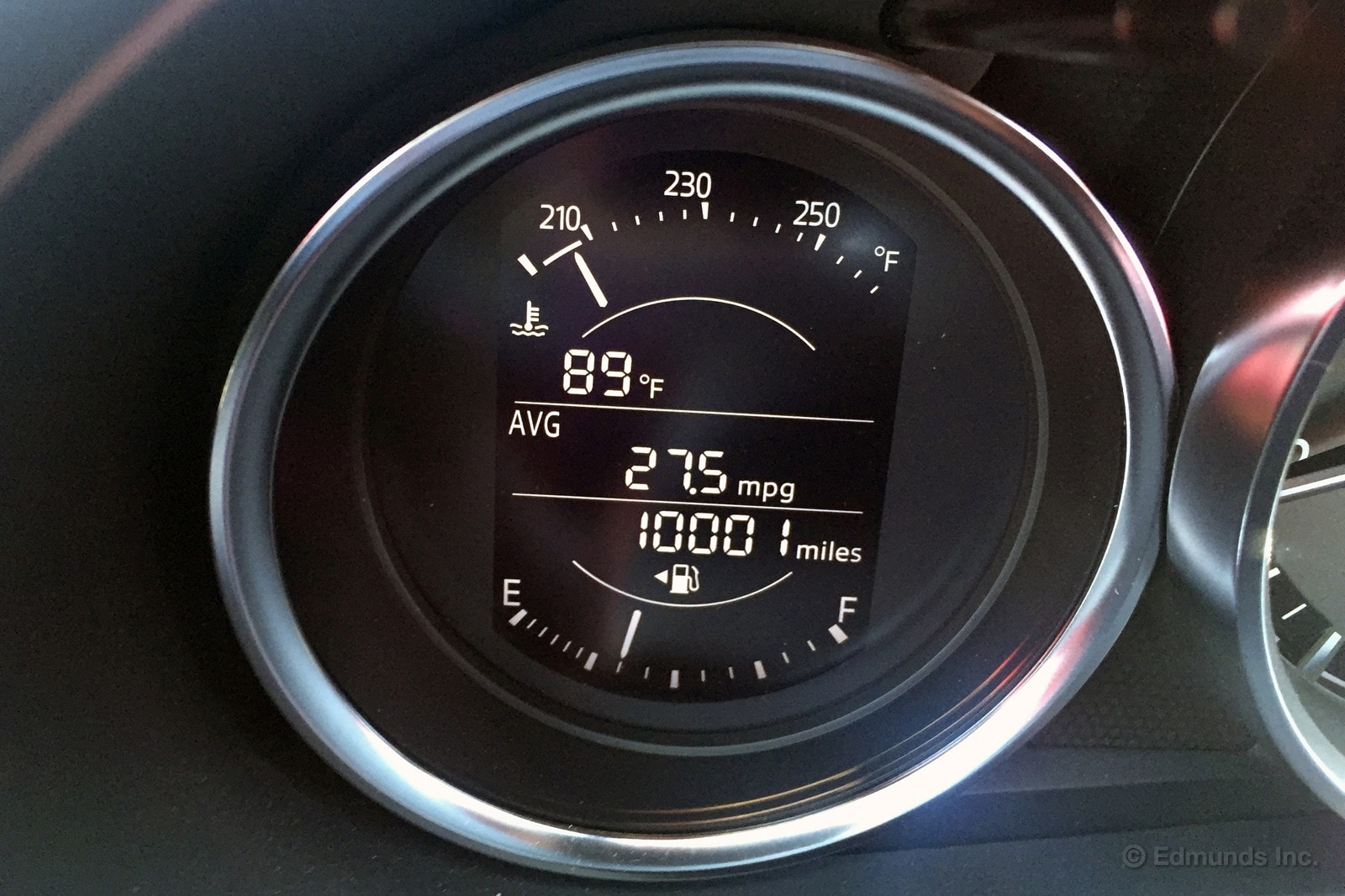
It's taken a little longer than expected, but our 2016 Mazda MX-5 Miata just passed the 10,000-mile mark. Over the last 5,000 miles, it has been the subject of several road trips, including Reese's adventure to Death Valley for the wildflower "super bloom." Mark subjected it to a punishing sandstorm test during another (the Miata lost, by the way). He, Dan and I spent a good chunk of time restoring it to its pre-sandstorm condition, which included an extensive detailing job, air filter replacement, headlight restoration and a new windshield (Part 1, Part 2 and Part 3).
We've fine-tuned our impressions about the Miata over the past few months. As Mark and Reese noted, the Miata's minimal sound insulation causes a substantial amount of wind and road noise at highway speeds. Josh lamented the loss of the rev-happy engine from the last MX-5. JayKav took note of the Miata's extremely easy-to-deploy softtop. And, perhaps most shockingly, Magrath disagreed with several people on staff (myself included, I've also inadvertently hit the controller knob).
The road trips helped increase the Miata's overall fuel economy from 29.1 mpg in the first 5,000 miles to 30.1 mpg overall. That lands us a hair above the EPA's Combined estimate. We don't see that very often for sports cars.
We'll have to increase the number or distance of long road trips, because we're lagging a bit if we hit the 20,000-mile mark before the end of October. Wherever we take the Miata in the next few months, we'll try to avoid the desert.
First Scheduled Service and Unexpected Rear Tire Wear
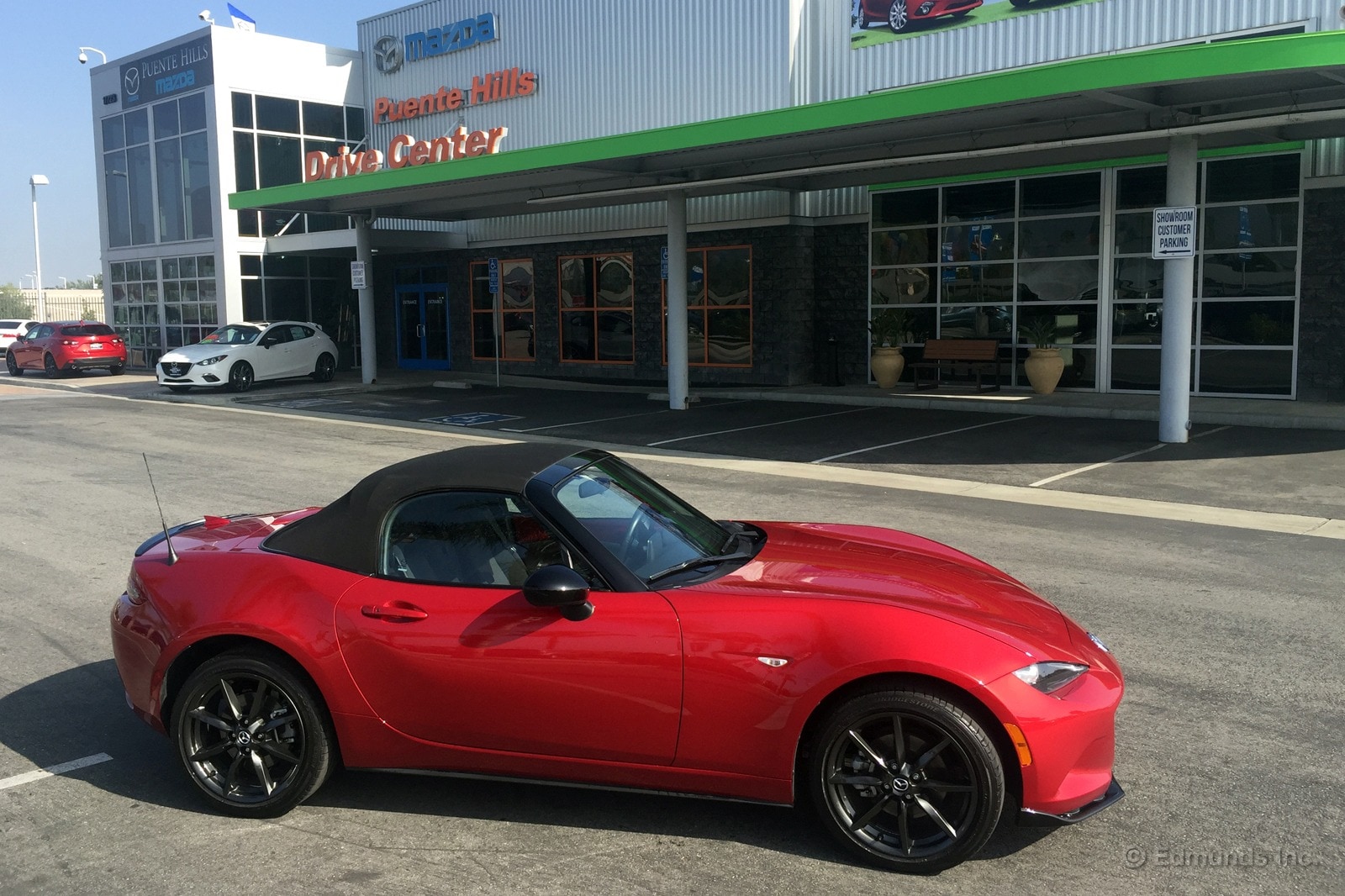
There were two reasons I grabbed the keys to the 2016 Mazda MX-5 Miata last weekend. First, I had just spent a family vacation during which I split chauffeur duties with my stepfather, and I was getting a little stir-crazy to Drive Something Fun. A week in a rental Dodge Grand Caravan can do that to a person. I also had a funky travel schedule coming up, and that weekend was the only time I had free to take the Miata in for its first scheduled service. I knew the Miata was on the threshold of crossing the 10,000-mile mark before I took it home, so I rang up Puente Hills Mazda and set an appointment for 8:00 a.m. on Friday.
Our previous Mazda, the 2014 Mazda 3, had the majority of its maintenance work performed at Santa Monica Mazda. Although it's close to the Edmunds office, I just couldn't bring myself to entrust our roadster to them based on my disappointing windshield quote experience. Instead, I chose Puente Hills Mazda because of its proximity to my house.
I pulled into the service bay at 7:40a.m. and was immediately greeted by a porter. I went inside and met my advisor, who explained the first service was just a simple oil change, tire rotation and multipoint inspection. No upsells, no pressure, and I was chilling in the customer lounge with a cup of coffee five minutes later. The service was estimated to take between an hour and an hour and fifteen minutes.
It was ready in 45 minutes. Part of the quick service was the omission of the tire rotation. The rear tires were wearing faster than the fronts, so the dealer felt there was no need to swap them. Tread depths were measured at 7/32 inches for both fronts and 5/32 for the rears. I informed Mike Schmidt, and we agreed to take a look at the rear tires when I returned to see if there was any noticeable reason why they were wearing faster than the fronts. We would make a decision whether or not to rotate them afterwards.
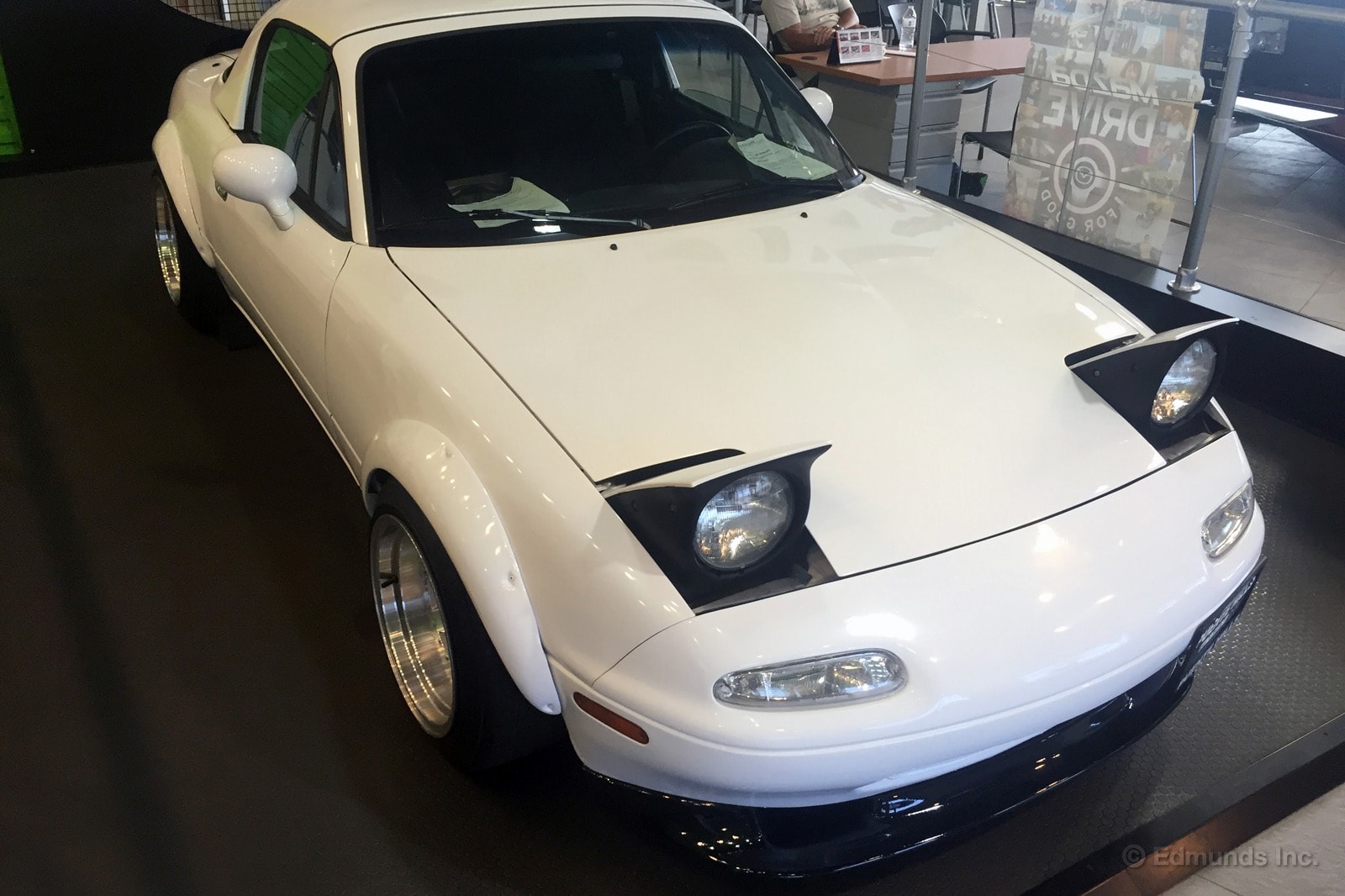
During my time at the dealer, I explored PH Mazda's showroom and found a couple unexpected occupants: a Ferrari 458 and a sporty-looking first-gen Miata. I talked to sales consultant James Futch, who gave me more info. He said the 1992 Miata had some track time under its belt, and the previous owner made a few modifications for track use. I've been to a few dealerships with legacy vehicles in the showroom, but most aren't for sale. It was kind of cool to see that the Miata was up for grabs, although PH Mazda isn't bending over backwards to market it (it's not listed on the dealer's website, but there is an Edmunds listing).
I picked up the long-term Miata after talking to James. Our bill was $25 less because the tires weren't rotated. Here's the full breakdown:
Five quarts 0W20 Synthetic Castrol ($6.18 each): $30.90
Oil filter: $6.50
Gasket: $0.89
Waste disposal fee: $1.25
Labor: $15.00
Tax: $3.45
Total: $57.99
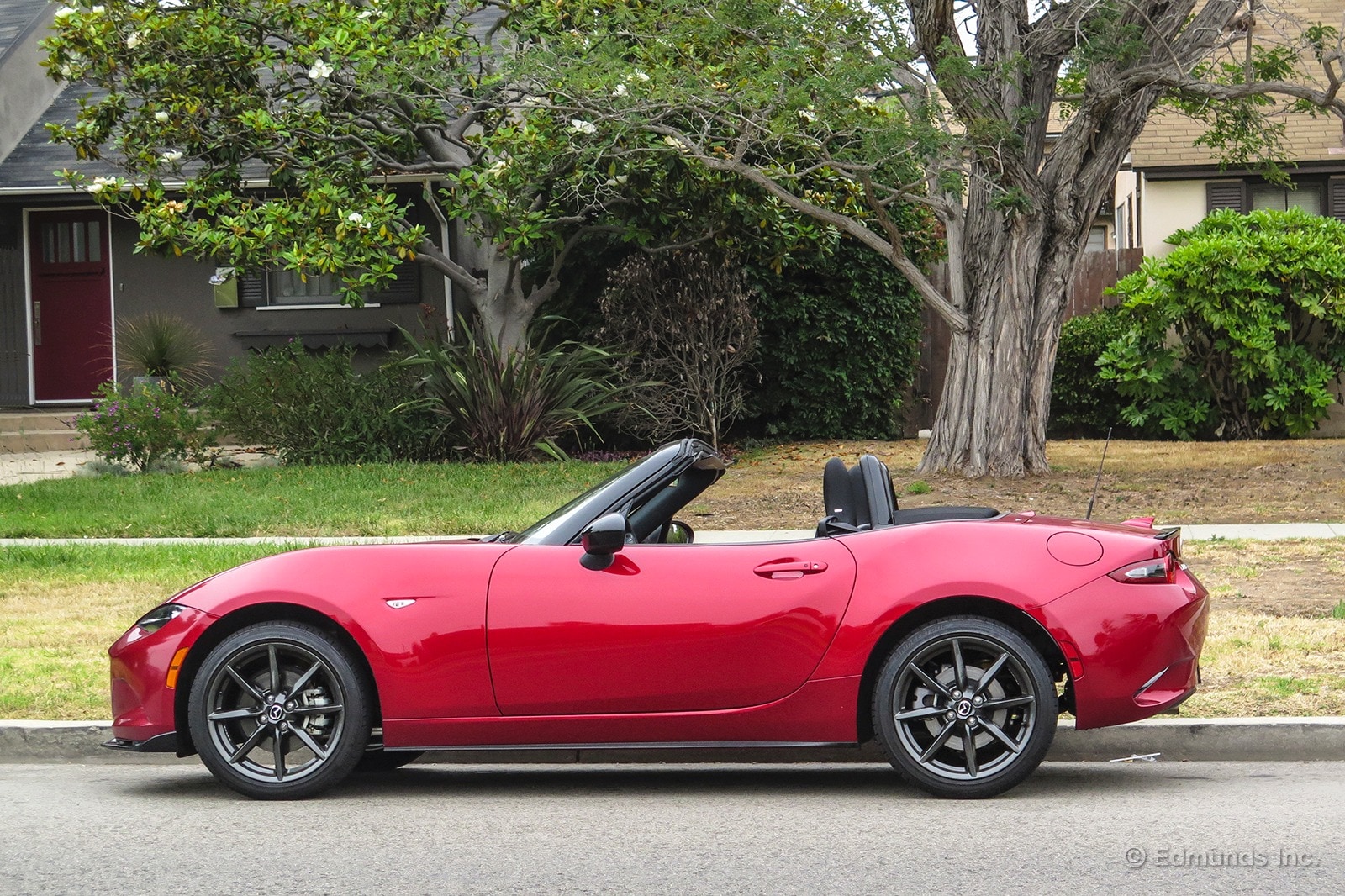
We've already determined that the top on our long-term 2016 Mazda MX-5 Miata is so easy to operate a toddler can do it. Luckily, adults can do it, too. And, since it's a manual-folding top, you can actually fold it down or put it up while waiting for a stoplight to change.
When we put convertibles through instrumented tests at the track, we use a stopwatch to time how long their tops take to fold down and to put up. Our long-term BMW M235i took 21 seconds. Some of the quicker times we've recorded fall in the 10-15 second range. With the Miata, we figured it was a bit silly to do a timed test on something that was manually operated, but for fun, I practiced a few times and went for a personal best.
Pop the latch, grab the handle, push the top back — my best time for all that was 1.4 seconds. Of course, that's my "in a hurry" time, but even if I'm feeling lazy, this top still takes less than 5 seconds to fold down, and just about the same amount of time to put up.
Forget doing it at a stoplight. It's quick enough to put it up or down at a stop sign.
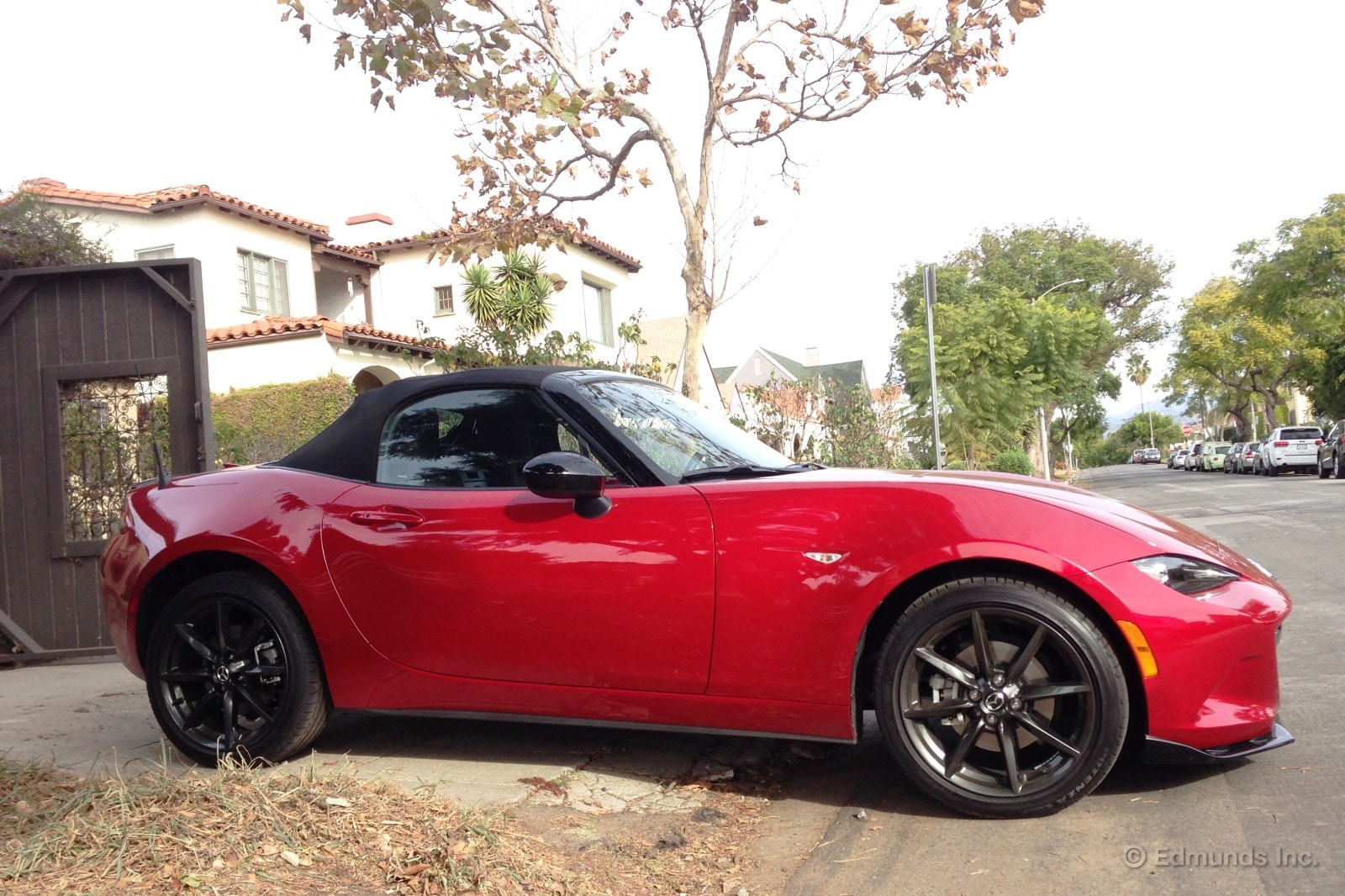
Our long-term 2016 Mazda MX-5 Miata is a diminutive little thing that looks pretty low-slung. It wouldn't be at all surprising if its nose scraped everywhere.
And yet...
I'm here to tell that its nose doesn't scrape everywhere. The Miata's chin has managed to enter and exit every driveway, parking ramp entrance and drainage rut I've thrown at it without suffering the indignity of a scrape.
Now, I've driven plenty of low cars over the years and instinctively drive accordingly, which helps. But even our long-term Chevrolet Volt scrapes everywhere, even over speed bumps, despite my driving style. And every Corvette I've ever driven, too. But not our long-term Viper. Hmm. Maybe this is a GM thing.
Anyway, the Miata's short front overhang is its secret weapon in avoiding the scrape, since its lower chin is still pretty close to the ground. Think "hypotenuse." Short overhangs are more than just pretty design cues, they also have superior approach angles for a given chin height. It's another example of the Miata's cleverness.
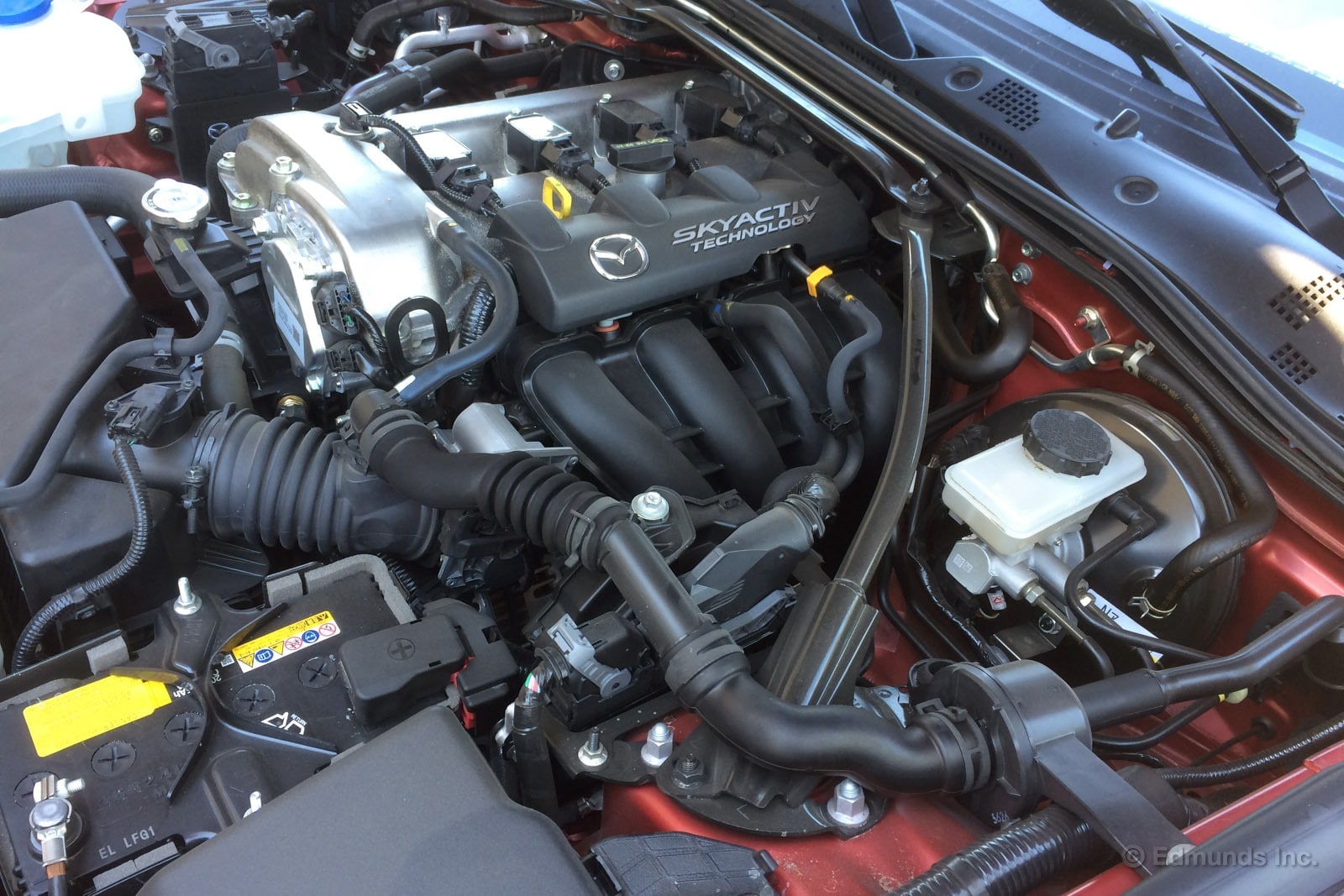
My coworker Josh Sadlier wrote a couple updates about 2016 Mazda Miata that I've been meaning to respond to. In the first one, Josh said he'd rather buy a used Honda S2000 instead of our Miata. In the second, he noted his disappointment with our Miata's "SkyActiv" engine.
In both cases, the crux of Josh's argument is that our Miata's engine isn't special enough because it doesn't deliver an extra rush of power at high rpm or even rev very high to begin with. I originally thought about titling my update "Why Josh is Wrong." But to his credit, Josh soundly defended his arguments. He even explained that his opinion is an "outlier by American standards."
Well, Josh, I guess that puts me in the majority, as I happen to find our Miata's motor pretty enjoyable.
Unlike Josh, I don't have a desire to treat redline as a "shift here!" indicator on every drive. Most of the time in our Miata, I'm just driving around town like I would in any other car. And it's here that the 2016 Miata's improved torque delivery is appreciated. It's not so much the peak output, which is just 8 pound-feet more than before (148 lb-ft versus 140). But having informally compared some engine dynamometer graphs on the Internet, it seems to me that the 2016 engine has a flatter and more usable torque curve, i.e., there's more torque at lower rpm and less of a drop-off past 5,000 rpm. The Miata's roughly 200-pound weight reduction per our testing scales (2,309 lbs versus 2,504 for a 2015 Grand Touring model) is certainly a factor here, too.
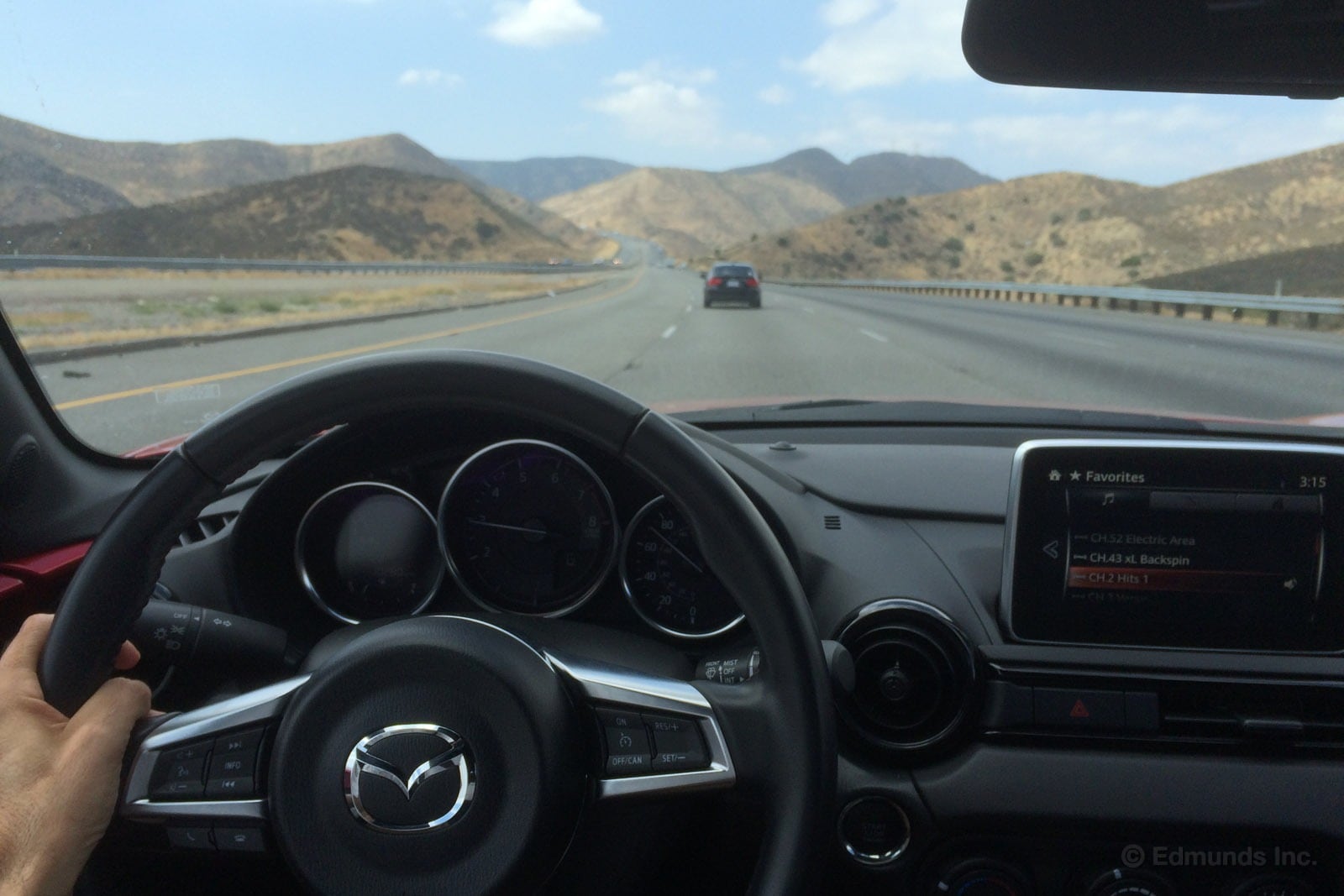
In the real world, the new Miata is quicker, and you don't have to wait until 6,000 rpm to get it. Around town, just mat the gas and Miata scoots forward. On highway mountain climbs, you can likely just leave it in 6th gear the entire time. Sure, you can still work that fabulous shifter if you want. But this time around it's not a requirement. The 2016 Miata's four-cylinder is almost mini V8-like in character.
Not V8-like is its fuel economy. The 2016 Miata checks in with 30 mpg for the EPA's combined fuel economy average. Last year, it was 24 mpg with the six-speed manual. That's real savings going into your pocket each year.
Our Miata's four-cylinder sounds sporty, too. Interestingly, our car has an "induction sound enhancer" feature that comes on manual-equipped Club models, which looks to be that extra tubing ported into the driver side of the firewall (see top photo). My memory isn't good enough to recall whether the sound of our car is better or worse than the old Miata. But I'm enjoying it, for what it's worth.
Josh is correct that the new Miata's 2.0-liter engine lacks that "loves to rev" character. But all things considered, I'm not missing it much.
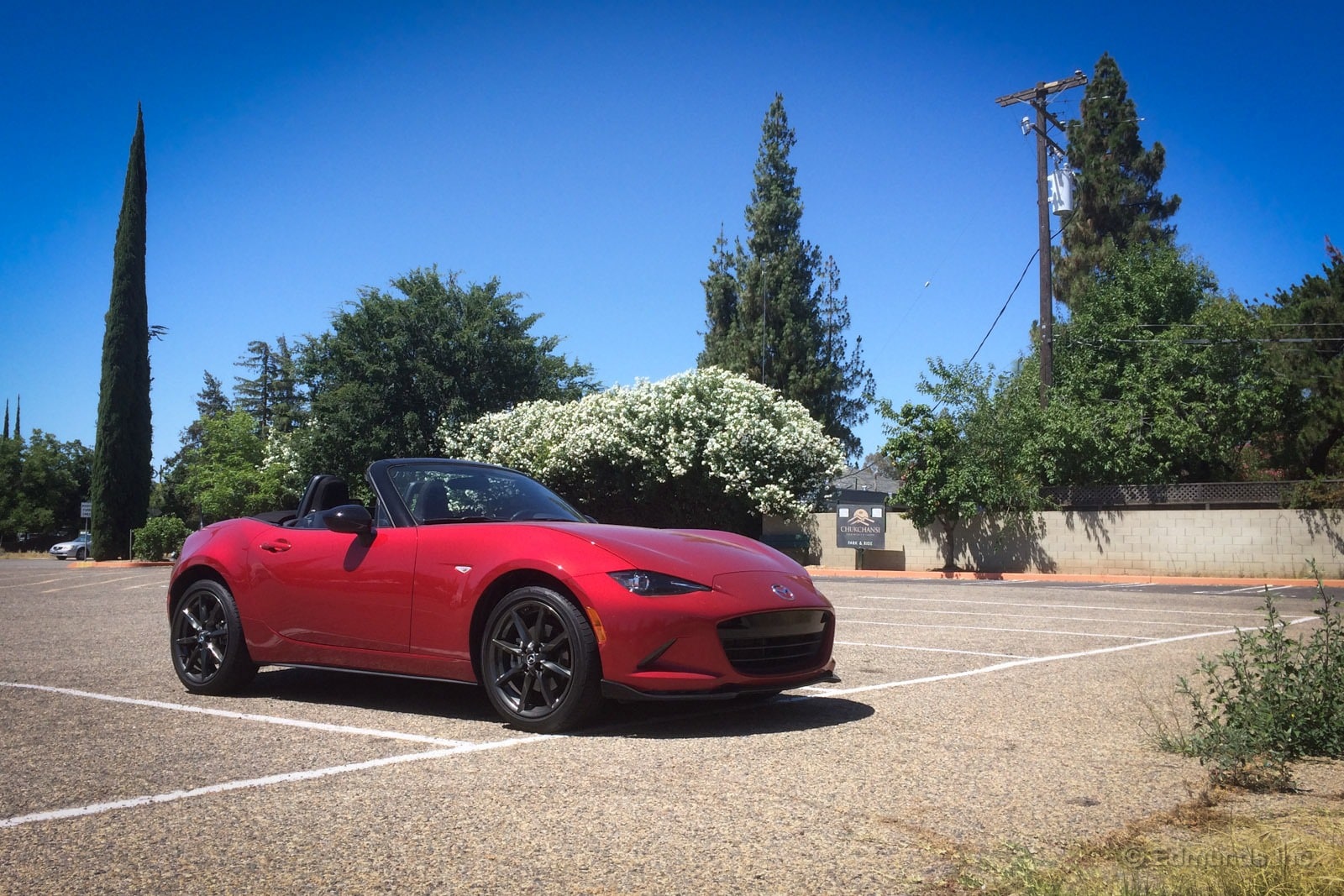
Let's just assume that you've been reading our 2016 Mazda MX-5 Miata updates the past few months and have decided to pull the trigger on a new Miata. Congrats! But the next thing you're going to have to decide on is a trim level. Do you pick the Sport, the Club or the Grand Touring?
Thankfully, Edmunds.com pays me to help you out on such things.
Let's start out with what you get on those three trim levels that Mazda offers for the 2016 Miata. The highlights, as far as I'm concerned, break down like this: the Sport, with a $24,915 MSRP (with the manual transmission, not including destination), comes with the basics. The mid-grade Club ($28,600) upgrades the Miata with some performance enhancements (special suspension dampers and a limited-slip rear differential, but both on manual-transmission-equipped cars only), 17-inch wheels with summer tires and an upgraded sound system with the 7-inch touchscreen interface. Then there's the Grand Touring ($30,065) with leather upholstery, adaptive headlights, heated seats, automatic climate control, navigation and some extra safety features.
My knee-jerk thought on what to get before I really dove into this topic would have been: "Get the Club!" The point of a Miata is to have fun. Therefore, extra performance mods equal more fun. Right? Well, maybe. Our test car is a Club. But remember that you're only getting those mods with the manual transmission. If you pick the automatic, you're left with just the summer tires and touchscreen (yes, there are other Club-based upgrades, but again I'm only covering the big stuff here). That $3,000 to $4,000 step up for the Club isn't to be taken lightly.
Also: I stumbled across an interior picture of a Miata Sport recently and noticed the base stereo setup. It's just a simple dash display with a volume knob and radio preset buttons. Since the touchscreen interface is ergonomically challenged in the Miata, I actually view the Sport's setup as superior despite the reduced functionality. What about the upgraded stereo? I can't imagine missing it much since the Miata's plenty noisy on the highway already.
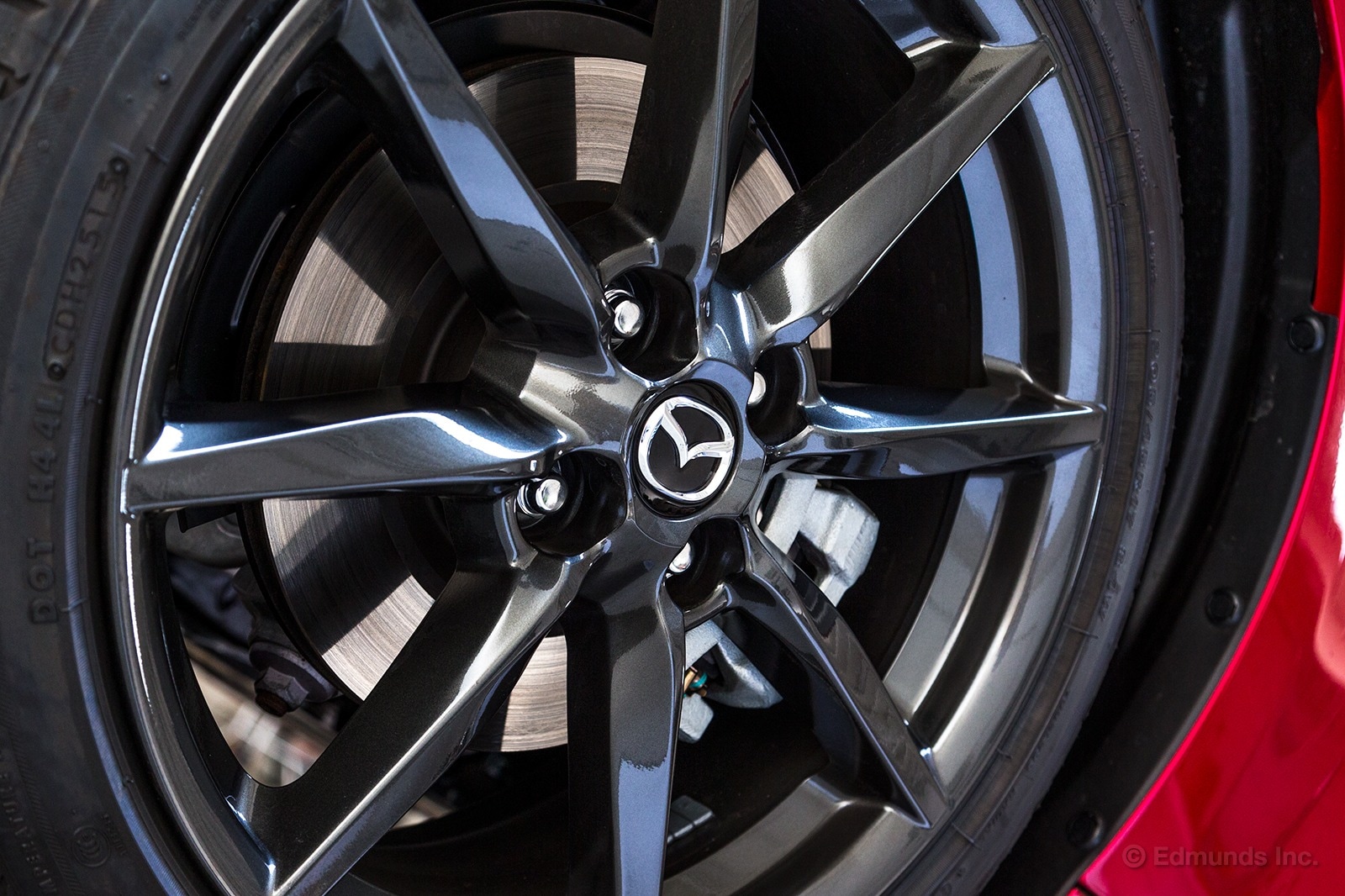
Going back to the Club's manual-only performance upgrades: the limited-slip diff isn't something you're going to benefit from every day, and some people might actually prefer the ride quality of the standard suspension. There is a Brembo brake/BBS wheel upgrade package that's an exclusive option for manual-equipped Clubs. But it's an additional $3,400, and our testing of a Miata with this package didn't reveal a significant braking performance difference during panic stops.
OK, so what about the Grand Touring? It's possible that the GT's leather-trimmed seats are a little more comfortable (I haven't sat in one, so I can't say for sure). Having the safety features might be nice, but I'd argue that the Miata is easy enough to see out of (especially with the top down) that you don't need blind-spot monitoring. I'm guessing the typical Miata driver is also attentive enough not to need lane departure warning, either. Automatic climate control? The base setup works fine. Adaptive headlights? You're already getting LED headlights with the Sport, so this isn't a big upgrade.
Another interesting point of discussion might be the upcoming 2017 Miata RF ("Retractable Fastback") and the Miata's Italian doppelganger, the 2017 Fiat 124. But for this update, I'll stick to 2016. And for that, I'd recommend the Sport. Keep it simple and keep it affordable, friend.
As a wise staffer who used to work here used to conclude, "tell me why I'm wrong."
Top 10 Qualities You'll Like About The Miata
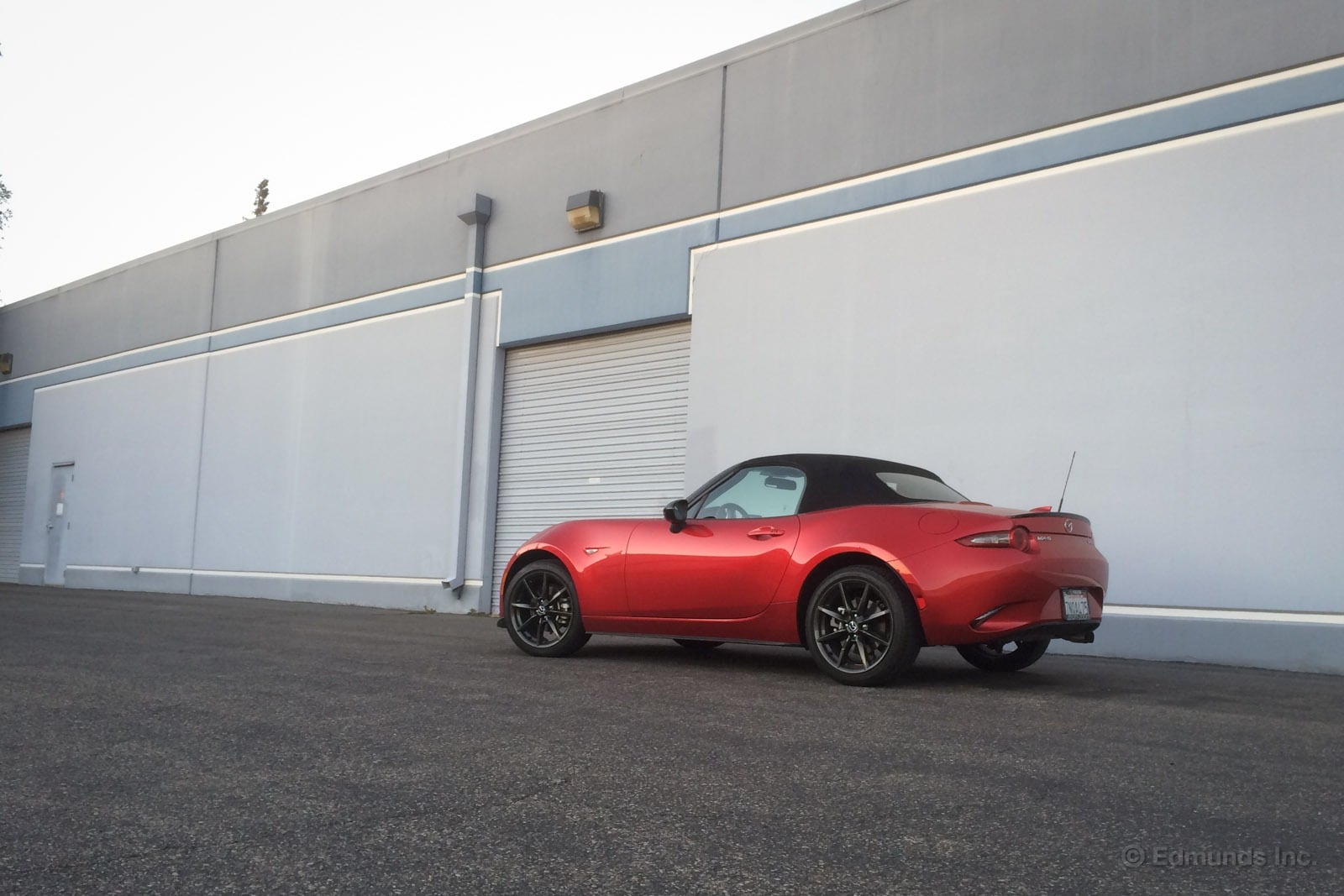
Originally, I planned on writing a list of my top five favorite things about our 2016 Mazda MX-5 Miata. But it quickly became obvious that I was going to have trouble choosing just five. Enter the Top 10.
1) Nimble low-speed handling: You don't have to have the hammer down to have fun in the Miata. Even corners around town can become virtual road course turns for you to pretend you're Lewis Hamilton.
2) Slick manual transmission shifter: More people would buy manual-transmission cars if all shifters were as enjoyable as this. It has a solid, mechanical feel but is also precise and easy to shift quickly. (Here's why.) You'll feel like you're more involved with the car.
3) Distinctive styling: I really like the look of the latest Miata. The tight and muscular styling makes it my favorite of all four generations. The Soul Red paint looks great at sunset, too.
4) Easy top operation: It's a one-person operation that even a four-year-old can do. Opening a soda bottle is harder.
5) High fuel economy: So far we're getting 30 mpg lifetime in our manual-equipped Miata, which matches what the EPA says to get in combined driving. Our drivers aren't exactly light-foots with this car, either.
6) Quick acceleration: You could make a strong argument that the 2004-'05 Mazdaspeed Miata still represents the pinnacle of Miata power, at least direct from the factory. More than a decade later, the 2016 Miata can't match the Mazdaspeed's rated power (155 horsepower versus 178 hp) but the new Miata is actually the quickest Miata yet.
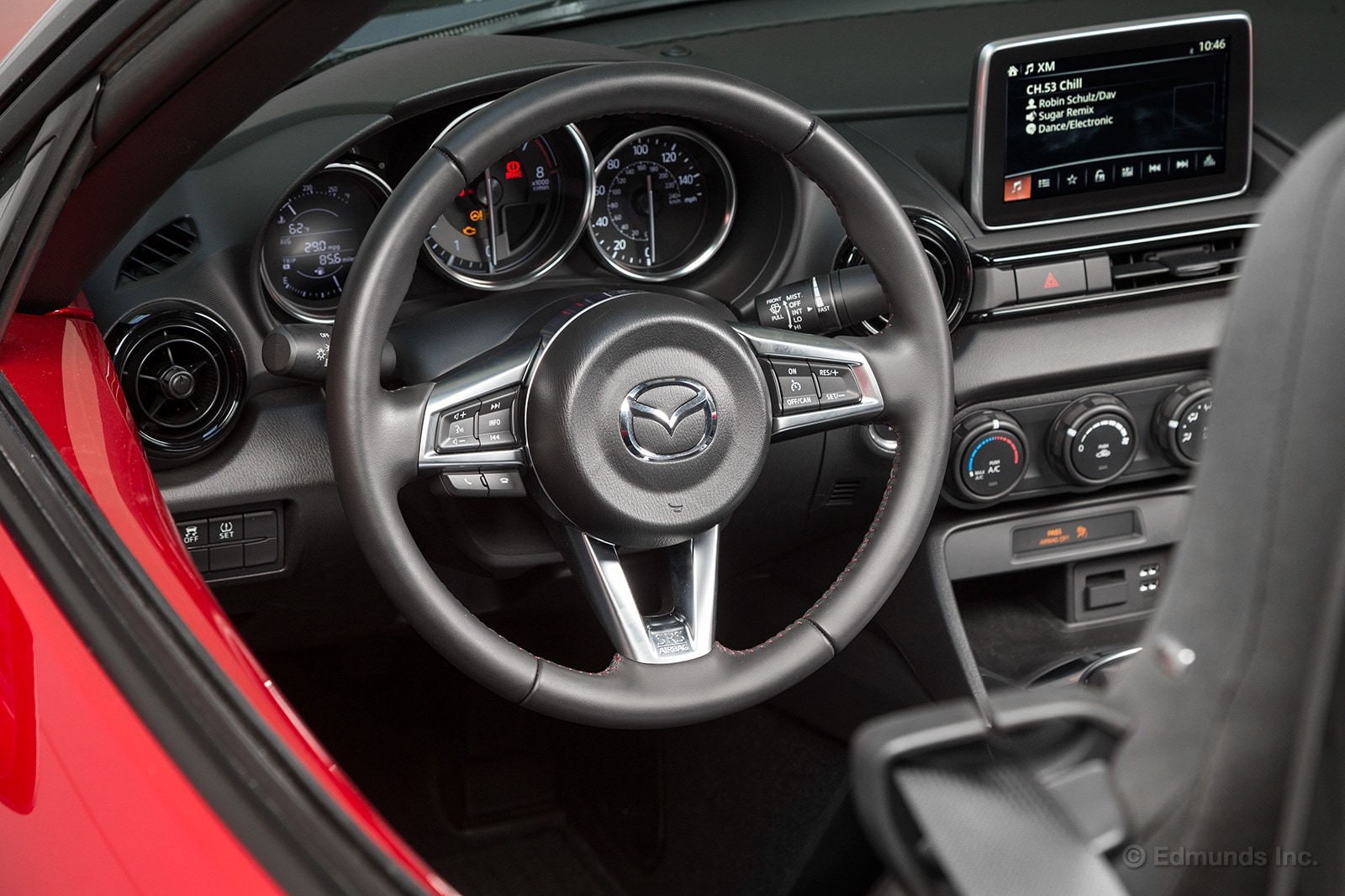
7) Intimate cabin feel: While comfort can be an issue in the Miata, the close proximity of all controls to your reach is gratifying no matter how tall or big you are.
8) Bright LED headlights: Every Miata comes with LEDs. They give you a good view of the darkened road ahead, plus that premium headlight look when other motorists are checking out your car.
9) Easy to park: The Miata's petite size makes it a cinch to zip into parking spaces or wheel around for a U-turn.
10) The Miata ownership experience: You buy a Miata because you like to drive. It's not a Honda Accord, Ford F-150 or Toyota Corolla, and you're putting up with some significant trade-offs because you desire more than A-to-B transportation. Any time you see another Miata driver, you know that he or she feels the same way.
A Touchscreen That's Not Always A Touchscreen
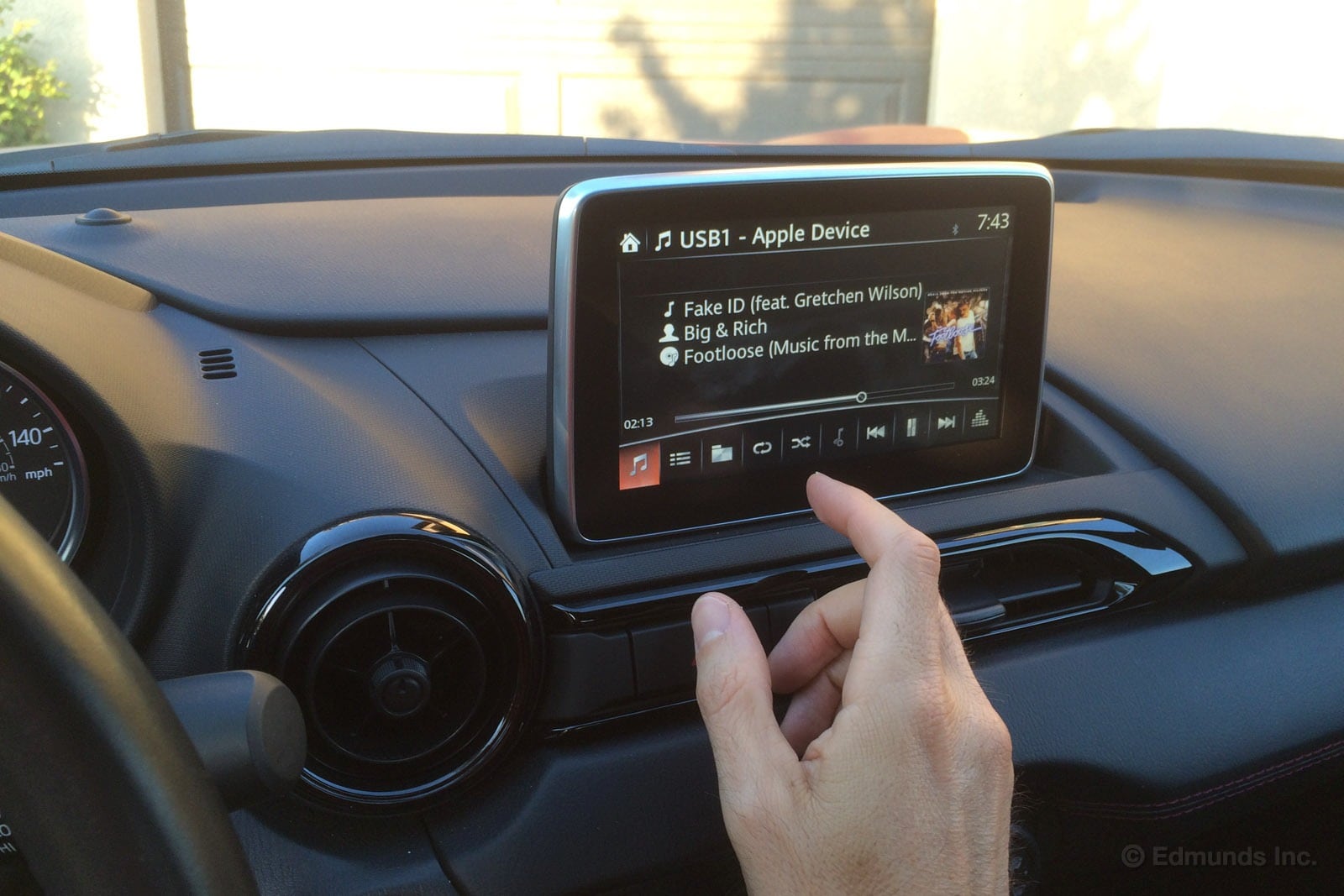
Mazda graciously gives you two ways to interact with the 2016 Miata's optional infotainment system: the 7-inch touchscreen, proudly perched atop the dash (not unlike that Samsung 70-inch 4K Ultra HD TV you just put in your living room) and the controller knob-and-button array located on the center console. Redundancy is good, right? There's just one problem. Only one of these methods works while you're driving.
When you're on the move, the touchscreen interface is disabled. The only way to operate the infotainment system is through the controller knob. This, as we've pointed out previously, is in a less-than-ideal location. Only when you come to a stop can you stab the screen with your finger to get what you want. It's unfortunate, as the Miata's intimate cabin puts the screen in a location that's super easy to reach and could very well be the preferred method of operation for a lot of drivers.
I'm also amused with the Miata's on-screen warning at startup: "WARNING! Distraction may cause accidents. Do not operate while driving. Always concentrate on driving and obey Traffic Regulations." That's a helpful tip. But why do I need a warning if you won't let me operate the thing while driving to begin with?
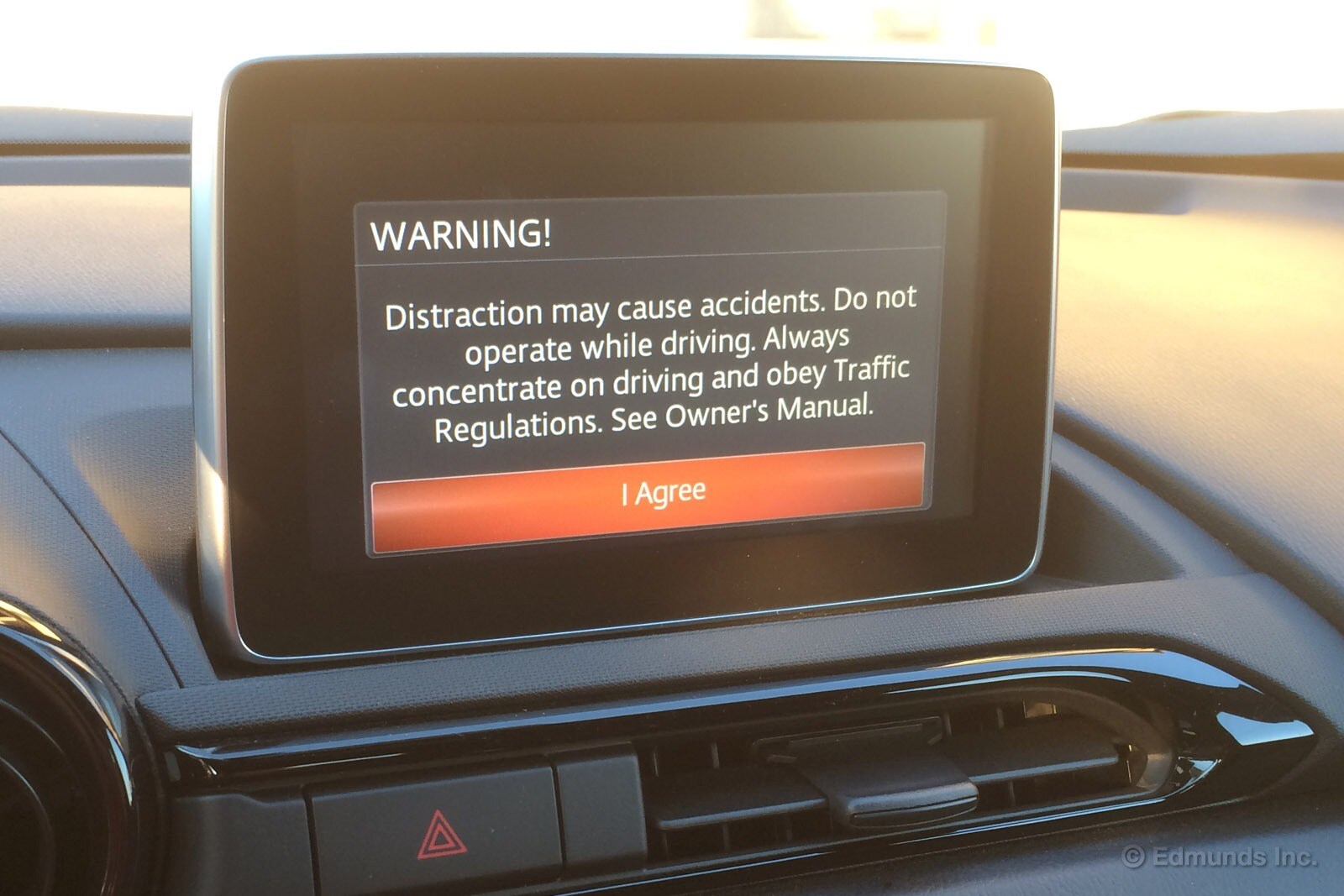
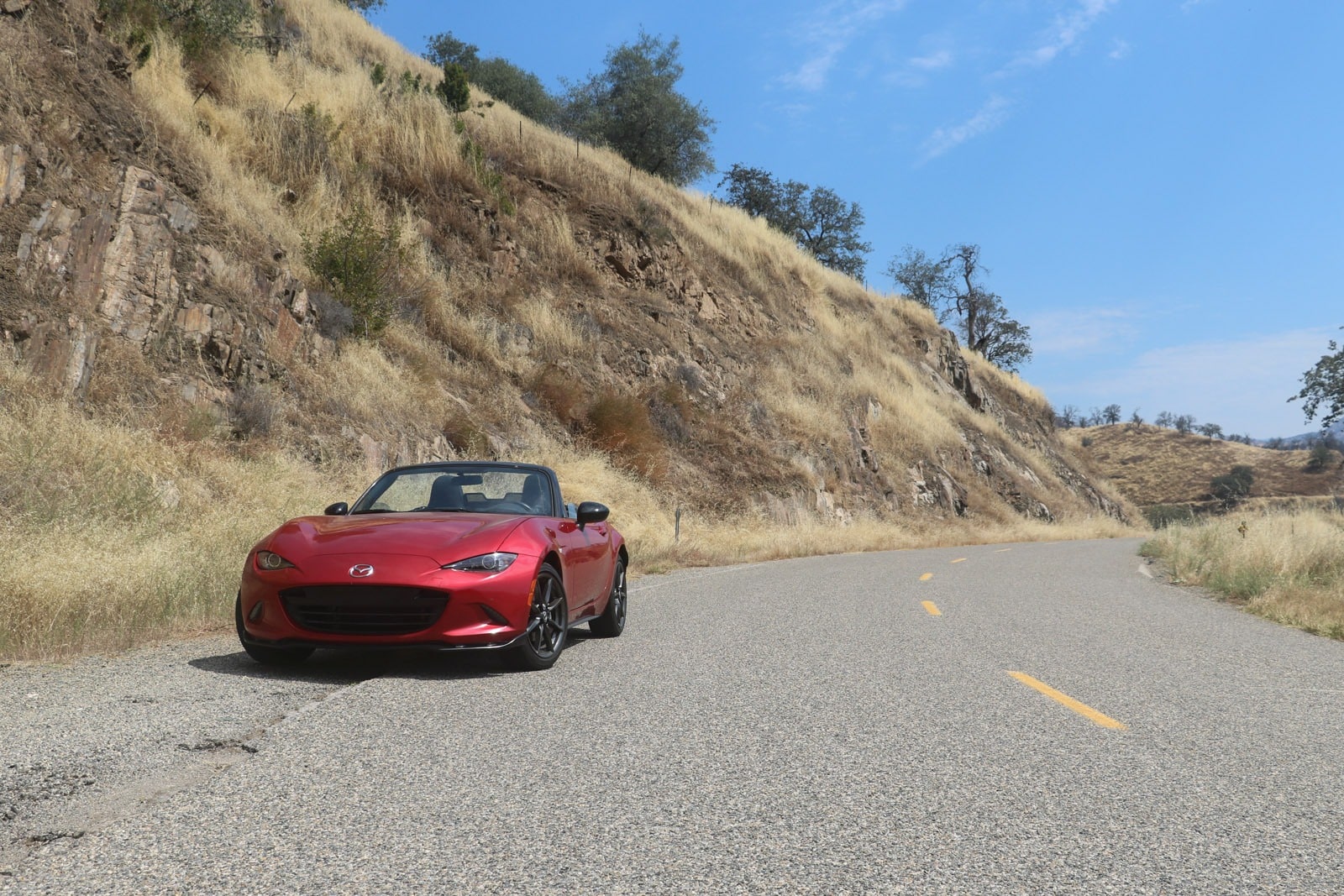
Should you find yourself driving a 2016 Mazda MX-5 Miata on a road that twists and turns like a politician avoiding an inconvenient question, you're going to have fun. Lots of fun. I guarantee it, just like the suit guy with the beard does, but without the "like the way you look" part.
Our long-term Miata weighs about 2,300 pounds. This is freakishly light weight for a modern car and the way the Miata drives because of it is something that you just don't get to experience very often.
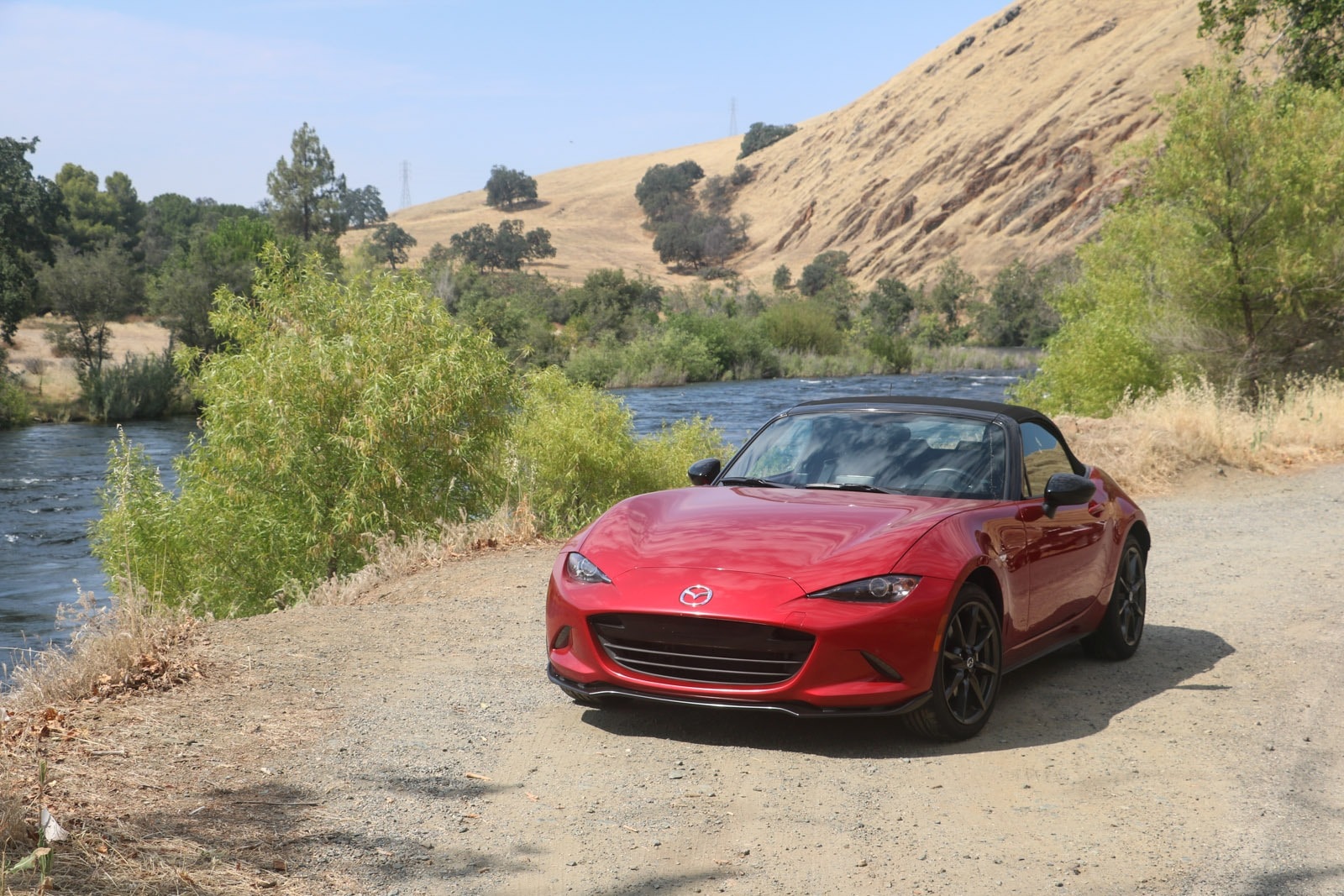
Our Miata floats along the road effortlessly, a stone skipping across a still pond. It's not aggressively tuned. It doesn't hunker down, dig in or zealously change direction. When you dial in some steering, you just get a perfect response to what you want. It's like twisting a big knob on an old vacuum tube amplifier. It's analog driving, which is all the more impressive considering this latest Miata generation has electric-assist power steering.
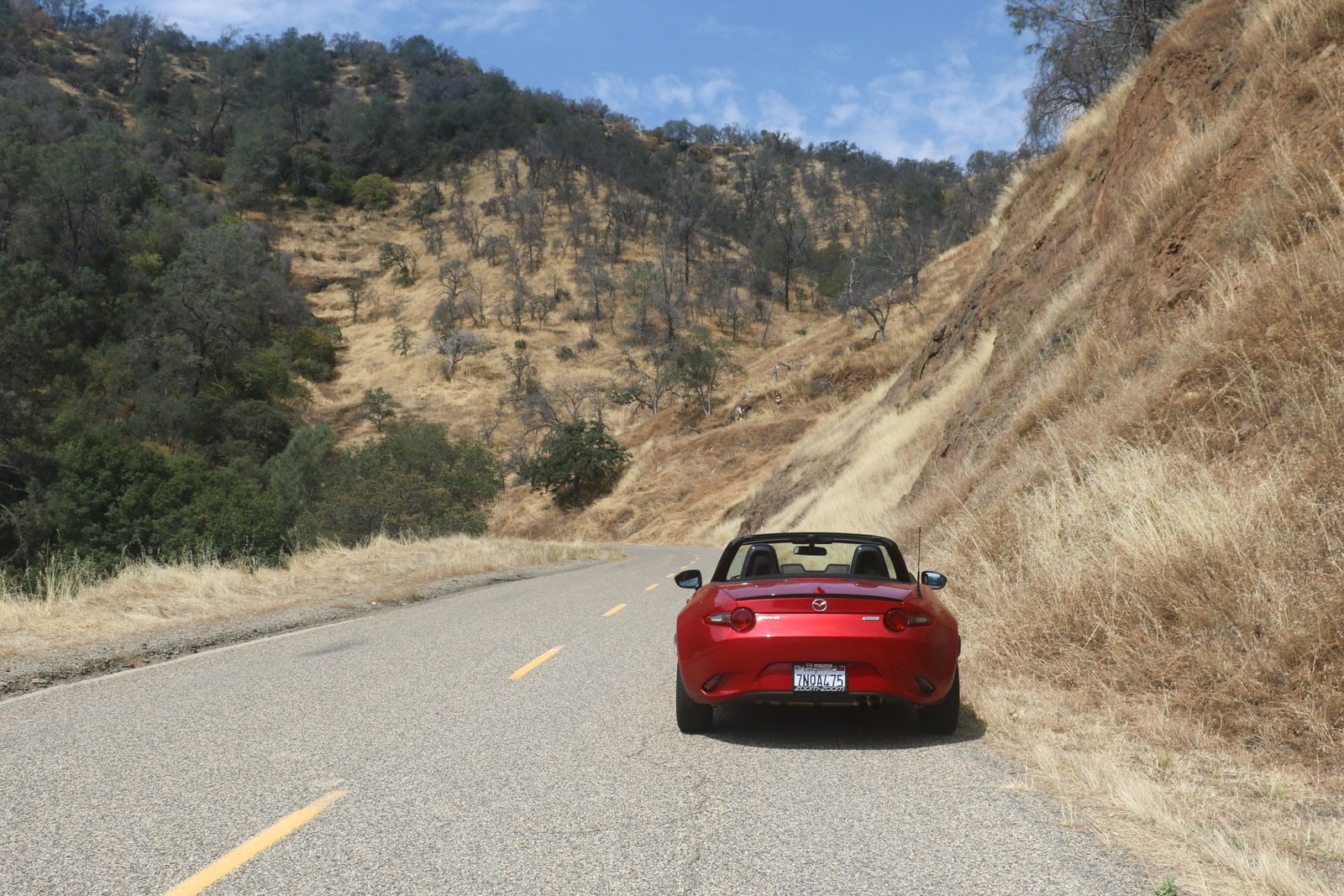
The view through the Miata's small windshield isn't exactly panoramic, but the hood and front fender arches are right in view and then drop away to show the road ahead. As you approach a corner, you can press on the brake pedal to get exactly the right amount of slow-down you want. Then you're cutting around the corner, aiming for the apex. The Miata is narrow enough that you can actually make your own balanced entry-and-exit line across the pavement and still stay within the lines.
Come out of the turn and get back on the gas. There's little need to wind it out all the way up to redline unless you want to. Otherwise, you can happily work the 3,000 to 5,000 rpm range all day long. Brrrrrr ... snick! ... brrrrrr. I love being hard on the gas and quickly shifting from 3rd to 4th gear. The shifter's satisfyingly solid feel is best experienced with that shift, and there's still a nice enough lump of power to be exploited in that gear, too.
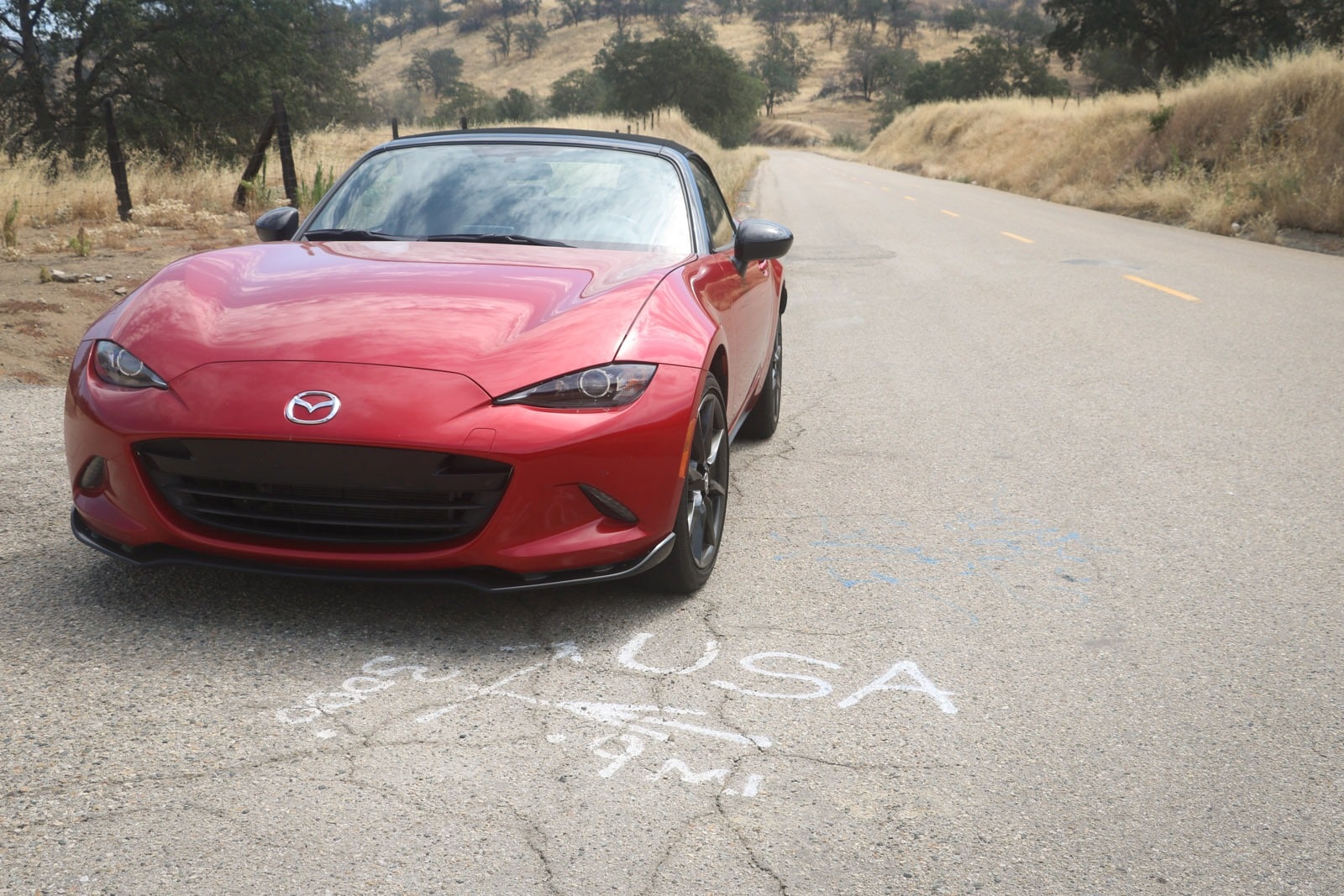
I don't feel much of a need to drive our Miata to the wee of its life on public roads. Maybe it's because I've reached middle age now, and I'm older, wiser (?) and slower. But the Miata is fun to drive spiritedly and still have some reserve. There are other cars that are fun to drive, too, but often it's only because you're veering into max-attack territory. In the Miata, the drive itself is the reward. And I'm guessing that if you really did push it to the handling limit constantly, the results would be less satisfying.
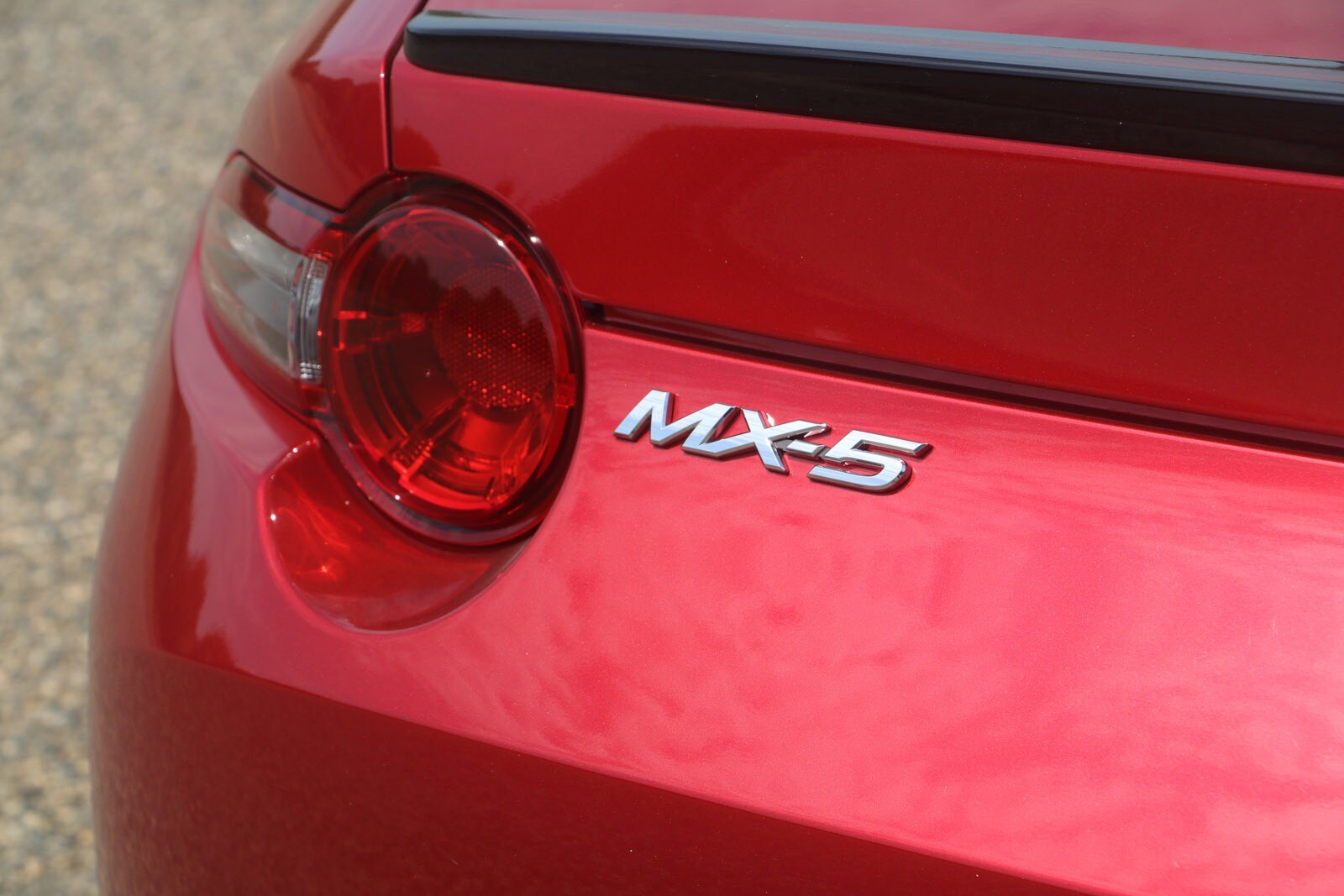
Your daily life is 95 percent humdrum stuff. Answering emails, getting chewed out by your boss, cleaning up after your cat that puked on the stairs. But out here, on this day, it's just you and your Miata. And that's pretty great.
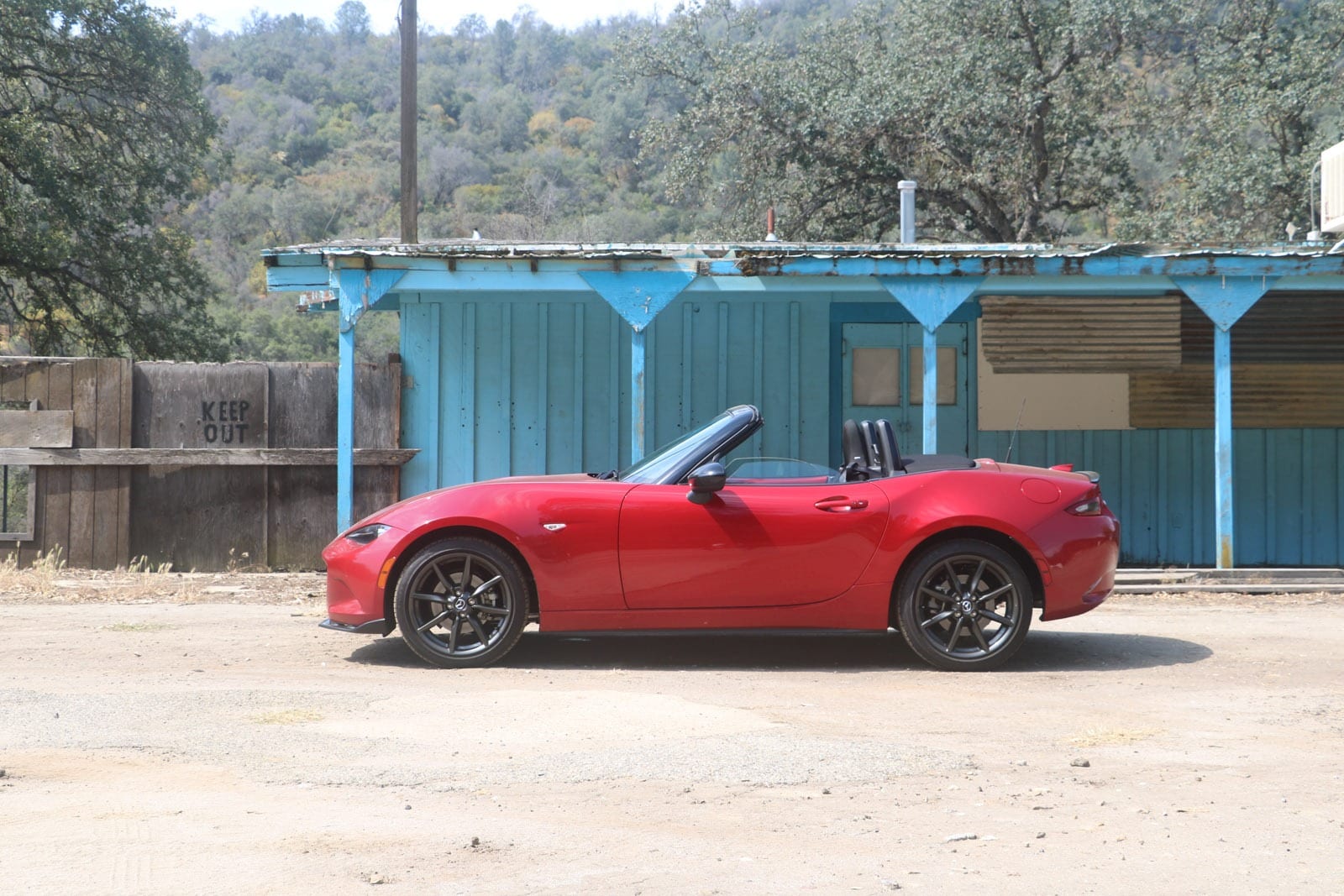

Will the luggage fit? To answer this question we loaded (our 2016 Mazda MX-5 Miata) with bags in different configurations and took photos. What constitutes carry-on luggage varies depending upon who you ask. So for the sake of standardization we used the same blue carry-on bag — size (21 x15x10 inches) and red checked bag — size (30x20x13 inches).
Take the jump for photos and more detail...
Access to the cargo area
This one is fairly straightforward. You shouldn't expect much from the Miata trunk. It fits the proportions of the rest of the car. Small. But the Mazda does its best to maximize the little space it has to offer.
As far as access goes, you'll need to lift your bags 32 inches to get them into the trunk. There is no cutout on the vertical edge of the car, so loading technically means lowering items in from the top. Fully opened, the lid is 52 inches from the ground.
Inside the trunk
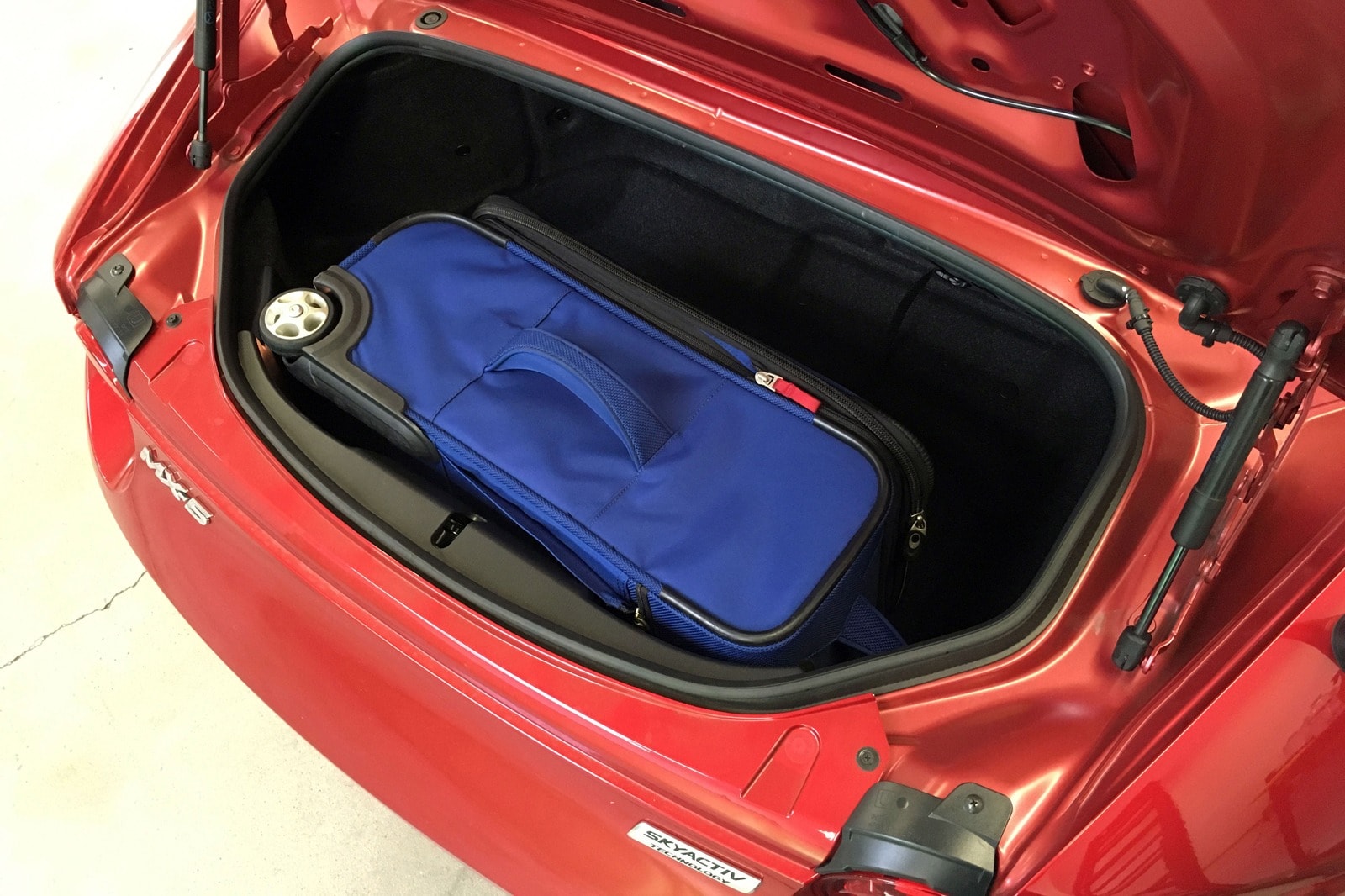
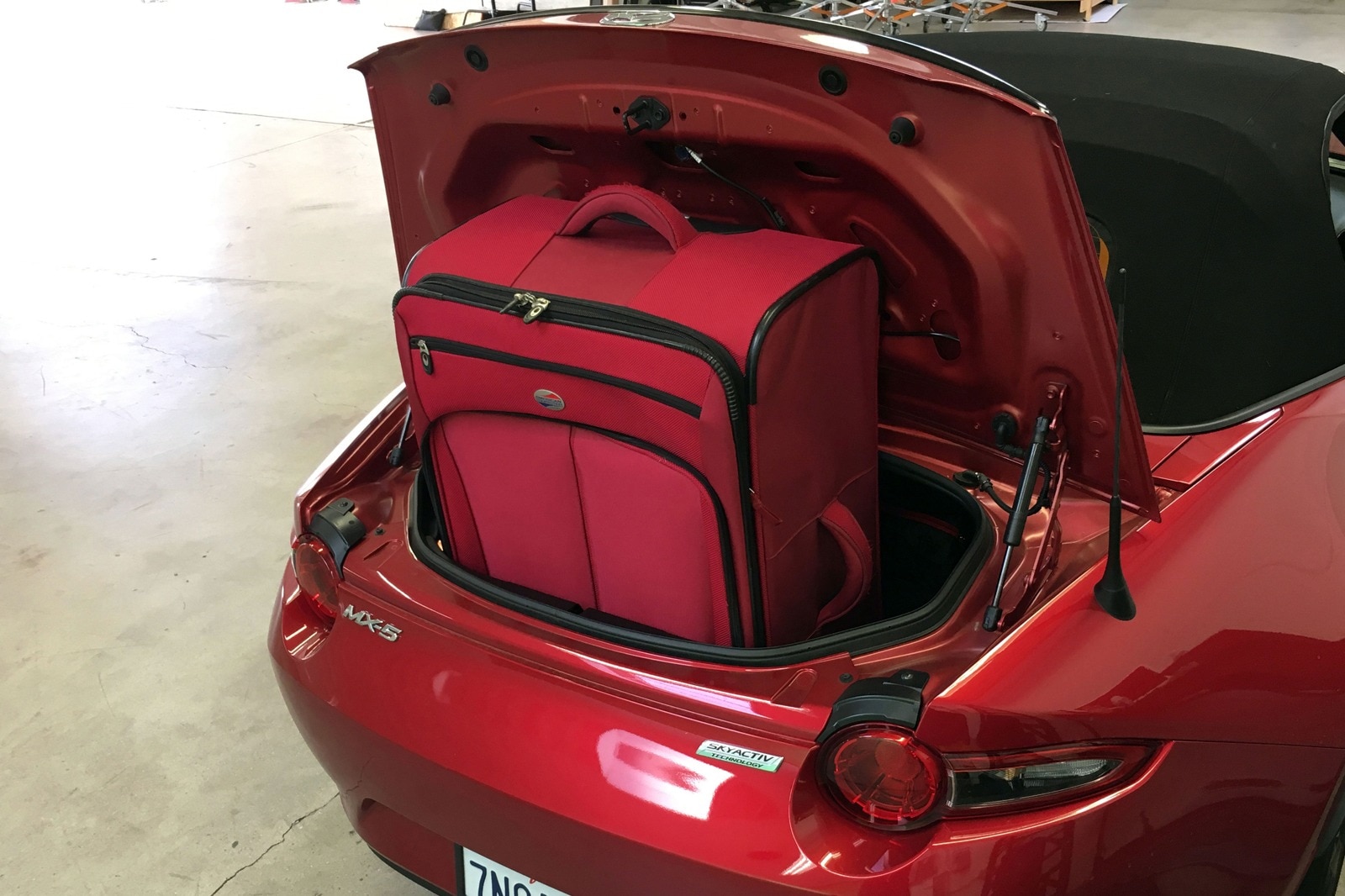
One carry-on bag fits nicely into the trunk with little room to spare. Our standard checked bag will not fit in either direction. Overall dimensions of the space are roughly 21 inches deep by 28 inches wide at the wheel wells. The seats do not fold to increase cargo capacity. However, if you kick out your passenger and drop the top, almost anything is possible.
Find other cargo specs here.
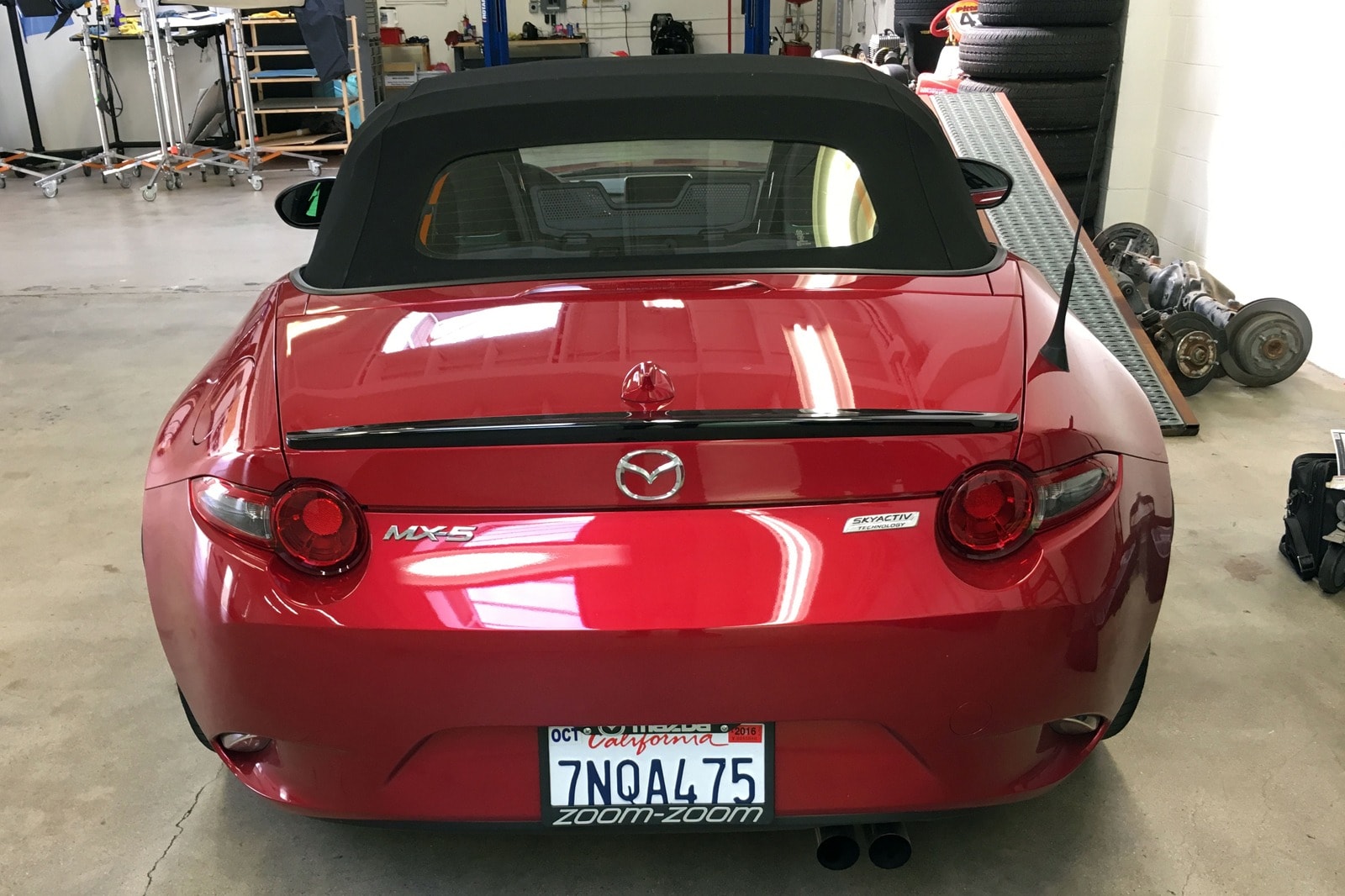
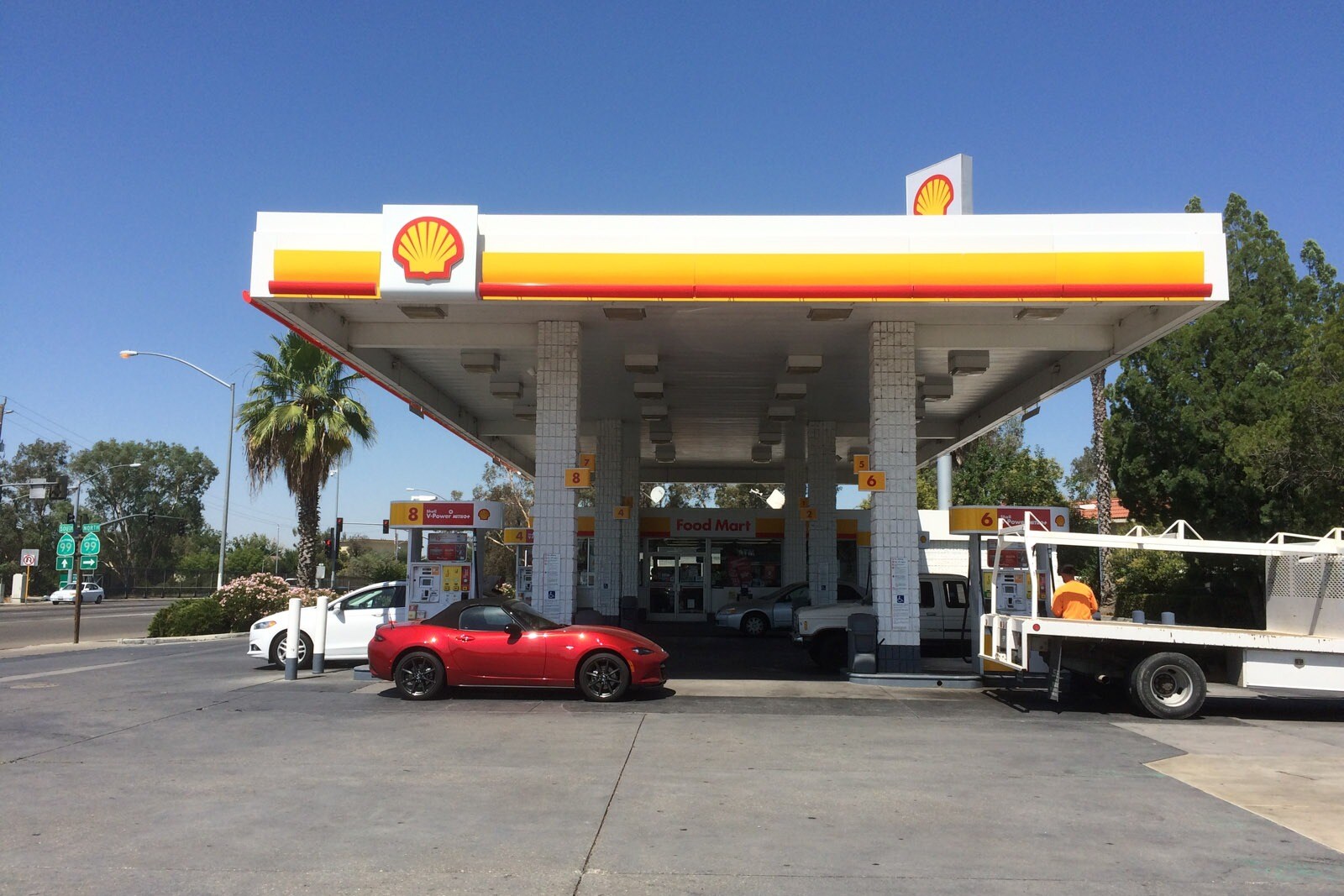
Our 2016 Mazda MX-5 Miata had another quiet month, totaling up about 800 miles in June. Maybe you can blame me, since I've been the one driving it a majority of the time. In my defense, the lack of miles has more to do with the car's lack of practicality (compared to other vehicles in our long-term fleet) than anything relating to my desire to drive it. For those 800 miles, though, our Miata put up fuel economy numbers similar to what we observed in prior months.
We did drop slightly, going from a 30.1 mpg lifetime average last month to 29.9 mpg this month. But that's still keeping us right at what the EPA says we should be getting for combined driving. Thirty mpg from a car that encourages you to drive it with enthusiasm? I'll take it.
Worst Fill MPG: 22.2 mpg
Best Fill MPG: 37.5 mpg
Average Lifetime MPG: 29.9 mpg
EPA MPG Rating: 30 Combined (27 City/34 Highway)
Best Range: 329 miles
Current Odometer: 10,823 miles
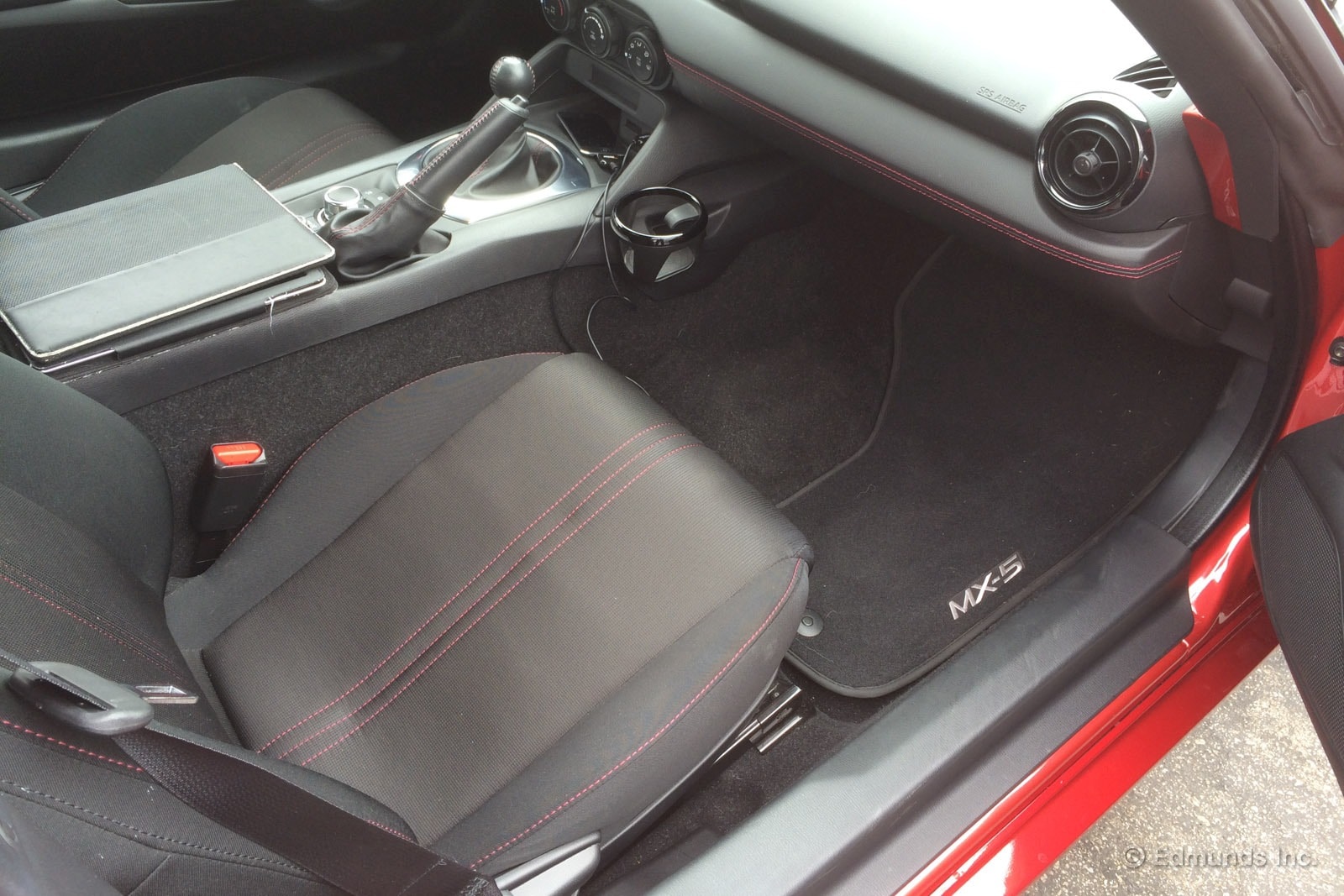
"Why did we take this car again?" This was my wife's quote to me as she was trying to get out of Edmunds' long-term 2016 Mazda MX-5 Miata. We had gone out to dinner and she had dressed up with stylish 3-inch heels.
"Because it's cool, obviously," I replied.
"Whatever. Help me out."
It's true that the Miata is harder to get in and out of than most vehicles. It sits low to the ground, and there's not much clearance for your head with the top up. But as sports cars go, the Miata is pretty typical. There are worse offenders, in fact, such as our long-term Dodge Viper. And that made me think of something I bought for our Viper and never followed up on:
It's time to test out the Car Cane.
As covered in my Viper update late last year, the Car Cane is this "As Seen on TV!" handle.
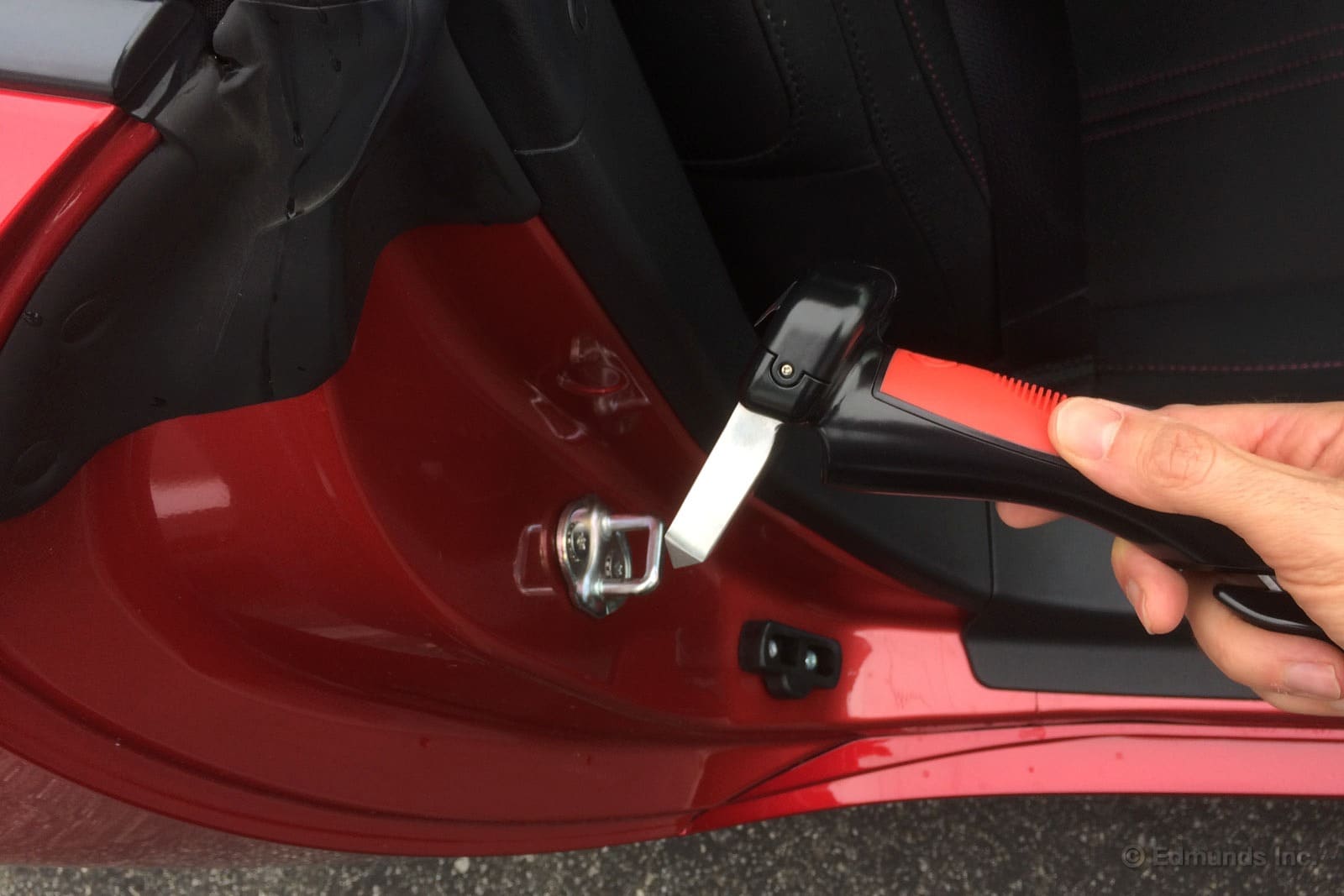
With the door open, you insert the Car Cane's metal spike into the door's latch anchor point. These anchor points are sturdy, so you can put plenty of weight on it. Then you just put one of your hands on the Car Cane's handle to support some of your body weight as you enter or exit.
To be honest, I feel a bit goofy using it, and the hokey commercials don't help. But hey, it works. In our Miata, I've previously used the seatback as a point of contact to help push myself up and out. With the Car Cane installed, I can get more leverage and don't have to put undue stress on the seatback bolster.
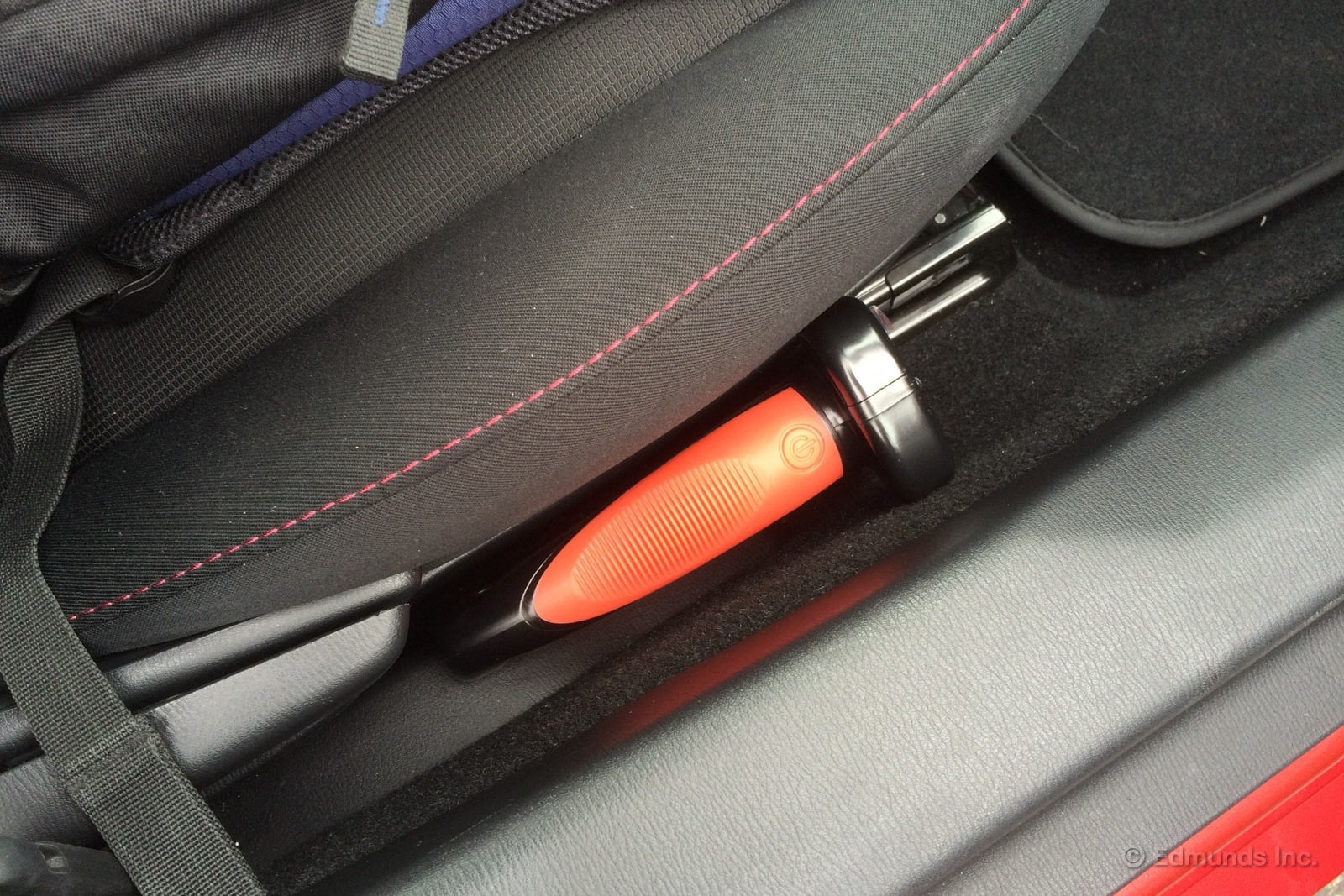
I've tried it out for a couple of days and I'm sold. There's even space between the Miata's seat and the floor for permanent storage.
And next time my wife and I go out in the Miata, I can say, "Would you like the Car Cane, dear?" She'll love that.
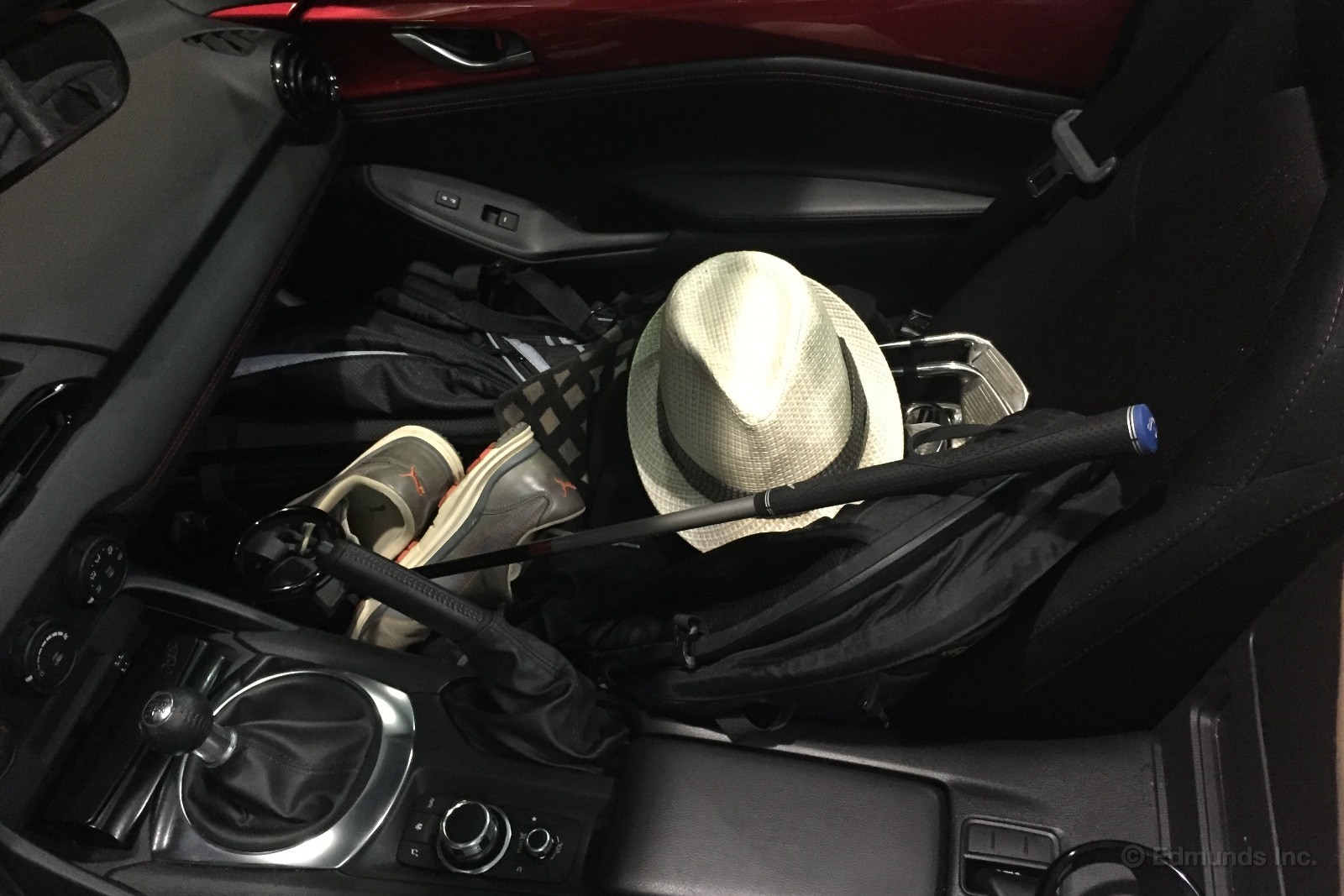
It's what every golfer wants to know about any convertible:
"Will my golf bag fit?"
And I can attest that the 2016 Mazda MX-5 Miata does indeed have room for your golf bag, as long as you don't mind if it rides shotgun.
Of course, the golfer would hope that there's room in the trunk, and for two bags at that. But unlike previous Miatas, the current model's trunk can't even accommodate a single bag with the woods removed. That means a two-person outing is impossible unless your partner agrees to share the passenger compartment with both bags. Let's just leave it at "impossible."
Still, at least there's space for yourself and your clubs, with the latter in full view, which is fine unless you go for a beer after the round and park in the vicinity of an enterprising thief. I'm glad our car has fabric upholstery, by the way; the Grand Touring trim's passenger-side leather would likely take a beating from that golf bag over time.
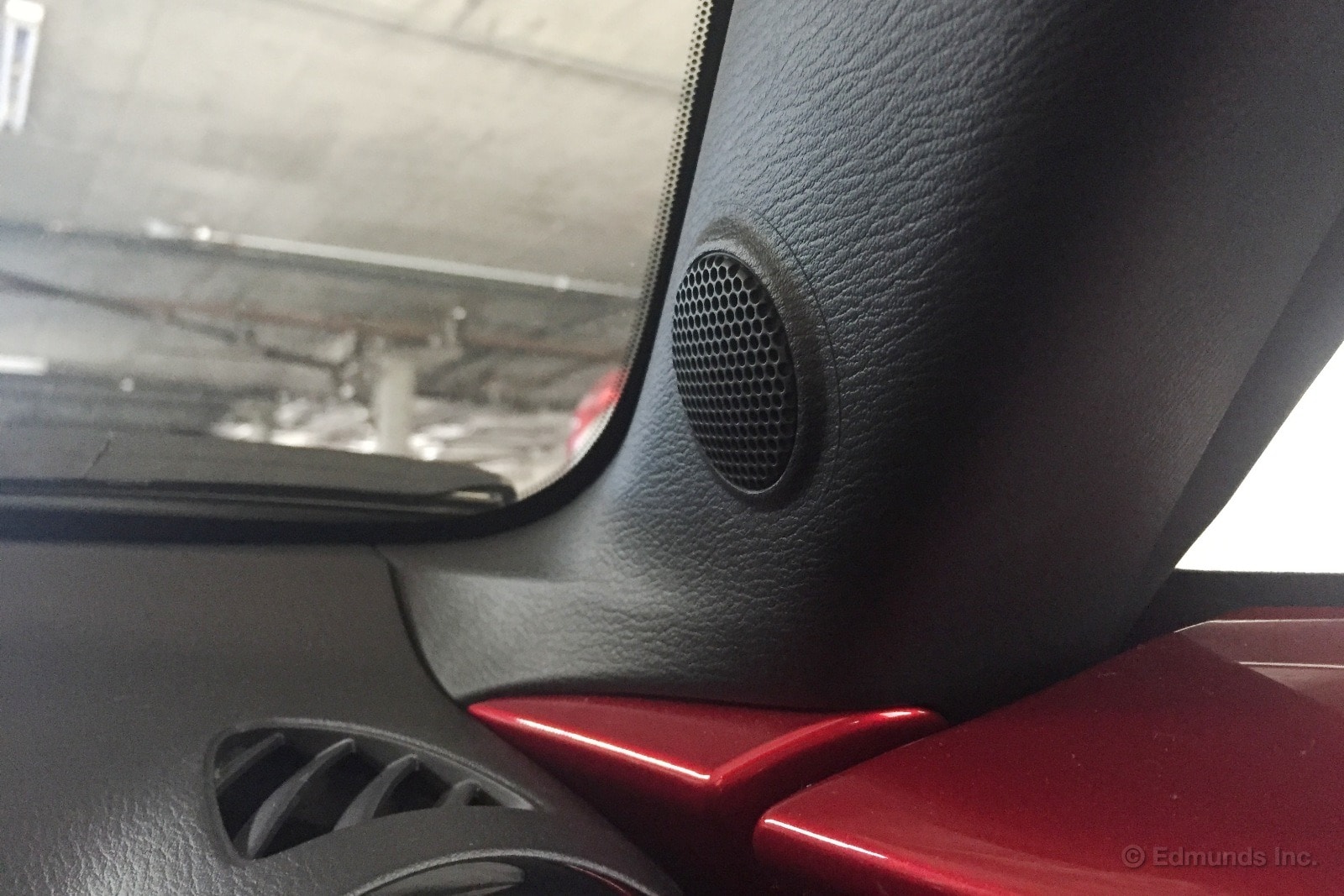
Mazda has a checkered past with Bose stereos, and when I say "checkered," I mean I can't remember a Bose setup in a Mazda that really cranked. They sound OK, don't get me wrong; they just tend not to meet the higher expectations that the premium branding creates.
Which brings me to the nine-speaker Bose system in our long-term 2016 Mazda MX-5 Miata. Does it break with tradition? Let's see about that.
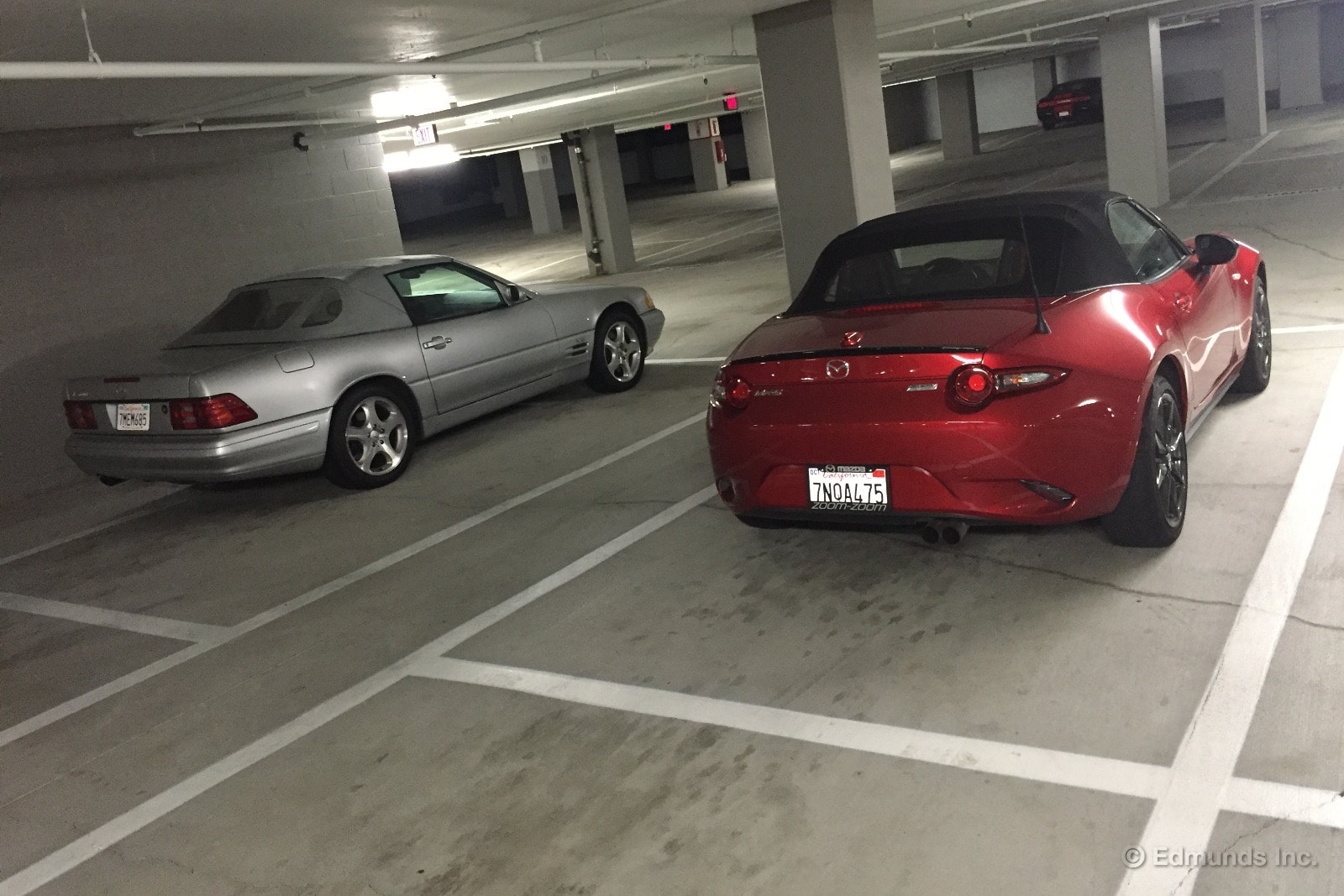
As a roadster owner myself, I can report that a great top-down stereo really elevates the driving experience. I can also attest that Bose knows how to make one, so don't tell me "no highs, no lows, must be a Bose." My SL600 from forever ago has a factory Bose setup with a subwoofer behind the driver seat, and the sound cuts through the wind and envelops you at any sane speed. That's how it should be, right? I think it's a reasonable expectation when there's a premium label on the system.
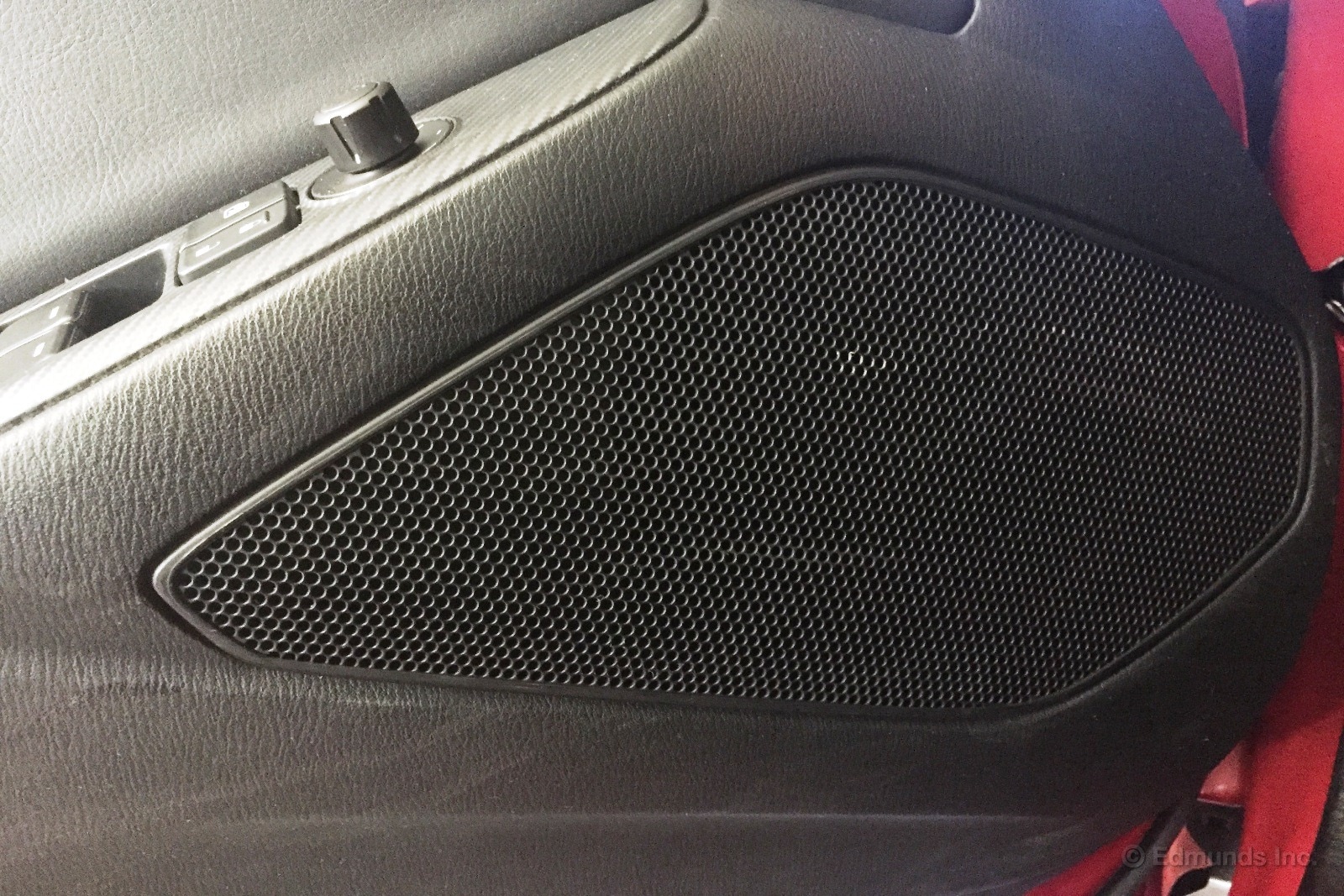
Alas, our Miata's system falls well short of that standard. To some extent, I get it, because from a financial perspective, it's a wonder that little-guy Mazda keeps building this car at all. When the Bose sales team stopped by with a range of components to choose from, I imagine the Miata planners were not at liberty to splurge.
Nonetheless, when I look at Mazda's official description — "Bose 9-speaker audio system with...driver and passenger headrest speakers and subwoofer" — I'm thinking wind-cheating bass and a full, rich soundstage.
And when I actually turn the thing on, I'm getting a pronounced forward sound bias and, yes, "no highs, no lows" on the open road, where the wind too easily muffles the output.
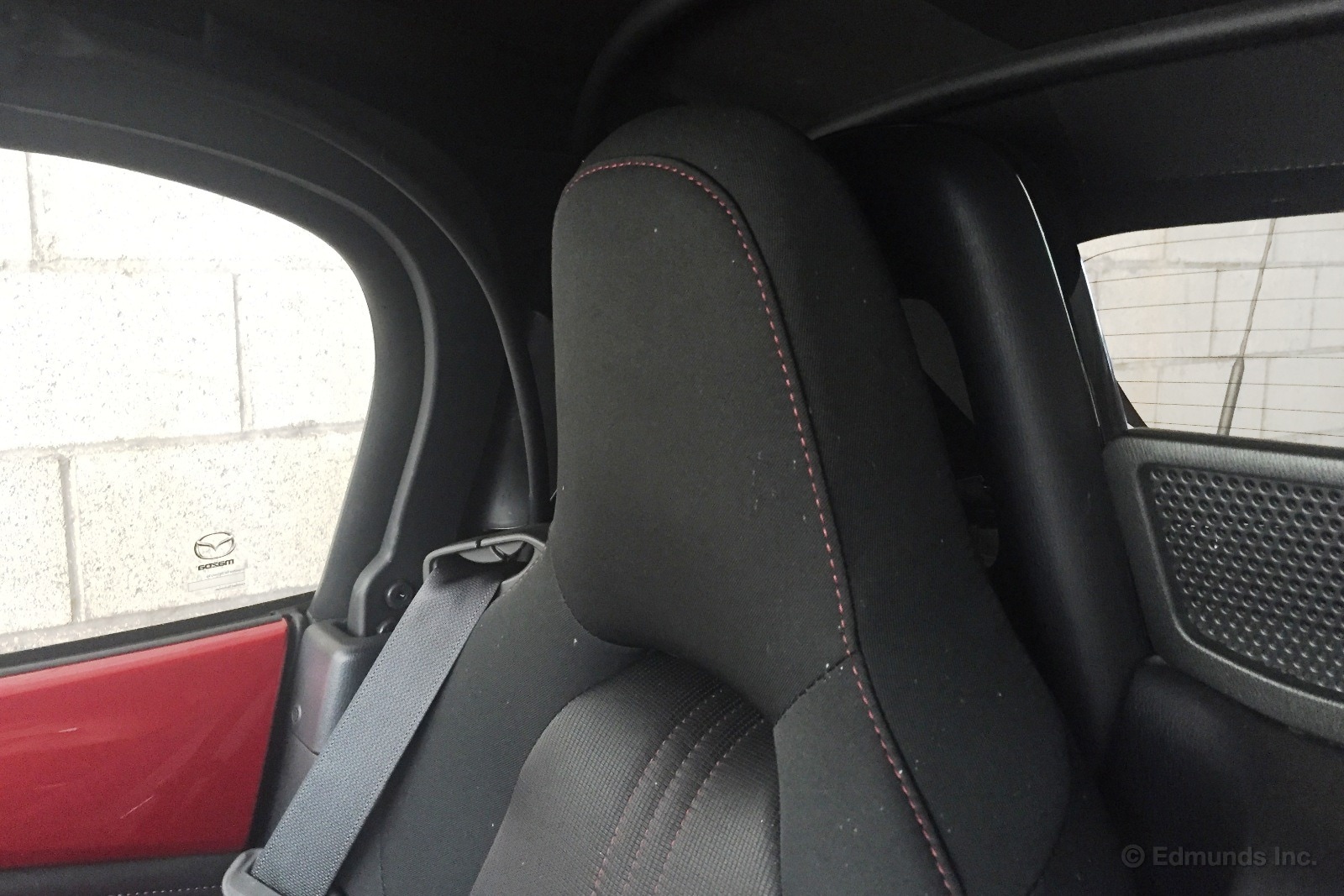
I'll chalk these results up to two primary issues. First, the headrest speakers contribute effectively nothing when you're listening to music. If you're using Bluetooth to make a call, the person's voice comes through loud and clear on those speakers, so they're functional (and quite handy for this purpose, I might add). But they're hardly involved at all when it comes to music reproduction; I even put the fader on full rear to test them out, and I still couldn't hear much. Headrest speakers with real musical capability — assuming that's technically feasible — could go a long way toward balancing out the soundstage.
Second, there's just not enough power behind the sound. If you want it to cut through the wind, you need amplification, and this setup could use a lot more of it. Of course, that would require pricier components, so again, I can appreciate where Mazda's coming from.
Still, it'd be nice if the Miata offered a stereo that sounded great right off the rack. When you're plunking down $30,000-plus on a new roadster, that doesn't seem like too much to ask.

I'm used to temperature needles staying on the low side of the gauge so as not to freak drivers out. But I've never seen a fully warm reading as low as the one in our 2016 Mazda MX-5 Miata.
It's something that's puzzled me about this car since the first time I drove it. I keep waiting for the indicator to creep up and settle somewhere around, say, the third hash mark between 210 and 230, because that would be a more familiar "fully warm" orientation. But for some reason, Mazda decided to cram the entire normal operating range into the gauge's first segment, which by the way is the smallest of the bunch.
Not that it really matters on a modern car — a lot of cars these days don't even have temperature gauges — but I still find it curious. Why would Mazda do this? Anyone got a theory?
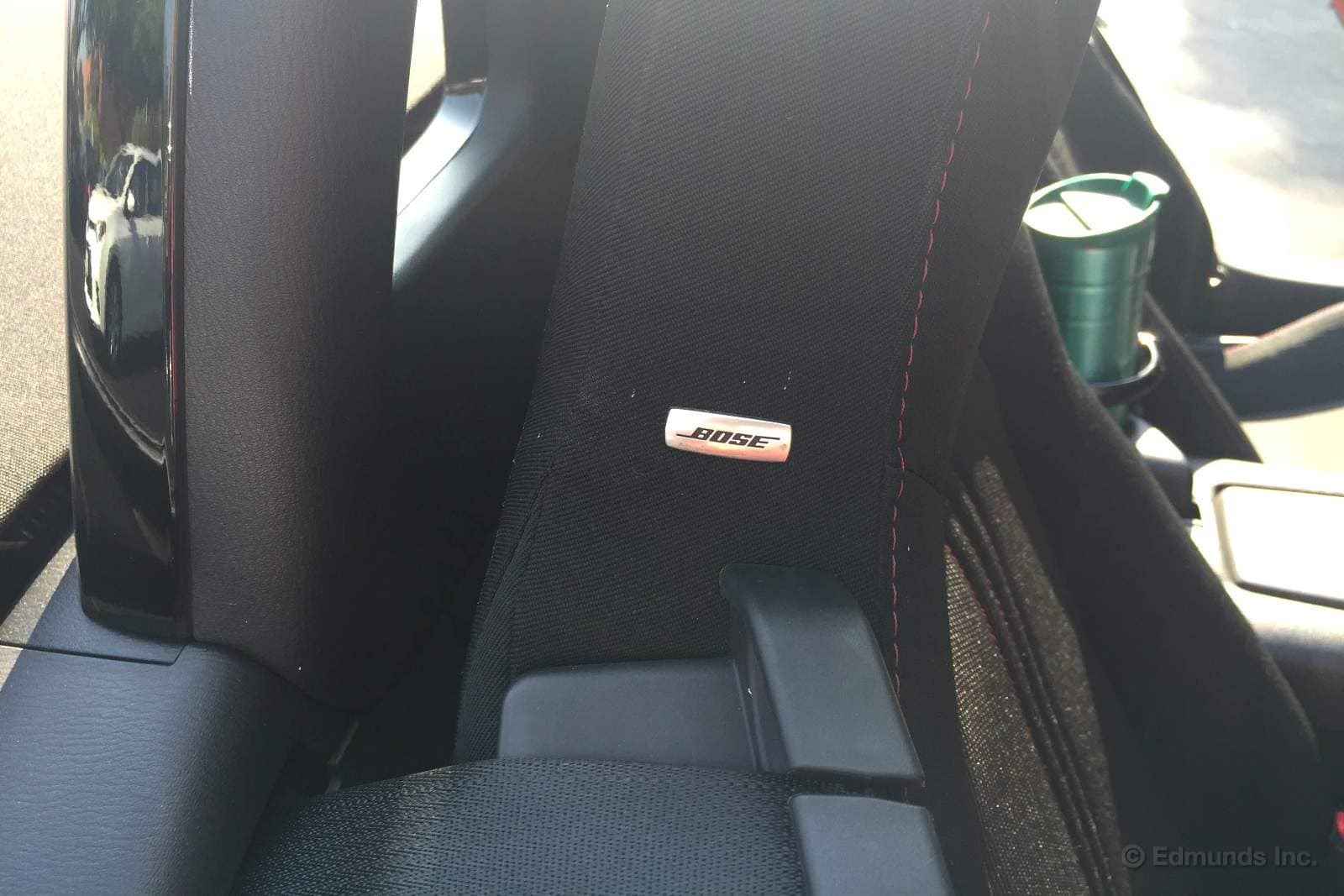
Just a brief note here for posterity. In my stereo evaluation of our 2016 Mazda MX-5 Miata's standard Bose system, reader hank39 asked if Mazda had "stopped placing the Bose logo on the speaker grilles." I confirmed that the grilles had no logos, and I theorized that "maybe Bose requires a certain level of component quality if you want to use the logo."
I was not correct.
I noticed this morning that there are, in fact, two Bose logos in the car — one on each headrest, facing out so the world can see. Doesn't make the system sound any better, but there it is.
I always thought this was a cool logo, by the way. Maybe that's because I remember seeing it on the Wave Radio when it came out in 1993. The Wave cost an unfathomable $349 — it was just a radio! — but to my 11-year-old self, standing there in my friend's living room (no way my parents were paying that for that), it sounded amazing. And like I said in the stereo evaluation, the Bose system in my own car still sounds amazing. I think the company simply doesn't mind putting its brand on so-so systems, too, if an automaker wants a more value-oriented option. That's a business decision, but it doesn't mean Bose can't do great things.
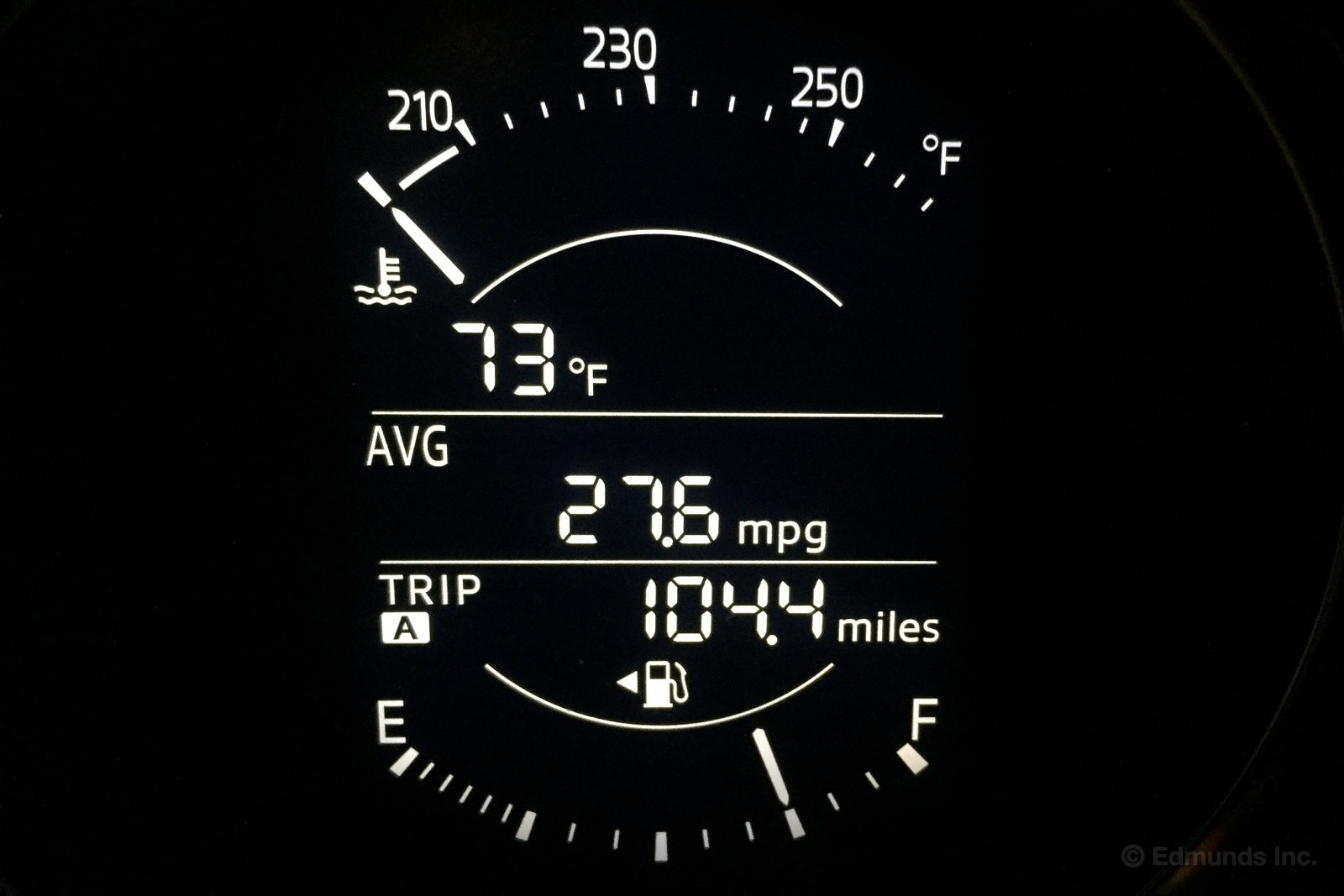
It's a genuine challenge to get bad fuel economy in our 2016 Mazda MX-5 Miata. I submit the 104.4-mile trip depicted above as evidence. I was on the throttle hard for most of those miles, shooting around town between zero and maybe 50 mph, often leaving it in a lower gear to keep the revs up (because sports car, not because this engine needs 'em).
The blasted thing's still giving me an indicated 27.6 mpg.
Not surprisingly, July was another solid month for the Miata's overall fuel economy. Although we didn't quite hit the EPA combined rating of 30 mpg, we were close, and most of the miles were accrued by yours truly in the abovementioned driving style. By sports-car standards, this ND Miata is a fuel-sipper of the highest order.
Worst Fill MPG: 22.2
Best Fill MPG: 37.5
Average Lifetime MPG: 29.8
EPA MPG Rating: 30 Combined (24 City/34 Highway)
Best Range: 329 miles (formerly 311.2)
Current Odometer: 11,513 miles
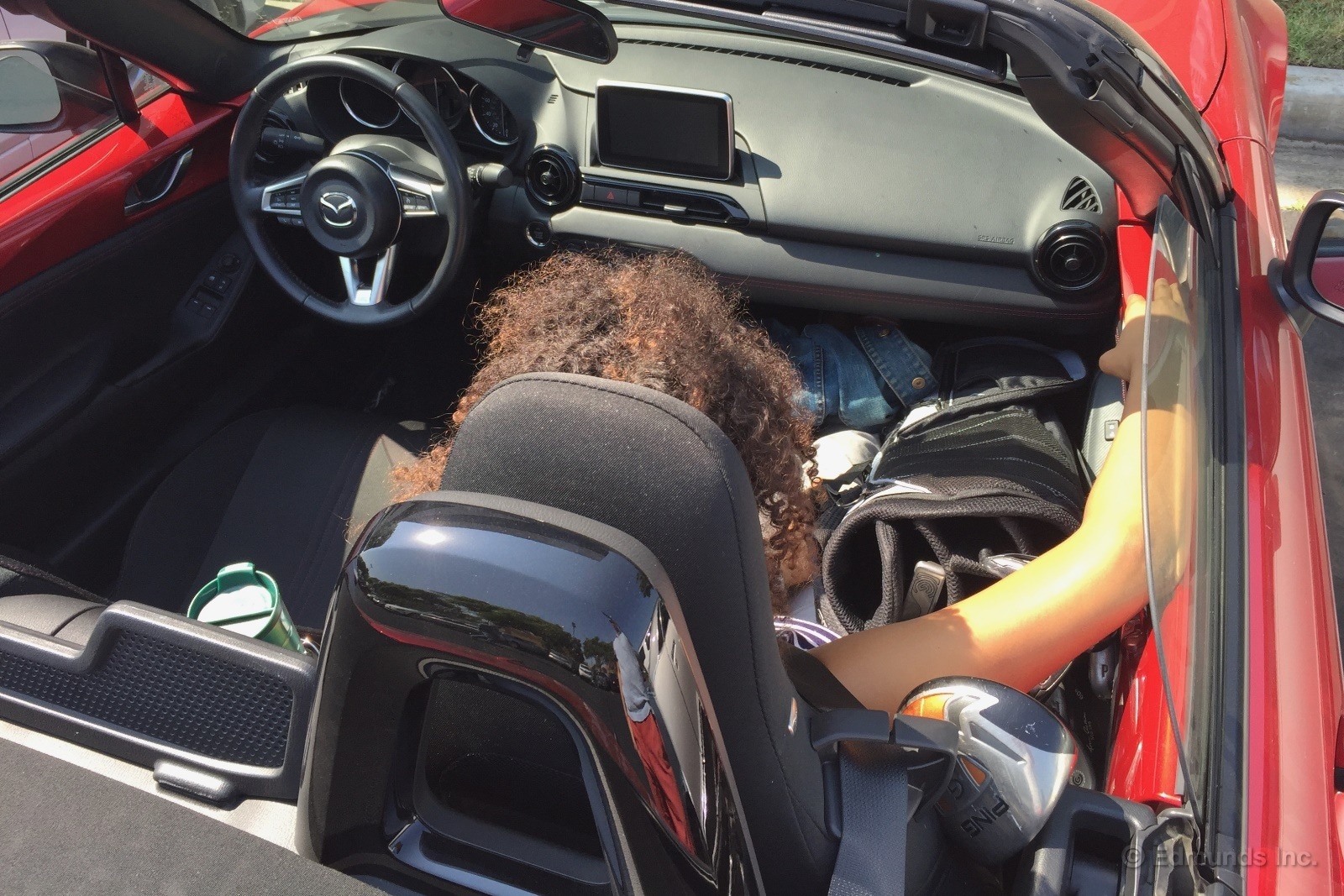
I've already demonstrated that our 2016 Mazda MX-5 Miata has no trouble transporting both a golfer and a golf bag, as long as you don't mind putting the bag in the front seat. But what if your wife's car is in for service, and she needs a ride somewhere, and the only way it'll work is if you drop her off en route to your tee time?
Now, I'll hazard a guess that most Miata drivers either think golf is lame or have another car they could use for this scenario. But sometimes life puts you in special situations, and this was one of those. It didn't make any kind of sense to loop back to get my clubs after dropping her off, so I told her this was going to be great. We'd strap her in first, put the clubs on her lap and that would be that. "You'll love it," I explained.
I can tell you that I got her to her destination safe and sound, and neither she nor the clubs were any worse for wear. Well, she actually wasn't talking to me at that point, so I'm speculating there. But the clubs, at least, were tip-top.
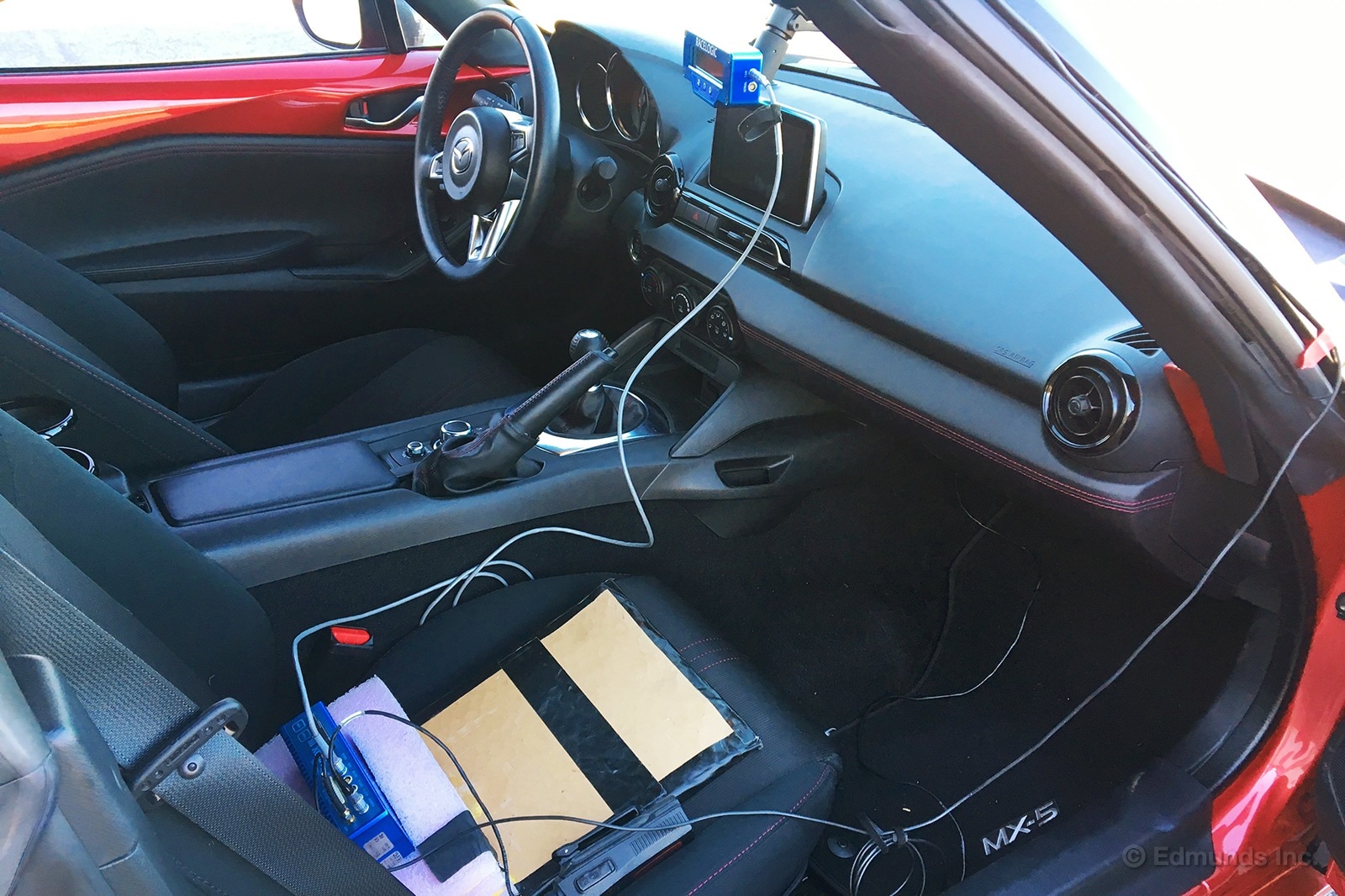
When we perform instrumented testing on vehicles, we use a VBOX from Racelogic. The setup we have requires a 12-volt power receptacle, also known as a cigarette lighter socket. With space at a premium in our long-term 2016 Mazda MX-5 Miata finding that socket proved difficult.
Center stack near the USB ports? Nope.
Center armrest bin? Nope.
Bins behind the seats? Hmmmm. Nope.
Glovebox? Doesn't have one.
Time to consult the manual.
It's in the passenger-side footwell, under the dash, next to the center tunnel. You have to knock on a wooden door three times, then answer some riddles from a tiny troll. That last part might have been made up, but here's a picture.
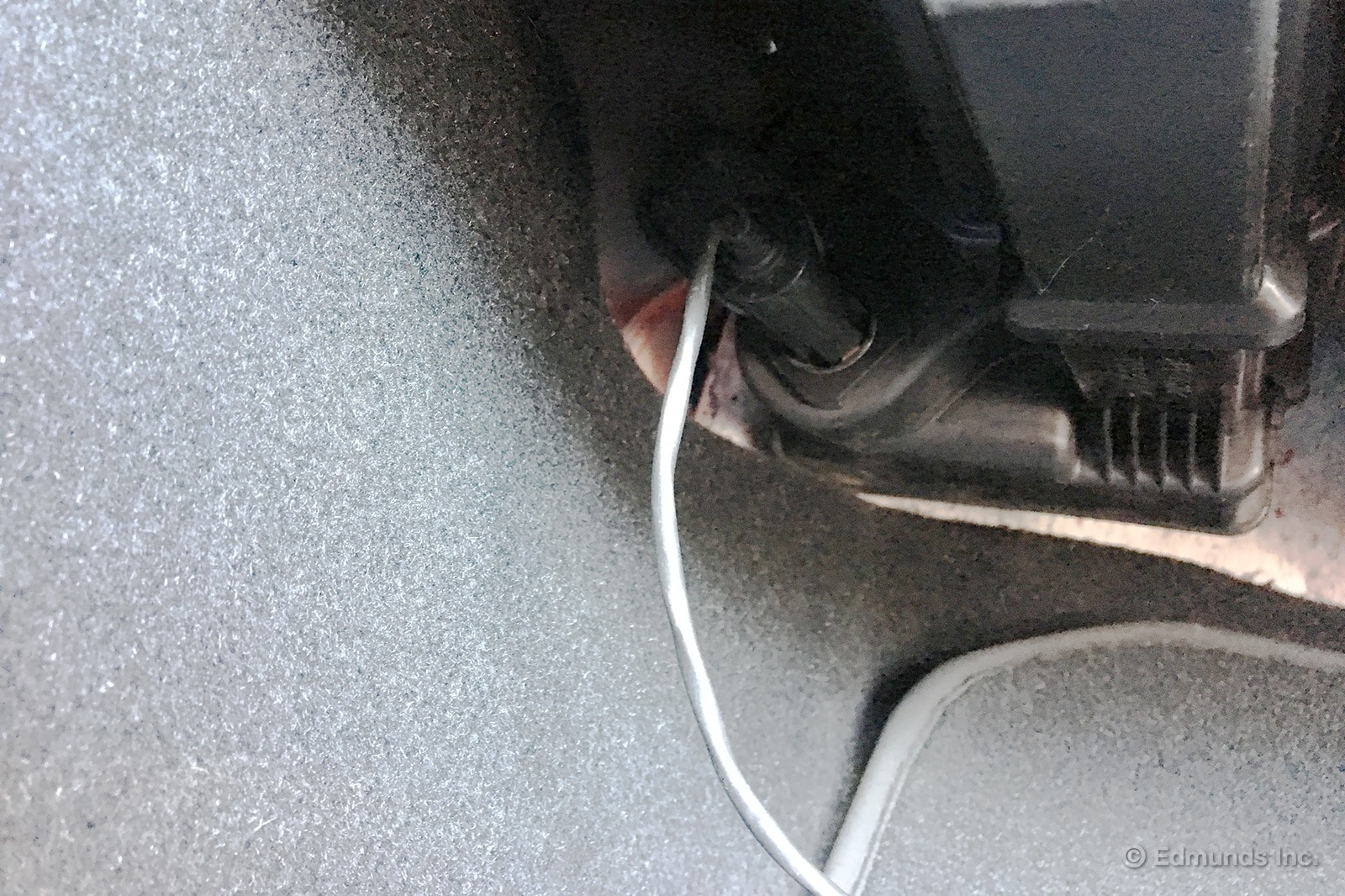
Now you know. You're welcome.
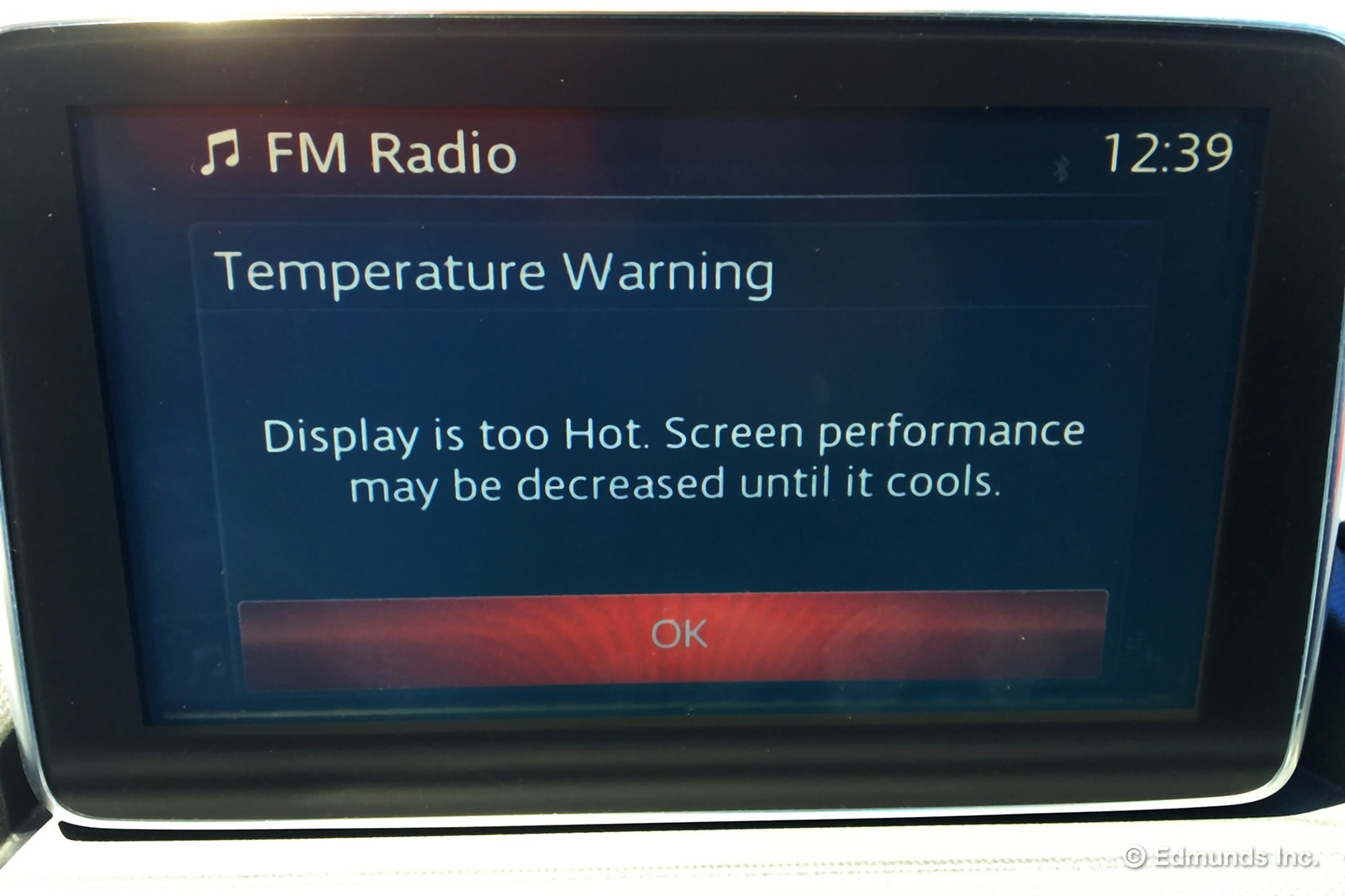
It was a hot day in Southern California. I hopped in our long-term 2016 Mazda MX-5 Miata and got the message above. I suppose that's one of the drawbacks of having one of those tablet-like displays that don't retract or aren't covered by a hood.
Anywho, in lieu of anything else to say about it, I'll revive our old caption contests. I'll start off with, "I tried to play some Kool and the Gang, but it was Too Hot."
Sorry. You can do better.
To Ripley and Back, Believe it or Not
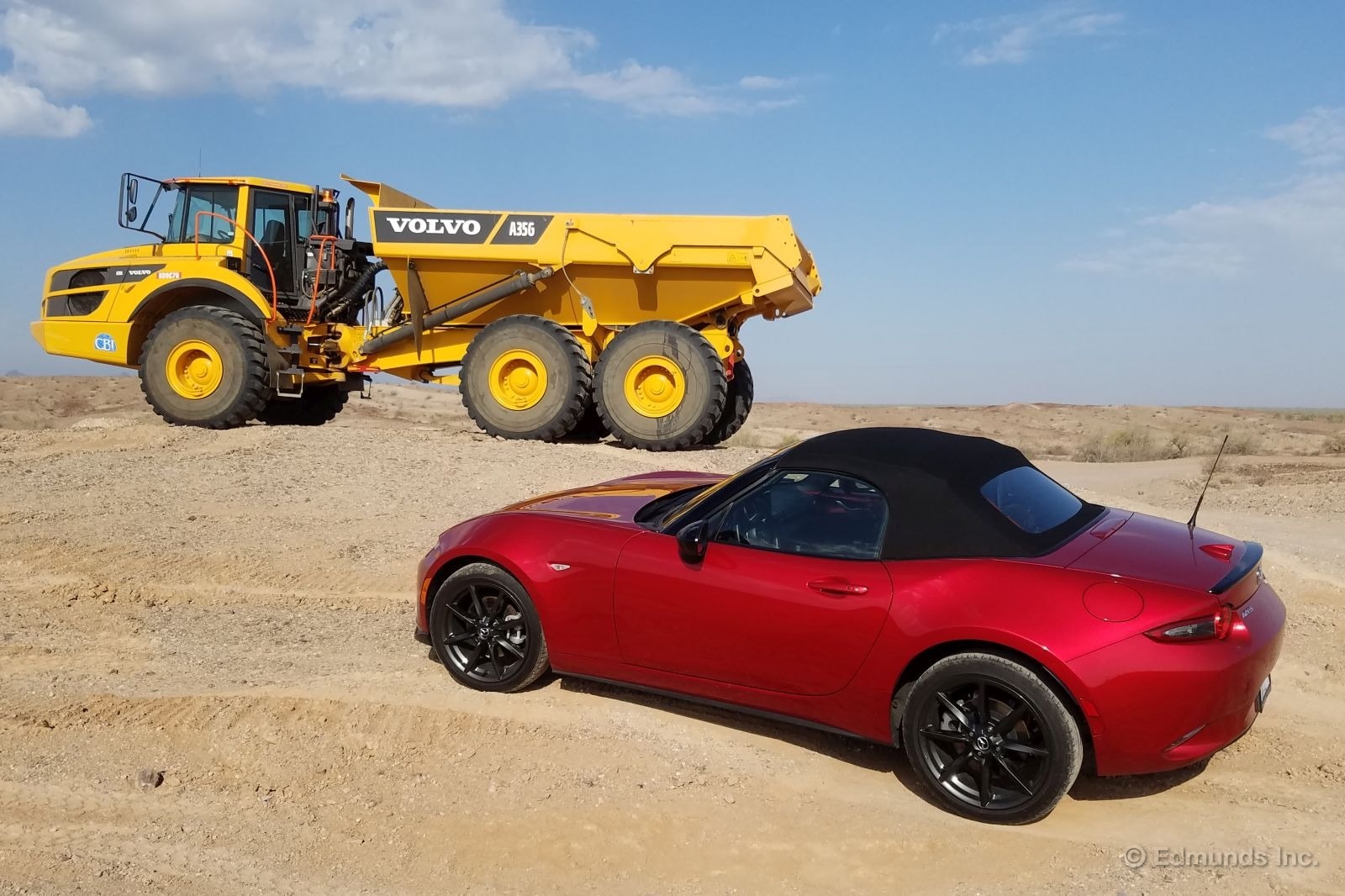
Much of my time in our 2016 Mazda MX-5 Miata has taken the form of bite-sized chunks: trips to the mall, dinner and a movie, minor Home Depot runs, shuttling my daughter to a sleepover. I'm blown away every time by its uncanny ability to inject fun into routine errands.
But I've never driven it very far. Each session behind the wheel could only be counted in minutes, not hours. Would I still love the MX-5 as much (or at all) if 6-foot 2-inch me had to spend all day in the saddle? Could I really see myself owning one of these?
My opportunity to answer these questions came last Saturday, when I woke up before sunrise for no good reason. I couldn't sleep, so I did what I've done on previous mornings like this: I grabbed the keys and headed east into the desert with no destination in mind.
By the time I got home, I'd covered 503 miles, burned through a complete tank of gas and gotten partway into another.
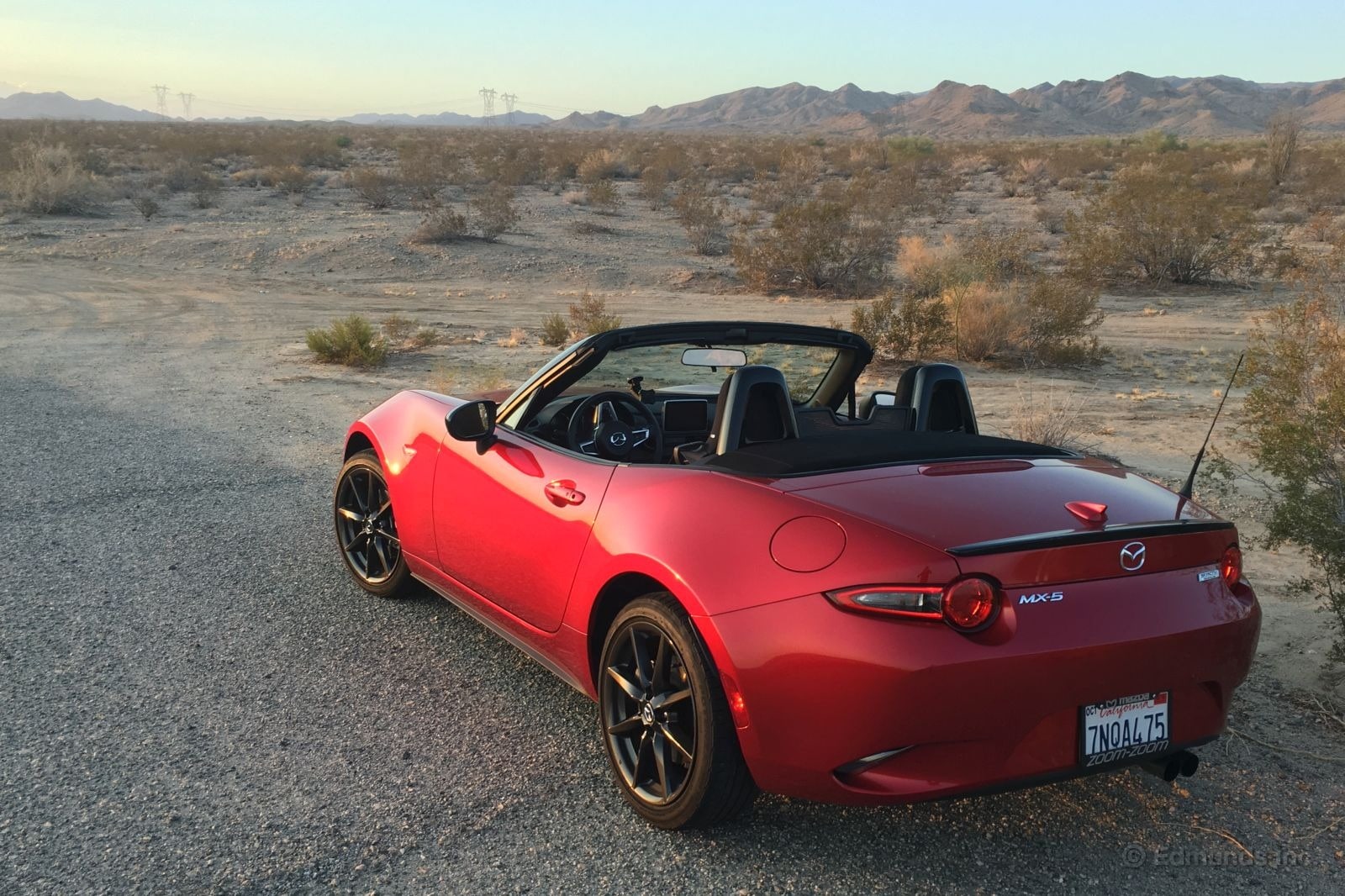
The new ND MX-5 is considerably more accommodating of my lanky frame than any previous Miata, but it doesn't have the stretch-out room of the 2015 VW GTI that I drove the last time insomnia struck. It can't. The seats only go back so far before they encounter a bulkhead.
Still, I was able to settle in comfortably with the seat in its rearmost position, and the seat itself proved to be supportive for what turned out to be an eight-hour trip.
I cruised with the top up during the chilly pre-dawn darkness and again when the sun was high in the sky. But I ran with it down during the golden hour, the in-between time when the sun was coming up. That's when I like convertibles best, and there's nothing better than the MX-5's manual top, which is about as easy to raise and lower as it gets.
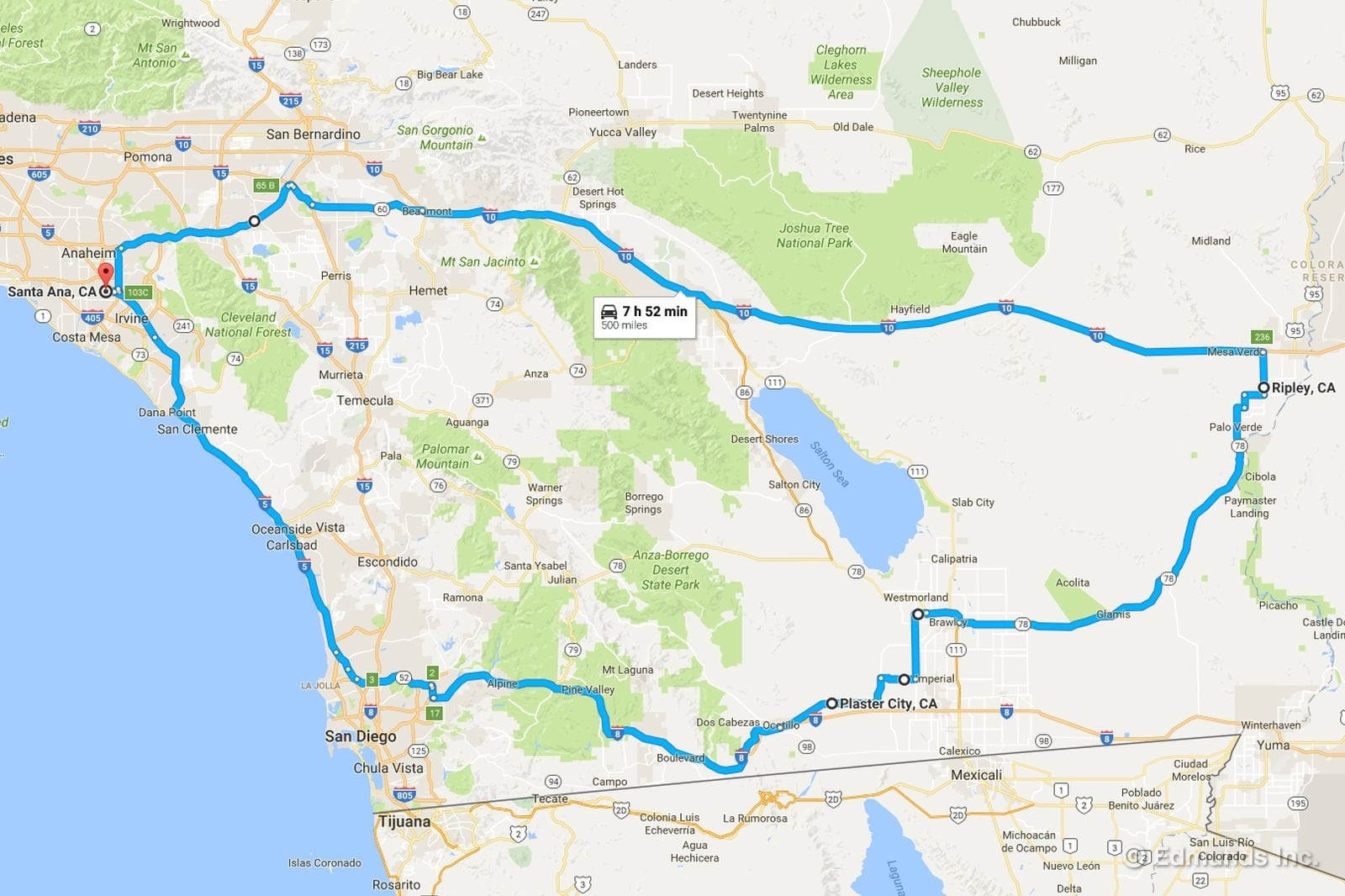
My route was a mix of interstates and lonely two-lane desert roads. I didn't turn the wheel much, in other words. Aside from some large-radius bends on Highway 78 south of Ripley, California, there were no glorious winding roads for the Miata to exploit this time.
But that didn't matter. As with my errand-running trips, the Miata's inherent goodness showed through on the open road. It felt connected and willing even though I never asked it to do much. But it was never nervous, twitchy or tiring along the way.
I could own one of these. I could drive it to Texas and back. Or Oregon. Moab, maybe.
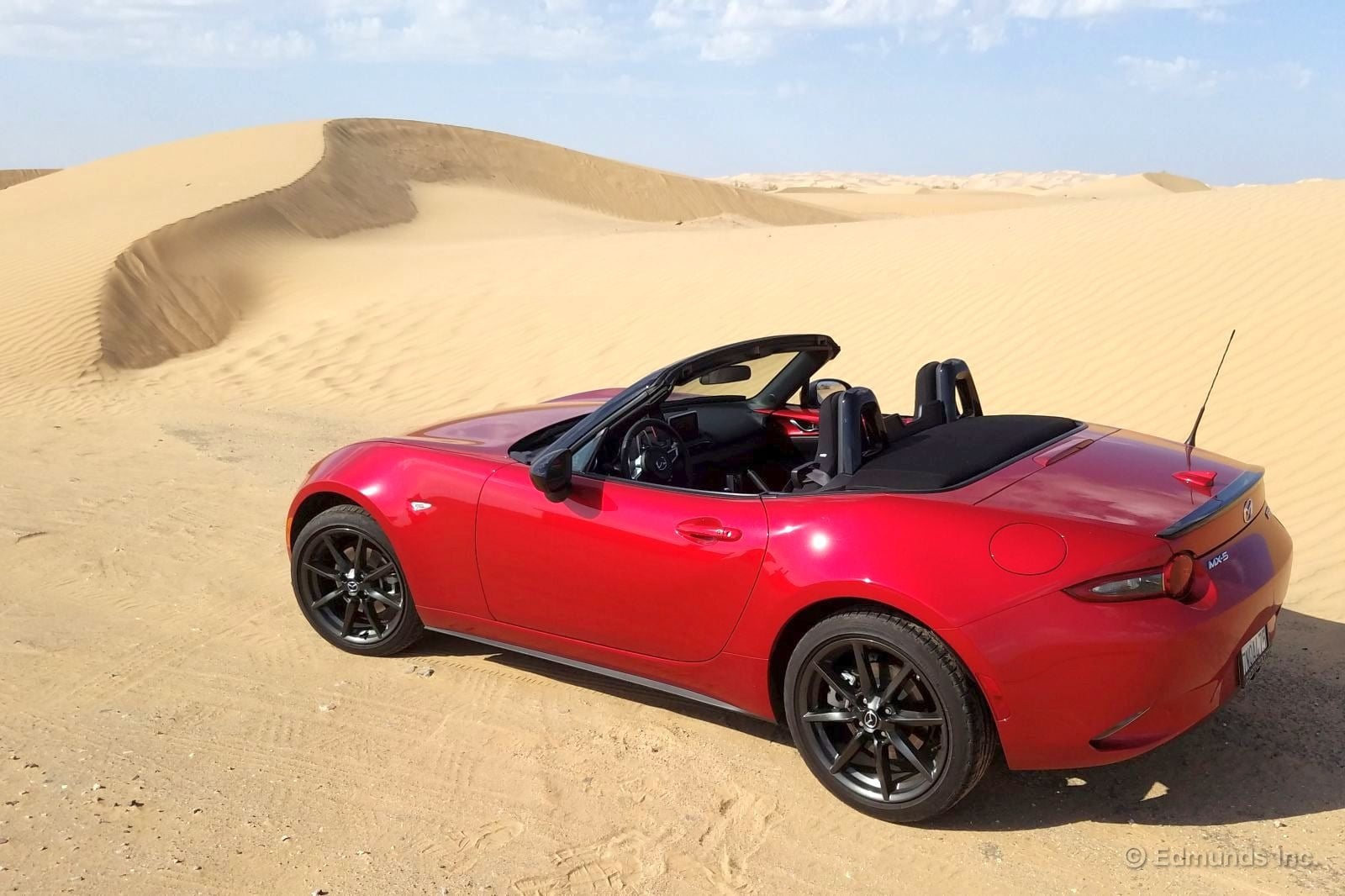
I came to that conclusion before I stopped for gas and did my usual MPG math. The first stop came at the top of the Jacumba grade at a Shell station just off Interstate 8 in sight of the Mexican border fence. I had driven 347.1 miles, a new Best Range milestone for our 2016 MX-5. It took on 9.638 gallons of fuel, which works out to an even 36.0 mpg.
The official EPA highway rating is 34 mpg.
I filled up again 155.9 miles later when I got home so I could lock off the round trip. Another 3.749 gallons went in, which amounts to 41.6 mpg. Zoinks!
"But, Dan. Jacumba sits at about 2,844 feet," you say. "That was a downhill-trending tank."
That's true, but that means the 36.0 mpg tank had been an uphill-trending one.
We need to look at both together. In all I drove 503.0 miles and the Miata burned 13.387 gallons for a trip average of...
...37.6 mpg.
And I wasn't even trying. This Skyactiv business is for real.
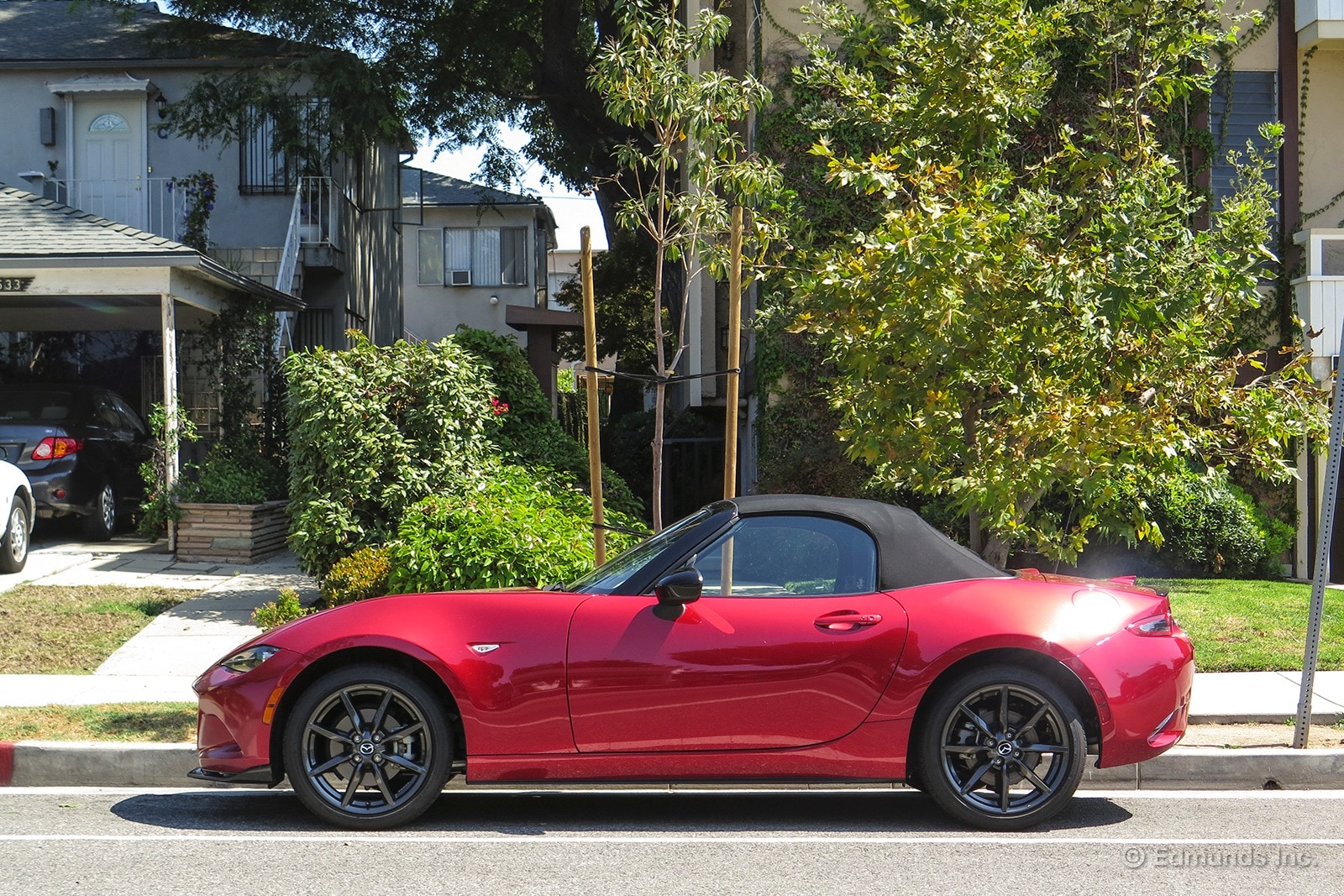
I really enjoy driving our long-term 2016 Mazda MX-5 Miata. It's easy to steer, easy to park and, perhaps most importantly, easy to stop. The brakes are well-calibrated for stop-and-go stuff, which is always nice, but the Miata's heavy-braking skills are worth noting, too.
At the Edmunds test track, we measure braking distances in a simulated panic stop from 60 mph. When we tested our Miata, it did the deed in 108 feet.
To put that in perspective, a base 2016 Nissan 370Z stopped in 114 feet, a Ford Focus ST needed 109 feet and the Camaro SS and Ford Shelby GT350 checked in at 102 and 101 feet, respectively, with their super-sticky shoes. I'd say the Miata acquits itself pretty well in this company.
What's more, the Miata's brakes have staying power. Hit the pedal repeatedly (think enthusiastic canyon driving) and there's little sign of fade. That gives you the confidence to drive harder for longer. It's just part of what makes this car such a joy to drive.
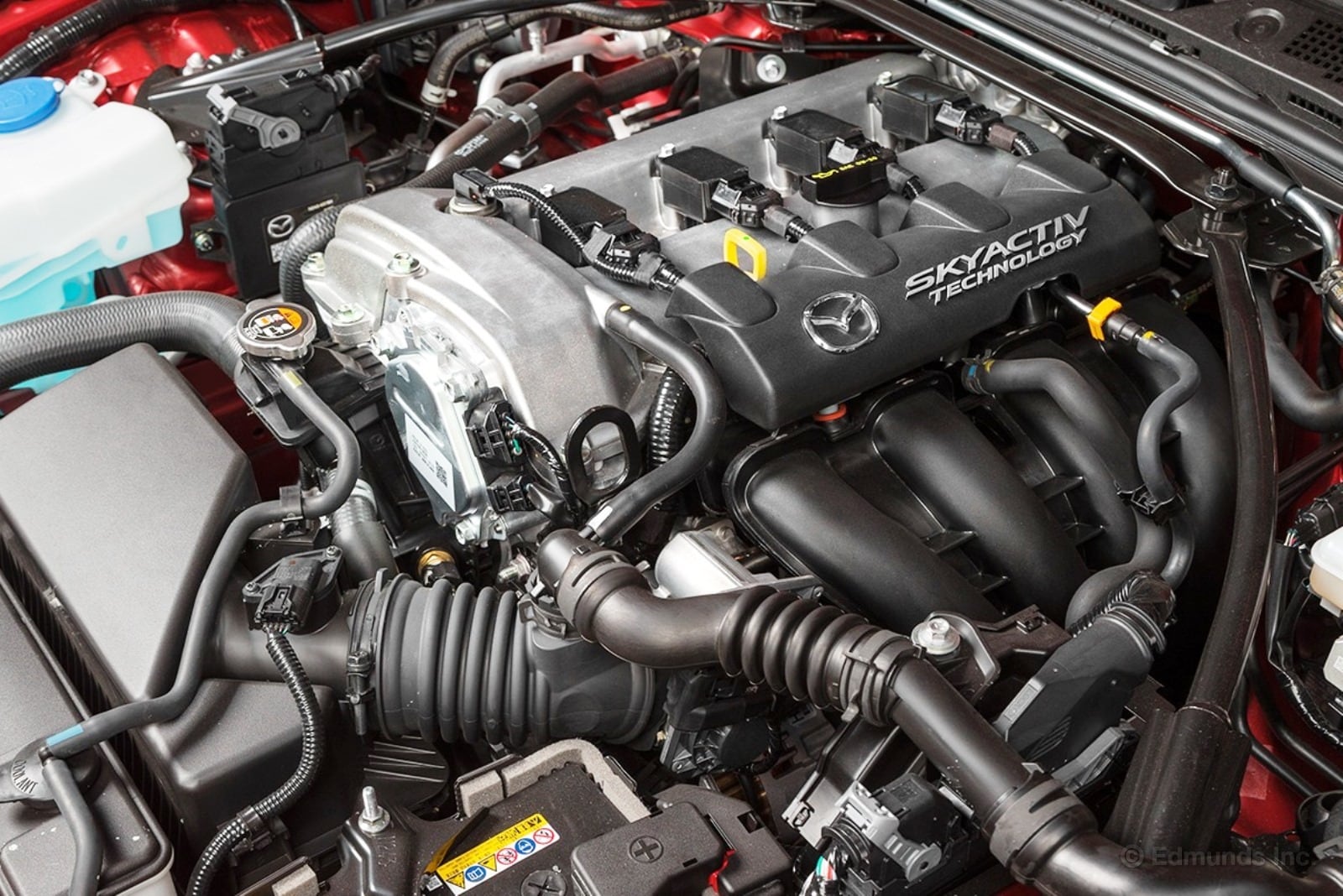
Our long-term 2016 Mazda MX-5 Miata set a couple of new high-water marks during August, breaking the records for both range and single-tank fuel economy.
How, you ask? Terrific question. Turns out, it wasn't very difficult.
In August, the Miata traveled a shade more than 2,000 miles. It notched a 347.1-mile range on one tank, and on the next tank it achieved 41.6 mpg. This latter result wasn't over a full tank; rather, it was refueled after driving 160 miles, or about a half-tank.
Still, it's a strong performance that contributed to the Miata's average of 31.9 mpg for the entire month, comfortably eclipsing the window sticker's combined rating of 30 mpg.
This is just another example of Mazda's "SkyActiv" fuel-efficiency philosophy delivering results in the real-world. A sports car is the last kind of vehicle you'd expect to be outperforming its window sticker. Yet our long-term Miata does it with ease. To wit, the two tanks described above were part of a trip by an editor who wasn't even trying to drive in a fuel-sipping fashion. In other words, that wasn't hypermiling, and the numbers could have been even better.
The SkyActiv engine strategy focuses on facilitating a high compression ratio in order to wring out every bit of efficiency. The Miata clocks in at 13:1 compression (it's 14:1 for the Euro-spec car). But the secret sauce is all the engine-nerd sweating that keeps that sky-high compression from pinging the engine to death. There's no one thing that is responsible, and that's why SkyActiv seems like such a nebulous concept.
But if you want a mental touchstone for the engine side of SkyActiv, just think "SkyActiv equals high compression...plus the countless details that went into making it actually pay off."
Worst Fill MPG: 22.2
Best Fill MPG: 41.6
Average Lifetime MPG: 30.1
EPA MPG Rating: 30 Combined (27 City/34 Highway)
Best Range: 347.1 miles
(NOTE: Cars are sometimes refueled well before their fuel tanks approach empty. As such, the "best" and "worst" entries above are not necessarily the result of an entire tank's worth of driving.)
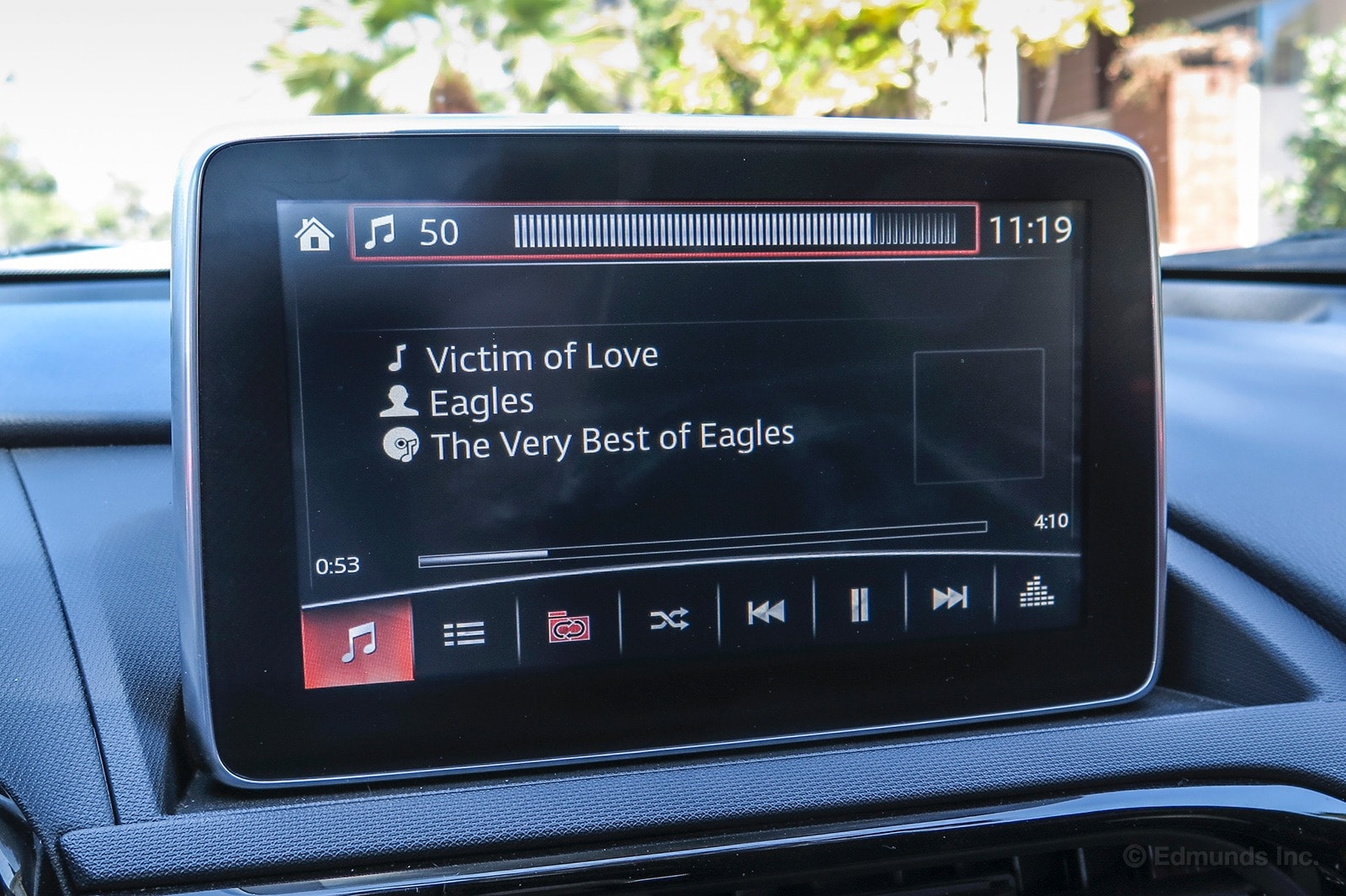
I have no idea what Sadlier is rambling on about. The Bose stereo in our long-term 2016 Mazda MX-5 Miata is great. Okay, so it doesn't have the sophisticated sound or controls that audiophiles might be looking for, but you can drive it with the top down and still hear the music. And for this little roadster, that's enough.
So many systems top out before they reach an ideal, ear-splitting volume. Our long-term Toyota Tacoma comes to mind. Even its loudest volume is too soft for sufficient rocking.
But in the Miata, you can just put the top down (in less than 2 seconds), connect your music collection, pick your favorite epic rock ballad and crank it up to fifty. That's well shy of the maximum, but it's still loud enough to enjoy an old favorite or some modern guilty-pleasure pop song.
Maybe Josh has a more keenly tuned ear than I do, or perhaps he's listening to a bunch of boring podcasts when he's driving a convertible (Picture me rollin', Langness. -Ed.), but I like the 9-speaker Bose stereo in our Miata just fine.
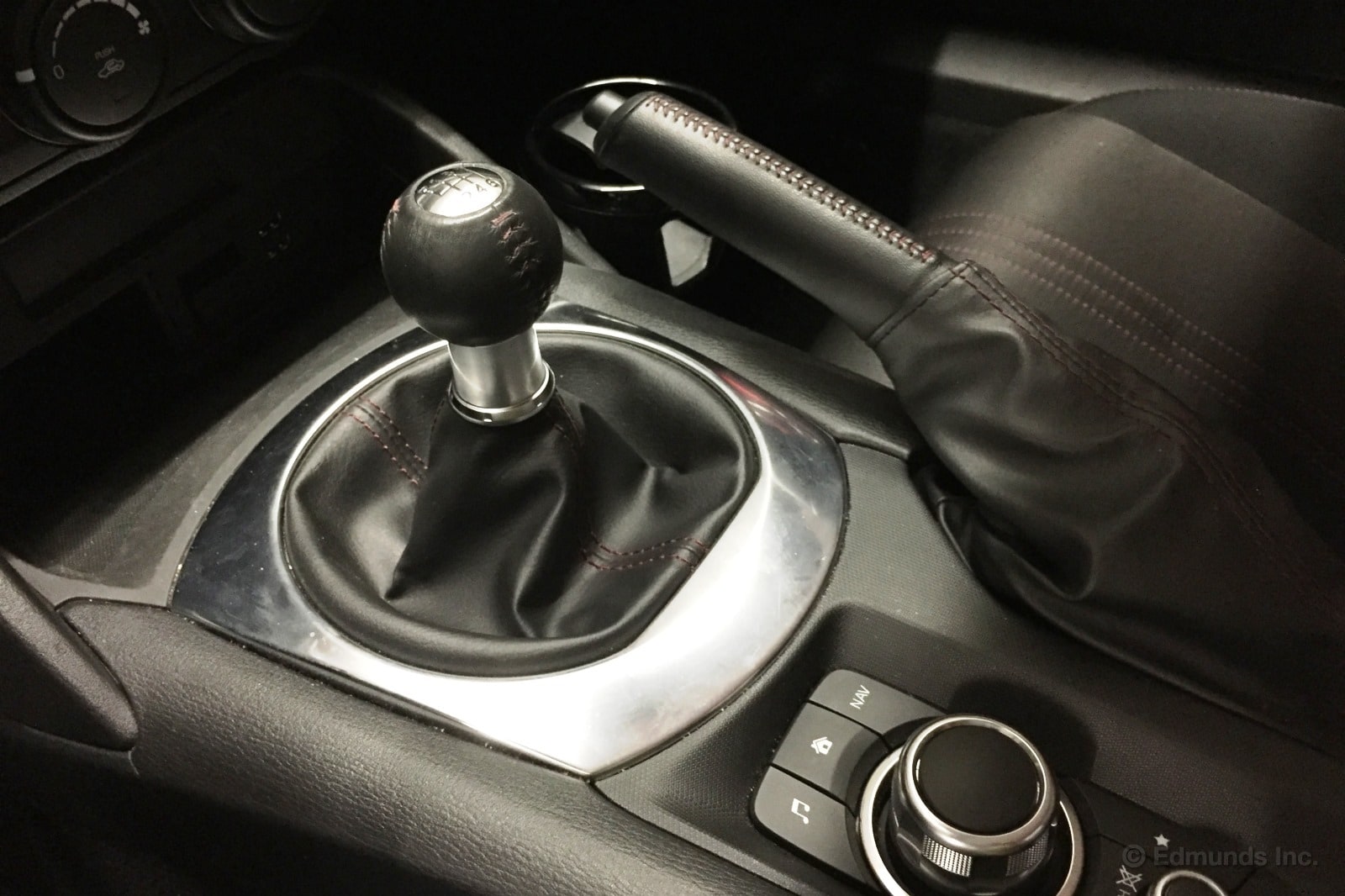
Our long-term 2016 Mazda MX-5 Miata has a subtle buzz that occasionally emanates from the transmission.
Not to worry, there's nothing wrong. In fact, it suggests something is very right.
If you let the Miata's engine coast down from high-ish revs while in gear, you will probably hear a light buzz within a certain rev range. Actually, "buzz" is too strong a word. It's more of a "shussssh" sound.
This is classic "lightweight flywheel" gear noise. Many cars that have their stock, heavy flywheel replaced with a lighter one for zippier throttle response will exhibit this phenomenon. Basically, the inertia of the stock flywheel does a better job of soaking up the noise from the transmission's synchronizers.
But our Miata has a stock flywheel. So what's going on here?
It turns out that during the development of this generation of Miata, one engineering team specified a heavy flywheel to ensure the transmission would remain mute under all conditions. Another team reckoned that the heavy flywheel blunted the engine's character and ran counter to the philosophy of a sports car. After some back and forth, it was decided that the latter group was correct, and the lighter flywheel was given the nod. The accompanying "shussssh" noise was considered an acceptable tradeoff in this type of car.
I agree. The sound is hardly objectionable and only crops up in the aforementioned use case. Besides, the kinds of people that would be put off by the noise are also the least likely to drive it in a way that would result in the noise being present. In that respect, the "problem" sort of takes care of itself.
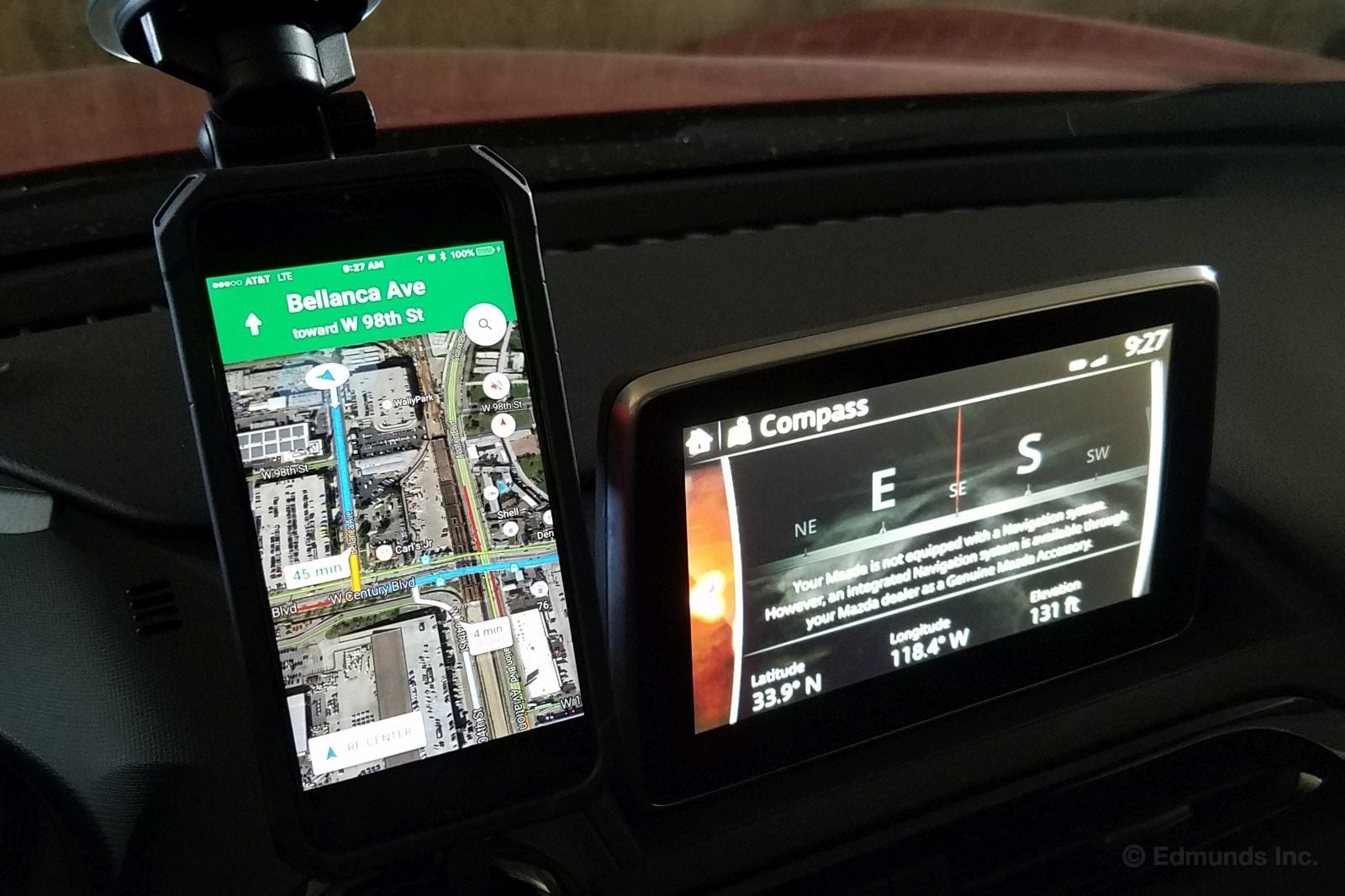
Our 2016 Mazda MX-5 Miata is the Club variant, which is my favorite trim level because of its Bilstein shocks and limited-slip differential. It's the only version that has these nifty bits. The one thing I want that the Club lacks is a navigation system. But that's a shortcoming that can be overcome.
I'm not talking about running Google Maps on a smartphone, although that does work. Some people don't want to drive with a smartphone stuck to their windshield or balanced in an inconvenient nook. Others live in places where data coverage is slim to nonexistent. And not everyone owns a smartphone.
Built-in native navigation solves these problems. Here's how we added it to our Club.

On one end of the Miata trim-level spectrum is the Sport, which is a nonstarter because it lacks the necessary screen-based head unit. On the other end you'll find the top-level Grand Touring, which has a stand-up screen, a single-point control dial and full-fledged navigation. The Club (and other similar mid-level Mazda trims) sits in the middle. It comes with the screen and the controller, but the navigation isn't present. Press the Nav button and you'll get a compass instead.
Hunt around the cabin and you'll see an SD card slot. It's in plain sight in front of our MX-5's shifter; other models hide their SD slots inside the console bin. This slot is the pathway to activating navigation in these cars.
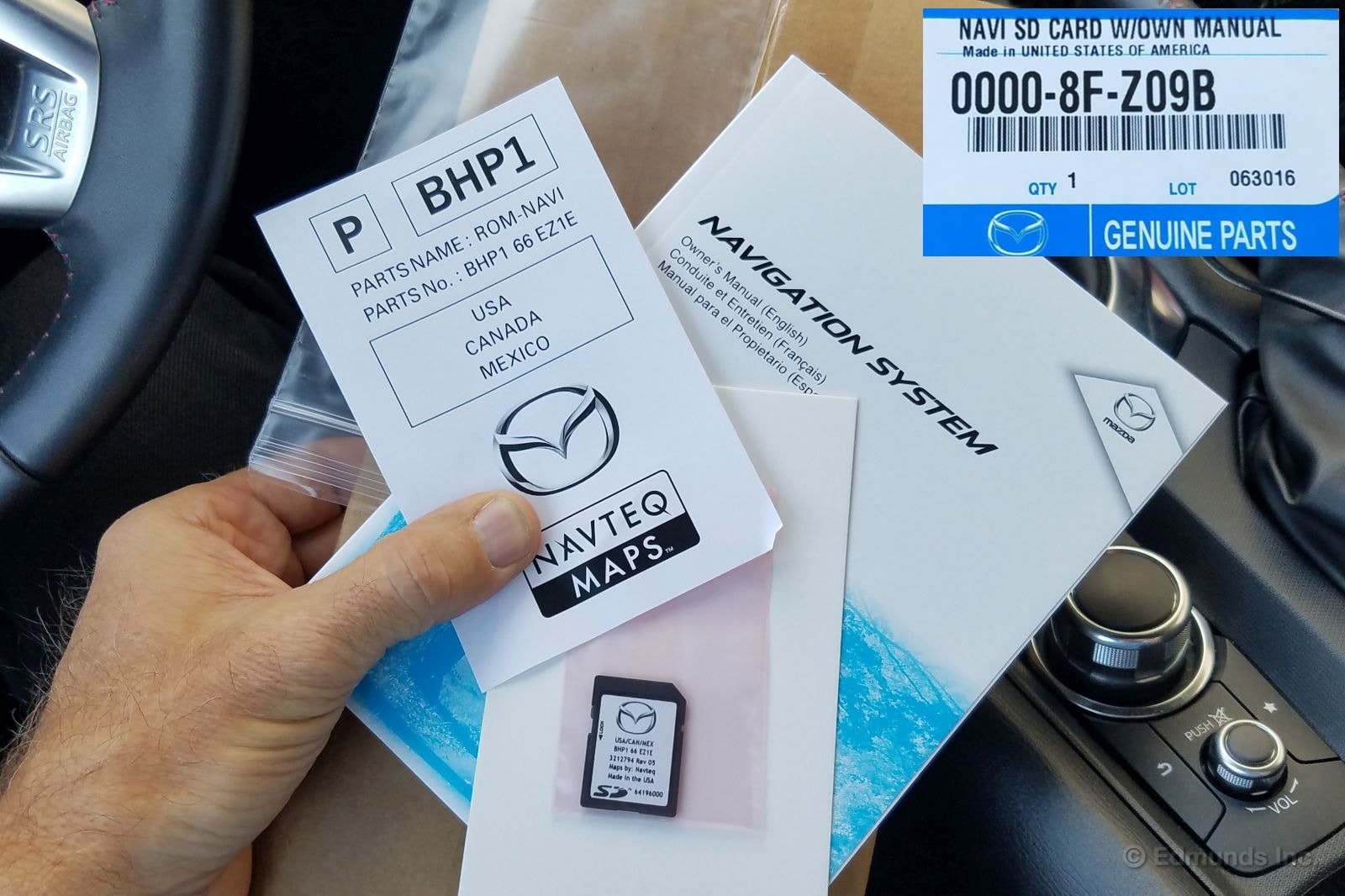
I got my hands on the upgrade, which is a box containing an SD card and a navigation system user's manual. The asking price is $399, and Mazda dealers sell it as an accessory through their parts department. The Mazda part number is 0000-8F-Z09B.
Interestingly, you can fold a navigation upgrade into the initial purchase of a Club and finance it as if it were any other accessory, like floor mats. Or you can buy the car as is without active navigation and see how it goes. If you decide you want it later on, you can simply buy the card from the parts department. Likewise, if at some point in the future you buy a used MX-5 Club and the previous owner didn't activate the navigation, you can easily do it yourself.
I poked around and found an online Mazda parts source — possibly a dealer comfortable with thin margins — selling it for $308. Better deals may be out there on auction sites, but you've got to be very careful. Used ones won't work because the car's VIN number becomes electronically and permanently linked to the card as soon as it's inserted. You have to make sure you're getting a brand-new, genuine Mazda part that's never been used.
Why does it cost that much? Navteq, the supplier, has a virtual lock on map data. They charge accordingly. It's kind of why college textbook prices are so high. If there's a standard textbook for Econ 101, you've got no choice but to buy it, and the publisher has no reason to give you a good deal.
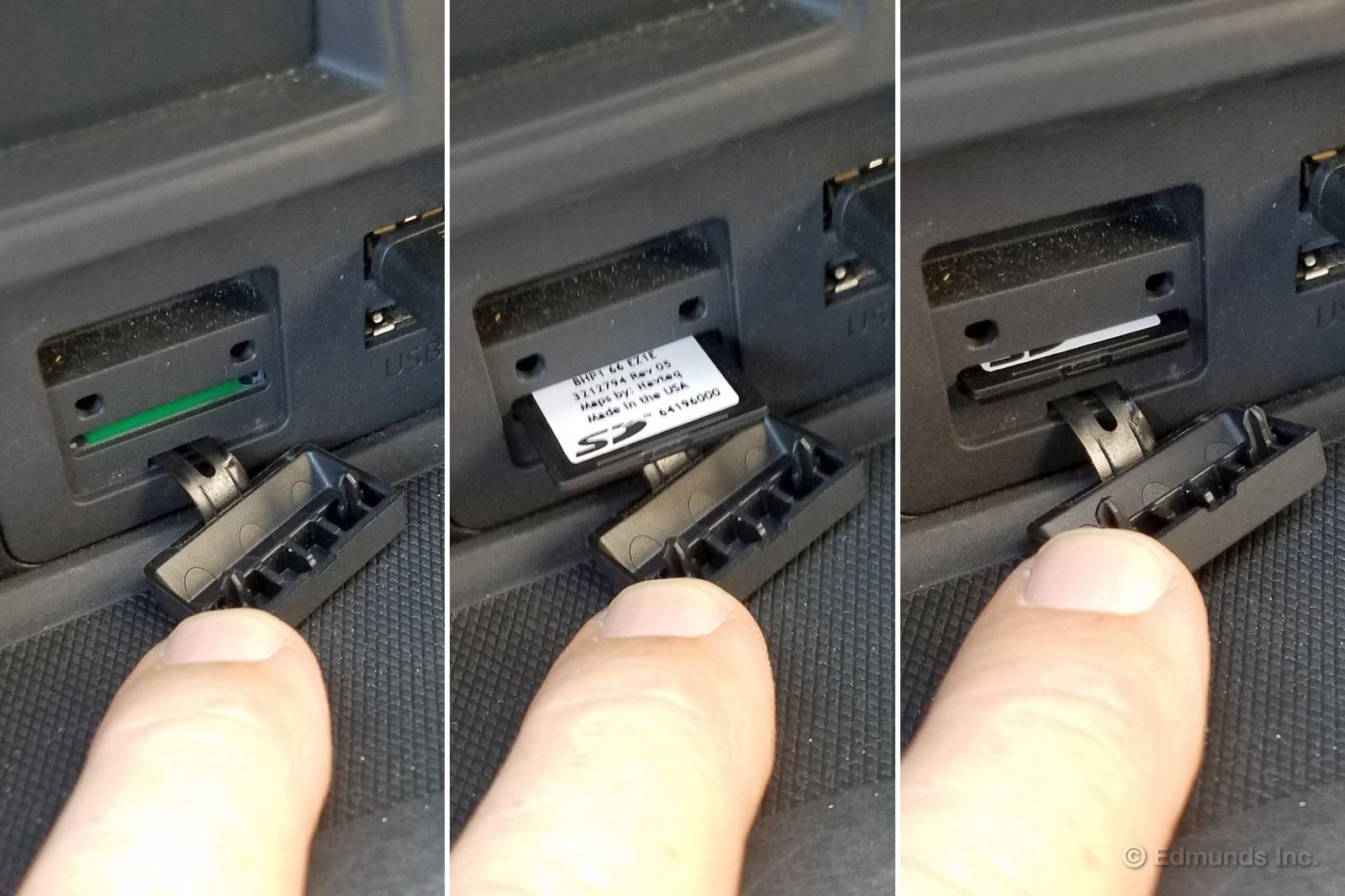
Installing is as easy as one, two, three. You'll close the cover and leave it in there, never to touch it again.
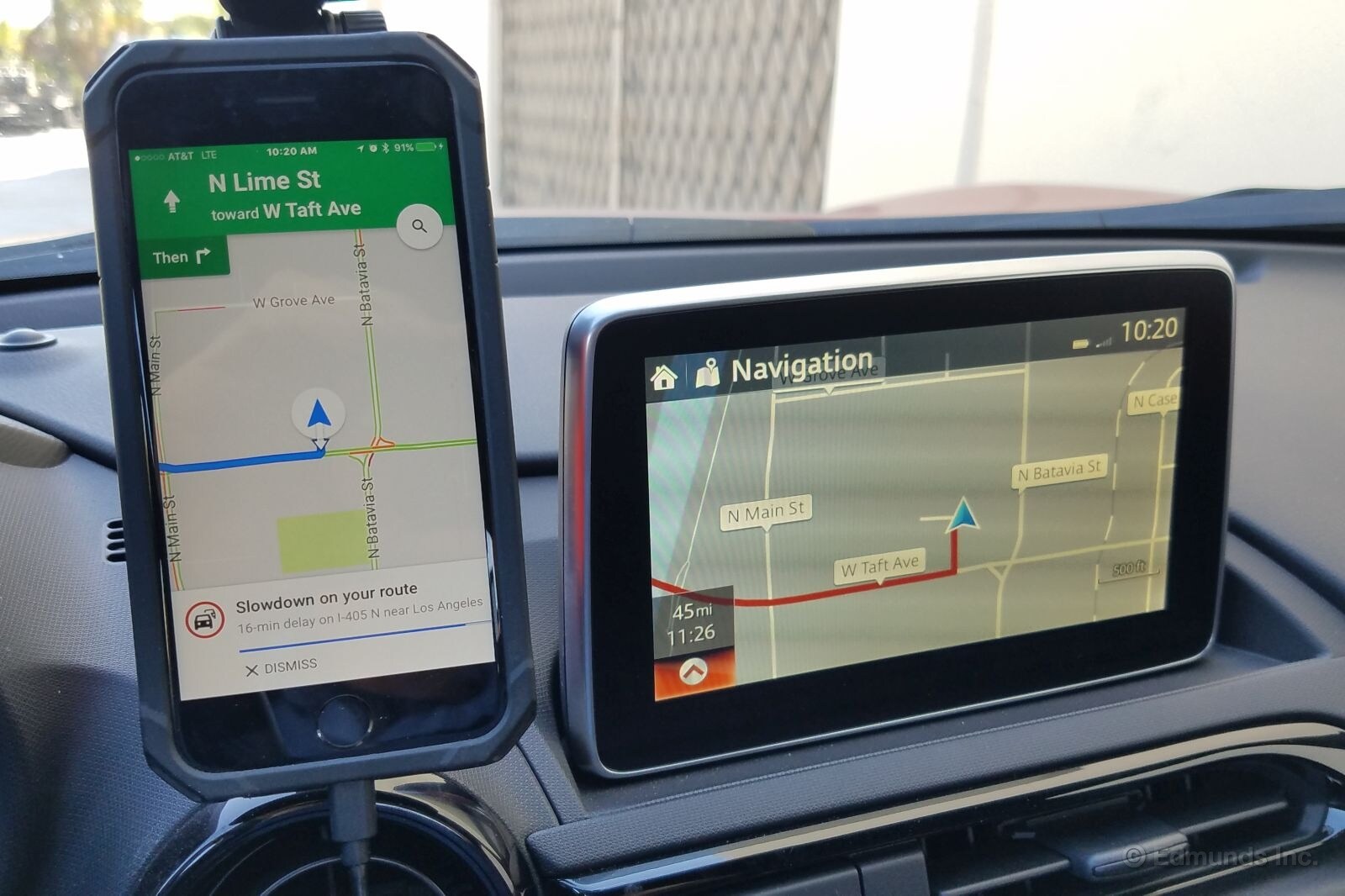
Next time you use the controller and select Nav, you'll get a fully functioning navigation system instead of an electronic compass. If you want a Club for its Bilsteins and limited-slip differential — not to mention its lower price — but you still want navigation, this is your way forward.
Monthly Update for October 2016
Where Did We Drive It?
The Edmunds long-term 2016 Mazda MX-5 Miata may not have seen as many miles in October as the previous month — 1,440 miles versus last month's 4,870 — but that doesn't mean it wasn't eventful. Vehicle Testing Assistant Michael Massey made a point over a long weekend to get some quality seat time, forming a driving bond so strong he even began to turn a similar shade of red.
A short time before that, Dan Edmunds demonstrated how easy it is to install a navigation system if you've got a Club model like ours with the necessary hardware — and likewise, how you might prank a friend by turning the navigation system into a digital compass.
Lastly, our trusty Miata logged some track time at our annual driver's training school, where editors took turns lapping it around a skidpad at Willow Springs Raceway in Rosamond, California. The Miata's ability to communicate fundamental vehicle dynamics make it a perfect tool for those wanting to learn the craft. In fact, we can't think of a vehicle better suited to the job.
What Kind of Fuel Economy Did It Get?
Our 31.8-mpg average for the month of October bumped our overall average up to 31.3 mpg, easily besting the EPA combined estimate of 30 mpg. This is our third-best month since we received the car a year ago, though it's well behind the road-trip-heavy month of September, when we posted a 34.6-mpg average.
Not bad considering how good it feels to run the engine to redline.
Average lifetime mpg: 31.3 mpg
EPA mpg rating: 30 mpg combined (27 city/34 highway)
Best fill mpg: 41.6 mpg
Best range: 401.6 miles
Current odometer: 20,292 miles
Maintenance and Upkeep
After the extensive action in September, our Miata had all but worn through its rubber shoes. A replacement set of four 205/45R-17 Bridgestone Potenza S001 tires set us back a total of $854, including $777 for the tires and, coincidentally, $77 to have them mounted and balanced. Other than that, the Miata needed nothing, but it's about due for another oil change.
Logbook Highlights
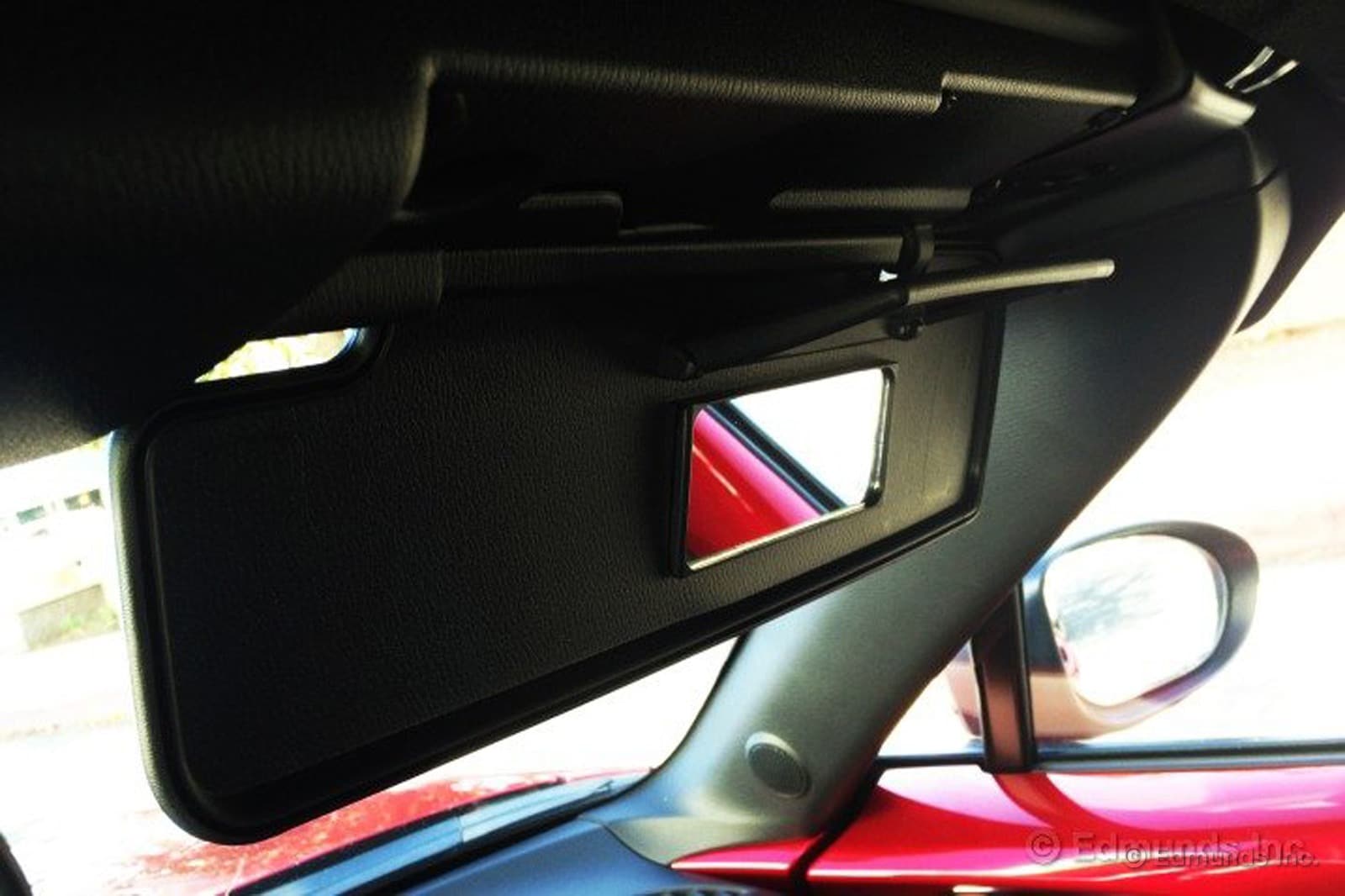
Interior
"I just noticed the Miata's sun visors have permanently fixed inside hinges. This prevents you from unclipping and rotating them to block sunlight beaming in from the side windows." — Jonathan Elfalan, Senior Road Test Editor

Performance
"The Miata is so nimble on the road that you don't need to drive it to its limits to have fun." — Michael Massey, Vehicle Testing Assistant
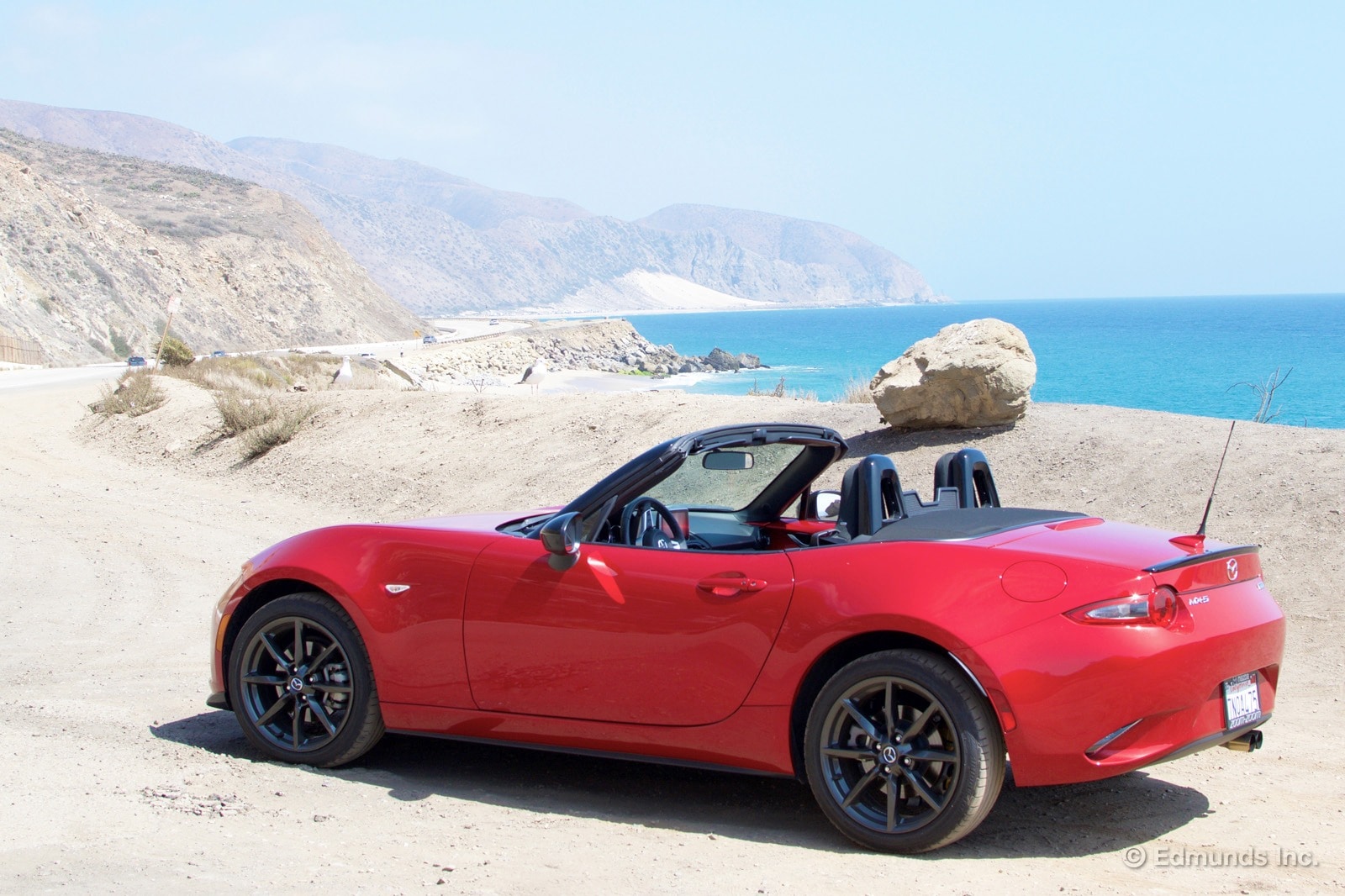
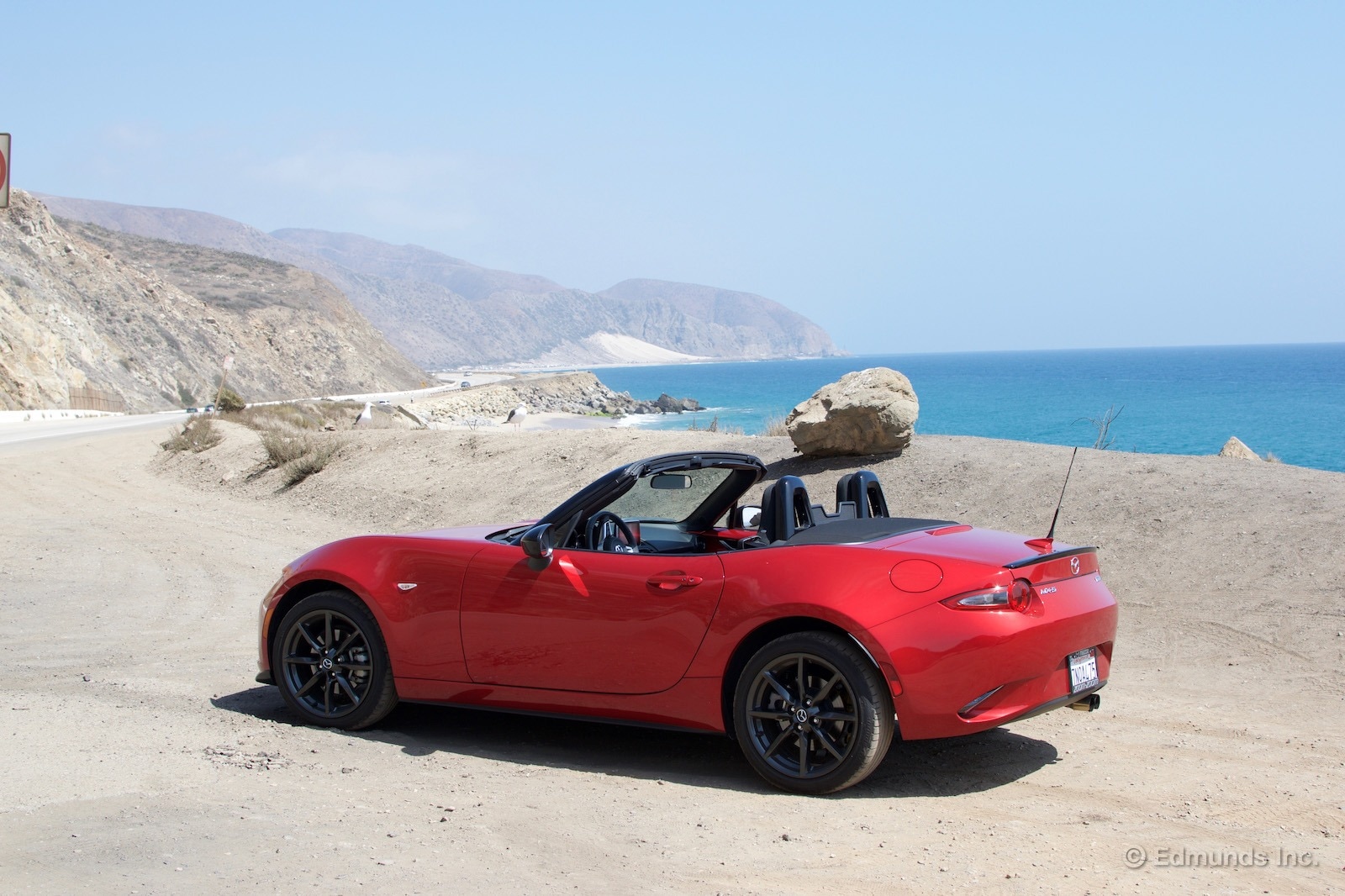
I put over 400 miles on our 2016 Mazda MX-5 Miata during a three-day weekend. It was my first real chance to drive the convertible. I had the top down so much during my travels to Malibu, Ventura and Big Bear Lake that my face and left arm got sunburned.
It was a small price to pay for learning what the Miata's all about.
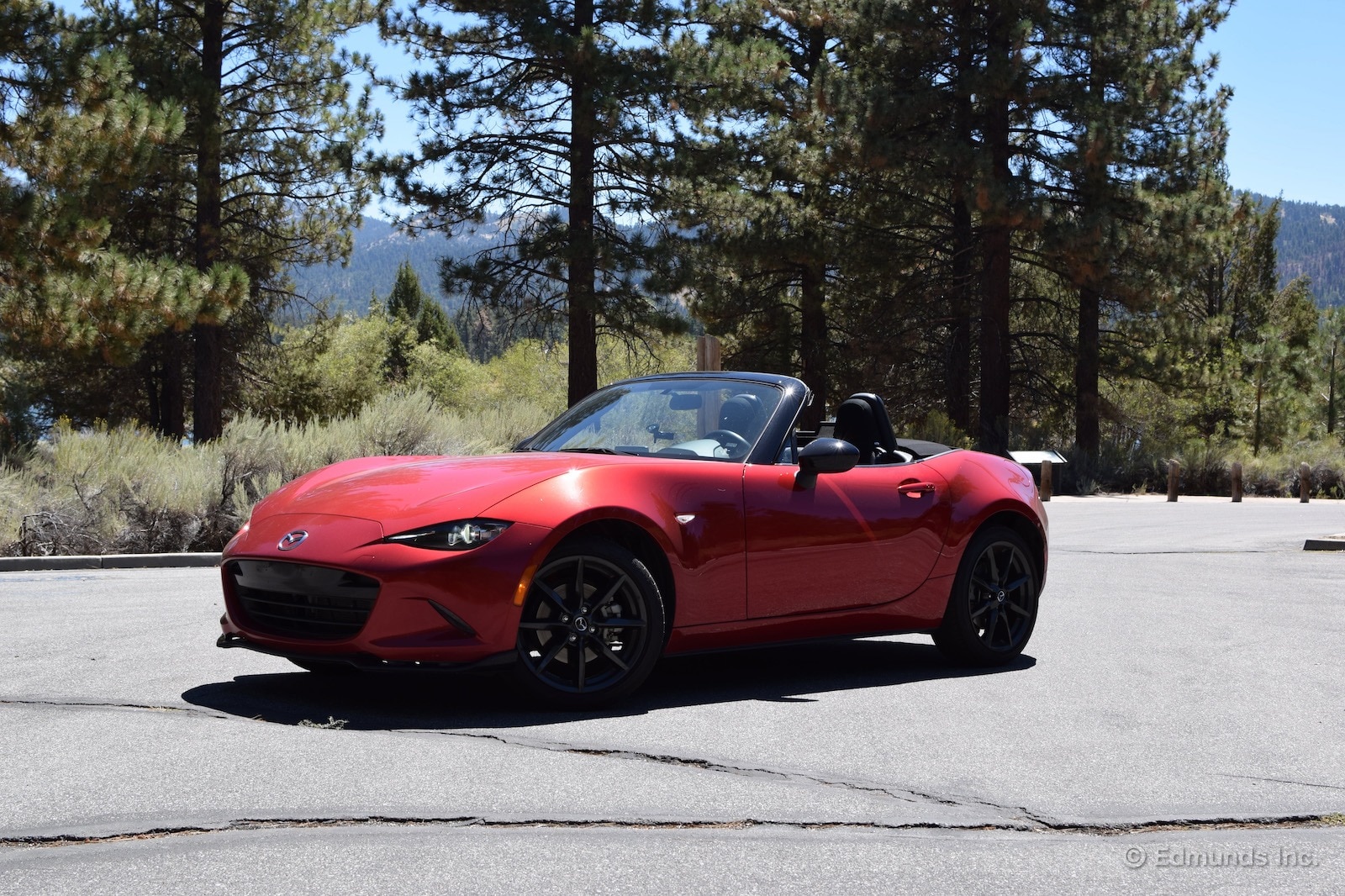
This car was easy for me to connect with and that made it a blast to drive. The shifter was light in my hand and the short throws made it fun to flick between gears. The Miata is so nimble on the road that you don't need to drive it to its limits to have fun.
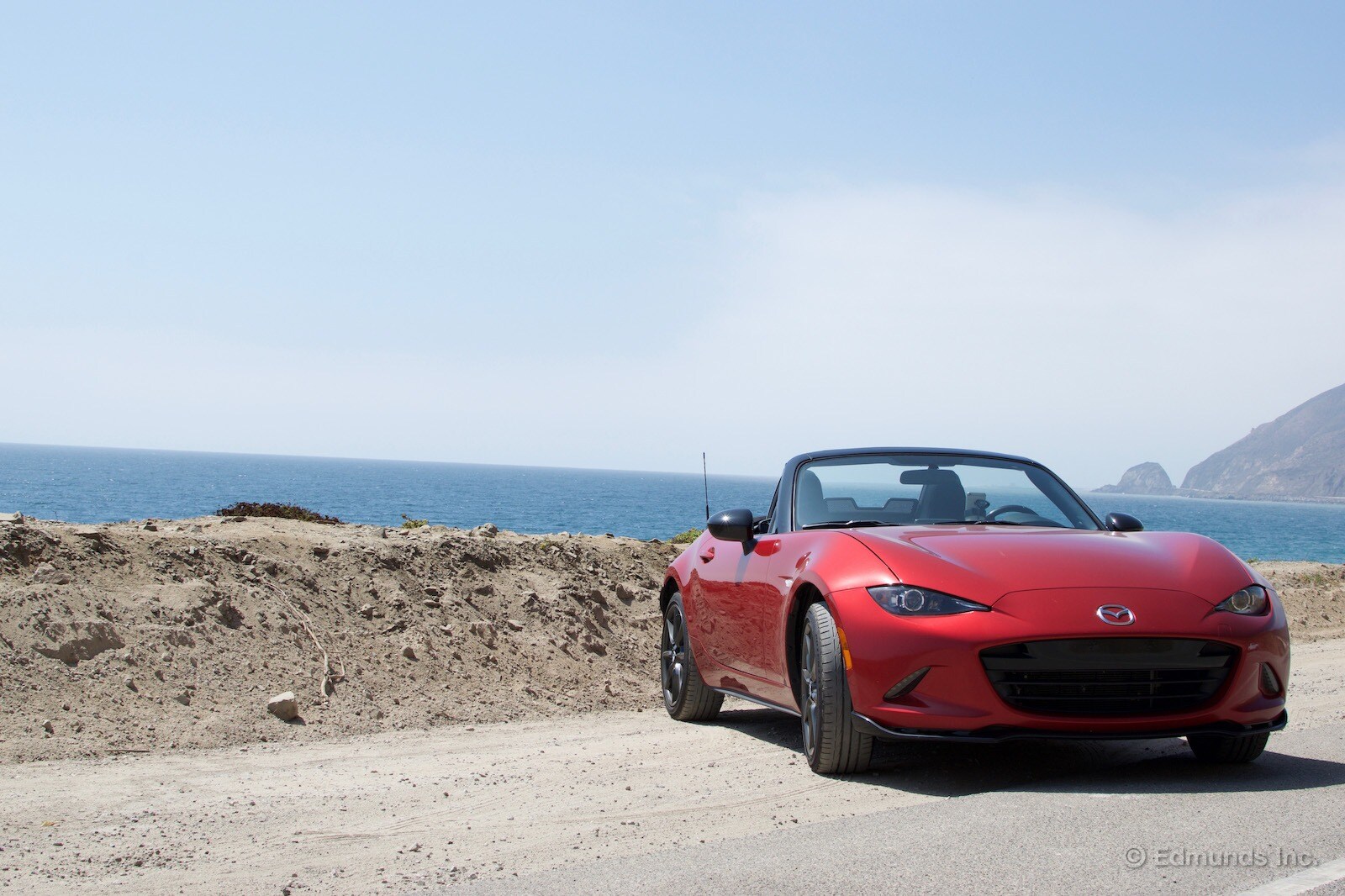
Now I understand why people have such an affinity for this car. It is such a joy to drive, especially without the top. Countless smiles crept across my reddening face over the weekend. I look forward to doing it all over again, just with a little more sunscreen next time.
Monthly Update for November 2016
Where Did We Drive It?
Our long-term 2016 Mazda MX-5 Miata stayed local during November, racking up just a tick more than 800 miles. Doesn't sound like an awful lot, does it? No, and part of the reason is that it encountered a spot of bad luck that sidelined it for a portion of the month. You got it — body-shop time.
Specifically, we found a neat perforation in our Miata's nose, just beneath the driver-side headlight. The culprit was likely an inattentive truck driver who didn't see the Mazda while reversing from a parking stall, but we'll never find out.
Perhaps we need to install an orange flag at each of the Miata's corners. Sheesh.
What Kind of Fuel Economy Did It Get?
City driving does no car any favors when it comes to fuel economy. For the city-heavy month of November, our Miata returned 27.6 mpg. This is among the lowest monthly fuel economy results we've observed yet in the little roadster, although it is nearly bang-on with the EPA city number. We're just used to exceeding it.
The relatively lackluster showing for November dragged the Miata's lifetime fuel economy down to 31.1 mpg, which is 0.2 mpg lower than its running total circa last month.
Average lifetime mpg: 31.1 mpg
EPA mpg rating: 30 mpg combined (27 city/34 highway)
Best fill mpg: 41.6 mpg
Best range: 401.6 miles
Current odometer: 21,104 miles
Maintenance and Upkeep
Our Miata's trip to the body shop constituted its only unscheduled hiatus. As of this writing, it's still there. There was no scheduled service this month.
Logbook Highlights
Maintenance
"'Mike, I walked up to the Miata this morning and saw damage on the front bumper. I don't know how it happened. Just wanted to bring it to your attention,' he said. This sort of thing happens on occasion, and it is never pleasant to hear. Only option now is to fix it." — Mike Schmidt, Senior Manager, Vehicle Testing
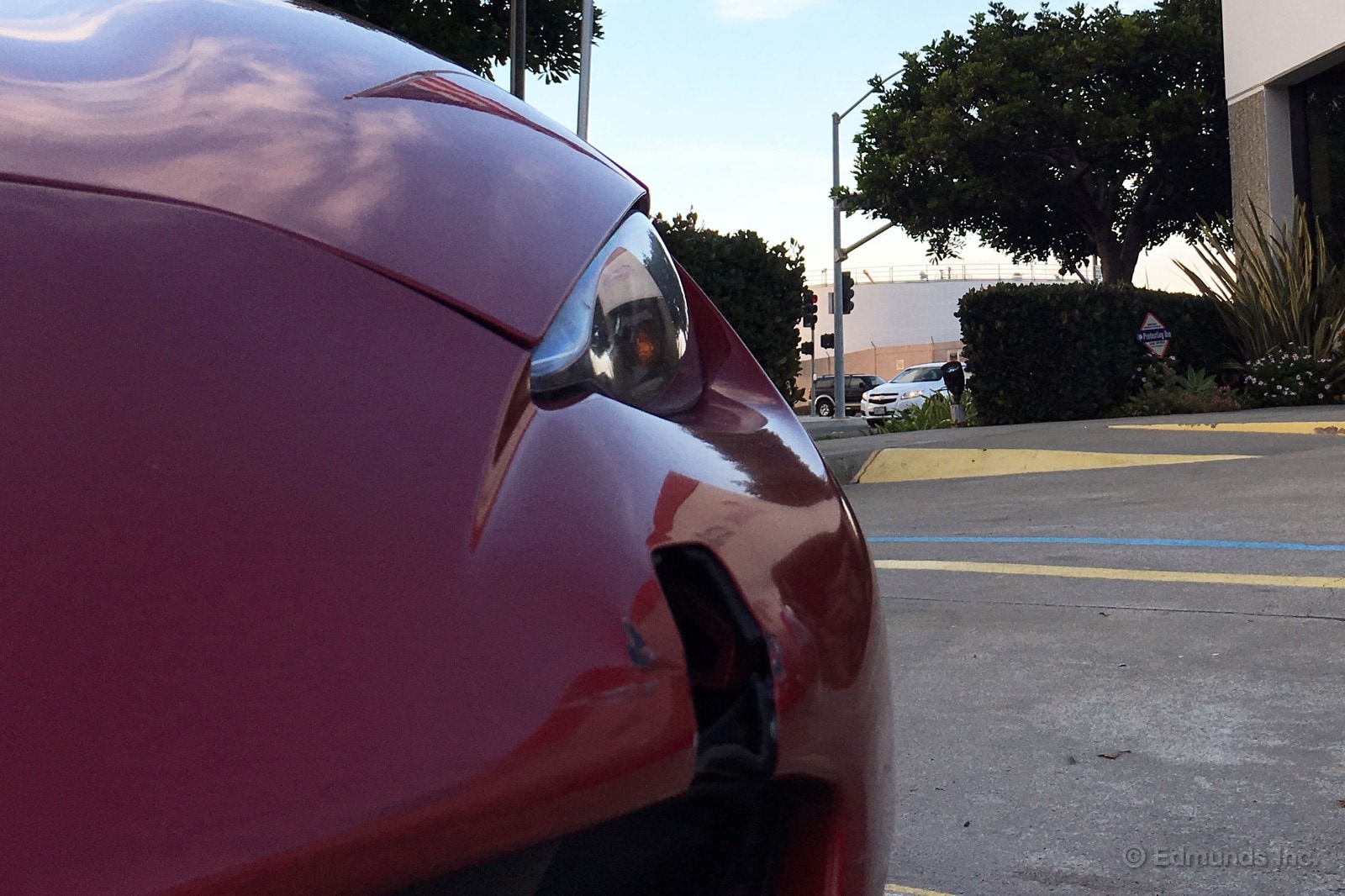
Miscellaneous
"Fun fact — the Miata has LED headlights because they made the car smaller. The shallower depth of LED headlight assemblies commanded less real estate than other lighting technologies, allowing Mazda's engineers to shorten the Miata's front overhang. It wasn't the superior power consumption or longevity of LEDs that led this decision, though those factors weren't ignored. I'm reminded of this every time I approach the Miata's compact, taut front overhang. Form follows function, but this function certainly has form." — Jason Kavanagh, Engineering Editor
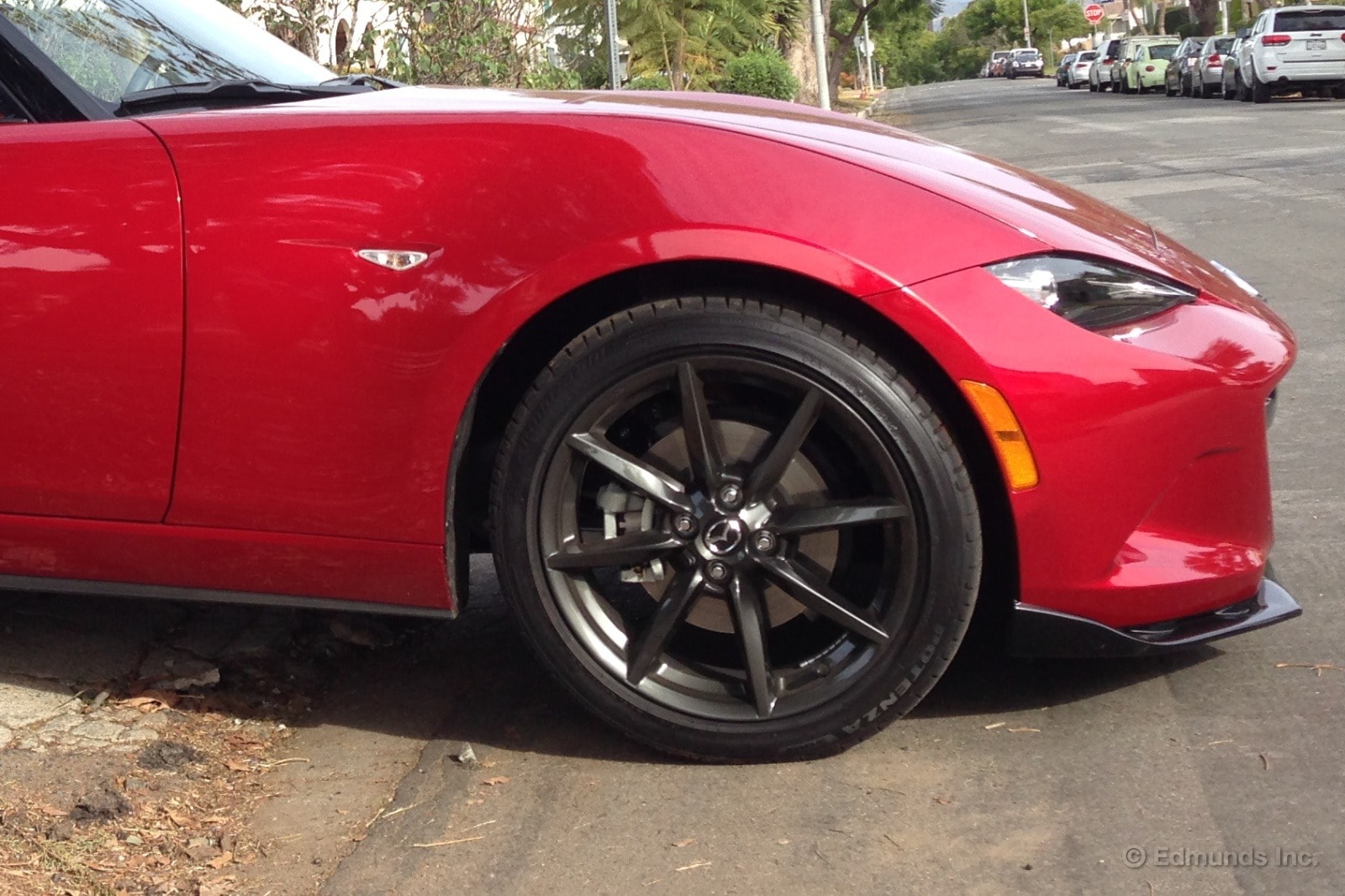
Performance
"The Miata is a seriously small and lightweight car, but that doesn't mean you feel unsafe on the highway. High-speed stability is exceptional. I could do with a little (OK, a lot) less road and engine noise, but the composure of this chassis is top-notch. Incidentally, I took the rock 'n' roll photos at the Duran Duran concert that Mazda put on for the ND Miata's introduction. It really happened." — Josh Sadlier, Content Strategist
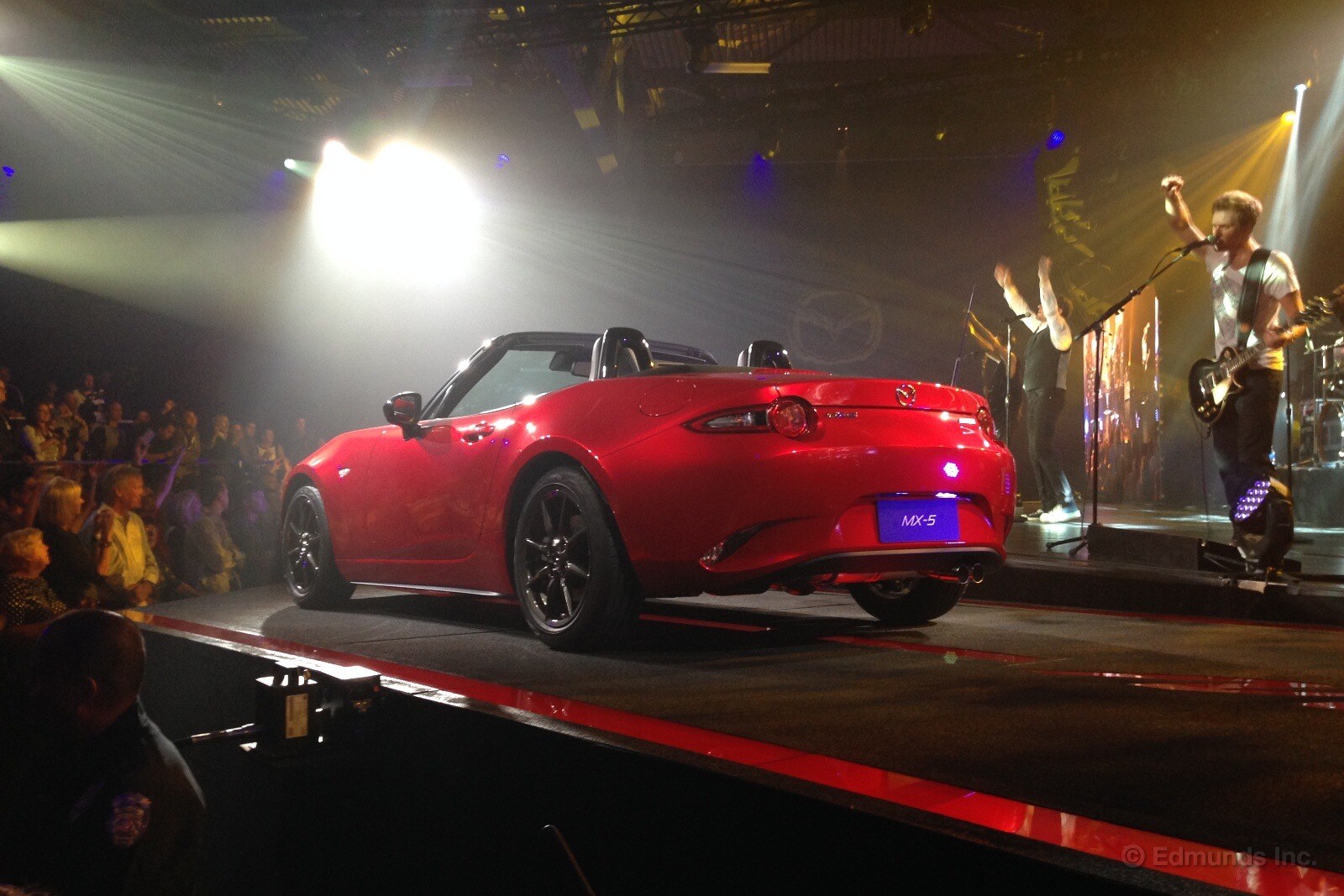
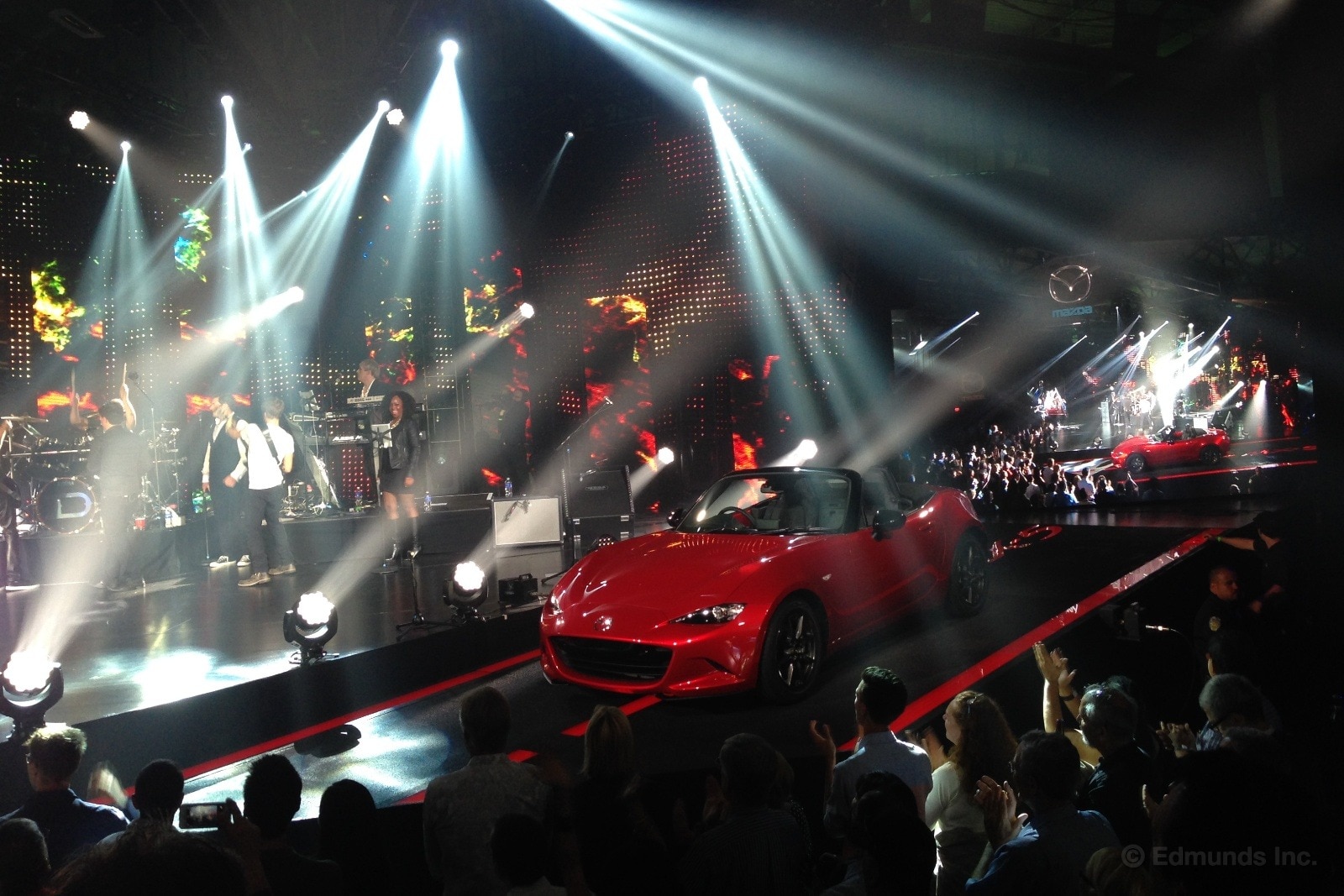
False TPMS Warning and a Flat Tire Scare
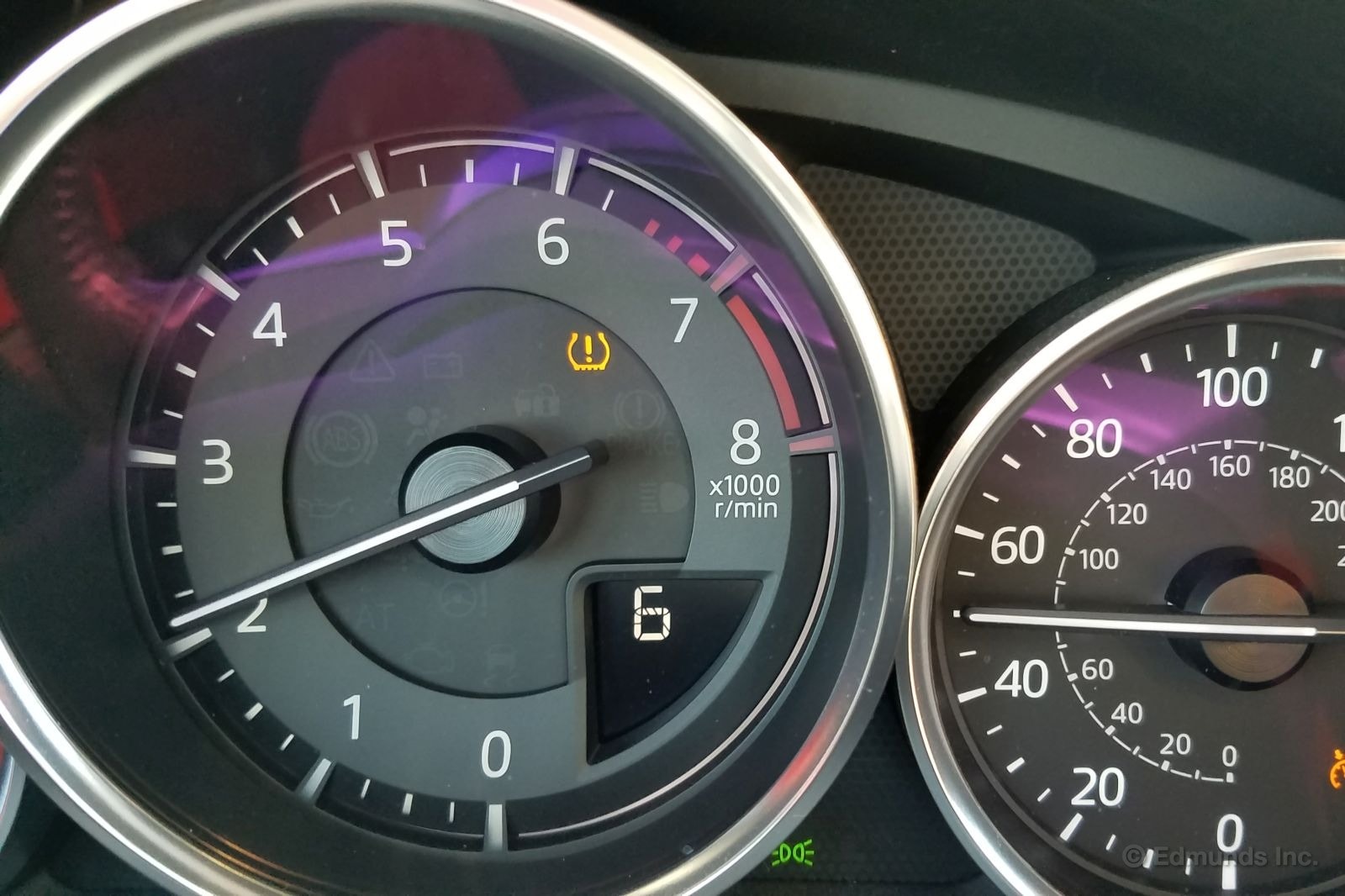
I was in the middle of nowhere in the Arizona desert on the first day of a cross-country trip to Texas in our 2016 Mazda MX-5 Miata when the tire pressure monitoring system's (TPMS) low-tire warning light came on.
Oh, great.
My initial concern turned to confusion after I stopped and inspected the tires. None of them looked low or even different from one another. And I found no embedded debris that might suggest a slow leak.
But I couldn't be certain I was in the clear because I had neglected to bring my tire gauge. Instead I pulled over and tried the trucker's "thump test" and heard no discernible tonal difference. I felt comfortable enough to press on as far as the next inhabited area.
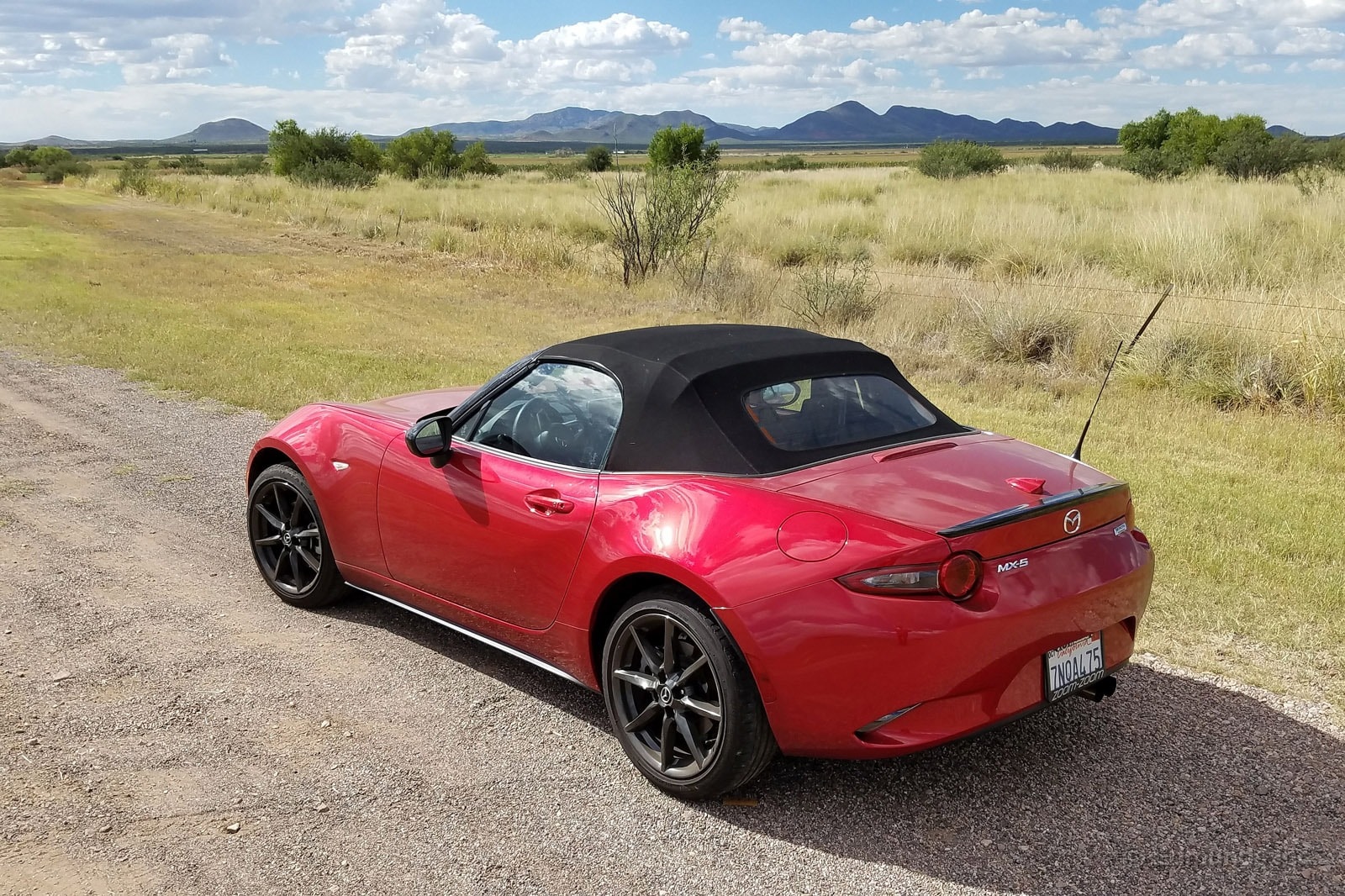
A half-hour later I came upon a small-town gas station, which had an air compressor. The hose's built-in gauge confirmed that none of the tires were low and all were at nearly the same pressure. With the scare over, I relaxed and resumed my trip. But the TPMS warning light continued to burn steadily, mocking me.
I couldn't understand it. Was there a faulty sensor? If that was true, the TPMS light should have been blinking — the standard way such systems alert the driver that the system itself (or an individual sensor) isn't working properly.
It turned out that nothing was amiss. I had made a big assumption that turned out to be wrong.
I assumed the Miata had direct TPMS, the kind with pressure measurement sensors and transmitters inside each wheel. The Miata's lack of a pressure readout screen does not preclude this. There are many examples of cars that monitor pressure for the purpose of issuing warnings but lack the capability to display the pressures to the driver.
I thought indirect TPMS — the kind that uses the ABS' wheel speed sensors to monitor and detect changes in wheel rotation speed to predict a leaking tire — was dead and buried, for two reasons. First, indirect TPMS dates back before there was a rule requiring such systems be fitted to all cars, and the early systems I had come in contact with were never very dependable.
Second, I had conducted TPMS compliance tests at my last job at Hyundai Proving Grounds. The law requiring TPMS was beginning to phase in, and Hyundai was fitting direct TPMS across the board. The federal test procedure defined numerous scenarios in which it must issue a warning, and I tested them all. One of the scenarios was all four tires leaking at once, which seemed impossible for indirect TPMS since all four tires would still rotate at the same speed relative to one another. The other engineers I knew seemed to agree that even though the law was "technology neutral" and did not seem to require direct TPMS, the test procedure seemed impossible to pass reliably without it.
This worldview began to unravel when I scanned the Miata's owner's manual. It didn't come out and specify whether it had direct or indirect TPMS, but it pointed out the location of a TPMS reset button that cars with direct TPMS generally do not need. A call to a Mazda engineer I know confirmed that the 2016 Miata indeed has indirect TPMS.
I pushed the button and the light went out. After that, it all fell into place.
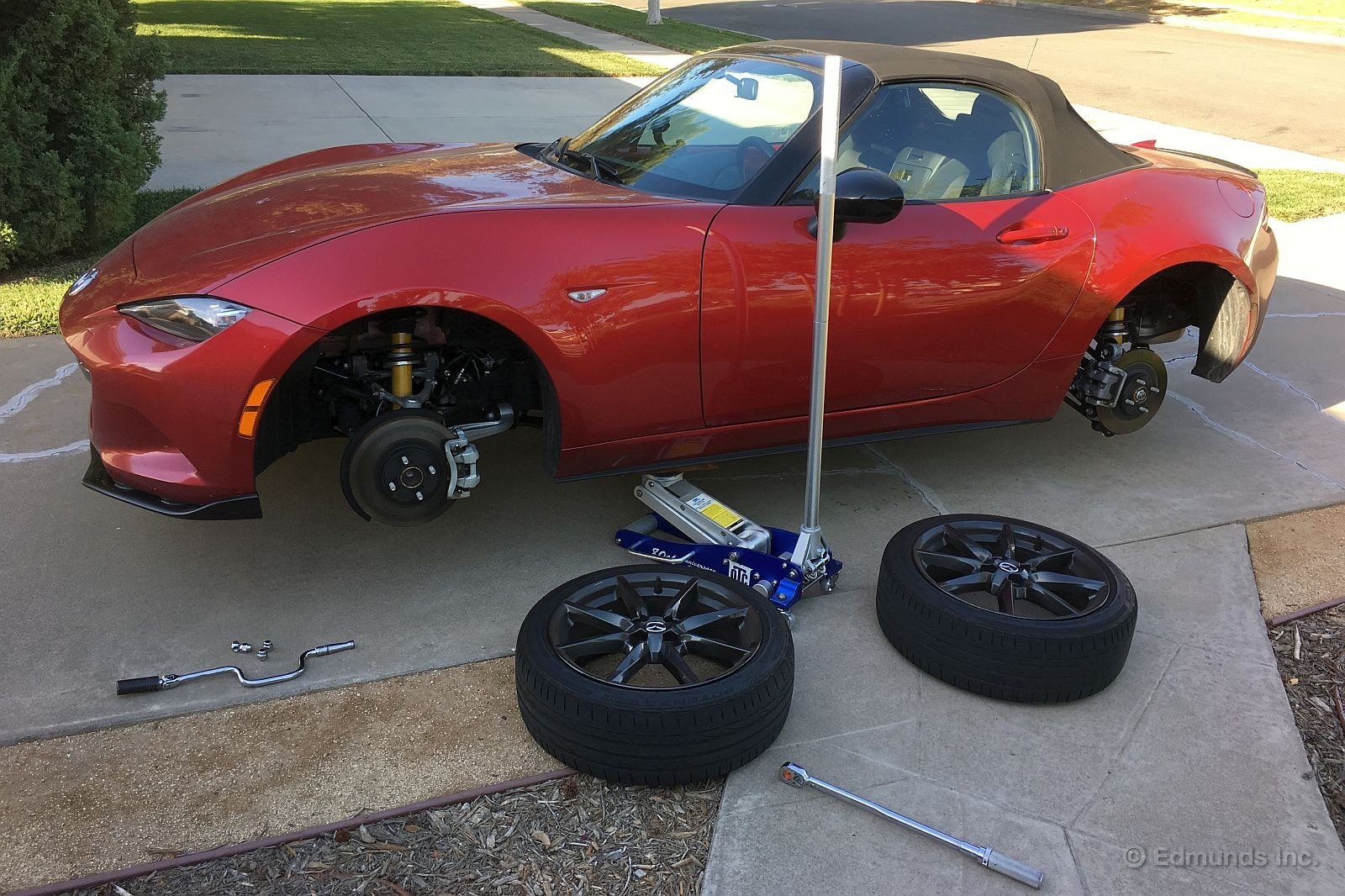
Before I left town I had rotated the tires in my driveway, checked the pressures and torqued the wheels. But I hadn't pressed the TPMS reset button because I didn't know I had to.
This matters because the computer in an indirect system monitors and learns the rotation speed of each tire. Gradual changes due to tire wear are accounted for, even if the rear tires wear at a quicker rate than the fronts, as they generally do on this car. I rotated the tires front to back to make sure they lasted to Texas and back, but in so doing I created a step-change in the tire rotation speed at each corner. A TPMS reset would have told the computer not to be concerned, but I hadn't done it.
This would make perfect sense if not for one more fact: The warning didn't come on until I was some seven hours and 450 miles into my trip. That's a long time for a TPMS to respond. The federal test procedure I'd used back in the day allowed no more than 20 minutes. I might have put two and two together if it had happened soon after I left home.
So now I'm still confused, but for an entirely different reason. I know why it happened, but I still don't know why it took so long for the TPMS to respond. And indirect tire pressure monitoring systems are still out there? I thought they'd done the honorable thing and died out.
Wrap-Up
What We Got
We had our minds made up when it came time to order our 2016 Mazda MX-5 Miata. It was going to be in classic, midlevel Club trim. Sport was too stark for our tastes and Grand Touring too refined. And it was going to have a manual transmission.
Standard features on the Club included a hand-operated cloth soft top, push-button start, LED headlights, cruise control and Bluetooth integration. We equipped ours with the six-speed manual to add a sport-tuned suspension, shock tower brace, a limited-slip differential, 17-inch wheels and summer tires. Interior novelties such as a nine-speaker stereo and a 7-inch display screen sprinkled in some refinement. All Miatas share the same 155-horsepower, 2.0-liter four-cylinder engine and are rear-wheel-drive.
Our Club had a base price of $28,600. Optional Soul Red paint ($300) and keyless entry ($130) brought the total MSRP for this 2016 Mazda MX-5 Miata Club to $29,850 (including $820 destination). Here's what it was like to drive it day in and day out:
Performance
"The new Miata's greatness shined through on the most mundane of streets. The genius of this car is how engaging it is even when you're going to the post office to buy stamps. It forges a connection between machine and driver at two-tenths like no other car I've ever driven. I absolutely love it. I need one of my own." — Dan Edmunds, Director, Vehicle Testing
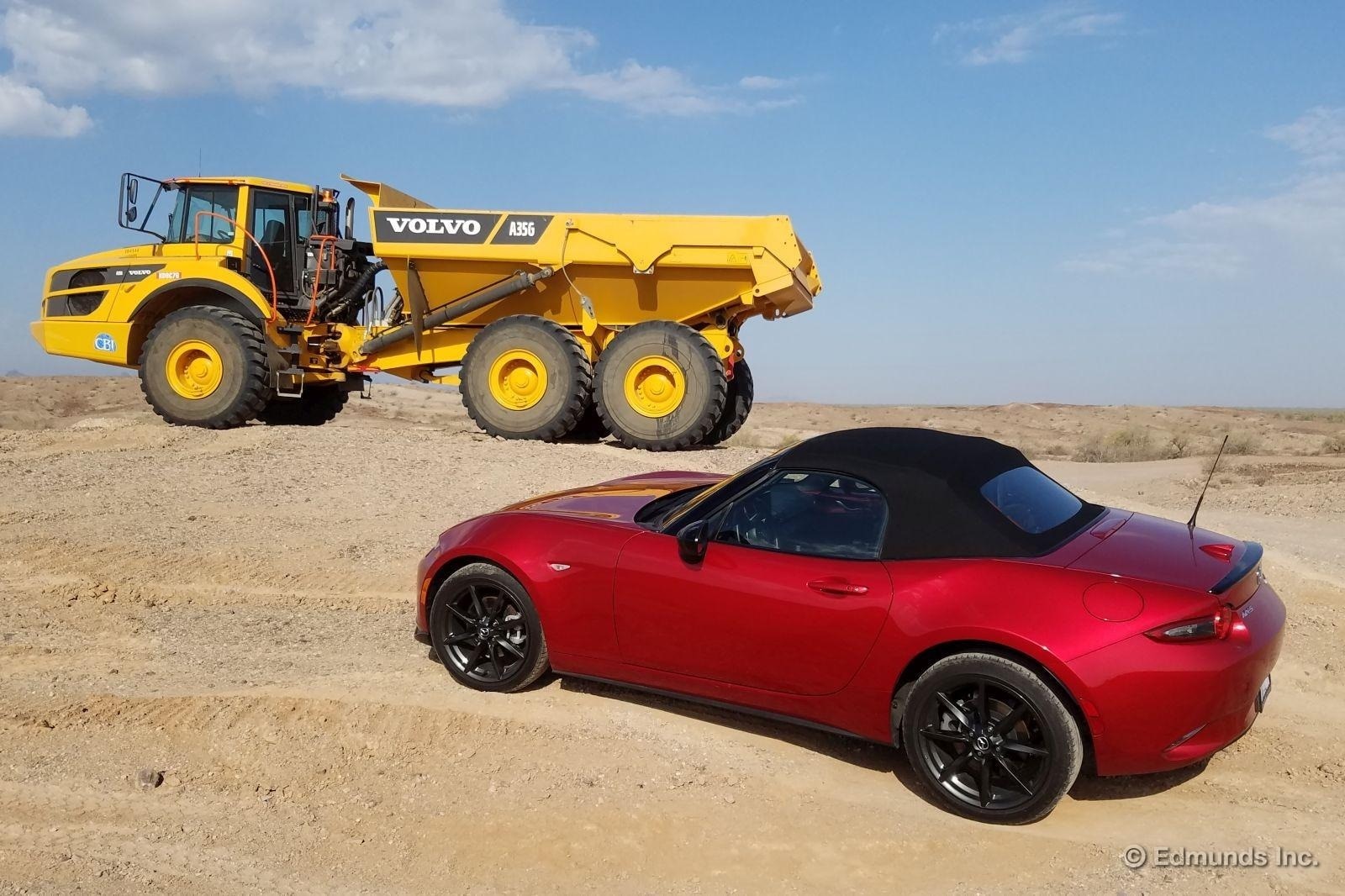
"It's easy to scoff at the idea of buying a convertible like our Miata: two seats, tiny trunk and a roof you can cut through with a pair of scissors. Then you drive it on a nice day and all those things suddenly seem like minor inconveniences. ... I was surprised by how enjoyable the Miata is with the top down." — Ed Hellwig, Executive Editor
MPG
"The 2016 Miata's four-cylinder is almost mini V8-like in character. Not V8-like is its fuel economy. The 2016 Miata checks in with 30 mpg for the EPA's combined fuel economy average. Last year, it was 24 mpg with the six-speed manual. That's real savings going into your pocket each year." — Brent Romans, Senior Automotive Editor
"In August, the Miata traveled a shade more than 2,000 miles. It notched a 347.1-mile range on one tank, and on the next tank it achieved 41.6 mpg. This latter result wasn't over a full tank; rather, it was refueled after driving 160 miles, or about a half-tank." — Jason Kavanagh, Engineering Editor
Comfort
"The new MX-5 is considerably more accommodating of my lanky frame than any previous Miata, but it doesn't have the stretch-out room of the 2015 VW GTI. ... It can't. The seats only go back so far before they encounter a bulkhead. Still, I was able to settle in comfortably with the seat in its rearmost position, and the seat itself proved to be supportive for what turned out to be an eight-hour trip." — Dan Edmunds
"As much as I like our Miata, these seats would honestly keep me from buying it. My back and legs start to ache after even short stints in the car. I seem to forget every time I get out, leading me to once again grab the keys." — Reese Counts, Vehicle Testing Assistant
Cargo Space
"It's what every golfer wants to know about any convertible: 'Will my golf bag fit?' And I can attest that the 2016 Mazda MX-5 Miata does indeed have room for your golf bag, as long as you don't mind if it rides shotgun." — Josh Sadlier, Content Strategist
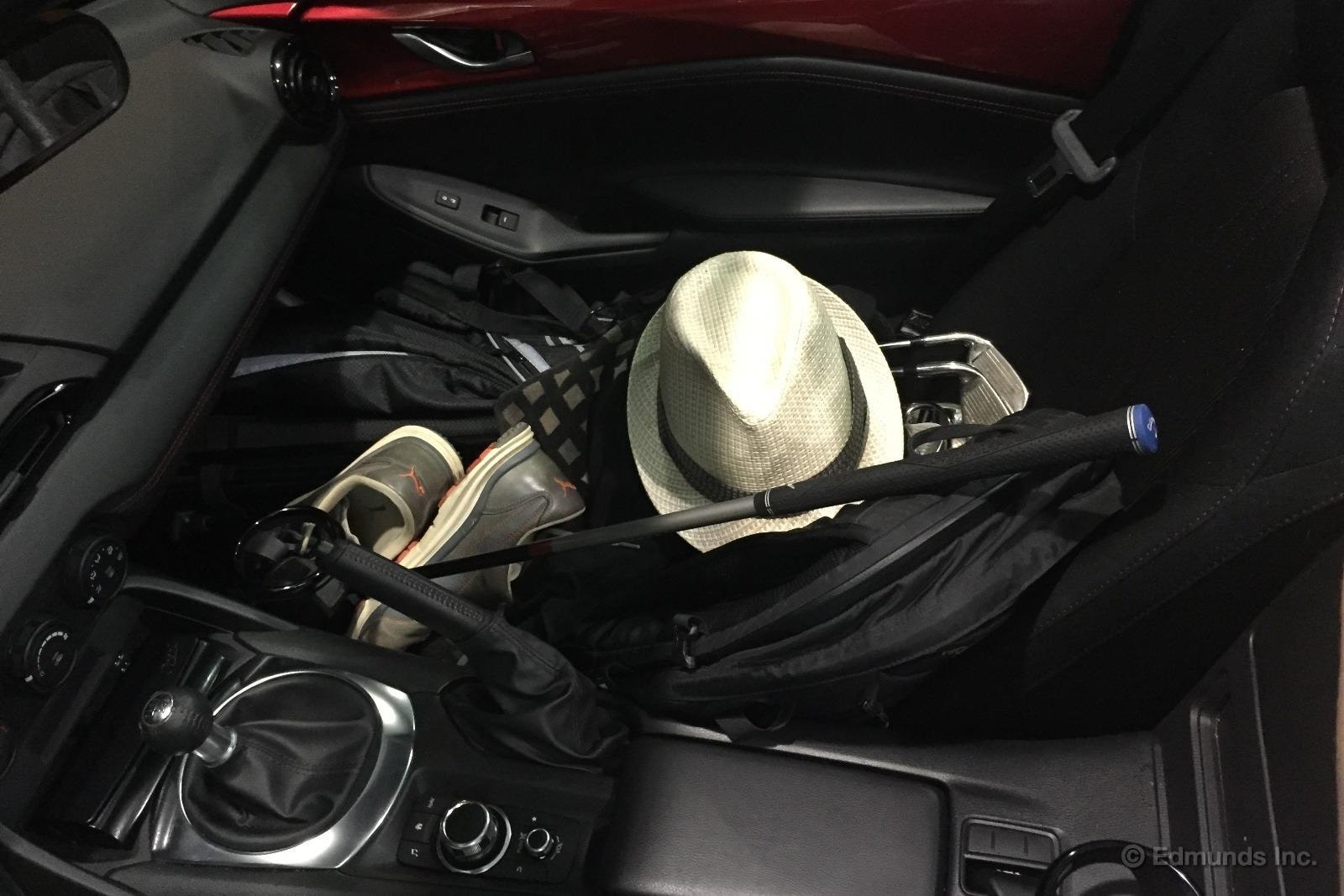
"One carry-on bag fits nicely into the trunk with little room to spare. Our standard checked bag will not fit in either direction. Overall dimensions of the space are roughly 21 inches deep by 28 inches wide at the wheelwells. The seats do not fold to increase cargo capacity. However, if you kick out your passenger and drop the top, almost anything is possible." — Mike Schmidt, Senior Manager, Vehicle Testing
Interior
"I just noticed the Miata's sun visors have permanently fixed inside hinges. This prevents you from unclipping and rotating them to block sunlight beaming in from the side windows." — Jonathan Elfalan, Senior Road Test Editor
"I'm not the least bit surprised that our Miata has a nearly perfect set of gauges. When the sole mission of a car is driving enjoyment, you don't need to crowd the gauge cluster with extraneous extras ... the tachometer front and center, an easy-to-read speedometer and a multifunction binnacle on the left. All of them have crystal-clear white-on-black markings that are readable at a glance." — Ed Hellwig
Audio and Technology
"It was a hot day in Southern California. I hopped in our long-term Miata and got the message above ('Temperature Warning — Display is too hot. Screen performance may be decreased until it cools'). I suppose that's one of the drawbacks of having one of those tabletlike displays that don't retract or aren't covered by a hood." — Mark Takahashi, Automotive Editor
"As for my colleague catching his sleeve on the multimedia knob when going for a gear change, I can only assume his shirts have droopy, flouncy wizard sleeves." — Jason Kavanagh
Maintenance
"'Mike, I walked up to the Miata this morning and saw damage on the front bumper. I don't know how it happened. Just wanted to bring it to your attention,' he said." — Mike Schmidt
"It began when Mark drove through a sandstorm, which caused deep scratches in the windshield. There was a considerable amount of glare whenever the scratched area was hit with sunlight or light from headlamps of opposing traffic. It quickly became apparent that a replacement was necessary." — Cameron Rogers, Associate Editor

Miscellaneous
"The Miata is all about fun. ... It's not about practicality or comfort, or luxury, or anything that doesn't have to do with fun. If you can't fit in it, blame your genetics. If the trunk is too small, you have too much stuff. If it's too stiff or too loud, you lost sight of your childhood. If you think it's underpowered, well, you might actually have something there." — Mark Takahashi
"The Miata's shifter moves through its gates with low effort but not low satisfaction. It glides unusually smoothly through the pattern. Each gate is well defined, and there's no notchiness. But you can feel the little rises and troughs of effort as one cog is deselected and the next one taken up. It's a subtle reminder that you're piloting a machine and helps make it one of the best shifters in any car today." — Jason Kavanagh
Maintenance & Repairs
Regular Maintenance:
Routine service for the Miata was dictated by an onboard meter. Our first checkup was due just past the 10,000-mile mark. It was straightforward and cost a manageable $58. We returned the vehicle to Mazda before reaching the next interval.
Additional maintenance costs were the result of two things: a sandstorm and a track day. We needed a new windshield ($630) and air filter ($21) after a beating at the hands of Mother Nature. And nine months into our test, we volunteered the Mazda for track day duty, adding four new Potenza S001 tires ($850) to the tally.
Service Campaigns:
No recalls were issued during our test.
Fuel Economy and Resale Value
Observed Fuel Economy:
The EPA estimate for the 2016 MX-5 Miata was 30 mpg combined (27 city/34 highway). We averaged 31.1 mpg after 21,000 miles. Our best single fill garnered 41.6 mpg and our worst 22.2 mpg. The best range on a single fill-up was 401.6 miles.
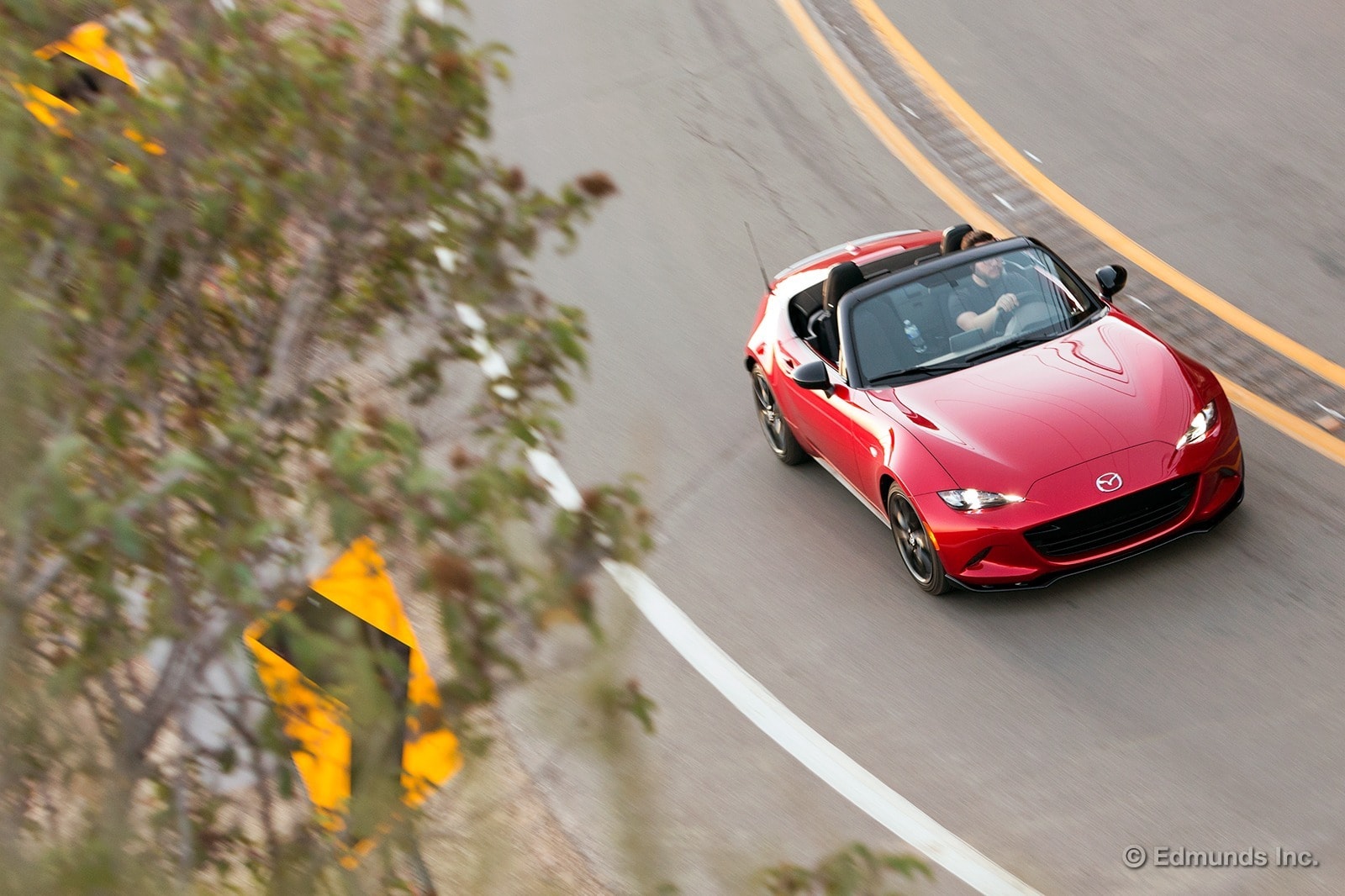
Resale and Depreciation:
Our Miata had an as-tested MSRP of $29,850. At the end of our test Edmunds TMV Calculator valued the convertible at $19,657 based on a private-party sale. That reflected 34 percent depreciation in the first year of ownership.
Summing Up
Pros:
A fantastic driving convertible, even well below its performance threshold. Makes errand-running fun. One of the best shifters in the business.
Cons:
Not everyone found the seats comfortable. It is loud and rides firm. Typical small-car limitations. Minimal cargo space. Tight quarters.
Bottom Line:
The Miata is focused on driver engagement. It has a great shifter, nimble handling and responsive steering. It lacks seat comfort, noise refinement and a smooth ride. But to those who love driving, the pros soundly outweigh the cons.
| Total Body Repair Costs: | $1,619.73 |
| Total Routine Maintenance Costs: | $57.99 (over 12 months) |
| Additional Maintenance Costs: | $1,501 for windshield, air filter and four tires |
| Warranty Repairs: | None |
| Non-Warranty Repairs: | Replace windshield, air filter and four tires |
| Scheduled Dealer Visits: | 1 |
| Unscheduled Dealer Visits: | None |
| Days Out of Service: | 12 for body repairs |
| Breakdowns Stranding Driver: | None |
| Best Fuel Economy: | 41.6 mpg |
| Worst Fuel Economy: | 22.2 mpg |
| Average Fuel Economy: | 31.1 mpg |
| True Market Value at service end: | $19,657 (private party sale) |
| Depreciation: | $10,193 (34% of original MSRP) |
| Final Odometer Reading: | 21,104 miles |
The manufacturer provided Edmunds this vehicle for the purposes of evaluation.